Traveling Canucks
Canada Family Travel Blog

Beginner’s Guide to Food in Japan for tourists
01/23/2024 By Traveling Canucks 4 Comments Categories: Food Home Japan Kobe Kyoto Tokyo Travel Tips
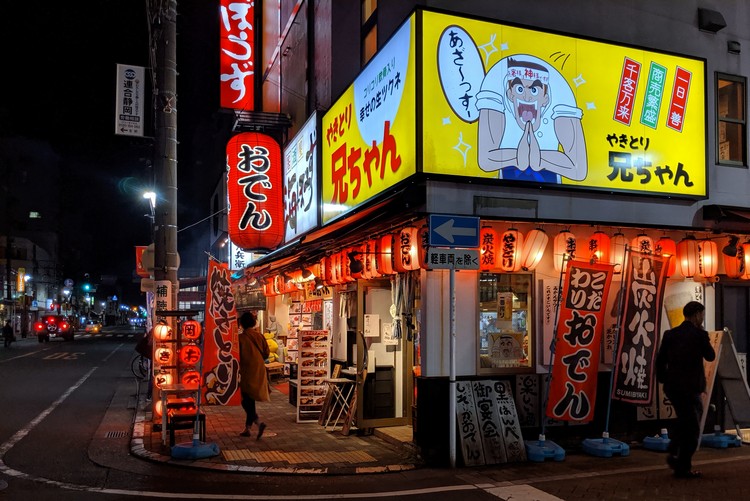
Beginners Guide to Food in Japan for first time visitors
Japan’s unique and diverse cuisine can be intimidating for first time visitors. Unadventurous eaters might experience a little anxiety when thinking about ordering Japanese food in Tokyo for the very first time. If you find yourself in this category, we’ve got you covered with this beginners guide to food in Japan.
We would argue that food is the reason to visit Japan.
However, for those unfamiliar with Japanese food culture, the idea of eating at restaurants in Japan might feel daunting. What do you order? How do you order? Do you tip in Japan? I remember feeling quite confused on our first trip to Japan; not being able to read Japanese characters didn’t help.
Thankfully, it didn’t take long before we started to feel comfortable.
We quickly turned our anxiety into curiousity. Sure, we sampled a few items that we will likely not order again (I’m talking to you, horumonyaki ), but we also discovered new foods and flavours that have forever changed our palate.
Most restaurants in high traffic areas will have food photos on the menu, plastic replicas in the windows, and/or English menus; so you’ll be fine even if you can’t read, speak or understand Japanese.
Skip ahead using the Table of Contents
Table of Contents
Readers note – we visited Japan prior to the Covid-19 pandemic. We recommend you do further research before your trip to Japan. Some of the Japan restaurants referenced in this blog post may have paused service, which might impact some recommendations.
Visit the Japan travel advisory for coronavirus updates here .
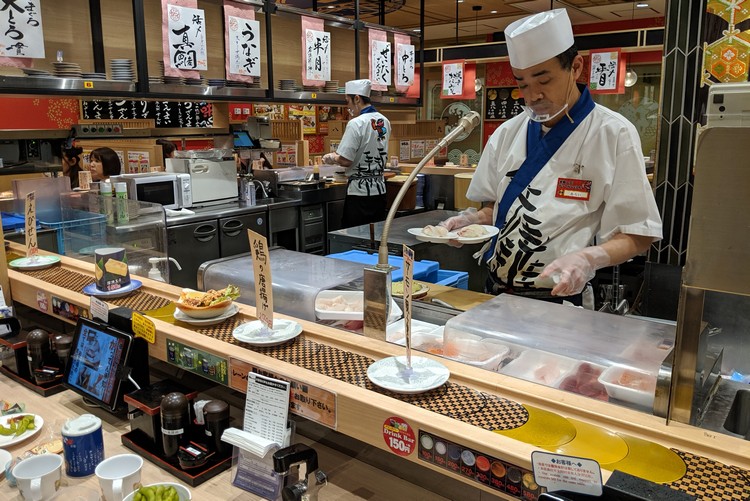
Read more posts from Japan
- 25 Japan travel tips for first timers
- 50 Photos of Kyoto that will inspire you to visit
- The perfect 3 day Tokyo itinerary for first time visitors
- 100 Photos of Tokyo Disneyland, Japan
- 15 things to do in Kobe, Japan
Let’s start with the most popular food in Japan for tourists
Given that this post is written with the first time visitor in mind, let’s start with the most popular Japanese cuisine for tourists. Below is a detailed list of Japanese food you should try in Japan.
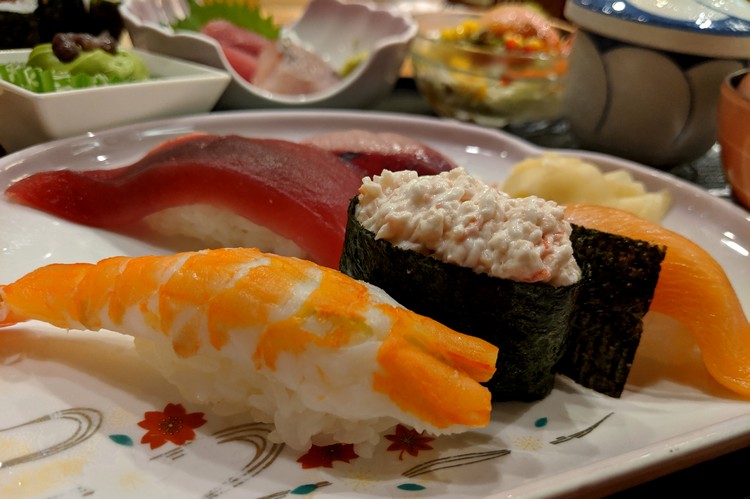
1. Sushi
Sushi is arguably the most famous food in japan. at least, it is for tourists. .
Without question, sushi is a big part of Japanese cuisine. You will find a variety of sushi shops in Japan, so you will have plenty of options.
If you’re not familiar with sushi, the thought of eating raw fish wrapped in thin sheets of seaweed might feel completely foreign and unsettling. You might even think that eating sushi is a big stretch for you. That’s okay, you’re not alone.
I think most people remember the first time they tried raw fish.
I know I do. It was a tuna sushi roll (tekka maki) at a small Japanese restaurant in North Vancouver. I had a mental block that prevented me from embracing the concept of raw fish. I wasn’t a fan of the texture or flavour, but it wasn’t as bad as I had built it up in my mind.
Now, years later, I can’t get enough sushi. I’m pretty sure we eat sushi at least once per week.
As one might expect, sushi tastes better in Japan. The fish is fresh and tasty and the sushi is prepared with a meticulous precision.
Travel tip – visit a Japanese restaurant in your hometown before you travel to Japan. Familiarize yourself with the menu and sample a few items. Let your curiousity run wild. This way, you have the advantage of reading the menu in English. Once you’ve seen and tried a few items, you’ll be much more comfortable with the food in Japan.
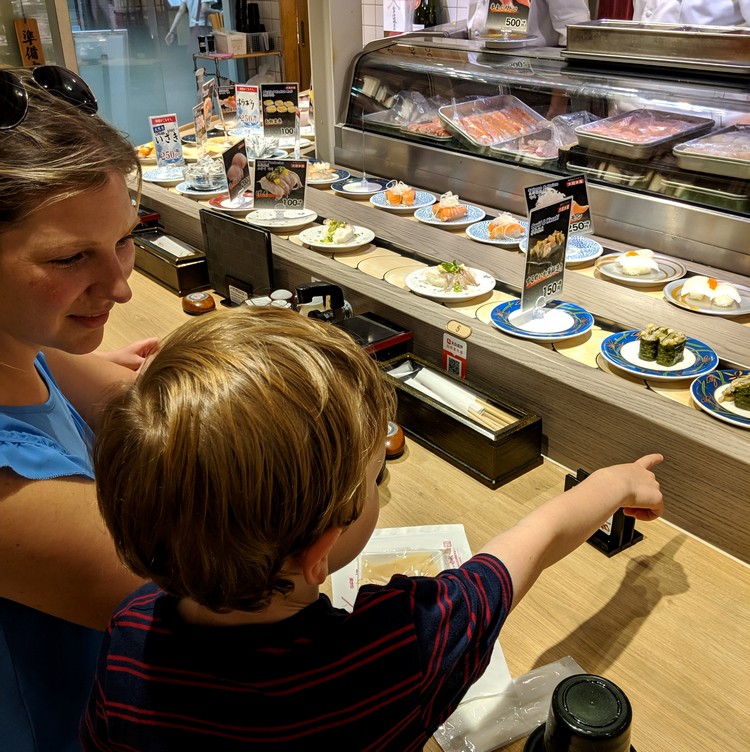
What sushi should you try first?
Sushi refers to any dish made with Japanese rice that’s seasoned with rice vinegar.
Sushi rolls are called maki or makizushi. Fresh fish and/or vegetables are wrapped with Japanese rice and a dried seaweed sheet (nori). The most common sushi rolls in Japan are salmon rolls, tuna rolls (tekka maki), unagi (freshwater eel), cucumber (kappa maki), f ermented soybean (Natto Maki) and f utomaki sushi rolls.
Here is list of useful sushi terms you should know before your visit to Japan.
Nigiri sushi are bite-sized mounds of sushi rice topped with slices of raw fish. The most popular nigiri sushi are sliced tuna, salmon, freshwater eel, squid and prawn. However, there are endless types of nigiri sushi available at Japanese sushi restaurants.
If you’re unsure about sushi and you want to ease in slowly, we recommend trying a non-fish sushi roll first, like cucumber, avocado, mushroom or egg (tamagoyaki).
Fun fact – California rolls and Dynamite Rolls are popular in North America, but not in Japan. Some Japanese restaurants in touristy areas will have these Westernized rolls on the menu, but most will not. These “safer” rolls are a good introduction to sushi because they do not have raw fish, but don’t expect to find these sushi rolls in Japan.
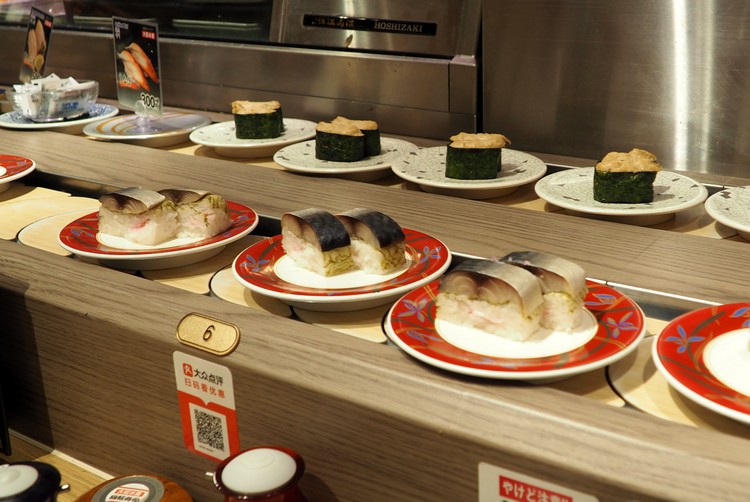
Conveyor belt sushi in Japan – Kaiten Sushi
A fun way to sample a variety of sushi is visiting a conveyor belt sushi restaurant, also called rotation sushi, sushi train and kaiten sushi . You may have seen or read about these innovative sushi restaurants during your research about Japanese food.
Basically, a conveyor belt transports small plates of various sushi around the restaurant. Typically, the conveyor belt passes beside tables or booths, or in front of a sushi bar, like the one pictured above.
Each item has a different price, which is identified by the colour or pattern on the plate. For example, the red plates might be 200 Yen each. If you see something you like, pick it up from the conveyor belt and enjoy. At the end of your meal, you add up the plates and pay for what you took from the conveyor belt.
We visited a few kaiten-zushi restaurants in Tokyo and Kyoto. They’re great. Not only does the sushi come out quickly, you can actually see the items as they pass your table. This is ideal for first timers who are nervous about trying raw fish for the first time.
And, you don’t need to worry about over-ordering, or under-ordering. The small bites allow you to pace yourself and try some items you might not have it you were to order from a menu.
Here’s an updated list of Conveyor Belt Sushi Restaurants in Tokyo.
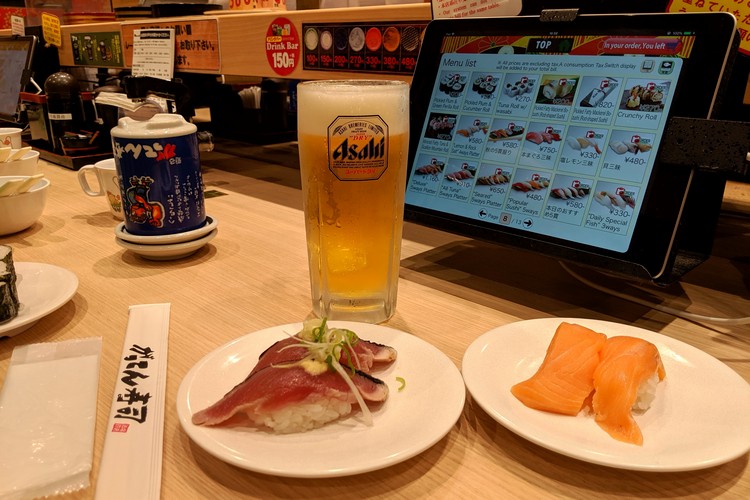
Most conveyor belt sushi restaurants in Japan have tablets at the table (see above photo). If you don’t see items you like on the conveyor belt, or you would like to order hot food items, you simply click the photos and place your order on the tablet.
Most tablet menus have an English option. This is helpful if you have specific items in mind.
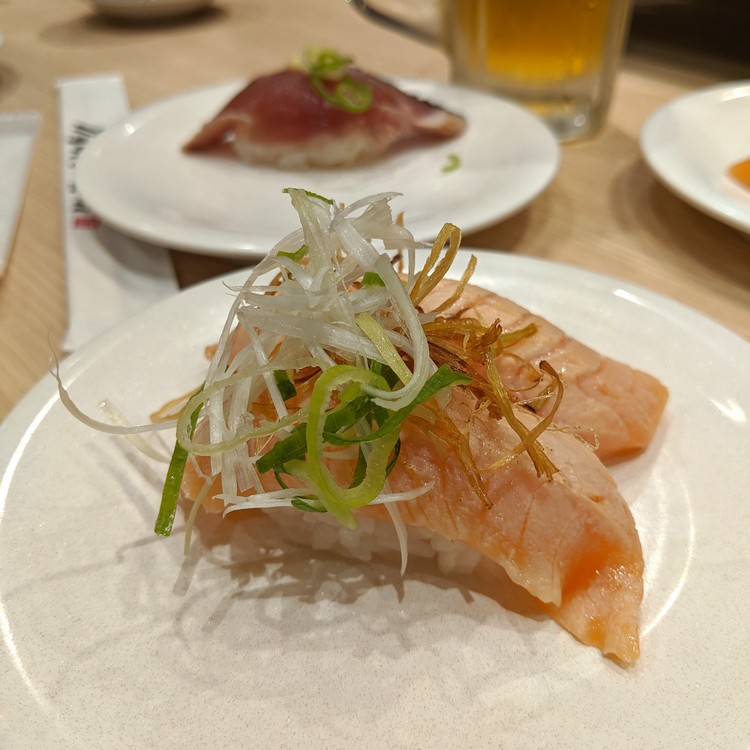
Above – a small plate of nigiri sushi at a kaiten sushi restaurant in Tokyo Japan.
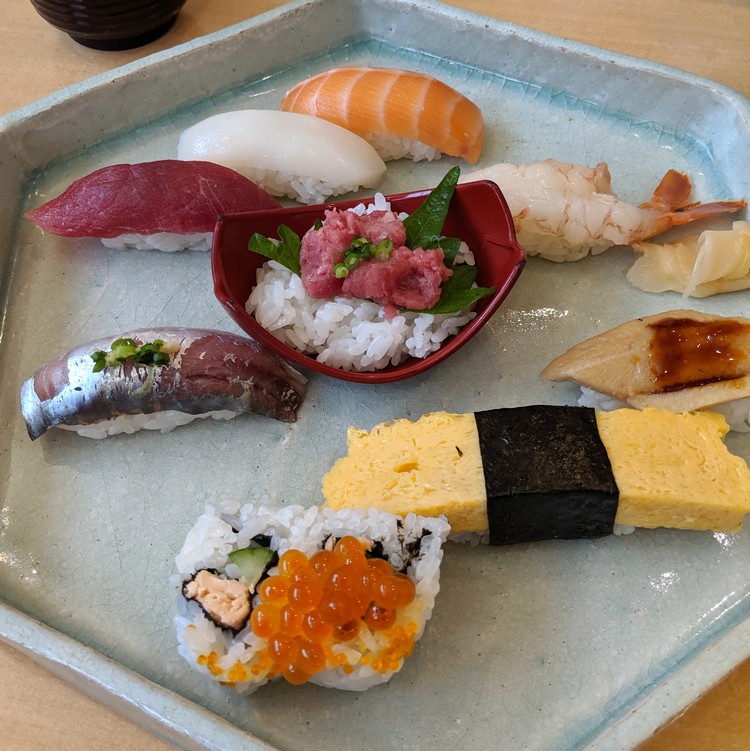
The above photo is a platter of various nigiri sushi.
Each piece of nigiri sushi a work of edible art. In the middle of the platter is chopped raw tuna belly served on rice. The big yellow sushi is tamago nigiri, which is a sweet folded omelet wrapped with seaweed.
Related post – Japan travel tips for first time visitors.
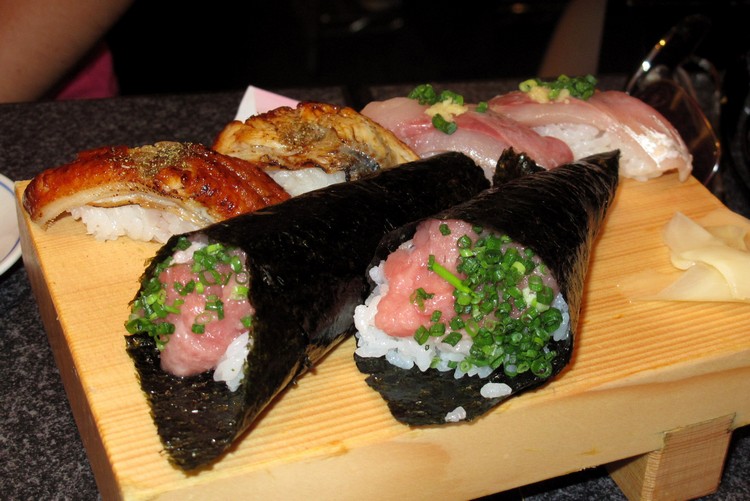
You can also order sushi cones, like in the above photo. These can get messy if you’re not careful. However, it’s one of our favourite food in Japan.
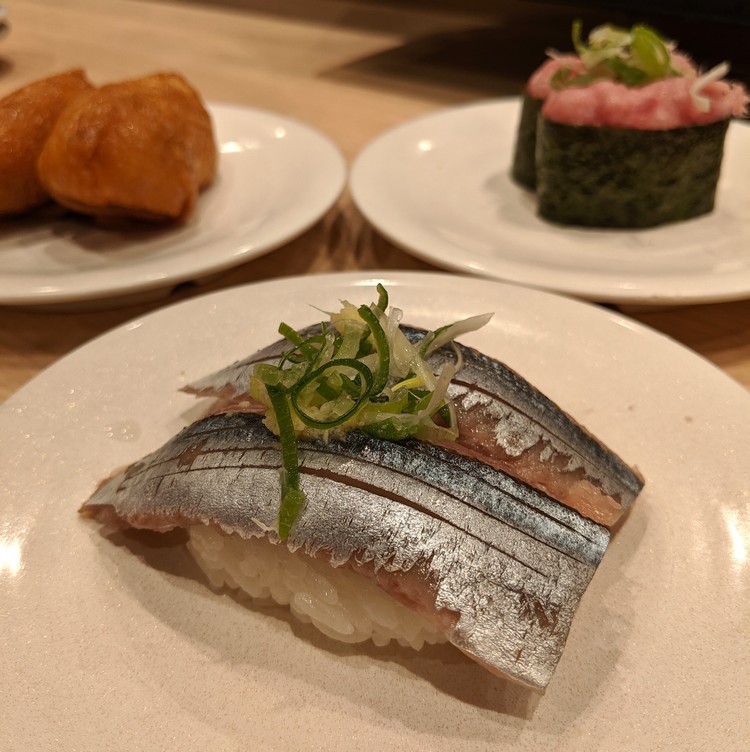
How to eat Sushi in Japan
We eat sushi often in Vancouver . At least once per week. We thought we knew the correct way to eat sushi, but we were wrong. How did we not know this before travelling to Japan?
Here’s an etiquette guide for how to eat sushi the correct way .
Apparently, the golden rules of eating sushi in Japan are:
- do not stick your chopsticks upright in the rice
- do not cut a piece of sushi in half with your chopsticks
- don’t mix wasabi in your soy sauce
There are a lot of things to know when it comes to Japanese culture. Most people will forgive foreigners for not knowing or understanding proper Japanese etiquette and customs, provided you’re respectful, quiet and polite. So, if you want to mix up your wasabi and soy sauce, do it subtly and don’t be surprised if the sushi chef rolls his eyes at you.
Related – Japan travel tips you should know before you go
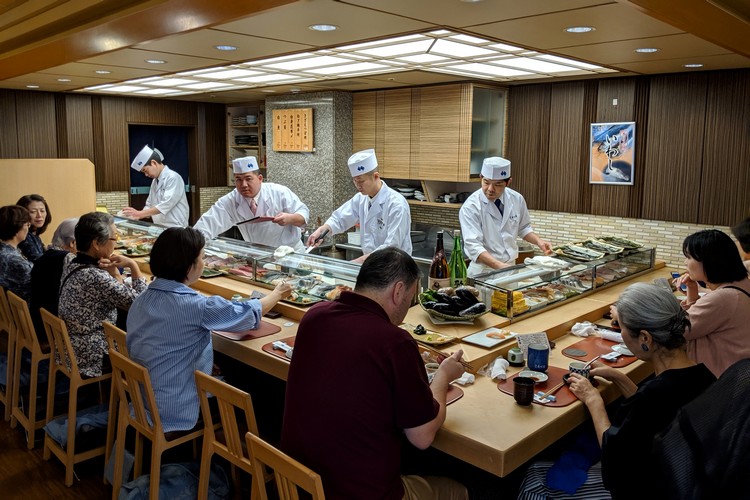
What is your favourite Japanese cuisine? Leave a comment below.
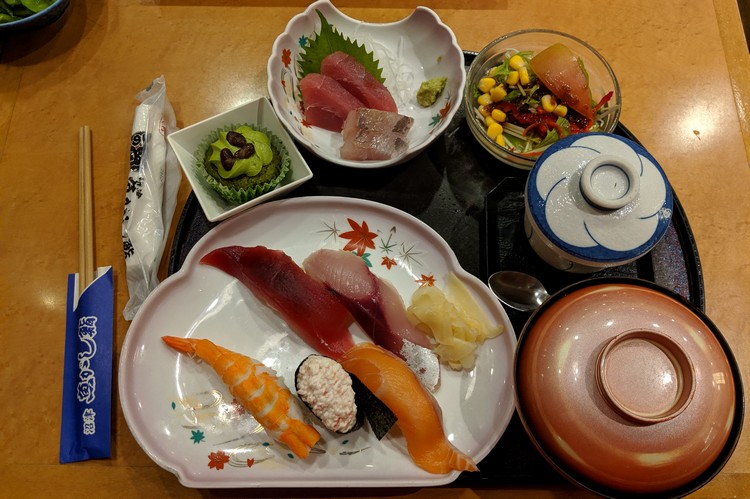
Sashimi is a Japanese delicacy that consists of thinly sliced raw fish, typically salmon, fatty tuna, yellowtail, mackerel, scallop and squid. You will also find sashimi-style meat, like chicken and beef.
Typically, sashimi is served plain and you dip the raw fish slices in soy sauce. However, some types of sashimi are served with a spicy sauce on top (example = spicy tuna sashimi).
What is the difference between sushi and sashimi?
There are a lot of similarities between sushi and sashimi. Some nigiri sushi, like the ones pictured above, have a strip of raw fish resting on a mound of Japanese rice. Same goes for some sushi rolls, like tekka maki (tuna), where the sushi roll is filled with slices of raw fish, which is basically sashimi.
In the above photo, the sashimi is located in the top dish. You can see the similarities between sashimi and nigiri sushi – the slices of fish on the nigiri sushi are so big that you actually can’t see the rice underneath.
Kaisendon traditional set menu
Kaisendon is a Japanese dish that consists of white rice and raw sashimi, such as prawns, octopus, squid, salmon, white fish, crab meat, egg, and sea urchin roes. It is often served with a traditional set menu (above photo).
In the covered brown bowl is miso soup, which is commonly served at Japanese restaurants.
The white bowl on the top right of the plate is chawanmushi , a steamed egg custard filled with meats and vegetables (including chicken, mushrooms, gingko nuts, kamaboko fish cakes, and carrots).
Other items typically found in a Japanese set menu are steamed vegetables, pickled vegetables, tempura (see below), salad, sushi rolls and/or a sweet desert like matcha cupcakes.
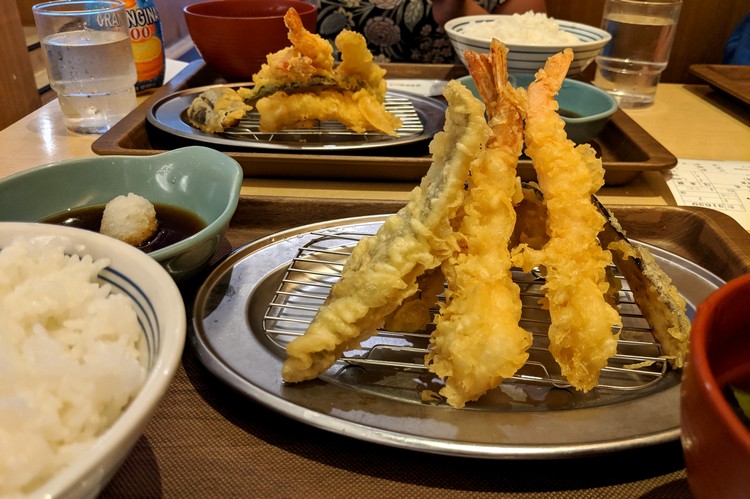
3. Tempura
Tempura is one of the most popular Japanese dishes in Japan. It’s a simple dish that consists of battered and deep fried seafood, meat and/or vegetables, served with a special dipping sauce called Tentsuyu.
Tempura is an easy introduction to Japanese food for tourists.
If you like crispy fish and chips, you’ll love tempura. Tempura batter is lighter than the batter that’s commonly used for fried fish and chicken.
Tempura can be served as an appetizer, side dish or as a stand-alone entrée. It’s typically made with prawns and/or vegetables, like yams, sweet potato, butternut squash, eggplant and green beans.
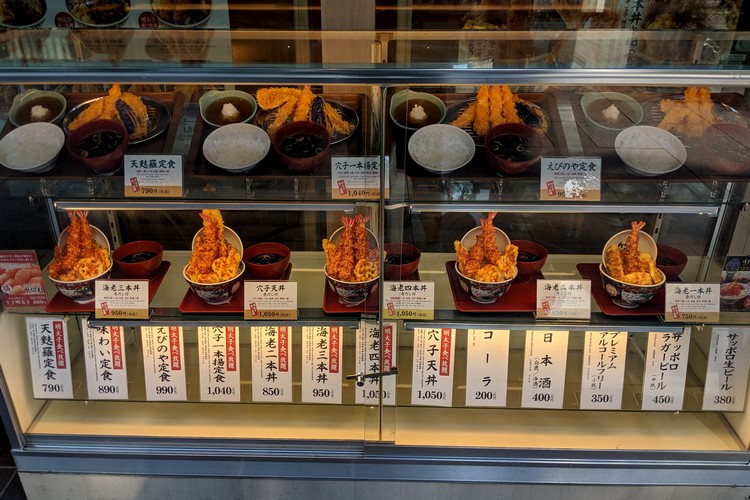
Many Japanese restaurants have plastic replicas of the dishes on display at the front or entrance to the restaurant. This makes it easy to visualize the menu and decide what you want to order before sitting down at a table. It’s very convenient when traveling with kids.
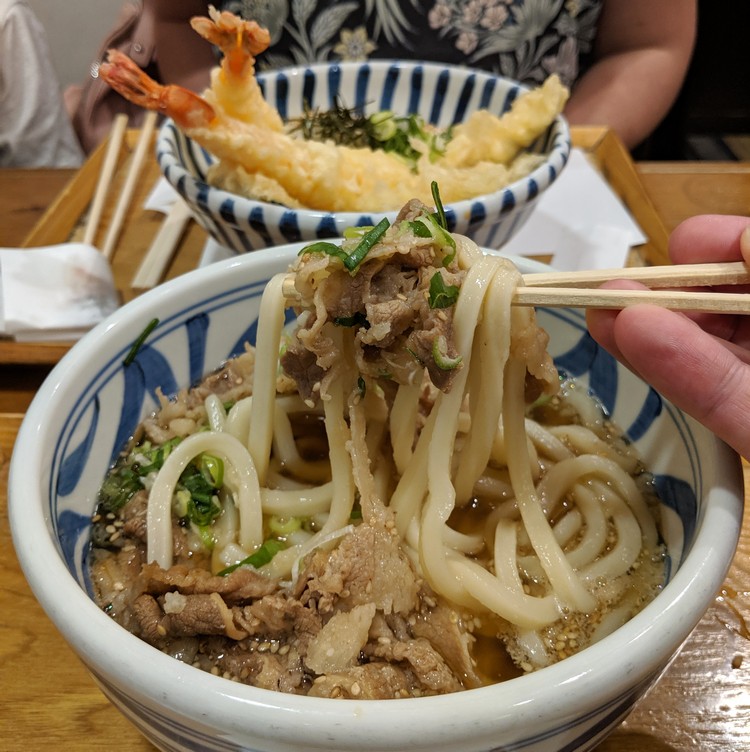
Udon is a popular Japanese dish that’s an easy introduction to Japanese food for tourists. It can be served a number of different ways, with a variety of ingredients, but it is most commonly served in noodle soups.
Pictured above is a delicious beef udon noodle soup that we enjoyed in Kyoto, Japan .
I like the simplicity of udon noodle soup. The flavourful savoury bowls are loaded with soft thick noodles, sliced chicken or beef, fresh vegetables and a variety of garnishes like green onion, sesame seeds, roasted seaweed slices, nora and dried garlic.
The most common udon noodle soups are Kitsune Udon, Tempura Udon (pictured above, in the backdrop) and Chikara Udon (topped with grilled mochi rice cakes).
You will also find udon noodles served in a stir fry dish, called Yaki Udon , mixed with meat, vegetables and a soy based sauce. It’s similar to yakisoba, but the noodles are different.
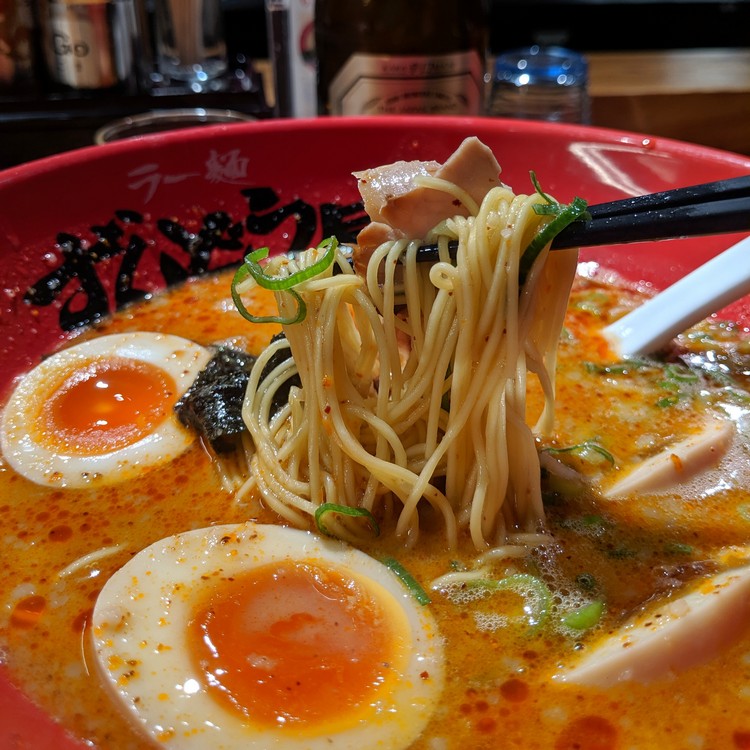
Ramen is probably the most popular Japanese cuisine for tourists.
Similar to udon, ramen is a noodle dish consisting of thinly sliced wheat noodles, protein, vegetables and is typically served in a rich savory broth. Ramen is the perfect Japanese food for beginners.
There are many types of broths, ingredients and garnishes that will completely change the flavour and texture of the ramen noodle soup. The four main ramen broth bases are soy, miso, salt and tonkotsu.
My favourite is miso ramen, but tonkotsu is a close second. Who and I kidding, I love them all!
You can also add items to your ramen. Typical ramen garnishes include chashu pork, menma (bamboo shoots), narutomaki (fish cake), scallion, shiraga negi (Japanese long green onion) and a marinated soft boiled egg ( Ajitsuke Tamago ). I love adding an extra soft boiled egg – they are heavenly when prepared properly.
Ramen is an inexpensive and popular dish that can be found almost anywhere in Japan. You won’t have a problem finding ramen restaurants in Tokyo or Kyoto.
That said, like most restaurants, some are better than others. If you’re only in Tokyo for a few days, research online reviews to find the best ramen restaurants in Japan. Make it count!
Related post – How to spend 3 days in Tokyo
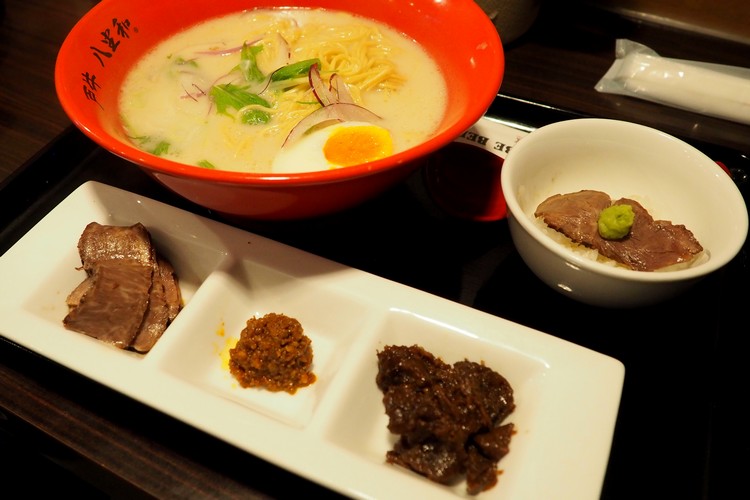
The above photo was captured at a small ramen restaurant in Kobe that was recommended to us. This particular miso ramen dish is served with a variety of Kobe beef.
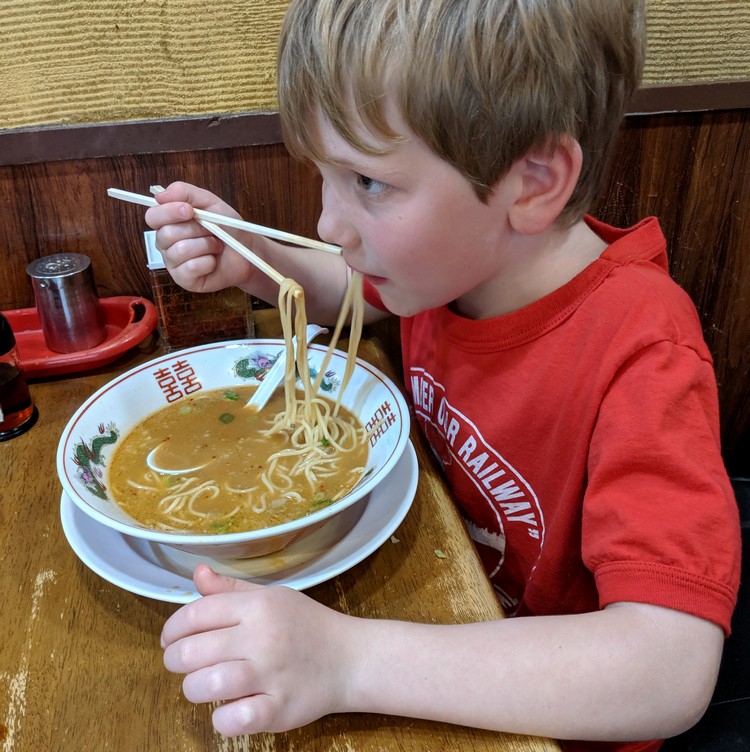
Ramen is an easy introduction to Japanese food for kids. Our 8 year old son loves miso ramen.
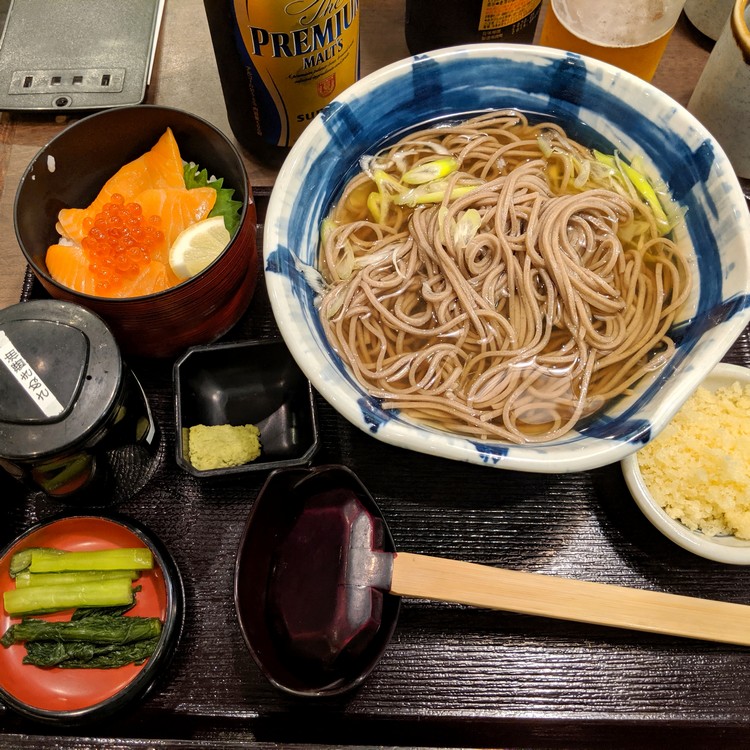
Soba is the Japanese name for thin noodles made from buckwheat flour, or a combination of buckwheat and wheat flours. Similar to udon and ramen, soba noodles are often found in savory soup broth. However, soba noodles are also served cold with a dipping sauce or as a hot stir fry dish.
There are many soba noodle recipes and dishes to taste, from spicy peanut soba noodle salad (served cold) to beef and vegetable stir fry soba noodles (yakisoba).
Many restaurants in Japan offer a set menu with soba noodle soup as the main dish, accompanied by a variety of side dishes, like tuna sushi, salmon sashimi, grilled vegetables, steamed spinach with peanut sauce (Goma-ae), crispy tempura batter and chawanmushi (traditional savory egg custard).
Related – 50 Photos of Kyoto that will inspire you to visit
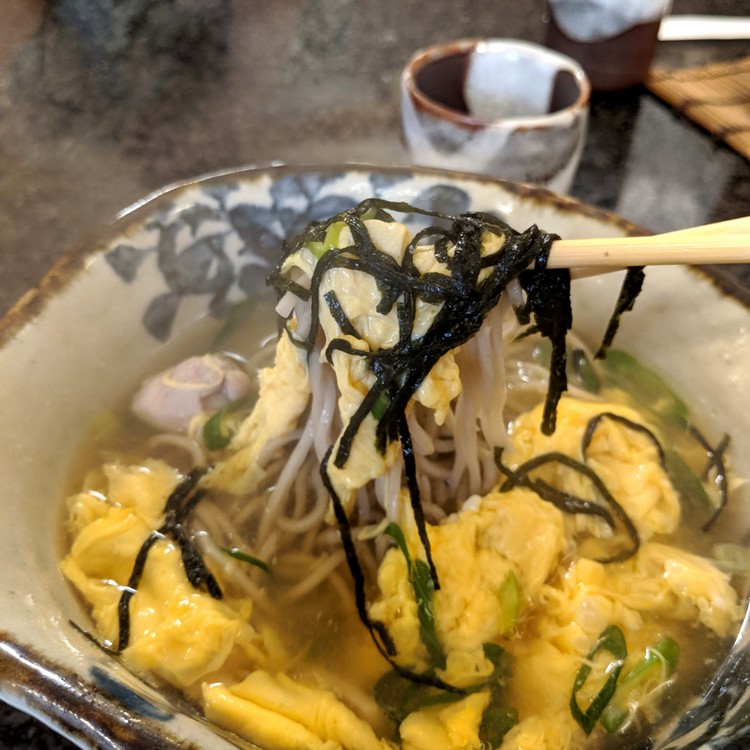
Above is a soba noodle soup with egg, chicken and sliced nori (dried seaweed).
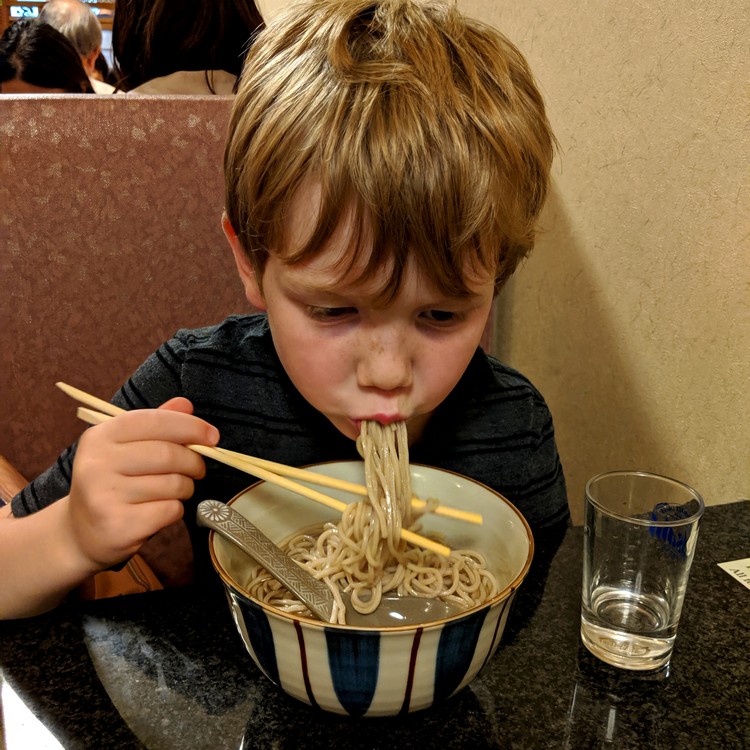
Another day, another bowl of noodles for this little guy.
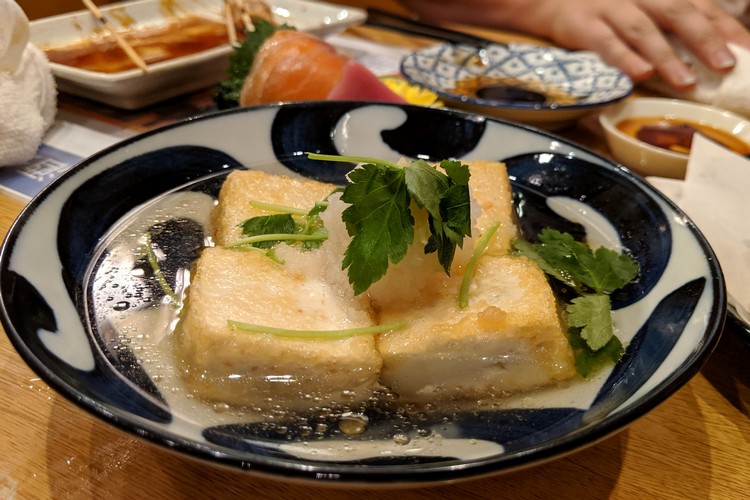
7. Agedashi Tofu
Agedashi tofu is cubes of soft or silken tofu coated with potato starch and deep fried so that the outer shell is crispy. It’s typically served as an appetizer or side dish, but can also be the main item in a bento box or served as an entrée.
If you’re vegetarian or don’t like to eat meat or fish, agedashi tofu is a great alternative.
Agedashi tofu is typically served with a flavourful tsuyu sauce for dipping. It is sometimes served with grated radish, green onion, and bonito flakes as garnishes.
Be careful. Agedashi tofu is deep fried and it comes out hot, hot, hot! We’ve burnt the roof of our mouths several times because we were too eager to dive in. The trick is to stab the middle of each piece of tofu with your chopstick so the steam releases and the tofu cools down. Consider yourself warned.
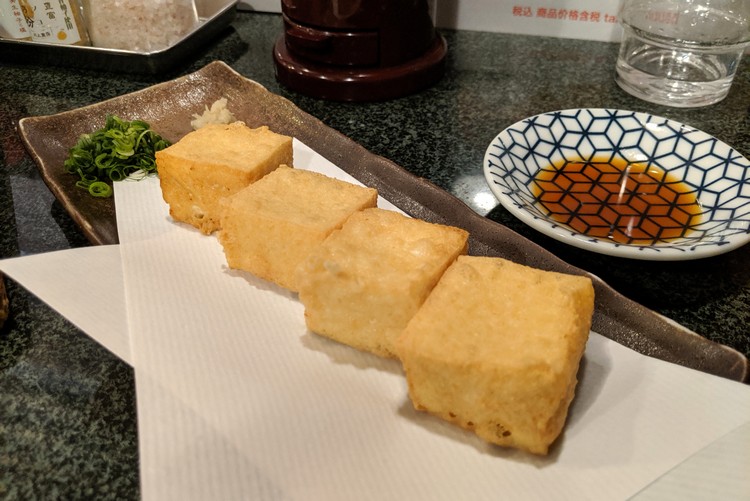
Above is a plate of large cubed agedashi tofu at a restaurant in Arima Onsen , an ancient hot spring town located near the city of Kobe.
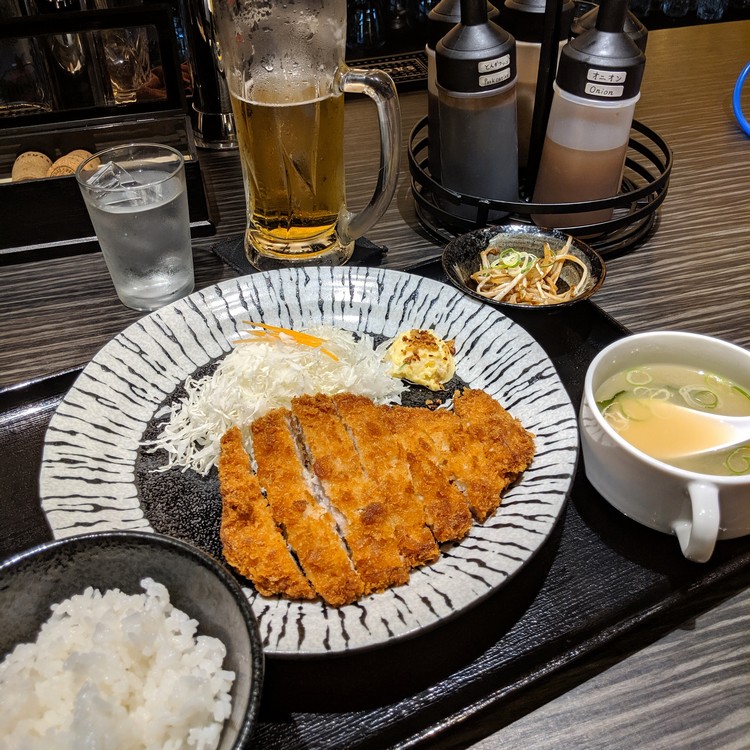
8. Tonkatsu (deep fried pork cutlet)
Tonkatsu is a breaded, deep-fried/tempura pork cutlet that is traditionally served with rice and sliced cabbage. It is a popular Japanese food for beginners because, well, who doesn’t like deep fried <insert anything and everything>?
Tonkatsu is similar to German schnitzel. However, the bread crumbs used for tonkatsu is called panko, which is different from the breadcrumbs used in Western cuisine.
You will find variations of tonkatsu in Japan, including katsudon , which consists of tonkatsu served on a bowl of rice, and katsu sando , which is a sandwich with tonkatsu between two slices of plain white bread.
Katsukare is another Japanese cuisine that consists of sliced tonkatsu pork cutlet served with Japanese curry rice and curry.

9. Yakitori
Yakitori is the japanese version of chicken skewers..
There are many variations of yakitori , however, typically the skewers are made with bamboo skewers and seasoned with tare sauce and/or salt and spice.
Yakitori comes in many forms, including white chicken skewers, chicken and spring onion, chicken meatballs, chicken small intestines, gizzard and chicken heart, to name a few. Some restaurants and specialty shops also have deep fried options available.
Yakitori a popular Japanese street food that is commonly found at outdoor markets, food courts, sporting events and Yakitori-ya, which are small shops that specialize in yakitori. It’s widely available at izakayas, informal Japanese bars that serve alcoholic drinks and snacks. Here’s a list of best izakaya alleys in Tokyo.
Related – The best things to do in Tokyo for first time visitors
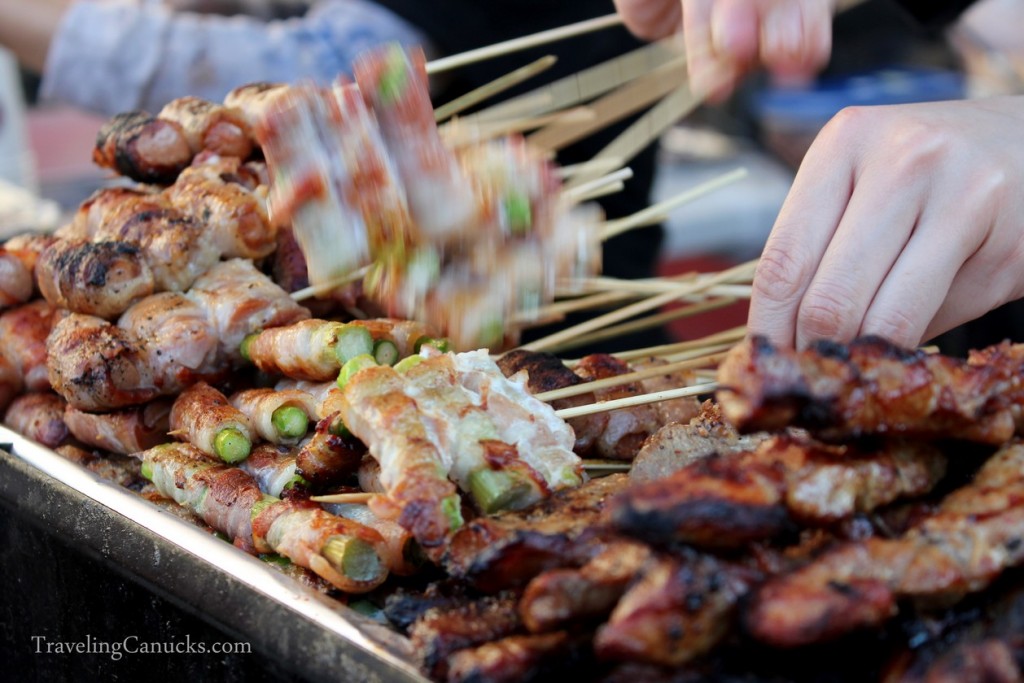
Freshly grilled yakitori at a market in Japan.
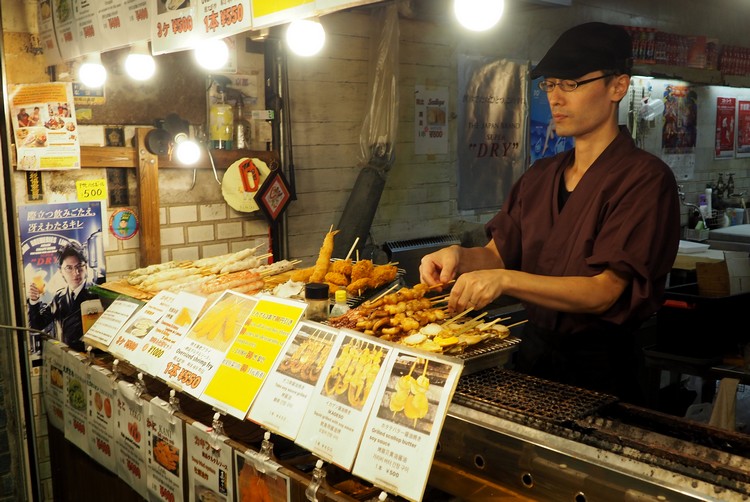
Yakitori and deep fried skewers at a stall in Nishiki Market in Kyoto.
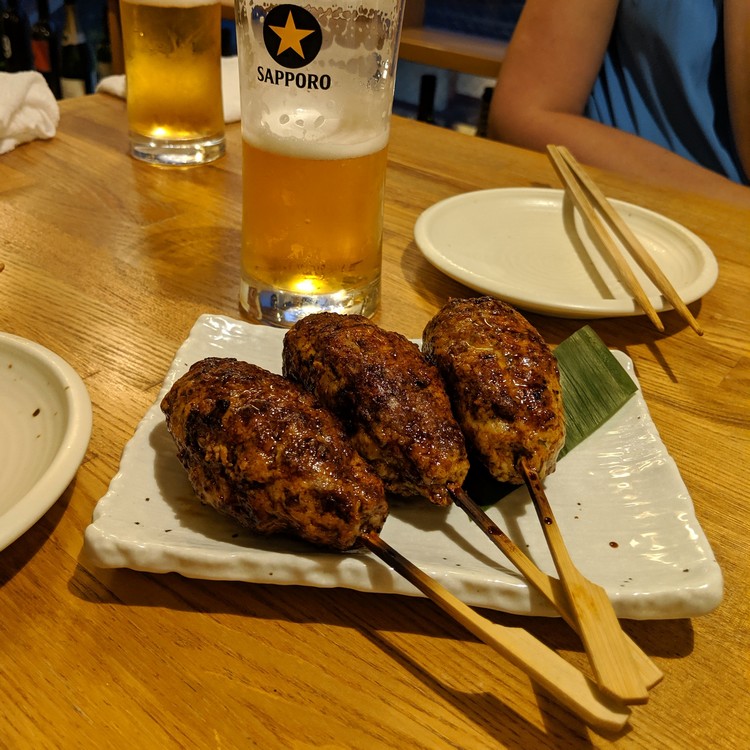
Chicken meatball yakitori served at a restaurant in Kyoto.
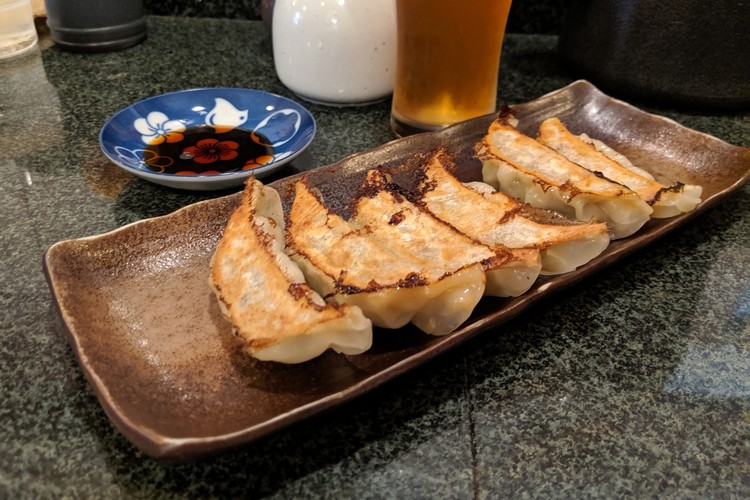
Gyoza is another popular Japanese dish that is a must try food in Japan. It’s commonly served as an appetizer or side dish at sushi restaurants.
Gyoza is Japan’s version of the dumpling. It’s most similar to Chinese potstickers or jiaozi dumplings. These tasty Japanese dumplings are typically filled with minced pork, cabbage, scallions, garlic, and ginger. Vegetarian options are typically available, too.
Gyozas are typically fried in sesame oil on one side, until they have a crispy bottom. The top of the gyoza is steamed, giving it a soft texture. They’re served with a dipping sauce of rice vinegar, soy sauce and chilli oil.
Gyozas are an easy introduction to Japanese food for unadventurous eaters.
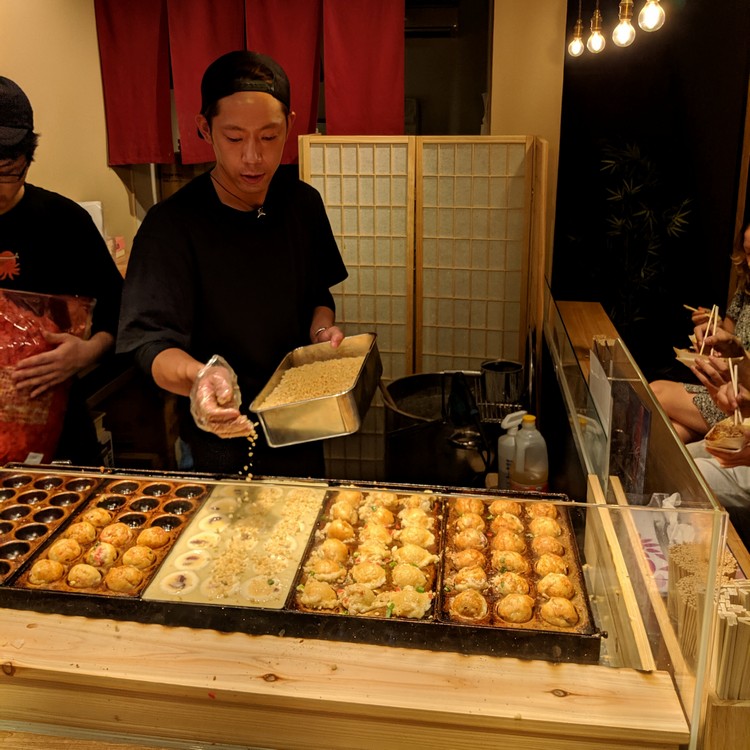
11. Takoyaki
Takoyaki, also known as octopus balls , is a delicious doughy ball filled with minced or diced octopus, tempura scraps, pickled ginger and green onion..
They are commonly eaten as a snack or appetizer and are served with takoyaki sauce (similar to Worcestershire sauce) and mayonnaise, and garnished with shavings of dried seaweed and fish flakes.
You will find small shops and street food vendors serving takoyaki throughout Japan.
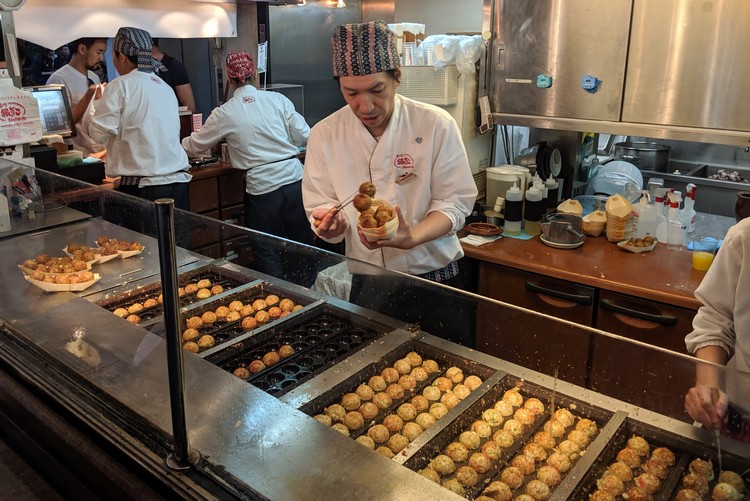
Gindaco Takoyaki is the famous takoyaki restaurant near Harajuku train station in Tokyo.
We highly recommend you visit this location. They serve the best takoyaki in Tokyo, in our opinion.
Be prepared to wait your turn, as this location is very popular. It’s worth wait. Do it.
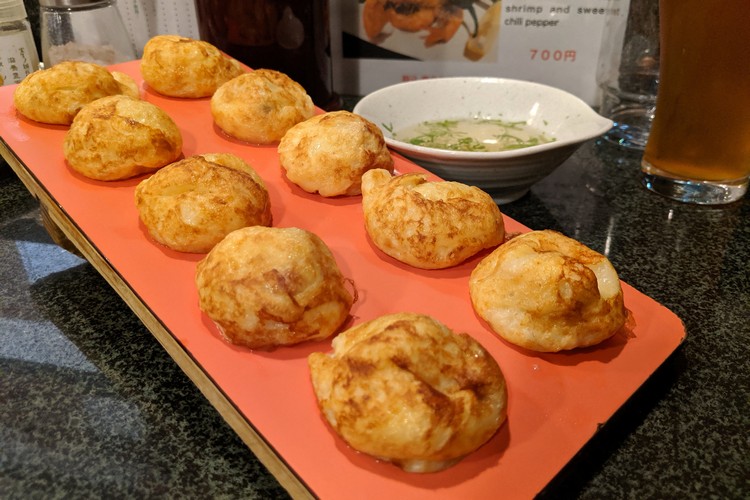
This takoyaki platter is served plain with a light vinegar dipping sauce on the side.
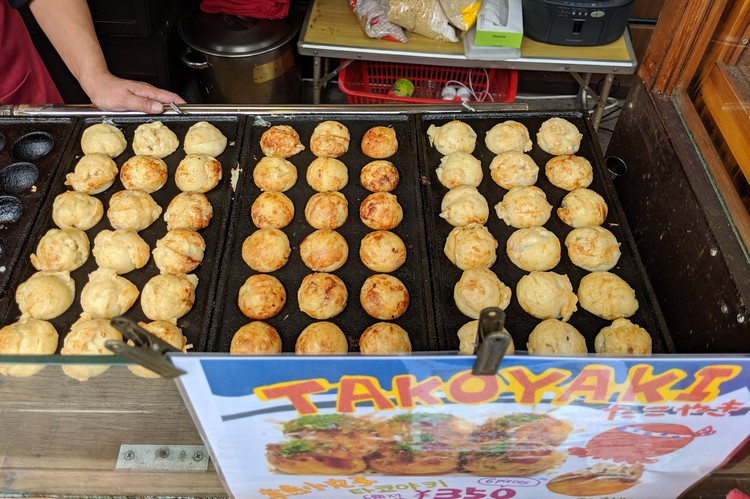
Takoyaki street food vendor near Fushimi Inari temple in Kyoto.
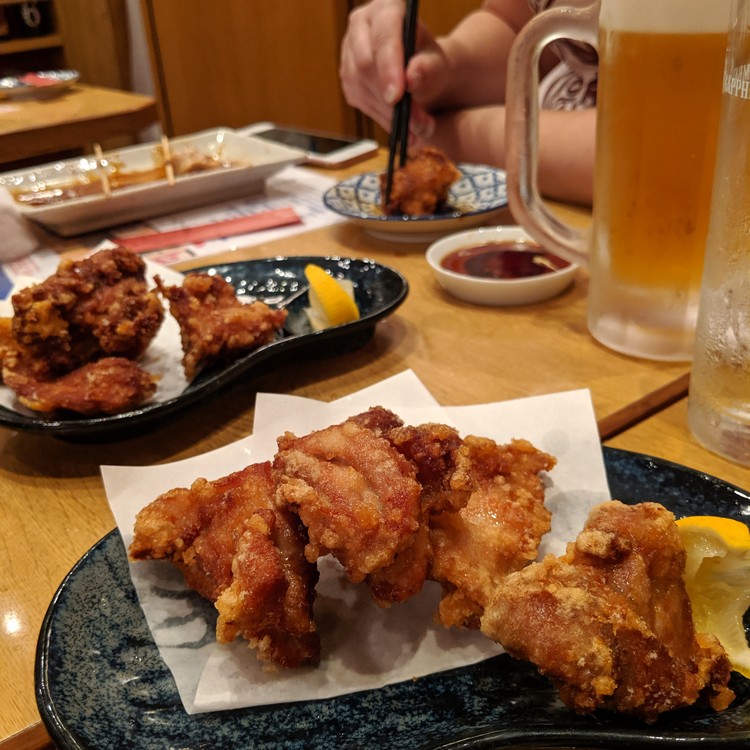
12. Chicken Karaage
Karaage is Japan’s version of fried chicken. The chicken is battered and deep fried until crispy on the outside. The chicken is often marinated prior to being coated with batter.
Karaage is served alone or with rice and shredded cabbage. It’s often served as an appetizer but it can also be a stand alone dish. You will find karaage served at most Japanese restaurants, as well as street food vendors at outdoor and indoor markets.
Our boys love chicken nuggets, so this tasty Japanese cuisine is one of their favourites.
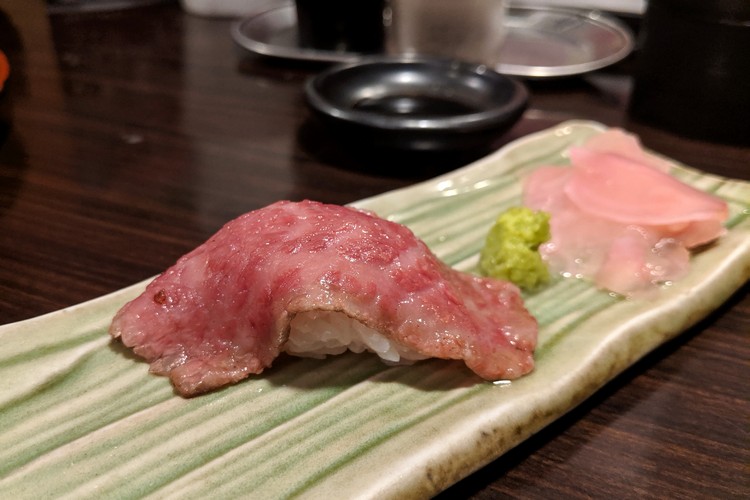
13. Kobe beef in Kobe Japan
For all you steak lovers out there, you must try kobe beef in kobe..
Kobe is famous for its Wagyu beef , arguably the finest cut of beef in the world, which comes from the Tajima strain of Japanese Black cattle.
Kobe beef is a Japanese delicacy , valued for its flavour, tenderness, and fatty, well-marbled texture. Foodies flock to Kobe to sample it’s famous namesake.
First time visitors to Kobe will have no trouble finding a restaurant serving Kobe beef. It’s heavily advertised from the moment you get off the train at the Kobe train station.
There are a number of ways to sample this popular Japanese style of beef, from Kobe beef teppanyaki to Kobe beef hamburgers to Kobe beef sushi (pictured above).
Kobe beef is an expensive cut of meat , so your budget may dictate the best way to experience this celebrated Japanese cuisine. High-end steakhouses offer multi-course meals that serve a variety of cuts and styles of wagyu beef.
Or, you can enjoy Kobe beef on the cheap by sampling kobe beef sushi from a variety of restaurants or street food vendors. That’s what we did, because only one of us likes beef (hint – it’s not Nicole or the boys).
Now, if Kobe City is not on your original Japan travel itinerary, you can easily add it by taking a day trip to Kobe from Kyoto, Tokyo or Osaka. Or, you can simply get off the train in Kobe and have lunch or dinner, then get back on the train and continue to your next destination.
You will find wagyu beef throughout Japan, so don’t worry if you aren’t able to make it to Kobe. There are dozens of restaurants in Tokyo that serve wagyu beef, including Kobe beef, Omi beef and Matsusaka beef.
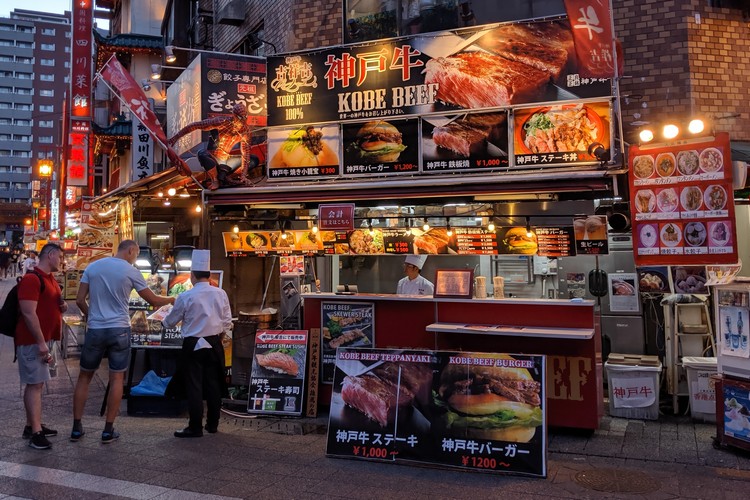
Street food vendors in Kobe Chinatown serve a variety of Kobe beef to hungry visitors.
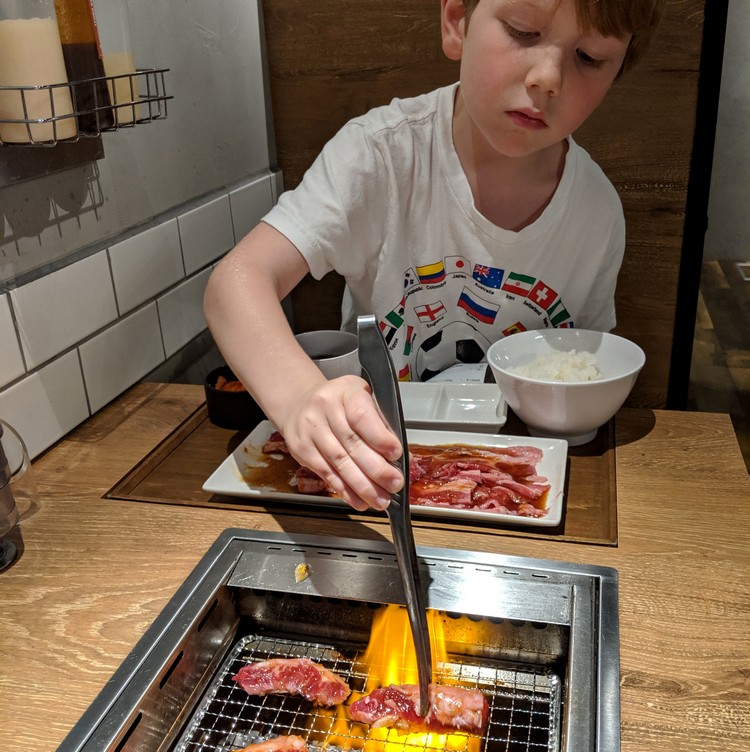
14. Yakiniku
Yakiniku is a Japanese term that refers to grilled meat. Basically, you grill your meat on an open flame at your table. It’s a fun Japanese dining experience that you should try on your Japan vacation.
We stumbled upon a great yakiniku restaurant, Yakiniku LIKE , while exploring the Akihabara district in Tokyo. There are tablets at each table with an English menu and photos of each dish, so it’s an easy process with limited ‘lost in translation’ moments.
We ordered a variety of pork and beef to grill at our table. The raw meat is marinated and sliced, so you just add to the flame and cook it as much, or as little, as you like. Meals are served with rice and there are several condiments at your table.
Our boys loved grilling meat on the table. This was there first time and it remains a highlight for them when we talk about our family trip to Japan.
Related – The top things to do in Tokyo for tourists
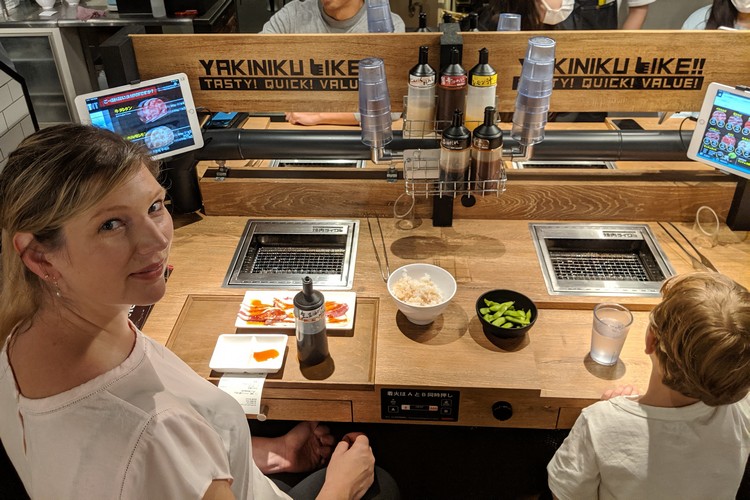
Follow us on Facebook for the latest travel updates.
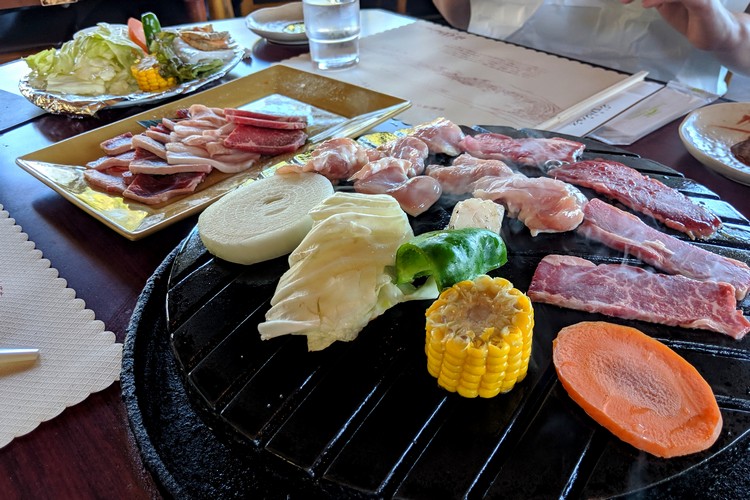
Japanese BBQ at your table
We enjoyed a fun lunch at Rokkosan Genghis Khan Palace on Mount Rokkō in Kobe City. Rather than being grilled on an open flame, like yakiniku, this Japanese barbecue grill is on a hot iron plate.
We ordered a variety of vegetables and meat, including Kobe beef, chicken and marinated pork, and grilled the food at our table. Our boys enjoyed using the tongs to flip the meat and listen to it sizzle on the iron plate. It’s a fun Japanese dining experience for tourists.
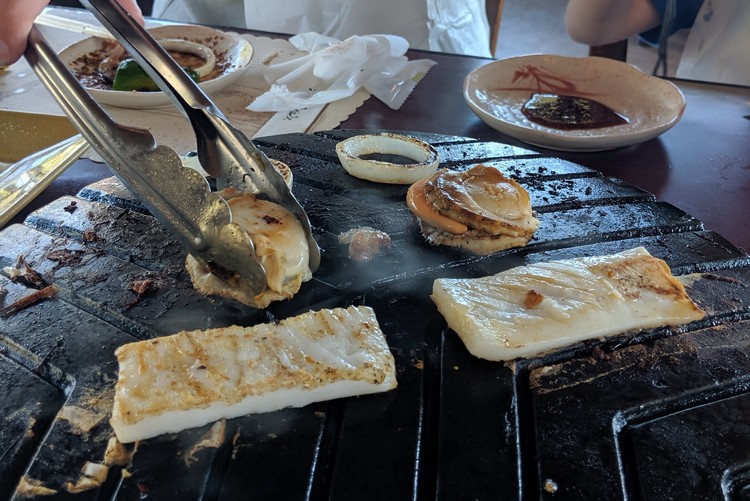
Grilling squid and giant mussels on an iron plate at our table .
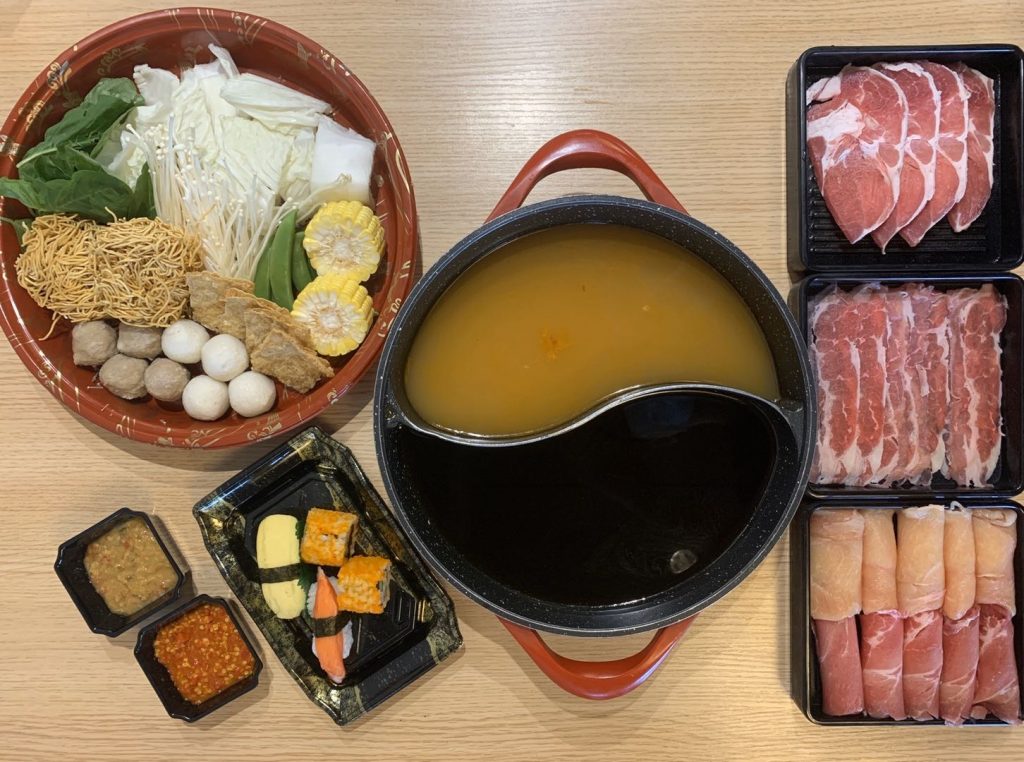
15. Shabu-shabu
Shabu-shabu is a hotpot dish that’s a big part of japanese food culture..
Basically, you cook your food at the table in a large heated pot with boiling water or broth. Some hotpots are split in half, like in the above photo, with each side having a different broth.
Most platters come with a variety of vegetables, seafood and thinly sliced meat, as well as dipping sauces, spices and garnishes so you can play with the flavours and heat.
Shabu-shabu is a fun Japanese dining experience to enjoy with friends and family. The idea is that you take your time and socialize around this bubbling hotpot. You dip your meat or vegetable as needed, rather than all at once. It’s a must try Japanese cultural experience for your Japan holiday.
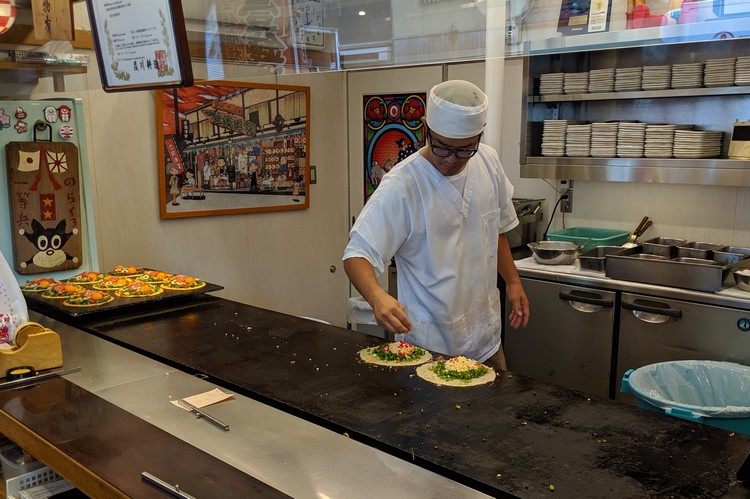
16. Okonomiyaki
Okonomiyaki is a japanese savory pancake with a variety of ingredients..
It’s a popular food in Japan for tourists because it’s a uniquely Japanese. There are different types of okonomiyaki throughout Japan, with toppings and batters varying depending on the region.
Okonomiyaki is mainly associated with the Kansai or Hiroshima areas of Japan, though it’s said to have originated in Osaka. It is sometimes compared to an omelette and may be referred to as a Japanese pizza or Osaka soul food .
The Kansai style okonomiyaki is the most common version found throughout Japan and typically contains meat (thinly cut pork belly or bacon), octopus, squid, shrimp, vegetables, green onion, and/or cheese. We prefer the Hiroshima style okonomiyaki because we like the ingredients to be layered, rather than mixed.
There’s also a semi-liquid okonomiyaki found in Tokyo called monjayaki. The ingredients in monjayaki are finely chopped and mixed into the batter before frying.
Here’s a list of the best Okonomiyaki in Kyoto.
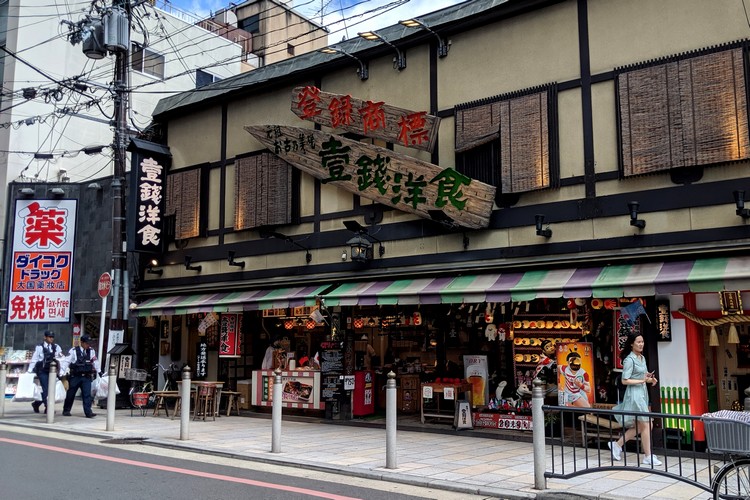
Issen Yoshoku is a famous okonomiyaki restaurant in Gion, Kyoto.
While the savoury pancakes are delicious, this okonomiyaki restaurant in Kyoto might be more famous for its statue at the front entrance. See photo below.
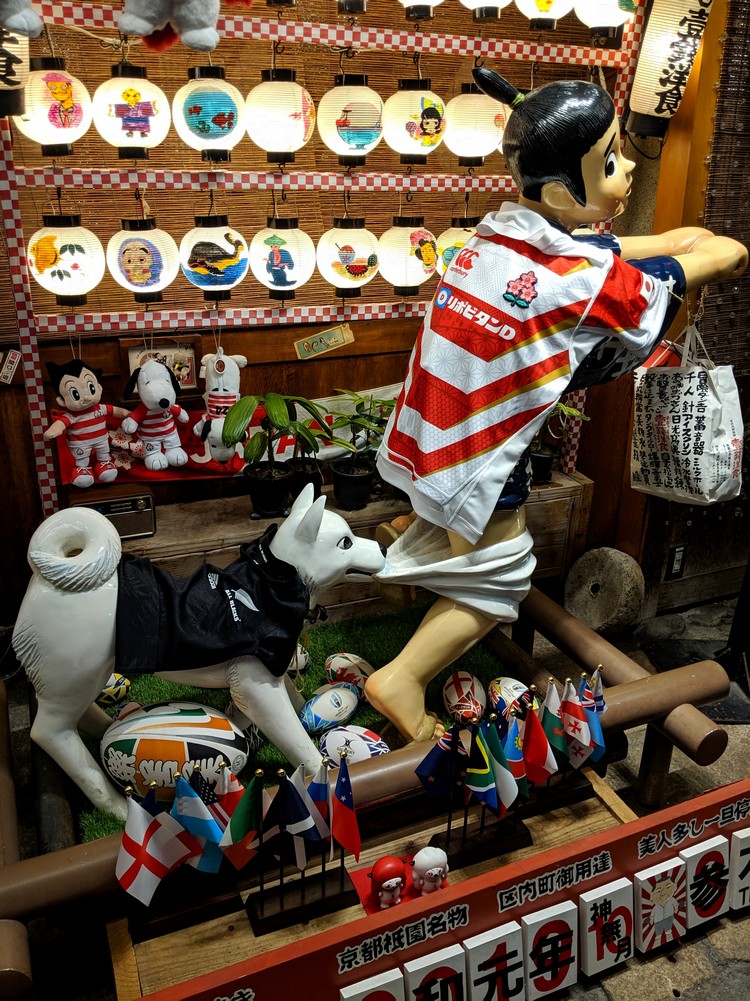
When we visited Kyoto a decade ago, we stumbled upon this funny statue of a boy getting bitten by a dog with his pants down in front of a restaurant. We thought it was an odd statue, so we took a photo.
When we returned last year, we stumbled upon it once again, by pure chance. Of course, we had to take another photo to capture the memory. This time, the boy is wearing a Japan rugby jersey because we visited for the Japan Rugby World Cup .
While thousands of people may have a photo of this strange statue, few will have a photo of it decorated for the Japan Rugby World Cup.
Related – Our experience at the Rugby World Cup in Japan
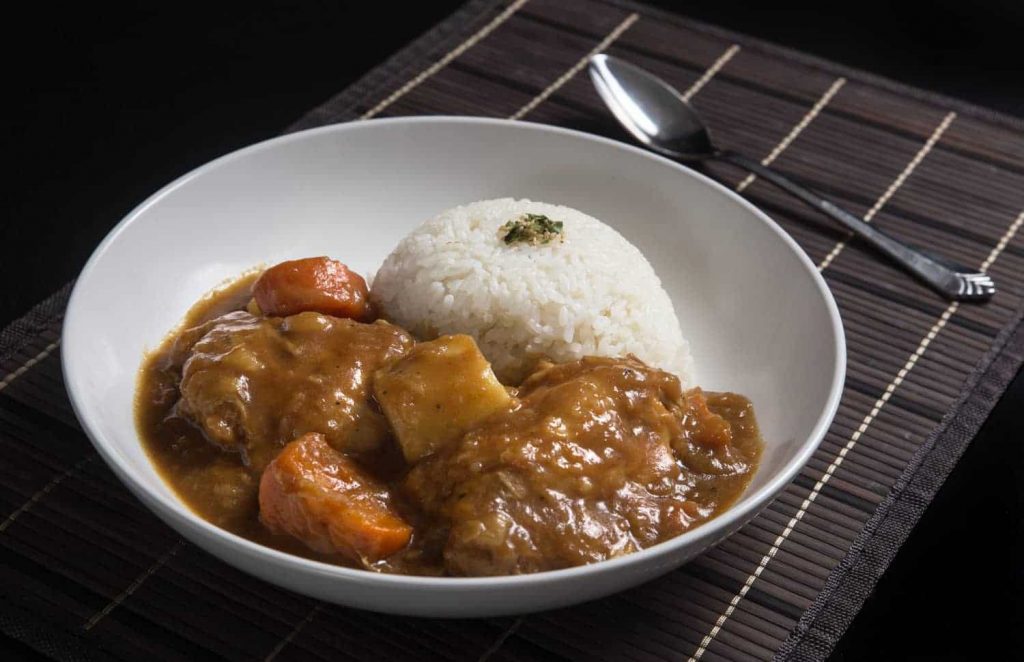
17. Kare Raisu (Japanese Curry Rice)
When we think of Japanese food, rarely does curry come to mind. That’s why we were surprised to see how popular kare raisu is throughout Japan.
Japanese curry rice tastes different from the curry you find in India or Southeast Asia. The main ingredients for Japanese curry are a variety of meats (chicken, pork or beef), vegetables (onions, carrots and sweet potatoes/yams) and spices. We found Japanese curry to taste more like a thick gravy with a curry flavour.
We’re told that kare raisu is a good example of yoshoku , which takes dishes from Western culture and adapts them to meet Japanese tastes and preferences (fusion cuisine). Japanese curry rice is an inexpensive Japanese dish that can easily be found throughout Japan.
We enjoyed Japanese curry rice for lunch when we visited Tokyo Disneyland .
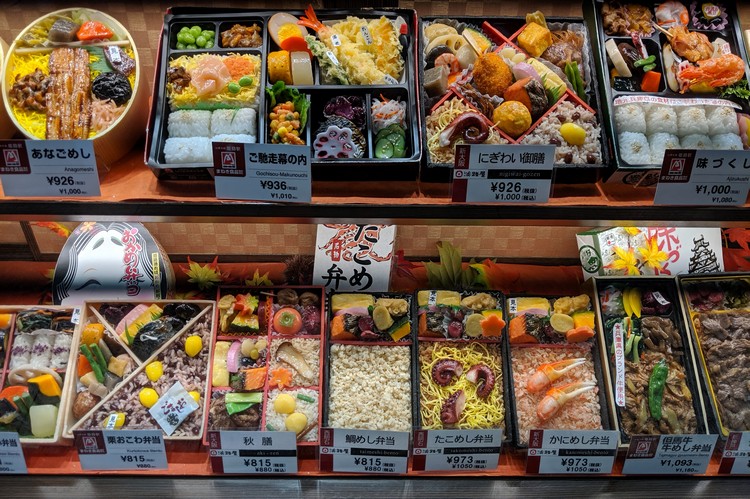
18. Bento Box
If you have not tried a japanese bento box, you are missing out. .
There are literally hundreds of varieties of bento boxes in Japan. A bento box is typically a single portion takeout or prepackaged meal, however you can also order bento boxes at restaurants. A typical bento box has a balance of dishes, most often including rice, meat or fish, and pickled vegetables.
We often order bento boxes for lunch at sushi restaurants because they offer a variety of items to sample.
During our travels in Japan, we would pick up bento boxes and bring them back to our hotel room or apartment rental. They are convenient, inexpensive and mostly healthy. Bento boxes are also a great way to sample a variety of side dishes that you might not have ordered otherwise.
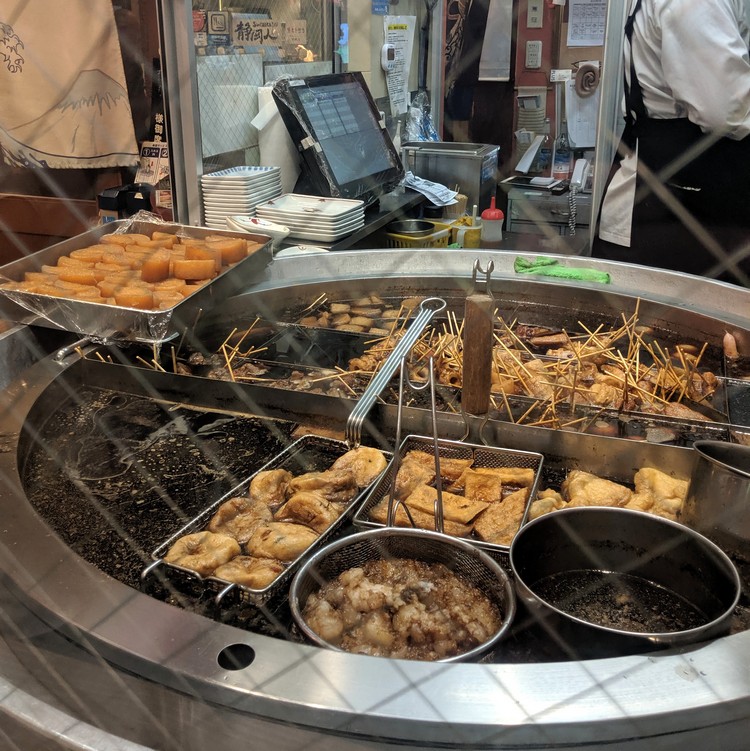
19. Oden (Japanese one-pot dishes)
Oden is an interesting part to Japanese food culture. It’s a common food in Japan that gets mixed reactions from tourists and first time visitors.
Basically, oden is a type of hotpot with an assortment of vegetables and proteins, including sausages, processed fish cakes, mochi rice cakes, daikon radish, konjac yam, tofu, and boiled eggs, to name a few. These items are stewed in a light broth and served to order. Ingredients vary according to region.
As a tourist, we had a hard time deciphering each item. In the photo above, this restaurant has a variety of items soaking in a hot broth. Guests walk up to the window and order items to take home.
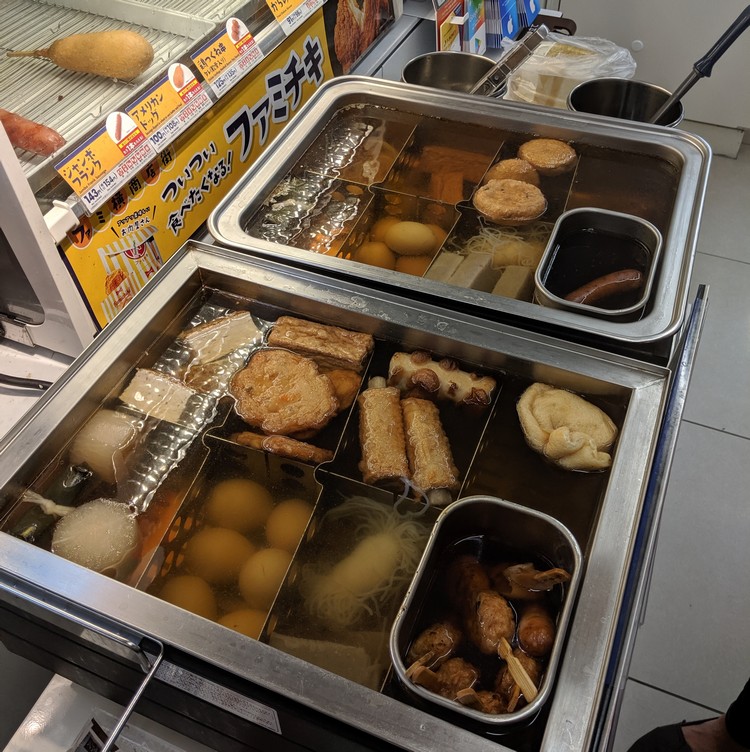
Oden at Convenience Stores in Japan
Most convenience stores in Japan will have oden during the winter months. You typically find this food at the front of the store, near the cashier. The most common convenience stores in Japan are Seven Eleven, Lawson and Family Mart.
You will find at least one of these convenience stores on virtually every block in the city. Purchasing premade food items at convenience stores is an easy way to travel cheap in Japan.
In some stores, an employee will serve you. In other stores, you help yourself. You simply take a bowl and add the specific items you would like. It’s common to add broth to the bowl to keep your items hot.
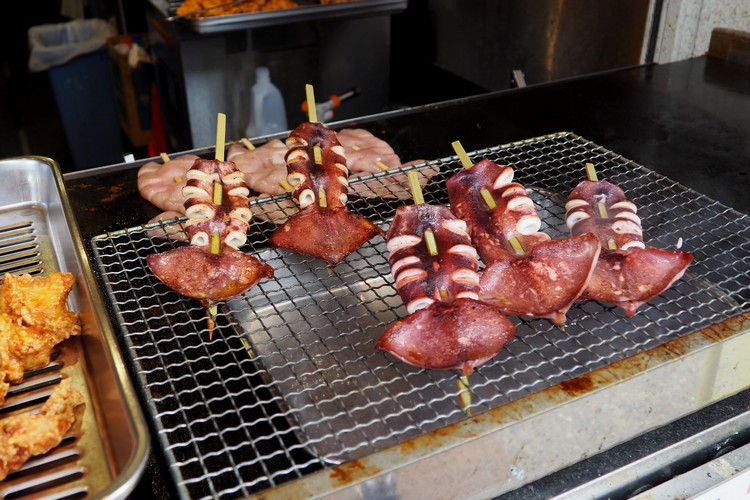
20. Street food at Japanese markets
There’s no shortage of interesting japanese cuisine at food markets in japan..
We like visiting markets when we travel because they provide insight into the food culture of a country. They typically have several vendors selling a wide variety of food items, so they’re a great place to let your curiousity run wild.
Some of the popular temples in Kyoto have rows of vendors selling grilled meats and traditional Japanese quick eats, like yakitori, grilled squid (above photo), takoyaki, hanami dango (sweet rice balls) and deep fried pastries.
If you’re looking for food to try in Tokyo, check out this list of the best food markets in Tokyo.
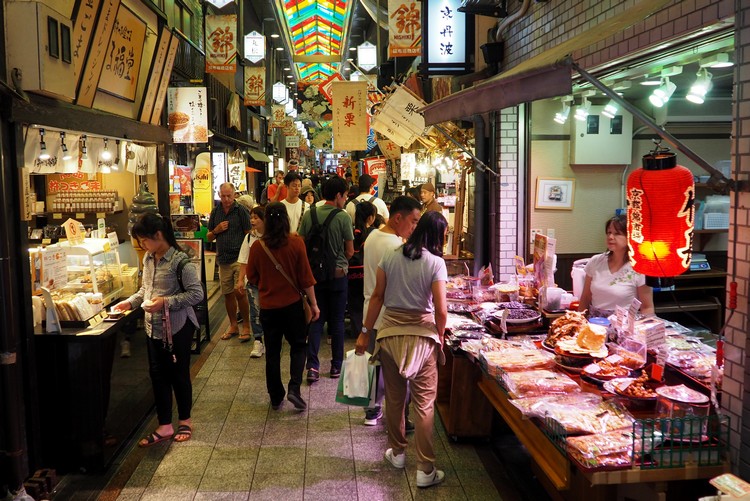
Nishiki Market in Kyoto
Known as Kyoto’s Kitchen , Nishiki Market is a great place to sample food in Japan. It’s a narrow, five block long shopping street that specializes food related items, like fresh seafood, grilled meats, produce, pickled food, dried foods and sushi.
If you’re unsure of what to try in Kyoto, Nishiki Market is a great place to start.
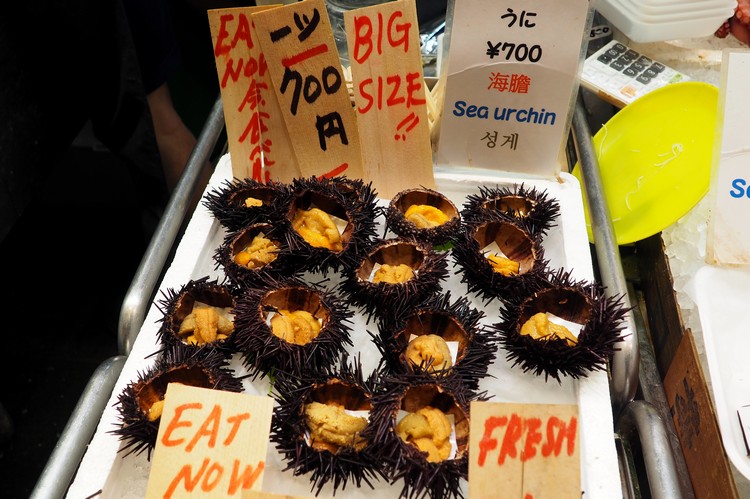
Ready to eat sea urchin at Nishiki Market.
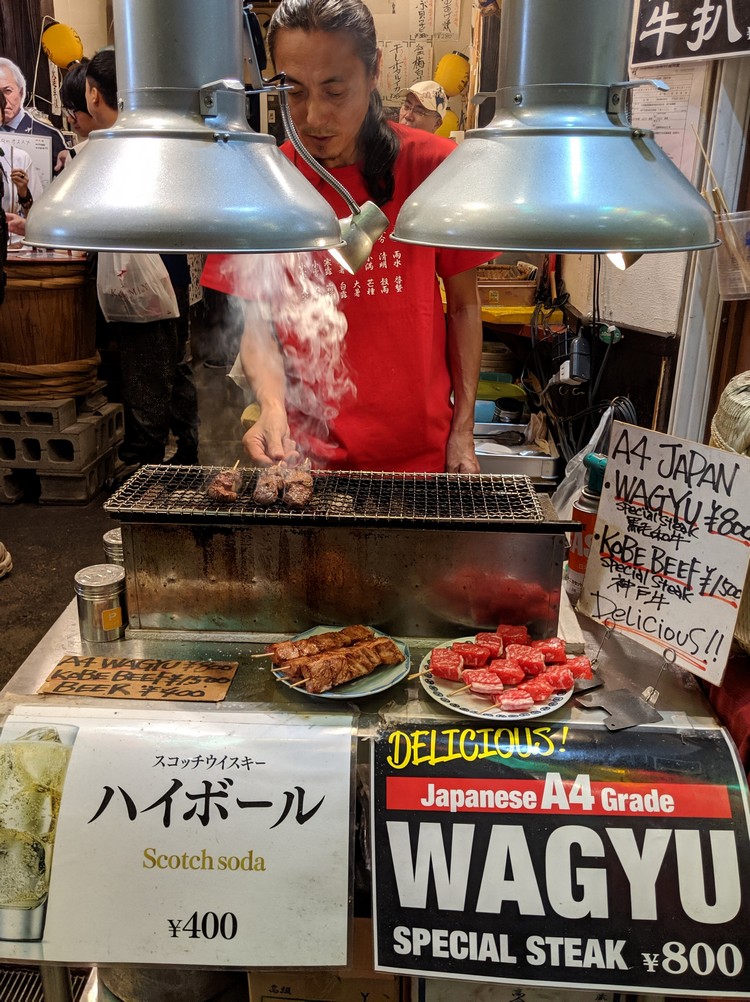
Grilled wagyu beef on a skewer at Nishiki Market in Kyoto.
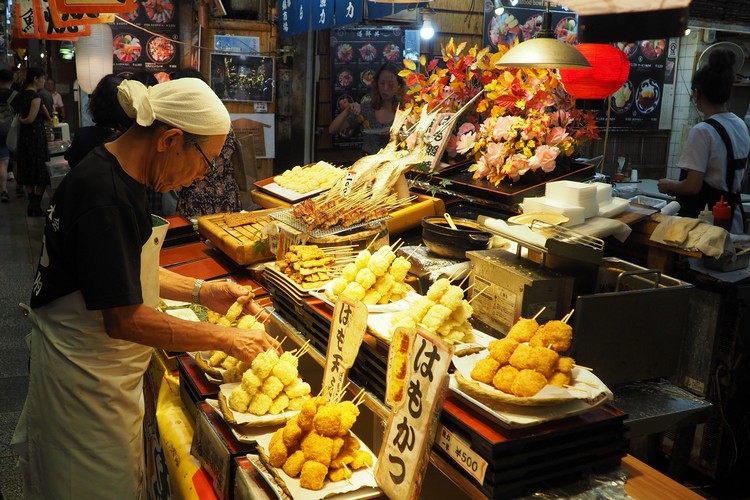
This vendor is selling a variety of steamed and fried food on a stick.
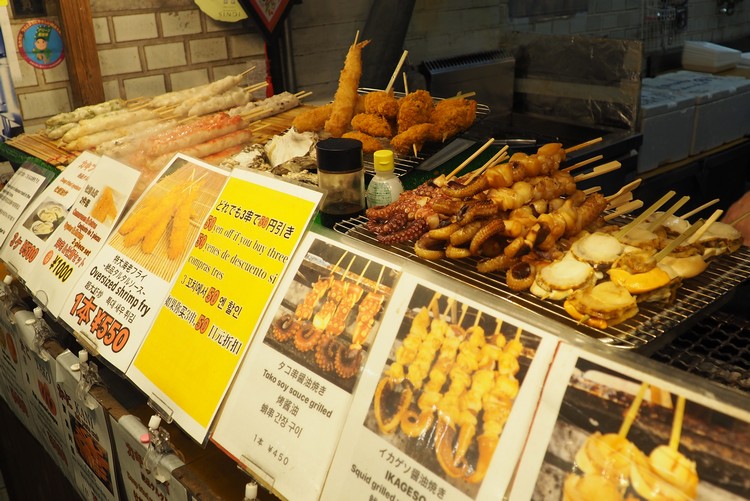
We like visiting small food vendors that sell a wide range of bite size items. It’s quick and easy way to try several different items.
Most vendors at Nishiki Market have English menus, which makes it easy for tourists to understand what they’re ordering. Each item costs between 400-800 yen, which is about $5.00 to $10.00 CAD.
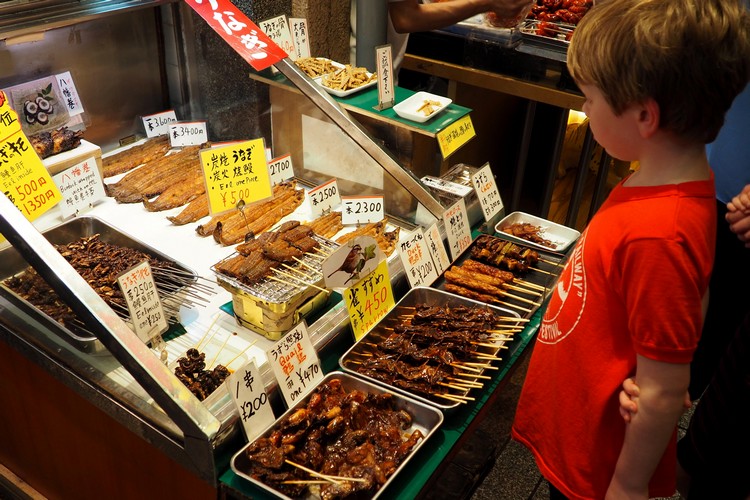
He’s not sure about these interesting food items on display at the market.
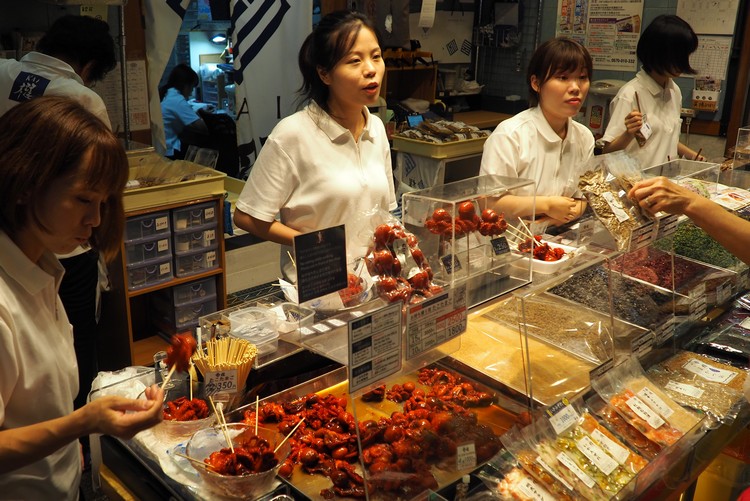
Sweet baby octopus with an egg brain?
One of the most popular and eccentric street food snacks found at Nishiki Market is Tako Tamago, which is a little red octopus on a stick.
The glazed baby octopus have a quail egg stuffed into the head, which makes for a unique flavour combo. The baby octopus has a sweet, candy-like flavour and the egg has a mushy, hard boiled egg texture. It’s quite rubbery and chewy. Not my favourite, but not too bad, either.
It’s certainly one of the more unique foods to eat in Japan, though I’m pretty sure most tourists purchase these little red octopus on a stick for the novelty. Because, let’s be honest, it’s not every day you get to eat an entire octopus on a stick, am I right?
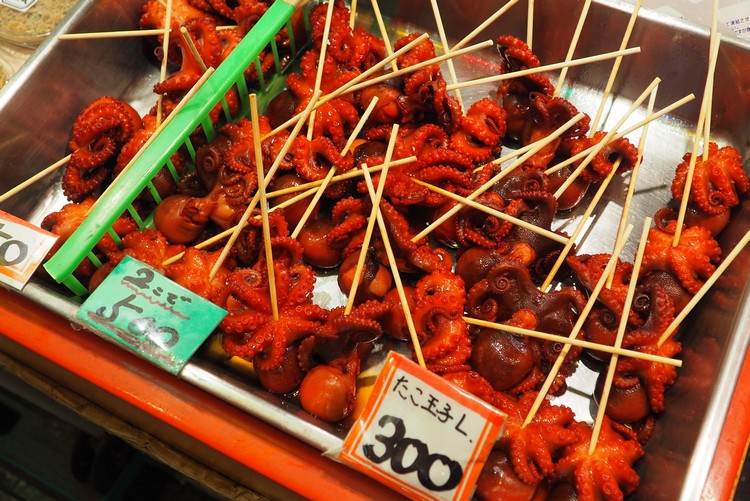
Dozens of vendors sell the popular red octopus on a stick at the popular Kyoto market.
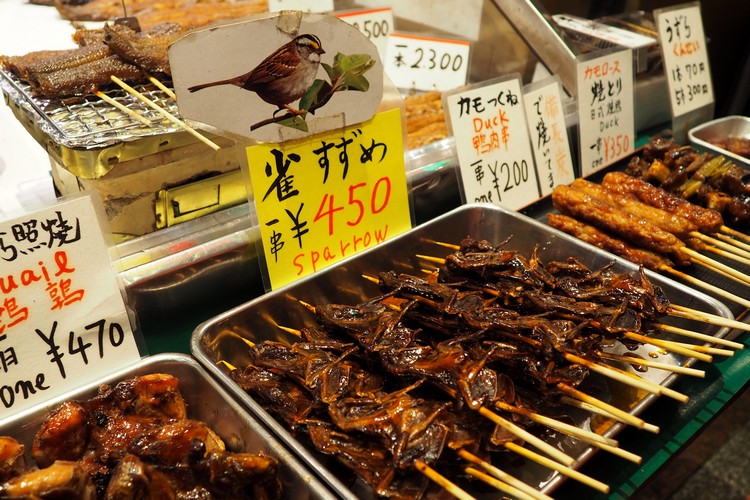
Another strange food in Kyoto is the grilled sparrow bird on a stick.
We’re told that grilled sparrow is a Japanese delicacy, but we couldn’t stomach eating this bat-like bird on a stick.
Have you tried grilled sparrow on a stick? Did you like it? Leave us a comment below.
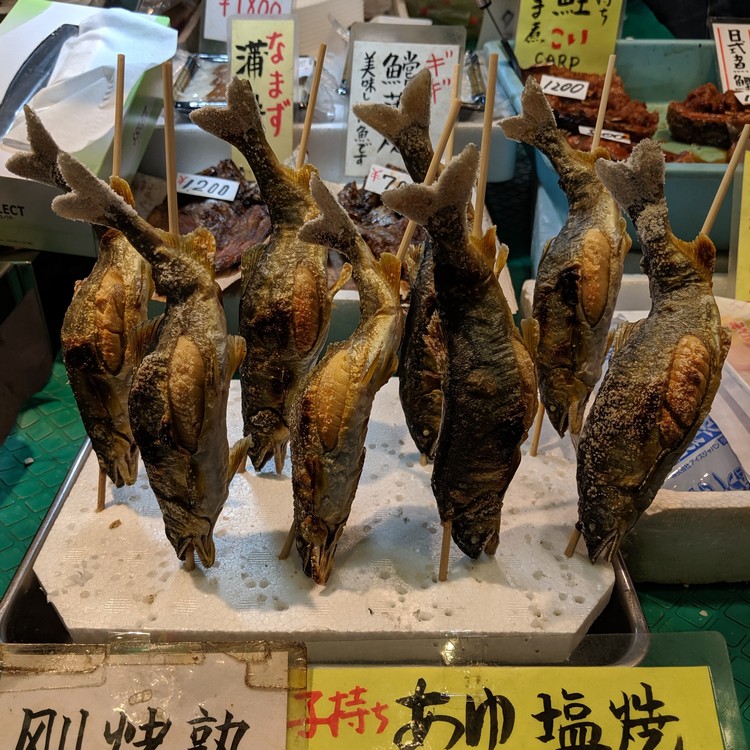
Salted fish on stick? This particular item stood out to us because we don’t often consider eating an entire fish, including the skin, tails, eyes, gills, bones, etc. I’m sure there’s a graceful way to tackle this fish without consuming everything, although I’m not sure this fish stick is for me.
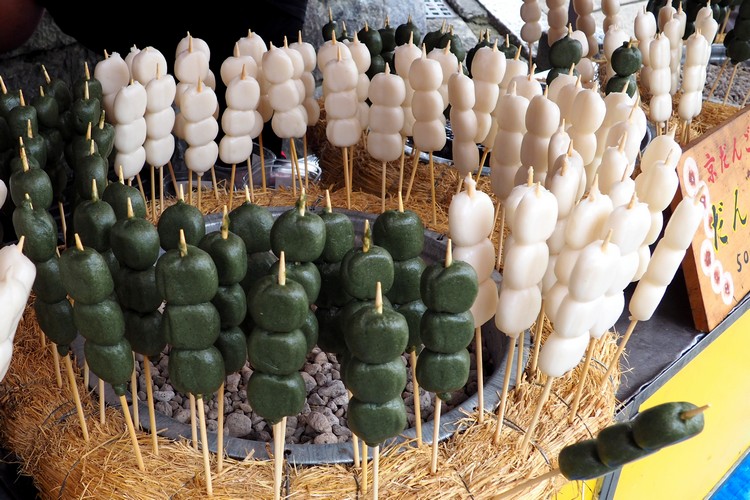
Dango is a popular Japanese sweet dumpling, similar to mochi. It’s typically served on a skewer with 3 balls per skewer. We sampled these green dango skewers near the entrance to Fushimi Inari Shrine in Kyoto.
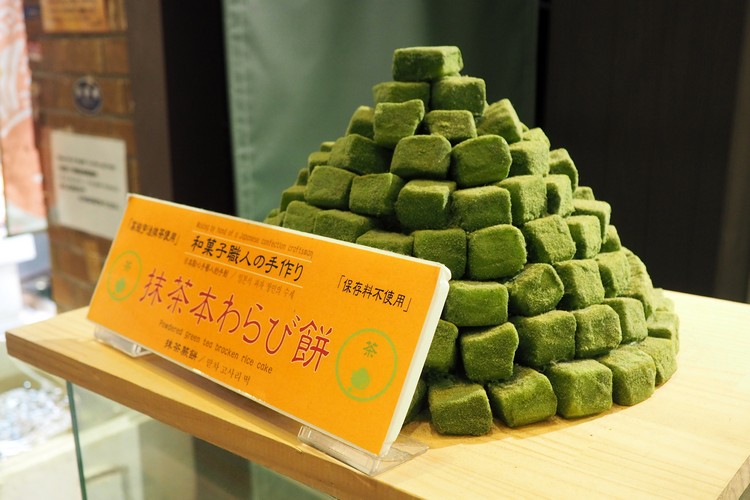
Matcha sweet rice cake on display at Nishiki Market. Matcha green tea is a big part of Japanese cuisine. You will find matcha flavoured everything in Japan, from chocolate bars to potato chips to ice cream.
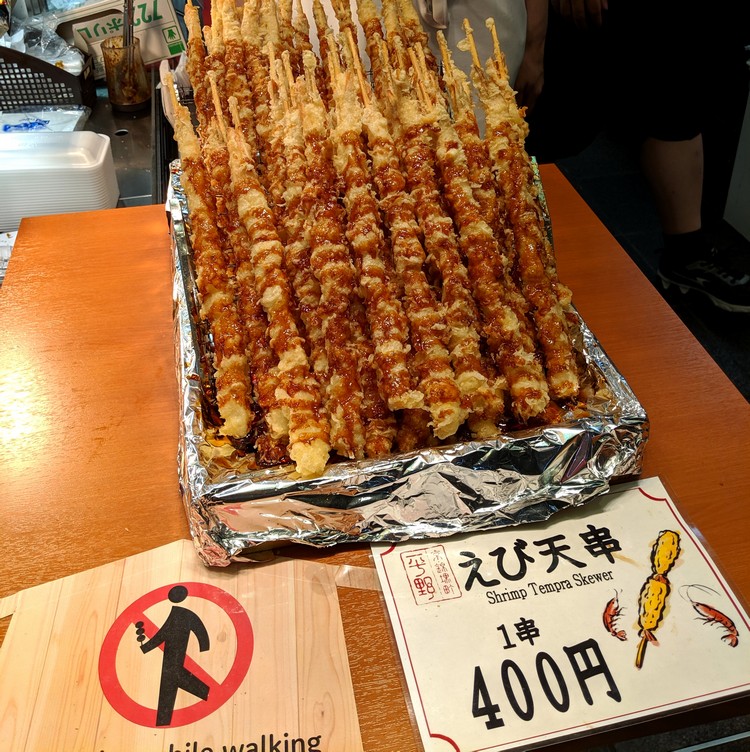
Is it okay to walk and eat in Japan?
Unlike north america, it is considered rude to walk and eat at the same time..
First time visitors to Japan will quickly learn that walking and eating in Japan is frowned upon. If you purchase food from a market or street vendor, the expectation is that you will NOT walk down the street or market while eating your food.
This applies to food purchased at convenient stores, like 7 Eleven and Family Mart. It is acceptable to eat at the place of purchase or close to the store. There’s usually a designated area for eating. If not, you will need to find an acceptable place to eat your food or bring it back to your hotel and eat it there.
Park benches in public spaces are generally okay, but avoid eating messy or strong smelling foods. It is also acceptable to drink while standing beside a vending machine.
Eating and drinking on local trains and public transportation is frowned upon. However, eating food on long distance express trains, like the Shinkansen, is acceptable.
Learn about the Do’s and Don’ts of Japan travel .
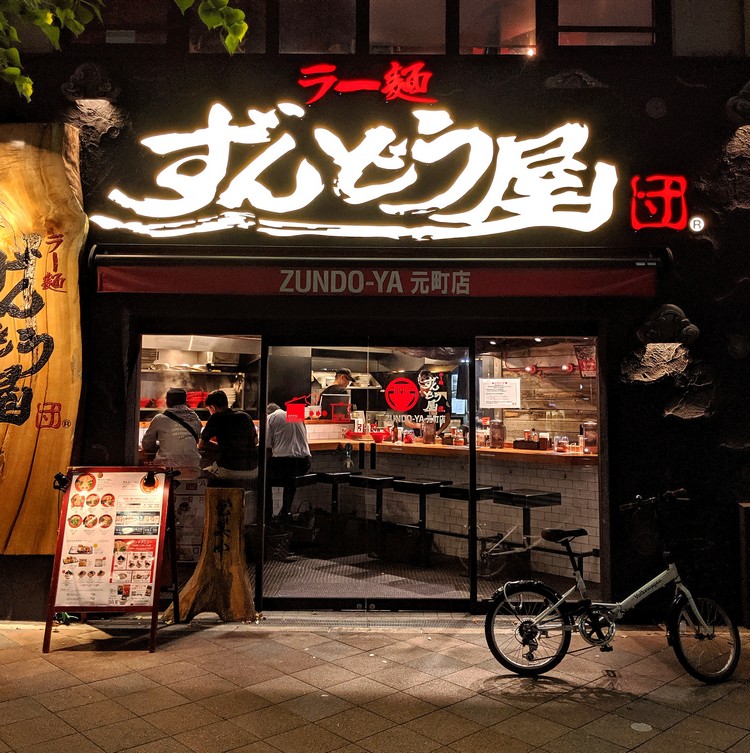
Do NOT tip at restaurants
One of the most common questions for first time visitors is – do you need to tip in Japan?
Tipping is not expected in Japan. In some cases, it’s actually considered to be rude.
This is one of the best Japan travel tips we can give – you do NOT tip in Japan.
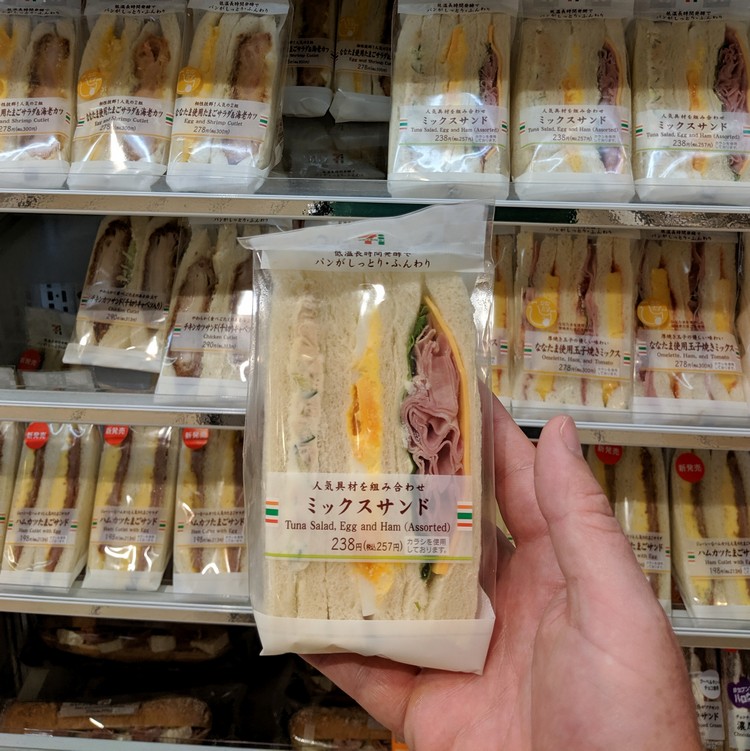
Food from convenience stores in Japan
We rarely eat at convenience stores in Canada, unless we’re on a road trip or there aren’t other food options available. In Japan, eating at convenience stores is quite common.
Japanese convenience stores have a good selection of prepared food, from sandwiches to bento boxes to baked goods. We often grabbed prepackaged sandwiches (picture above) and pastries for breakfast each morning.
One of the most popular snacks to eat in Japan is Onigiri . Onigiri are rice balls formed into triangular or round shapes and wrapped in seaweed (nori). Some are filled with fish (tuna, salmon, mackerel, shrimp, etc), chicken, pork, vegetables, egg and fried food, like tempura and tonkatsu. Onigiri is a cheap Japanese food that’s is easy and widely available at almost every convenience store in Japan.
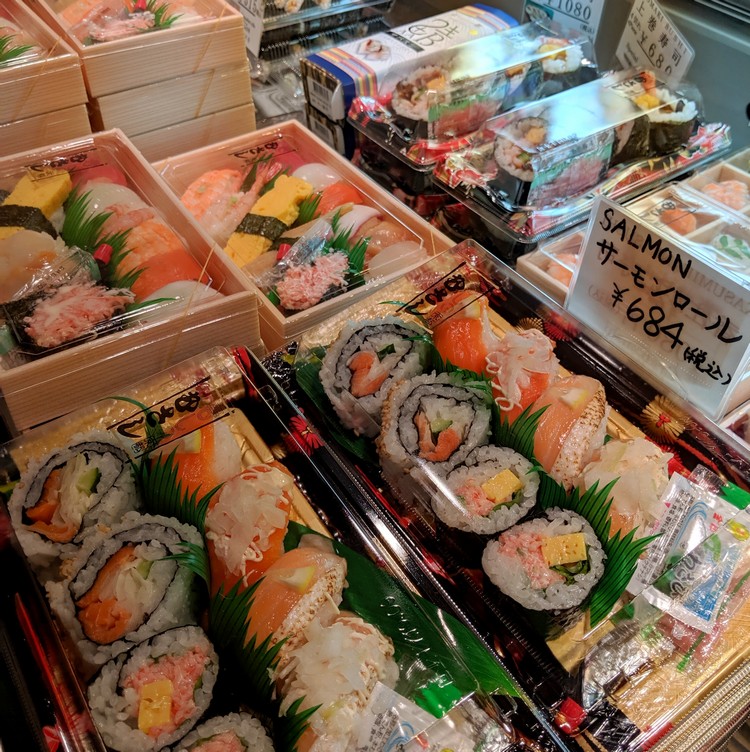
Variety of prepackaged sushi rolls and nigiri combos at the Kyoto train station.
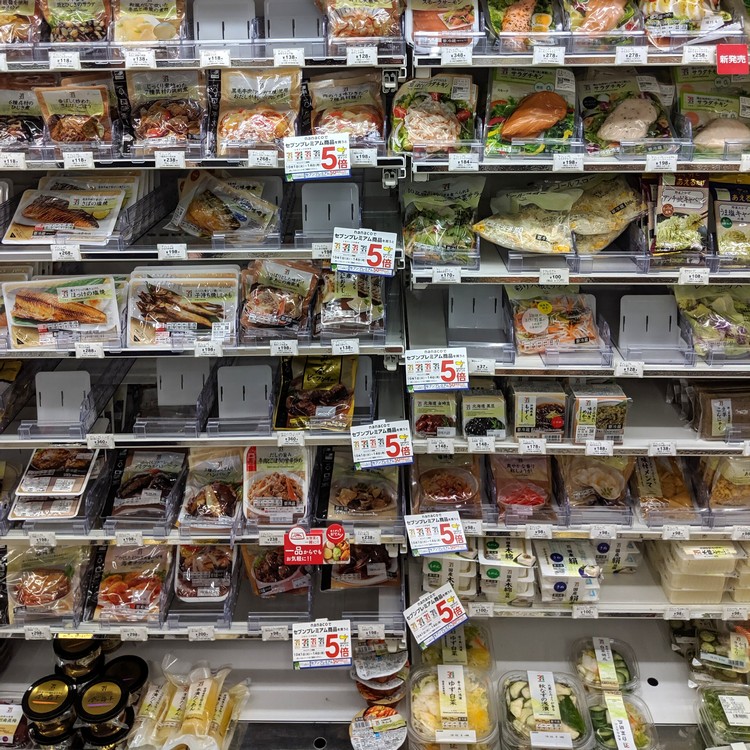
Convenience stores in Japan have plenty of prepackaged meals available for takeaway.
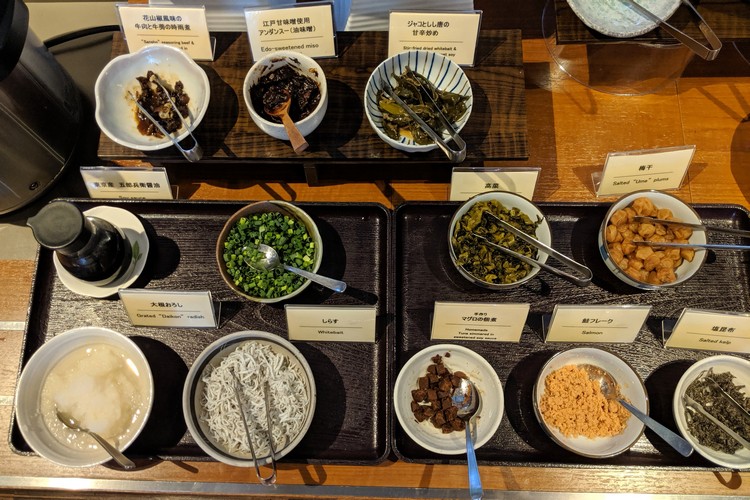
Japanese Breakfast at Hotels
I though it worth mentioning the hotel breakfast situation in Japan, given that many European travellers expect breakfast to be included with the hotel price.
Depending on your hotel, breakfast may be available. But don’t expect breakfast to be included in the hotel room price. Some budget hotels will not have breakfast available at all.
Japanese breakfast is quite different from North American and European breakfast.
Typically, a traditional Japanese breakfast consists of steamed rice, miso soup, grilled fish and a variety of side dishes. You will find a lot of pickled vegetables, garnishes, dried food and other items that you might not associate with breakfast.
This is a great way to sample new flavours and items you might not order at a restaurant. Ask questions and give the Japanese breakfast items a try. You never know, you might just like fermented soy beans (natto) and dried horse mackerel for breakfast?
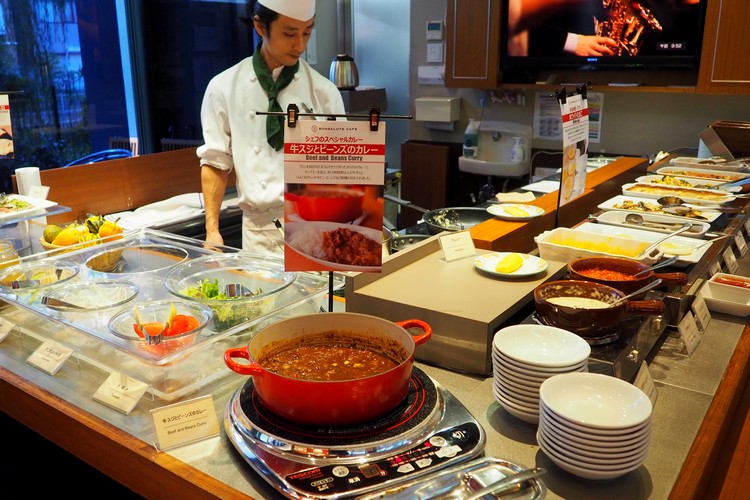
The breakfast buffet at the Hotel Gracery Tamachi in Tokyo.
Order your food from a Vending Machine
One of the things we love about Japan is that everything is efficient and convenient. A perfect example of this efficiency is the electronic vending machines located outside many Japanese restaurants.
The touch screen machines often have photos of each dish, which is convenient and avoids the potential language barrier that may arise if you had to order from a server who does not speak English.
The process is simple. You select the food you want from the touch screen machines, pay with cash or credit card, grab your receipt and head inside. The food is then delivered to your table or your number is called and you pick it up from the counter.
Once you are finished eating your meal, you simply get up and leave. No need to wait for a server to bring the bill or wait to pay. It’s a very efficient system that removes service breakdown.
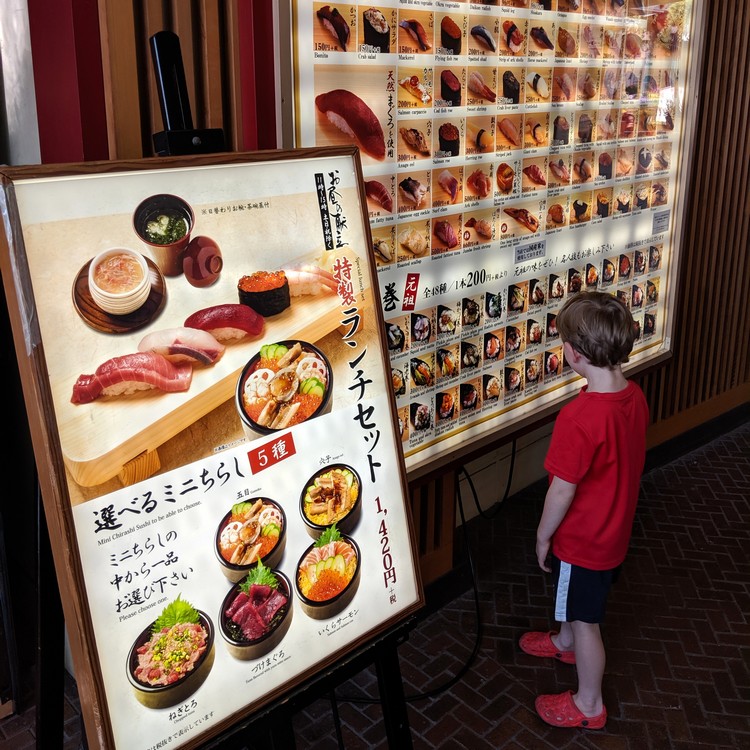
Food in Japan for kids
If you’re travelling to Japan with kids, you’re liking concerned about whether your kids will enjoy the food in Japan. There’s nothing worse than constantly battling your kids to eat.
Our boys like Japanese food, so we knew they would like eating at Japanese restaurants. However, our concern was that after a few days they would get bored and start complaining.
Fortunately, Japanese food is quite diverse and, as you’ve seen in this beginner’s guide to food in Japan, there are plenty of options to choose from.
Travel tips for eating in Japan with kids
- Shop at convenience stores. Pick up prepackaged food, snacks, pastries and drinks from convenience stores and bring them back to your hotel room. You don’t have to dine out for every meal. Give yourself a break if your kids are burnt out.
- Vending machines are everywhere in Japan. Keep some change in your pocket because you’ll find these vending machines do the trick when your kids are thirsty.
- Look at the plastic dishes in the window. Most Japanese restaurants have plastic replicas on display. Let your kids see the available options and pick a dish that interests them before you enter the restaurant. That way there’s no confusion over what to order when you sit down.
- Download Google translate. When you have a Lost in Translation moment, ask the Google for help.
- Eat breakfast in your hotel room. We purchased a bag of Frosted Flakes from a Family Mart and our boys had cereal for breakfast each morning. It saved us time and money.
- Bring snacks from home. Pack your luggage with your kid’s favourite snacks, treats and cereal. Sometimes a familiar treat is all it takes to get your kids feeling normal again.
- There are lots of fast food restaurants in Japan. Sometimes chicken nuggets from McDonald’s is the answer. We get it. Don’t worry, Japan has most of the big names in fast food. It’s okay to give yourself some comfort food from home when you’re travelling.
Read these helpful Japan travel tips for first timers .
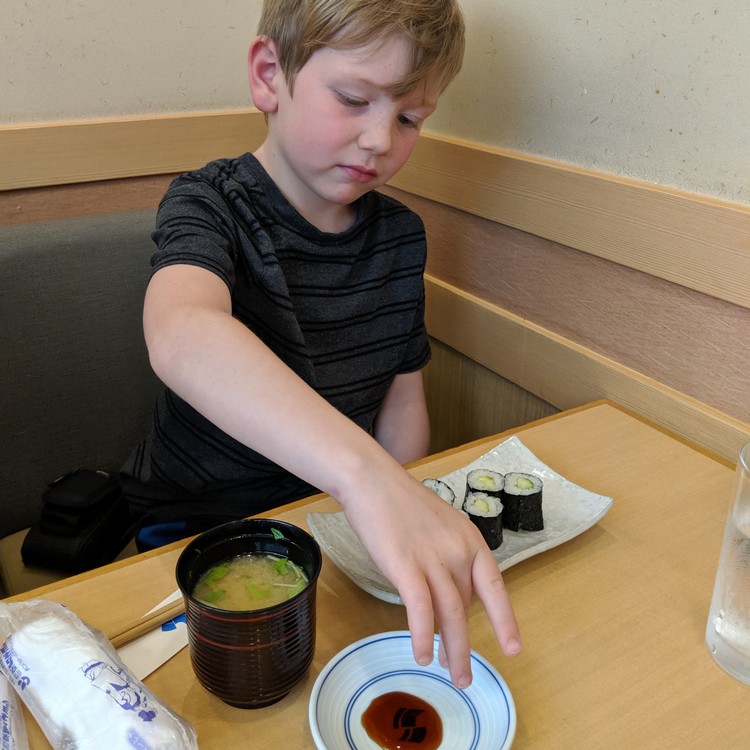
For an easy introduction to sushi, order your kids the cucumber roll (kappa maki) with a miso soup. Let them play with the chopsticks and experiment. If they don’t like the sushi roll, no big deal. These are typically the cheapest items on the menu.
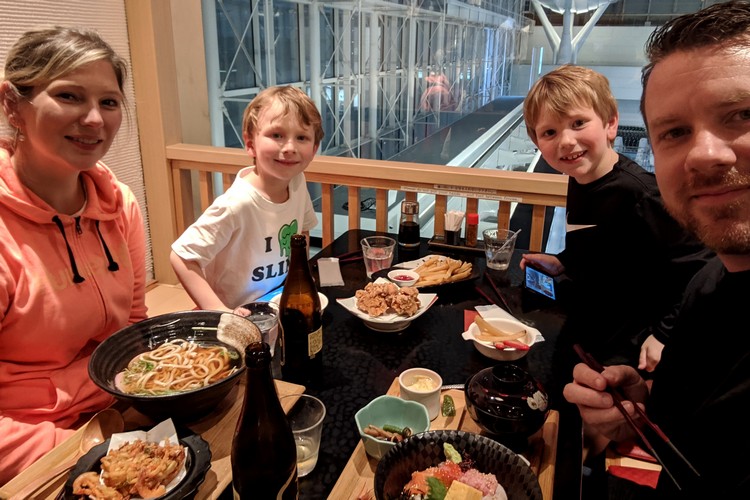
Most Japanese restaurants that serve chicken karaage will also have French fries on the menu. We told our boys that we ordered them chicken nuggets and fries. They rarely noticed the difference.
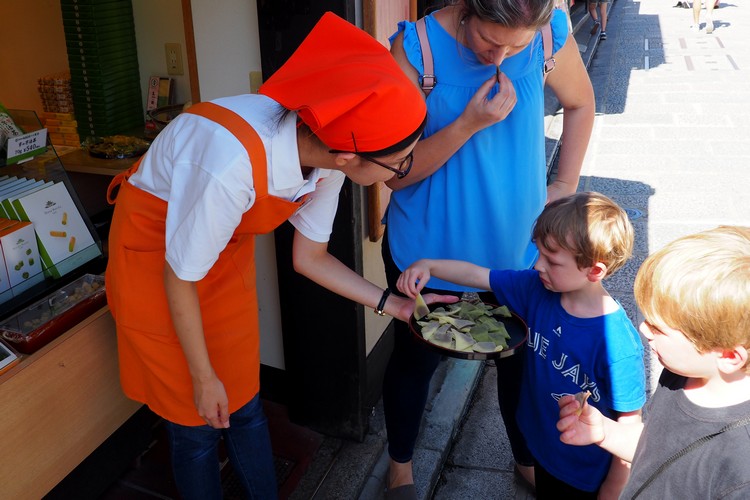
Our boys did pretty good at trying new food. Like most kids, their natural default is to resist food that is different or foreign. However, the more Japanese food they tried, the more comfortable they got.

Don’t worry, if your kids don’t like the food in Japan, there’s always donuts!
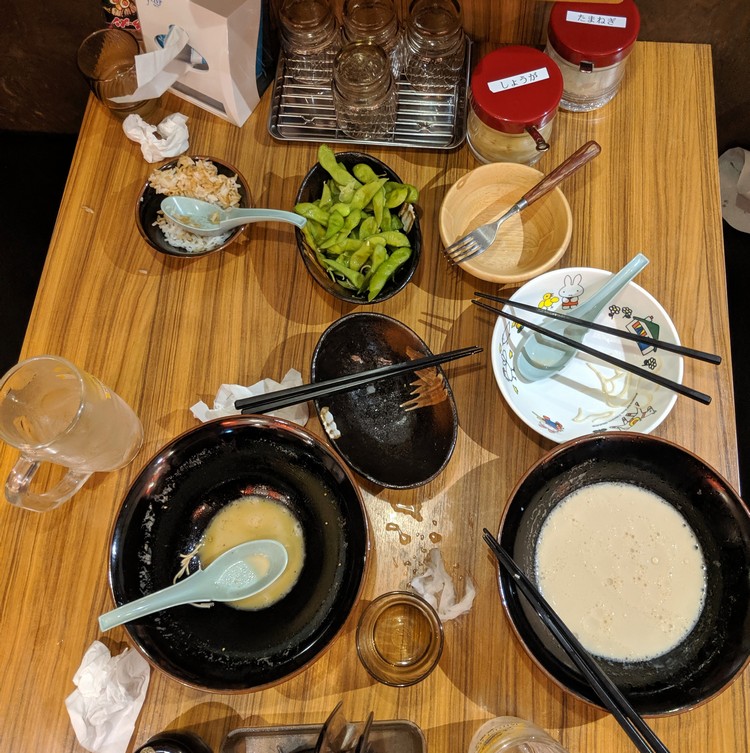
And that’s a wrap! We hope you enjoyed this tasty beginner’s guide to food in Japan.
More blog posts from our trip to Japan:
- How to spend 3 days in Tokyo: Travel guide for first time visitors
- Staying at Tokyo Disney Resort – what you need to know
Have you visited Japan? What is your favourite food in Japan?
Leave a comment below. Our readers thank you!
Related posts:
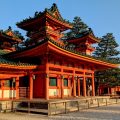
10/20/2020 at 3:33 pm
Very good presentation of food in Japan! Having family in Tokyo we have been traveling around Japan the last 8 years, so I find this post the best about your experience in Japan! It is a pleasure to follow you ,thank you for sharing your travel experiences! You inspired us to go to some places in BC! And it was worth it…We can’t wait to take our grandchildren living in Tokyo to some places where you have been traveled with yours! Wonderful travel blog!
12/21/2020 at 7:14 pm
This is a great intro to Japanese food! Japan is obviously one of the great places to try new things!! And it looks like you and your family tried a lot!! Thanks for sharing and happy #TravelBlogTuesday 🙂
02/19/2021 at 3:31 pm
What a great source and extensive knowledge of food from here. A great read and will certainly be using the post in the future
07/19/2021 at 5:53 am
What a fabulous post about food in Japan! Should be required reading for first-time travellers to Japan. Happy travels.
Leave a Reply Cancel reply
Your email address will not be published. Required fields are marked *
Yes - Subscribe me to your monthly newsletter!
This site uses Akismet to reduce spam. Learn how your comment data is processed .

Food in Japan: 32 Popular Dishes You Need to Try on Your Next Visit
Satisfy your cravings for food in Japan with our list of 32 must-try Japanese dishes. From teppan to ramen to gyoza , we've got you covered.
Japanese cuisine is renowned worldwide, but there are numerous other dishes to sample besides sushi . While many are familiar with sashimi , tempura , and ramen , Japanese culinary culture is much more diverse. If you are planning a trip to Japan, you may wonder what foods are worth trying. To assist you in making a decision, we have assembled a list of 32 delectable Japanese dishes that everyone should experience.
1. Buta-No-Shogayaki (豚の生姜焼き): The 'B-Grade Gourmet' Ginger Pork Classic
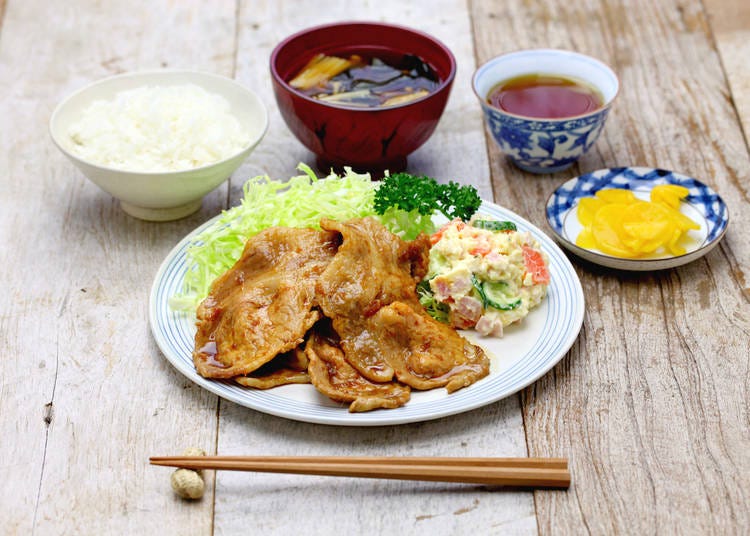
Buta-No-Shogayaki is one of the most popular and delicious Japanese dishes that you can find in many restaurants, izakayas (traditional Japanese restaurant/ bars ), fast food chains, and even as a bento box (a pre-prepared Japanese-style lunch) available in many grocery stores and convenience stores . The word "yaki" literally means "grilled." This dish is prepared by grilling thin slices of pork that are dressed with a delicate sauce made of mirin, soy sauce, sake (Japanese rice wine), granola oil, sliced onions, and ginger. This dish is perfect for a quick and tasty meal that you can enjoy any time of the year.
2. Champon (ちゃんぽん): The Essence of Japanese Noodles
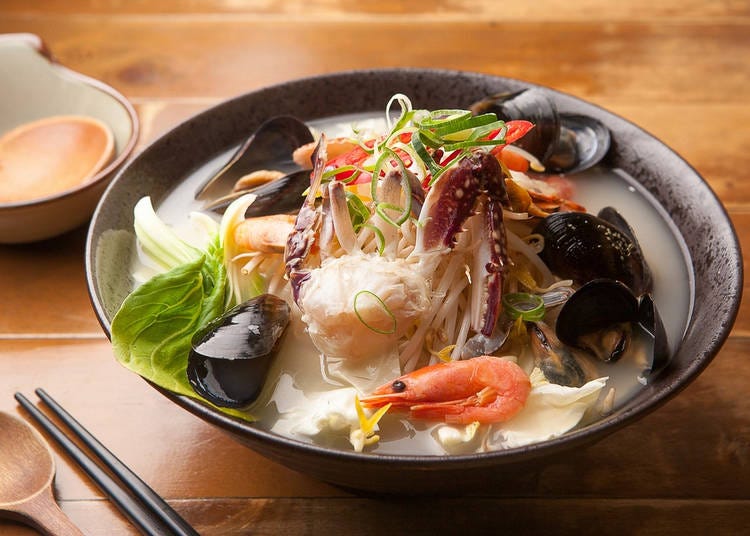
At first glance, Champon might be mistaken for ramen , but it is actually a unique dish in its own right. Originating from Nagasaki , it was first served in a Chinese restaurant during the Meiji era (1868-1912). Unlike ramen , the noodles used in Champon are boiled in the soup itself, giving it a distinctive taste and texture. Champon is a seasonal dish that uses a combination of ingredients such as pork, seafood , and vegetables. These are fried in lard before a soup made from chicken and pig bones is added to create a flavorful broth. As a result, each serving of Champon is different and offers a unique experience that varies depending on where you eat it. In fact, Champon is not just limited to Nagasaki ; it can be found in many countries throughout Asia and in different regions of Japan. Each place puts its own spin on the dish, creating a diverse range of styles and flavors that are sure to satisfy your appetite.
3. Edamame (枝豆): The Irresistible Boiled Soybean Snack
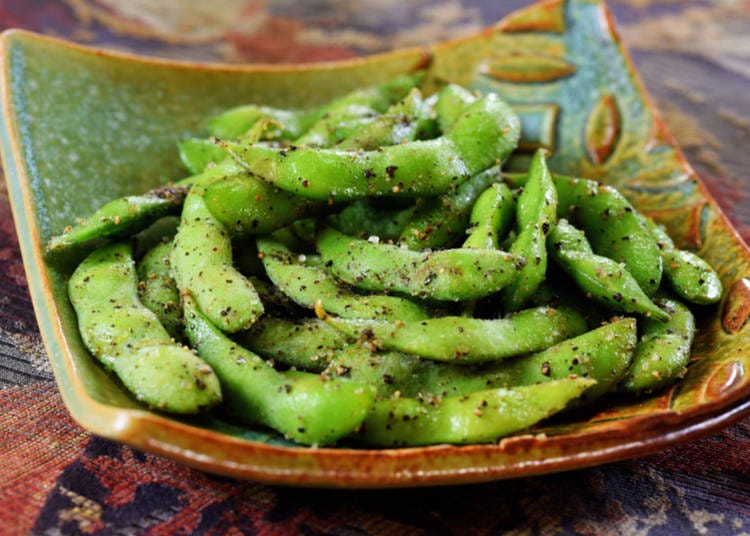
Edamame are not technically a dish, but they are a very popular food in Japan. These are immature soybeans that are still in their pods. They can be served hot or cold, and sometimes grilled instead of boiled. Typically, they are only dressed with salt, and they make for an amazing appetizer. Once you try a few, you'll find yourself reaching for more and more. Edamame usually accompany a meal in all izakaya , and they are almost always part of the menu in the vast majority of Japanese restaurants in Japan.
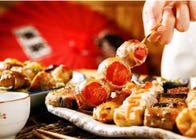
4. Fugu (ふぐ): The Delicate Dance with Pufferfish
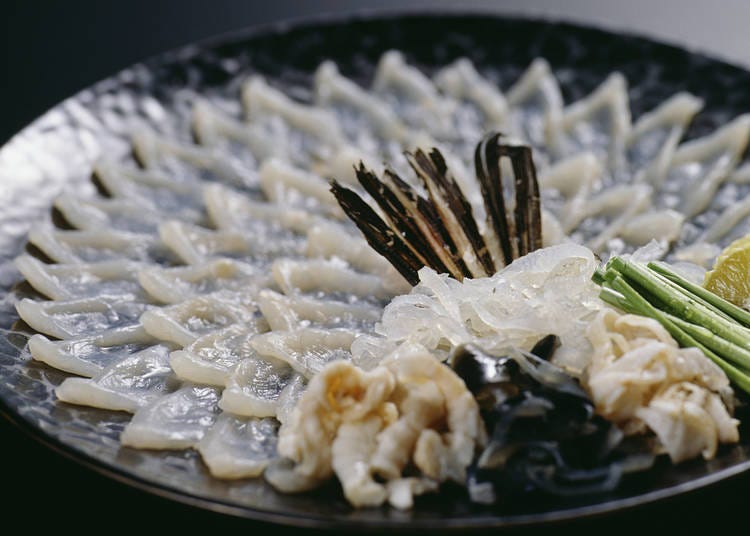
For those looking not only for amazing food in Japan, but also for a thrilling experience, fugu is the dish to try! The fugu is a pufferfish that is, yes, delicious, but it can also be lethal due to a toxin in some parts of its body. Fugu is usually served as sashimi or in certain kinds of Japanese nabe hot pots . The preparation of this fish, due to its characteristics, is rigidly controlled by the Japanese government. Chefs who aspire to prepare this fish must undergo at least three years of very rigorous training to get their license. Before being served, the toxic parts of the fish are removed, making it safe to serve. Interestingly, fugu liver is considered the tastiest part of the fish, but it’s also the one that can be the most poisonous. As a result, serving fugu liver was outlawed in Japan in 1984. Should you try this dish, you’ll certainly remain amazed by its taste, but do careful research before ordering it in a restaurant (and never try to prepare it by yourself).

5. Gyoza (餃子): The Delightful Journey of Japanese Dumplings
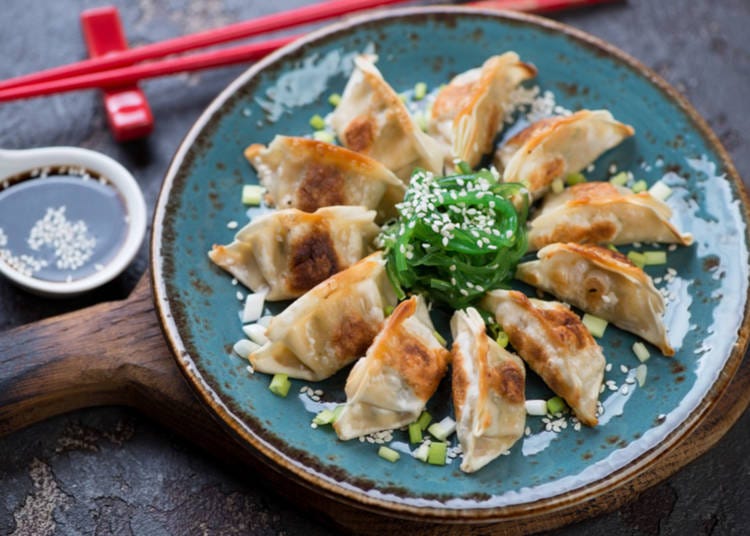
Gyoza are dumplings that are shaped like a crescent moon. They are a popular dish in Japanese restaurants and can be found almost everywhere, regardless of their style. Although originally from China, the types of gyoza you will find in Japan are usually quite different from the original. There are various types of gyoza available in Japan, but one of the most popular is "yaki- gyoza ". These dumplings are made with minced pork, cabbage, garlic, onion, and ginger. They are then lightly fried until they become crispy and turn a nice dark golden color. You can enjoy gyoza with a dip made of soy sauce, rice vinegar, and spicy oil.
6. Gyudon (牛丼): The Bowl of Beefy Goodness
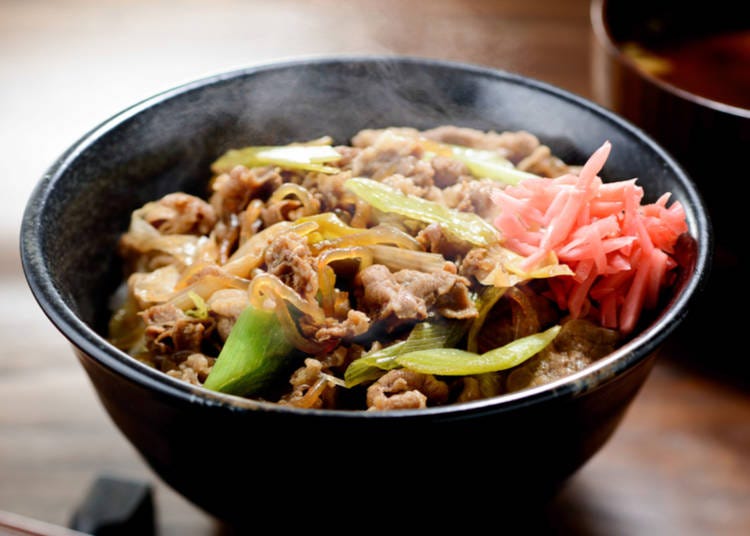
Gyudon is a mouth-watering dish consisting of beef served over rice (gyu = beef). It is a quick meal that is often served in specific restaurants or Japanese fast-food chains such as Yoshinoya. To make this dish, thinly sliced beef and tender onion are simmered in dashi broth (a popular Japanese ingredient) and then seasoned with mirin and soy sauce. The dish is then served over a bowl of steamed rice. Sometimes, it is topped with a lightly cooked egg. If you want to experience a typical Tokyo office worker’s lunch break, this quick and tasty dish is a must-try. You will feel full and satisfied, and ready to continue your sightseeing and exploration with renewed energy.
7. Gyukatsu (牛カツ): The Lure of the Beef Cutlet
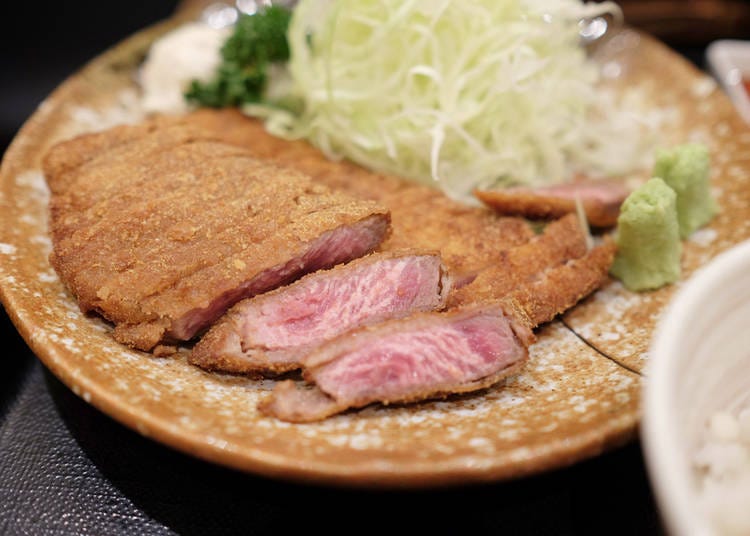
If you're fond of tonkatsu , a popular pork-based dish, you should definitely give its beef variation a try. This dish involves deep-fried breaded beef, which is served with a side of cabbage, barley rice, miso soup, potato salad, and pickles. The preparation method results in a tender and crunchy texture, and the dish has a flavorful taste that's not too overwhelming. Although it's not as commonly available as the pork version, if you do happen to come across it, it's definitely worth trying.
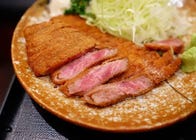
8. Gyutan (牛タン): An Ode to Beef Tongue Delicacies
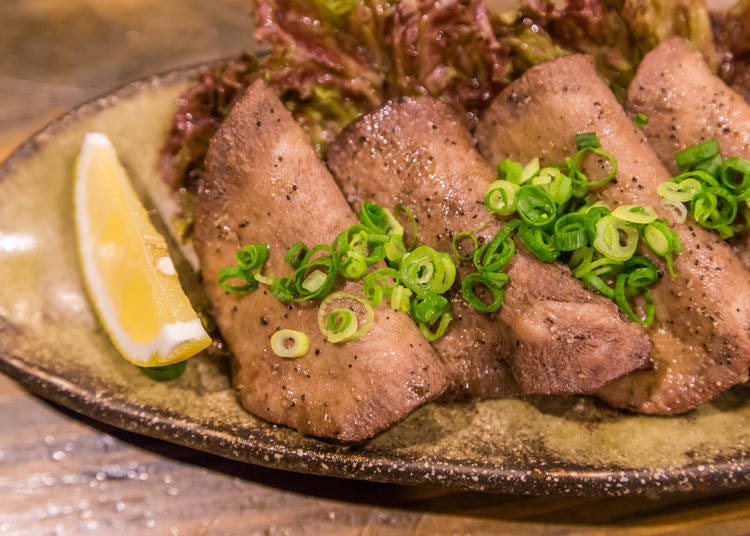
At first glance, this dish may seem unusual depending on where you're from, but we encourage you to keep reading. Gyutan is a dish made of grilled beef tongue, as the name suggests - "gyu" meaning cow and "tan" meaning tongue. This dish is typically found in yakiniku restaurants, prepared with salt or various sauces (often including lemon) and scallions. The meat is thin, delicious, and tender. Gyutan originated in Sendai, where the owner of a yakitori restaurant opened a new establishment in 1948 which offered gyutan. Since then, the dish has become increasingly popular throughout Japan. Give it a try and you'll quickly see why!
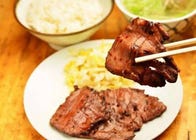
9. Karaage (から揚げ): Japan's Tasty Fried Chicken
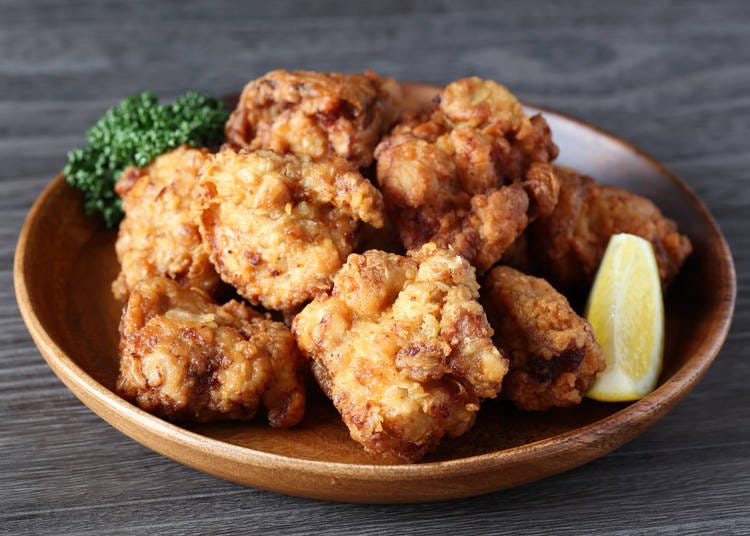
When you arrive in Japan, you will instantly notice the popular Japanese fried chicken dish called karaage. Although karaage usually consists of chicken, some regions may use other meats such as pork. The meat is lightly coated with wheat flour or potato starch and is then deep-fried in oil. In some cases, the meat is marinated before cooking. Karaage is typically served with a slice of lemon, but it can be enjoyed with or without it. Restaurants, street-food carts, izakaya , and convenience stores frequently serve the chicken variety of karaage. It's a delicious, fast, and affordable dish. However, the only downside is that it's so tasty, it can be addictive!
10. Katsudon (カツ丼): The Breaded Pork Bowl
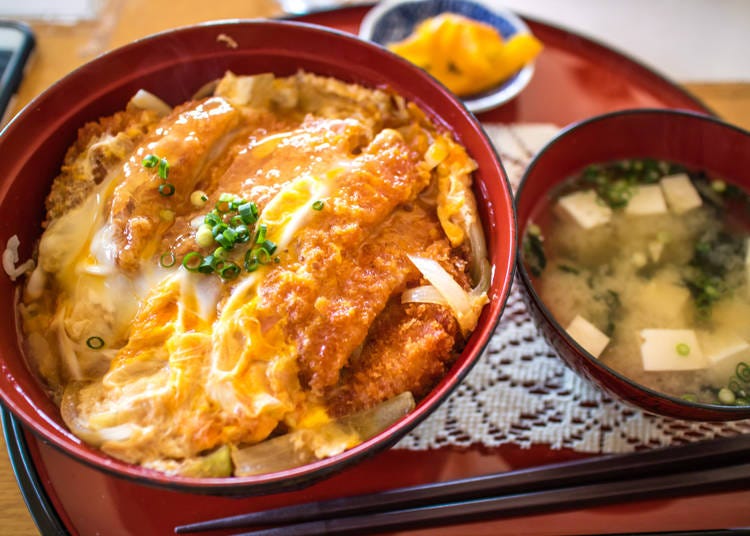
If you're a fan of beef bowl dishes like gyudon, you'll love Katsudon, a similarly popular Japanese dish made with pork. This tasty and affordable meal is often overlooked by foreign visitors, but can be found in many restaurants and Japanese-style fast food chains. The dish consists of a bowl of rice topped with deep-fried pork cutlet, egg, vegetables, and condiments, making it the perfect option for those on the go. Although it's a common dish in Japan, there are several varieties to choose from, including those served with tonkatsu sauce, demi katsudon (a specialty of Okayama ), shio-katsudon (flavored with salt), or miso-katsu (originally from Nagoya). Regardless of which type you choose, you're sure to enjoy this delicious and satisfying meal!
11. Kushikatsu (串カツ): Thrilling Skewered Deep-Fried Treats
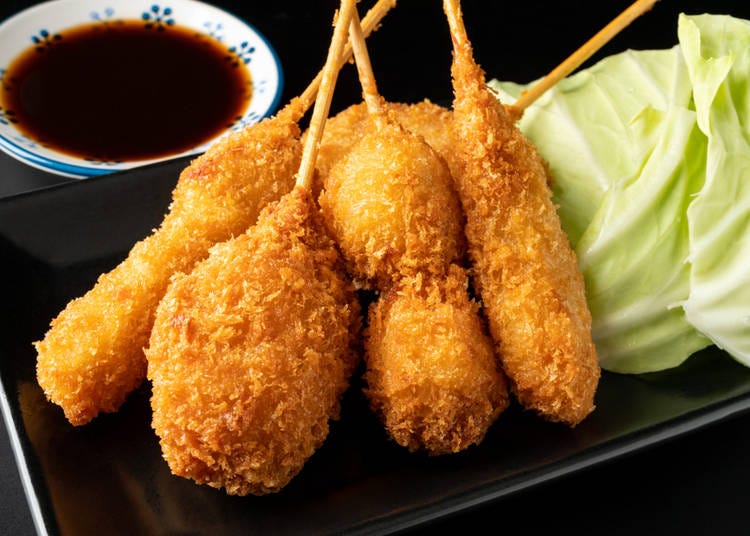
Kushikatsu , also known as kushiage, is a delicious dish consisting of crunchy deep-fried skewered meat, fish, or vegetables. The name of the dish refers to the way it is prepared, with "Kushi" meaning skewers and "katsu" referring to the deep frying of a meat cutlet. Kushikatsu can be made using a variety of ingredients, including bamboo shoots, lotus root, cartilage (nankotsu), and gizzard (sunagimo). Each ingredient has its unique flavor and texture, making the dish even more exciting to taste. Apart from the different ingredients, there are also several geographical varieties of Kushikatsu . For example, Osaka and Tokyo (which also serves pork rib kushikatsu ) prepare the meat slightly differently and dress it with brown sauce. In Nagoya, Kushikatsu is served with doteni, a rich miso-based dish with beef tendon, offal , and daikon radish. The region also uses different sauces and batter to prepare the dish.
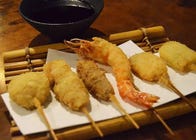
12. Miso Soup (味噌汁): The Soul-Warming Broth
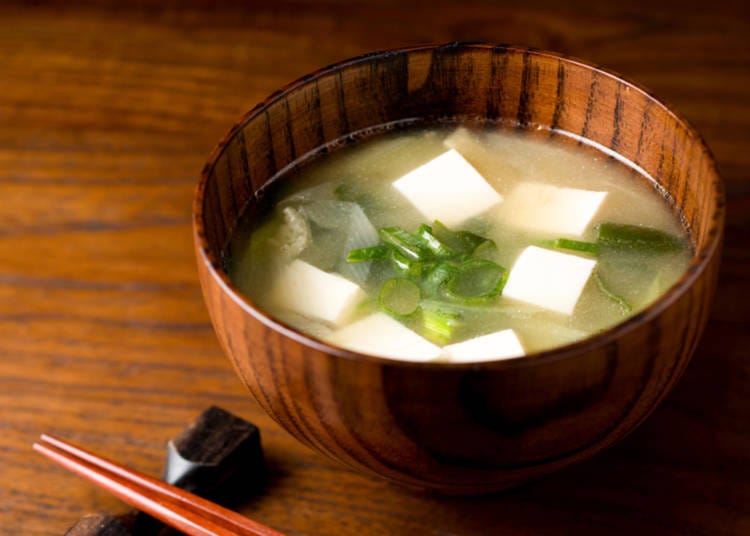
Miso soup is an unavoidable dish when it comes to talking about food in Japan. It is a staple in Japanese cuisine and can be served with almost any meal, be it breakfast, lunch, or dinner. This simple yet flavorful soup makes a fantastic side dish to complement the rest of your food. Dashi, one of the primary ingredients in miso soup, is mixed with miso paste, which is made by fermenting soybeans, to create this famous soup. Other ingredients are added according to individual preferences. Typically, miso soup is served with tofu , scallions, and wakame seaweed. However, other ingredients such as daikon, shrimp, fish, mushrooms, potatoes, onions, or meat can also be added. Miso soup is highly recommended during the cold winter months, and it is a must-try dish before leaving Japan.
13. Nabe (鍋): Enjoy Japan's Hot Pot Culture
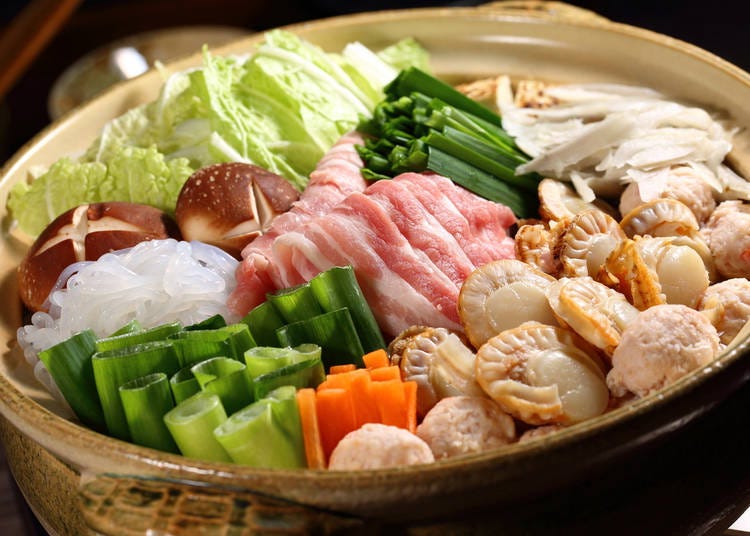
Nabe refers to a cooking pot, and in Japanese, it can also be referred to as "nabemono," which translates to "things in a cooking pot." While the name suggests that it's a simple dish, in reality, there are many variations of nabe in Japan. It's a popular dish throughout the year but is particularly enjoyed during colder months. Nabe is a dish that can be enjoyed both in Japanese restaurants and at home. The preparation involves boiling a variety of ingredients such as meat, fish, shellfish, vegetables, and tofu in seasoned or unseasoned water. Sumo wrestlers are known to be big fans of nabe , especially "chanko nabe ," which usually includes meatballs, chicken, vegetables, and noodles. It's designed to be served with extra ingredients so that wrestlers can gain weight. Another popular variation of nabe is shabu-shabu , named after the sound made when thinly-sliced meat is dipped into boiling water. This dish is served with beef or pork, vegetables, and tofu and is enjoyed with a sesame dipping sauce or ponzu, which is a lemon-based dressing, or a combination of both. Sukiyaki is a sweeter version of shabu-shabu where the ingredients are stewed in sweetened water and soy sauce and then enjoyed with a raw egg dip. Yose nabe , which means "putting together," is a nabe variety where all the ingredients, such as meat, fish, vegetables, and tofu , are cooked together in the pot at the same time. This dish is usually based on a soup of miso or soy sauce. There are many types of nabe available in Japan, and it's definitely worth trying them all to find your favorite!

14. Natto (納豆): The Fermented Soybean Sensation
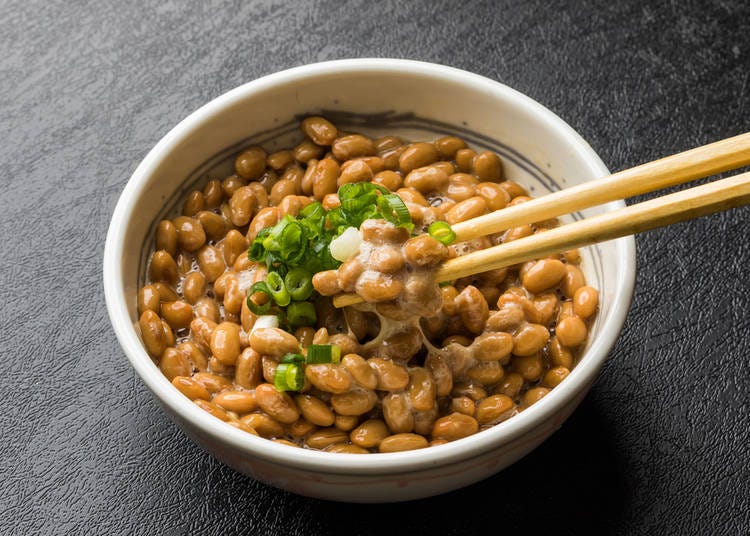
Natto, a fermented soybean dish, is a staple in the daily diet of most Japanese people. However, it's a type of food that many foreigners find unappetizing due to its strong smell and sticky consistency. Despite this, natto is a genuine Japanese delicacy that is worth trying at least once. Typically served with rice and dipped in soy sauce or spicy mustard, natto can be an acquired taste. It may take some getting used to, but don't let that intimidate you from giving it a try. You might be surprised to find that you enjoy it and have a more Japanese palate than you thought!
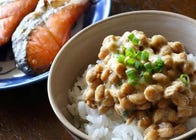
15. Oden (おでん): The Wintry Delight of Japan
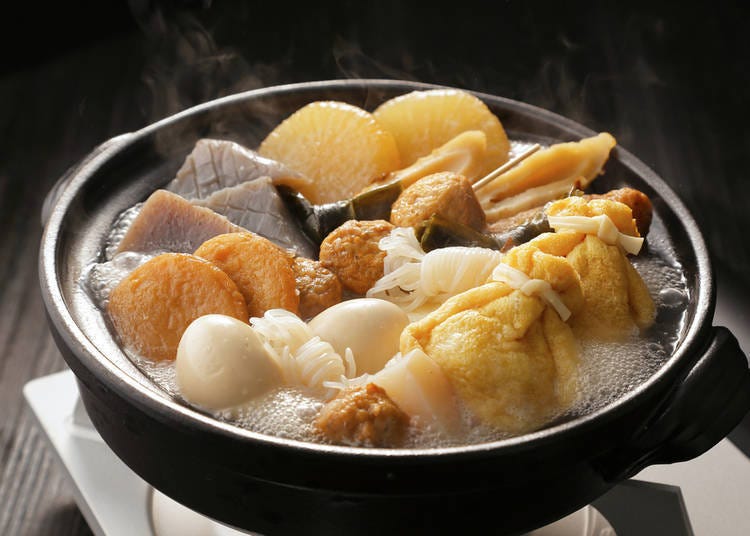
Oden is a delicious and warming dish that is perfect for cold winter days. It is a type of one-pot meal made with various ingredients, such as eggs, konjac, fish cakes , and daikon, all served in a dashi and soy soup. Although some restaurants specialize in preparing this dish, you can easily find oden in many Japanese fast-food chains and convenience stores . Oden can be prepared in different ways, and its name may even vary depending on the region. For instance, in Nagoya, it may be known as Kanto-ni. Additionally, the soups used to boil the ingredients can also differ depending on the area. Oden is an inexpensive and unique dish that you will never tire of, particularly if you are traveling through different cities in Japan.
16. Okonomiyaki (お好み焼き): Japan's Savory Pancake Paragon
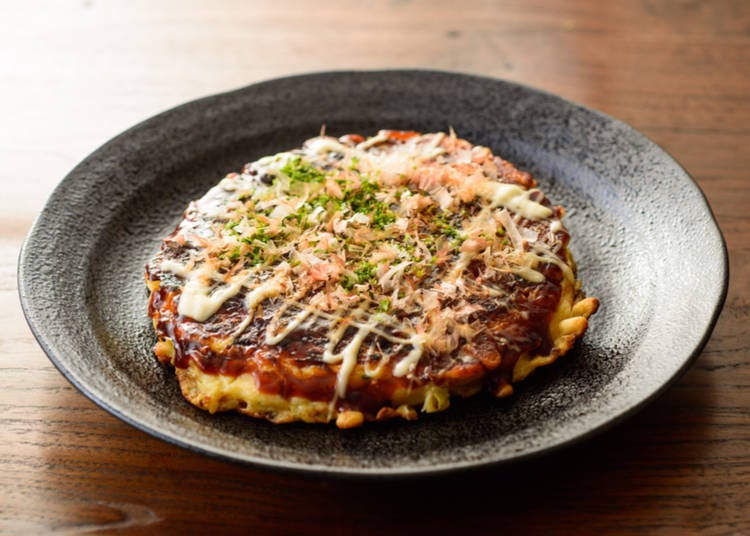
If you're traveling to Japan, trying out the various types of okonomiyaki , a staple dish, is a must. This savory dish, which can be compared to a Japanese frittata or pancake, is made using a wide range of ingredients, as suggested by its name's etymology (meaning "what you like" or "how you like" + "grilled"). Two of the most popular varieties of okonomiyaki are the Kansai-style and the Hiroshima -style. The Kansai version is the most common, with a batter prepared using flour, nagaimo (a kind of yam), dashi (or water), eggs, cabbage, pork belly, octopus, squid, shrimp, mochi, or cheese, and konjac. Osaka is particularly well-known for its okonomiyaki , as it is believed to be the dish's birthplace. In the Hiroshima -style, the ingredients are arranged in layers rather than mixed together. Toppings usually include noodles such as yakisoba or udon , eggs, and a lot of sauce. There are many other types of okonomiyaki available in various regions of Japan, such as Tokushima , Hamamatsu, and Okinawa . If you're in Tokyo, you should visit the Tsukishima district , which is famous for both okonomiyaki and monjayaki. On Monja Street , you can try monjayaki, a dish similar to okonomiyaki but with a less dense texture and different ingredients.
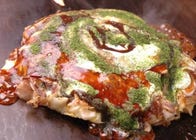
17. Omuraisu (オムライス): The Enchanting Omelette Rice Creation
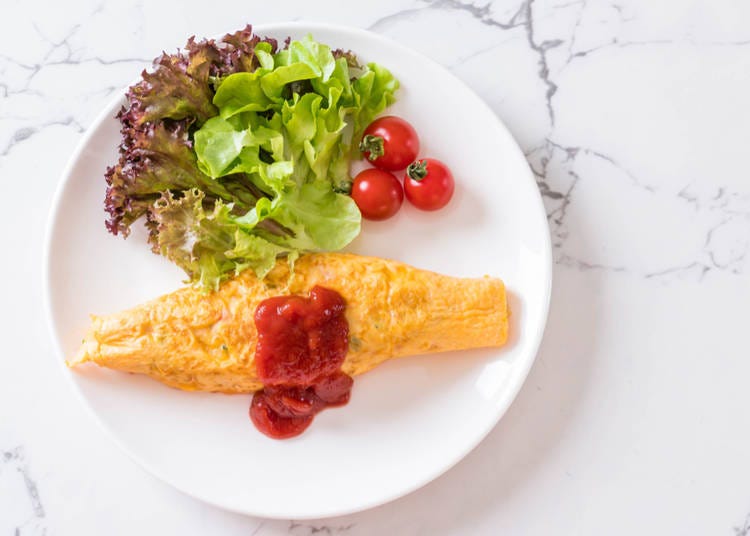
The name of this flavorful dish derives from the contraction of the words omelet and rice. Omuraisu, as the name suggests, is an omelet filled with fried rice and usually topped with ketchup. The dish seems to have originated in Tokyo, in a western-style restaurant, roughly 100 years ago. You’ll find this dish in most Japanese cafes that also serve food, as well as in several restaurants. If you’re staying with friends from Japan, chances are they’ll know how to prepare it, as it’s a common dish among Japanese people. Once again, a filling, cheap, and tasty one-dish meal that will certainly be popular among adult visitors, as well as children!
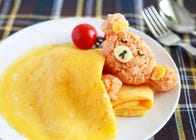
18. Onigiri (おにぎり): The Staple Rice Ball Delight
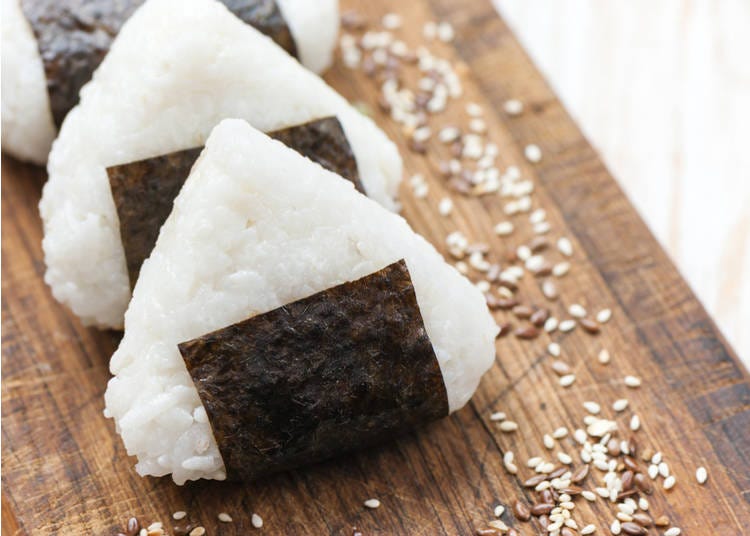
Have you ever come across the famous Japanese rice ball, the onigiri, in an anime , movie, video or documentary? Although it is not a very common menu item in restaurants, it is considered the king of on-the-go dishes and can be found in almost every grocery and convenience store . The onigiri is a simple rice ball that can be flavored with spices or filled with various ingredients such as vegetables, meat, fish, seafood , and more. Depending on the region and one's preference, it can be wrapped in a sheet of flavored or unflavored nori (seaweed). While sightseeing in Japan, many people tend to eat mainly onigiri due to its cheap price (usually under 200 yen), availability, and simplicity.
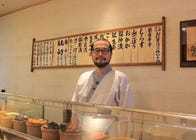
19. Ramen(ラーメン): The Delectable World of Noodles and Broth
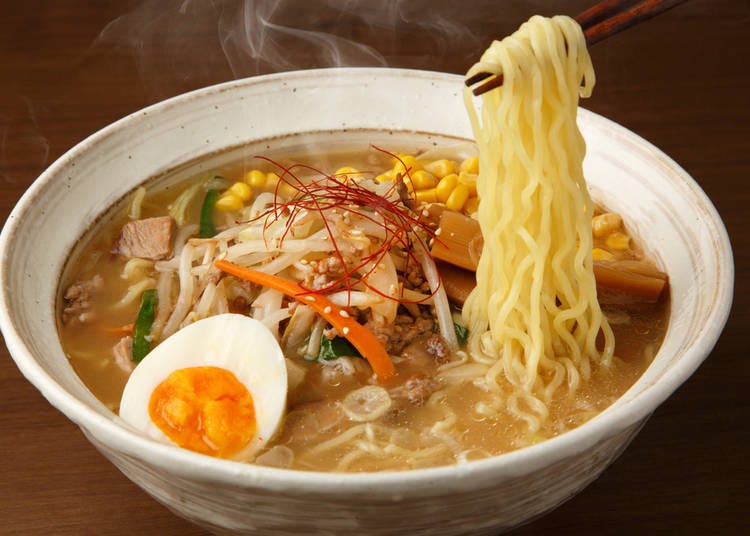
Ramen is a well-known dish globally, especially the instant variety. However, in Japan, the authentic version is far superior to its instant counterpart in terms of taste and variety. The broth for ramen can be made from chicken, pork, beef, fish, or vegetables, flavored with soy sauce, miso, dashi, and many other seasonings. It is usually served with scallion, seaweed, tofu , and bamboo shoots, but there are countless other combinations to choose from. Each region and restaurant has its unique recipe, leading to original and delicious meals. The noodles used in ramen are also specially made and have a soft yet chewy texture. The most common soup stocks used for ramen are miso, salt, soy sauce, and curry . Ramen is the go-to meal for the Japanese after a long day or night out, and it's commonly regarded as fast food . It's typically served hot, although some variations can be served cold, and it's a favorite on cold days.
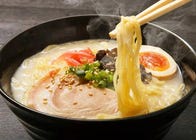
20. Robatayaki (炉端焼き): The Art of Fireside Cooking
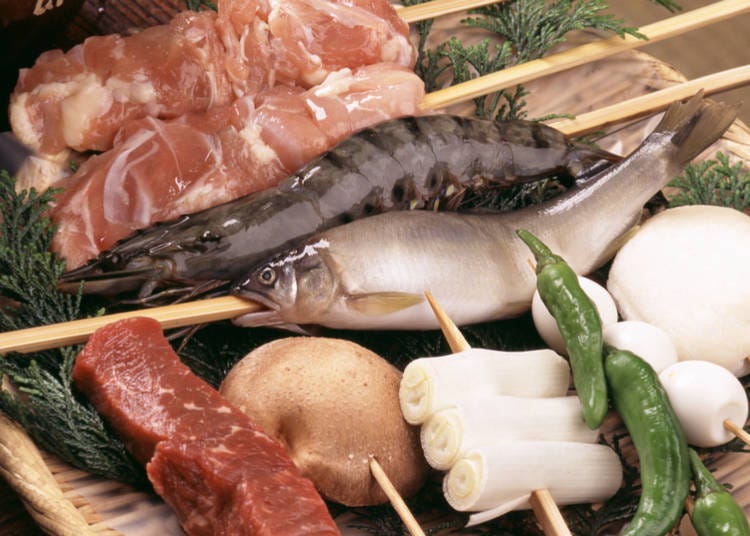
Robatayaki (or robata) is a unique Japanese cuisine in which food is grilled on an irori style fireplace (wide, flat, open fireplace) over charcoal. This particular dish is usually found only in specialized restaurants, so you may have to look/ask specifically for it. The list of food at robata restaurants is everything you can think of, although traditionally it is a combination of seafood and vegetables. Most visitors miss this amazing food in Japan. Make sure you taste a real slice of Japan by looking for a good robata (there are many in Tokyo and all over Japan).
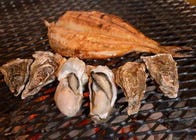
21. Soba (蕎麦): The Buckwheat Noodle Escapade
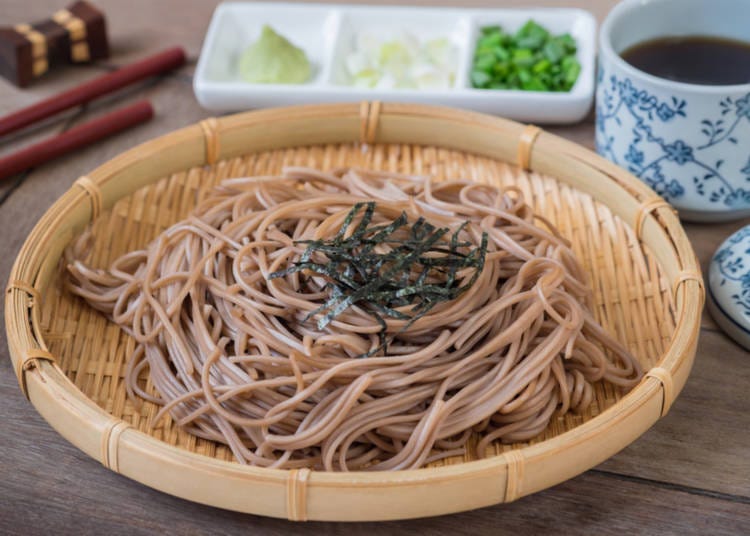
Soba is a type of noodle made from buckwheat flour, which is a specialty dish from Japan. It is a very popular dish and can be found in both general noodle restaurants and specialized, often expensive ones. Preparing soba at home is relatively simple, as you can buy the noodles and soup in which they are dipped from a grocery store . Soba can be enjoyed in different ways, either in a cold dip or a broth as a noodle soup. This dish comes in various varieties depending on the region and the season you are visiting. Don't forget to try a soba dish next time you visit a restaurant in Japan!
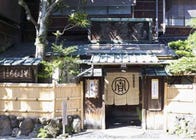
22. Somen (そうめん): Delightful Thin Noodles
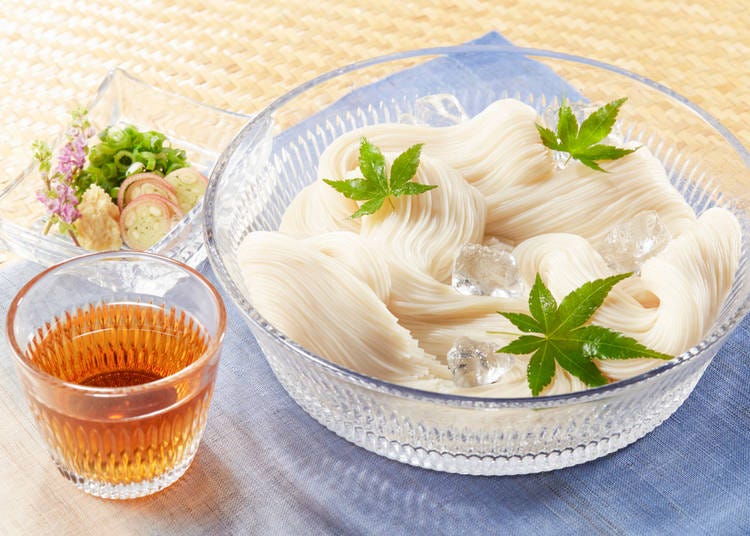
Somen is the Japanese version of a prevalent kind of noodle across Asia. Made out of wheat flour, it’s usually served cold. These skinny noodles are served with a simple cold dipping sauce or a sauce flavored with onion, ginger, and myoga (a different kind of ginger). This dish is particularly popular in summer when a dish of somen chilled with ice cubes is all you need to recharge, fill up, cool off, and take a break from the brutal Japanese summer heat.
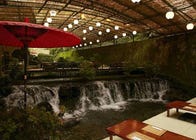
23. Sushi and Sashimi (寿司 & 刺身): The Raw Elegance of Japanese Cuisine
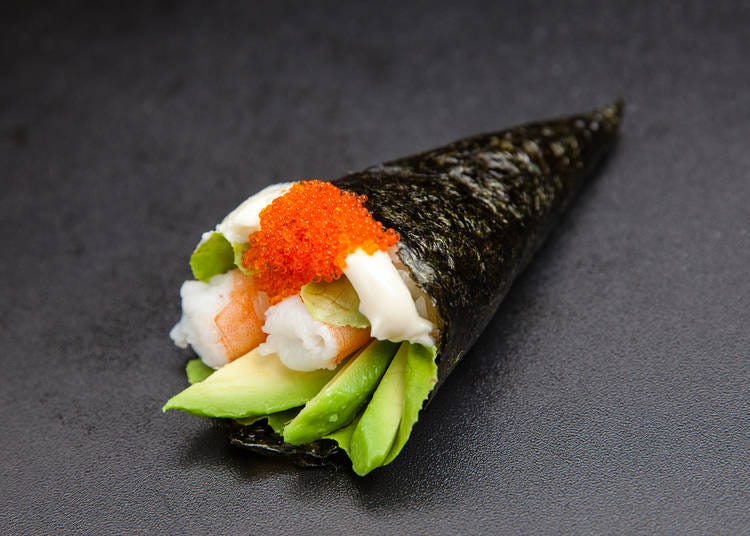
Sushi and sashimi are among the most famous foods in Japanese cuisine . They are regarded as an art form, with sushi chefs often practicing as apprentices for years before being considered masters. Despite their popularity, many people fail to understand the variety of cuts and preparation that go into creating these dishes. However, good quality sushi and sashimi can be found in Japan at a fair price. There are options available for all palates and budgets. One unique dining experience in Japan is offered by rolling sushi restaurants, where you order from a tablet at your table and the sushi is served to you via a rolling mat. At these restaurants, known as 100 yen- sushi or sushiro, each dish costs only 100 yen and the food is excellent. A dish that is often missing outside of Japan is temaki zushi, or hand-rolled sushi . While you can find restaurants offering this dish, it's a fun and easy dish to make at home. You'll need sushi rice, thin slices of your favorite fish, seaweed sheets, and any other ingredients you'd like to add. Common ingredients include cucumber, crab, avocado, and wasabi. To make temaki zushi, spread the rice on a sheet of seaweed, add your fillings, roll the seaweed into a cylinder or cone, and enjoy with soy sauce. If you're in Japan, consider proposing a temaki zushi party - it's sure to be a hit!
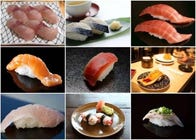
24. Takowasa (たこわさ): The Wasabi Octopus Experience
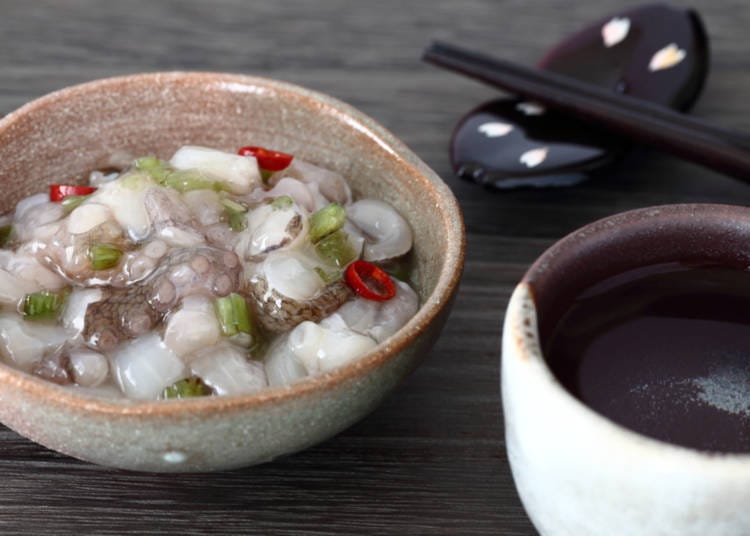
Takowasa is raw octopus (tako) served in a wasabi sauce (wasa). This is one of those Japanese dishes that, depending on your cultural background, may appear weird. Do try it out! Takowasa is a common appetizer in many restaurants, especially in an izakaya . It’s very popular and for a good reason. It’s tasty, unique, and a true symbol of Japanese popular food tradition.
25. Tempura (天ぷら): Japan's Light and Crispy Masterpiece
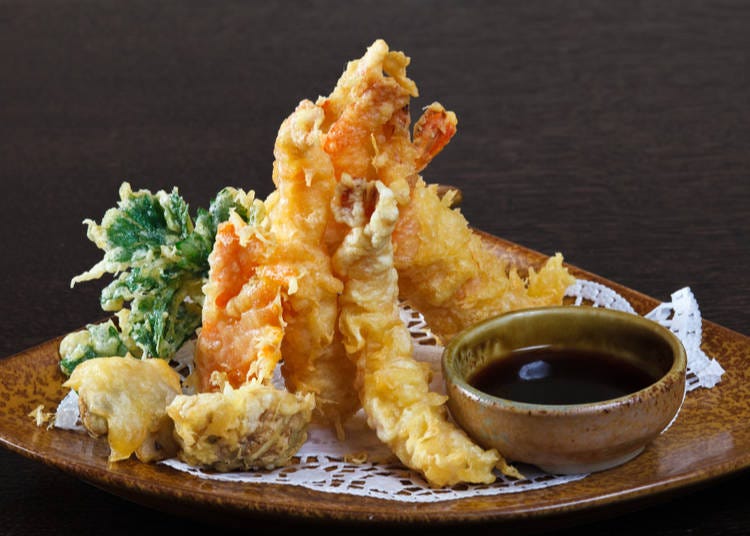
Tempura is a delicious dish that can be enjoyed throughout the year, especially for those who love to socialize with friends over drinks. Tempura typically includes shellfish, fish, chicken, or vegetables coated in a flavorful batter and then deep-fried to a perfect level of crunchiness. You can savor tempura as is, or with a dipping sauce. While many restaurants offer this dish, some specialize in it, providing a wider range of options for an even more fantastic immersion into traditional Japanese cuisine .
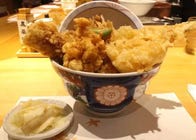
26. Teppanyaki (鉄板焼き): The Theatrical Grilling Artform
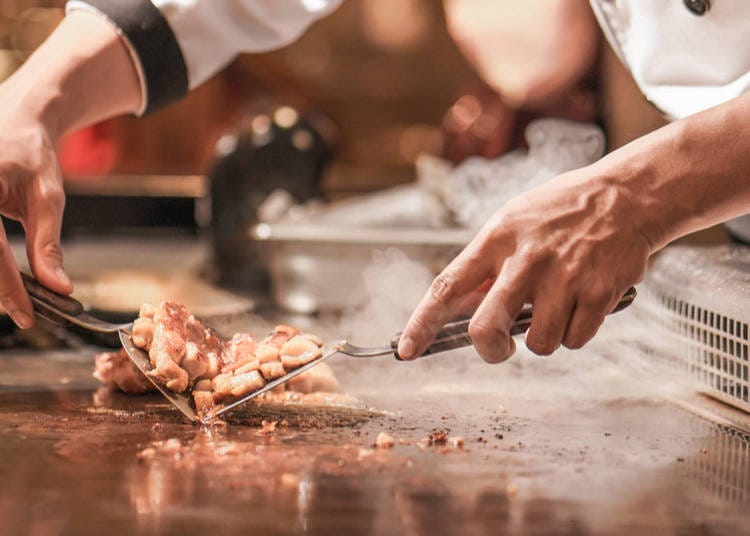
Teppanyaki is a Japanese style of cooking that is not very well known but still absolutely delicious. The word Teppan means iron plate, while yaki means grilled. The term Teppanyaki is used to refer to a wide variety of dishes, including okonomiyaki , yakisoba, and monjayaki. However, it's typically used to describe a particular type of western-influenced food preparation. Typical ingredients for Teppanyaki dishes are beef, shrimp, vegetables, chicken, and scallops. These ingredients are cooked on a hotplate, usually with soybean oil. Some of you may be familiar with this type of cooking because in the United States, Teppanyaki restaurants are quite popular, although they're known as hibachi. If you visit Japan and want to try some amazing food that blends the best of Japan and the West, you should definitely give Teppanyaki a try.
27. Tonkatsu (とんかつ): The Crispy Pork Cutlet
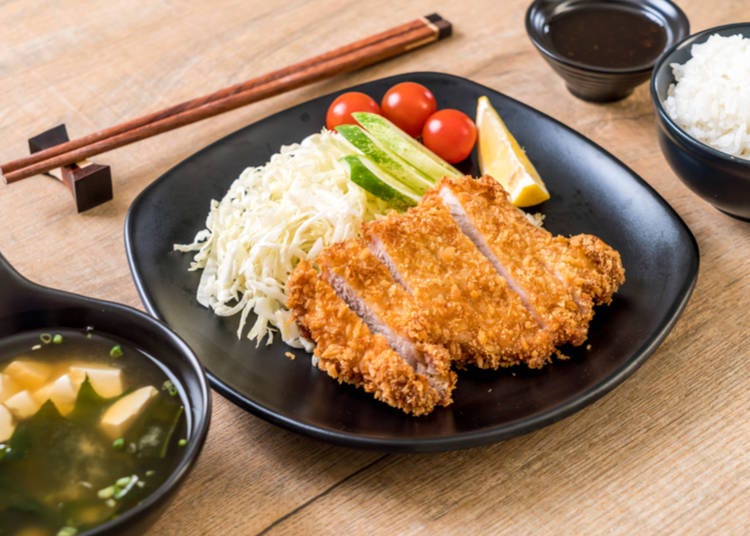
Tonkatsu is a popular and easy-to-find Japanese dish consisting of a breaded pork cutlet that is deep-fried in vegetable oil until golden brown. You can easily find this delicious and affordable dish in many chain restaurants, grocery stores , and convenience stores , or you can even make it at home! To prepare the dish, season the meat with salt and pepper, coat it in flour, dip it in beaten egg, and cover it with panko (Japanese bread crumbs). Then, deep fry the cutlet until crispy and serve it with cabbage, potato salad, and a brown sauce or karashi. Tonkatsu is also great for making sandwiches, making it the perfect meal on-the-go.
28. Udon (うどん): Glorious Thick Noodles
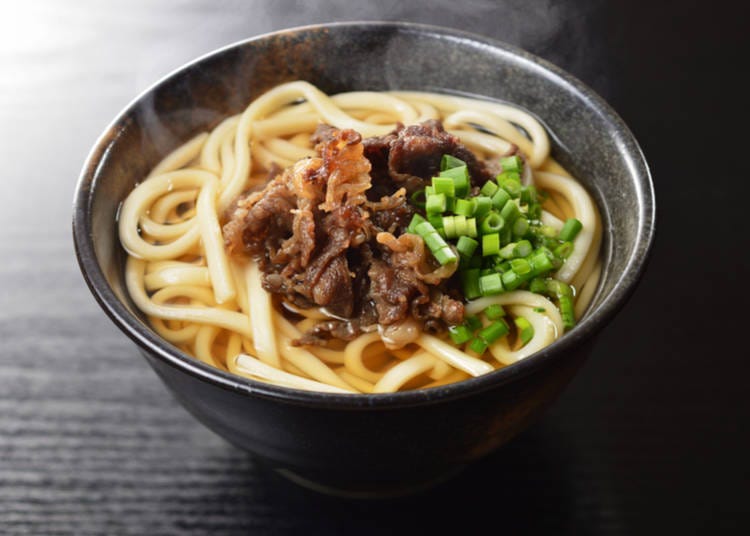
Japan has a wide variety of noodles, and udon is one of the most popular, just like ramen . Udon is a thick noodle made from wheat flour, which you can enjoy either in its simplest form - with broth made of dashi, mirin, and soy sauce - or in many different combinations. For a hearty meal, try it with tempura , or for a more delicate taste, with tofu . Udon can be served hot or cold, depending on the season or your personal preference, and the style of preparation varies depending on the region you're visiting. Although the word " udon " refers to the noodles themselves, there are no limits to the flavors, soups, and ingredients that can be added. As a matter of fact, challenge yourself to try out as many styles of udon as possible during your trip to Japan. Not only will you be satisfied, but you'll also be nowhere near the end of the list of possible dishes!
29. Yakiniku (焼き肉): Grilled Meat, the Japanese Way
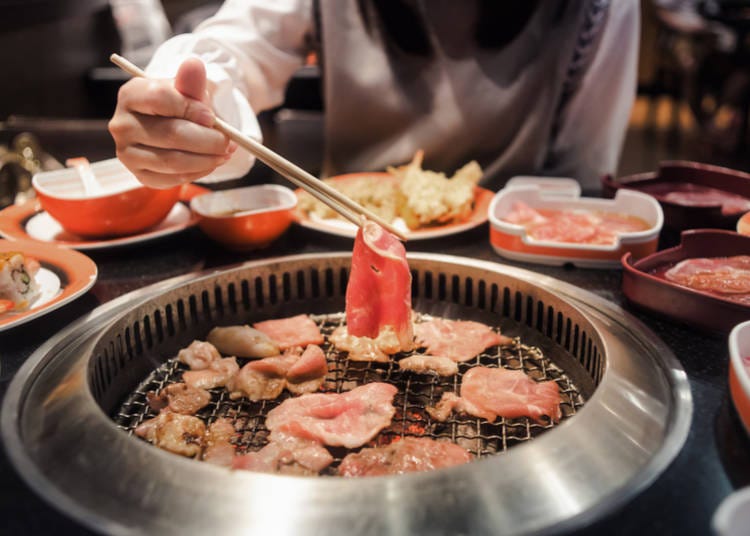
Yakiniku is a style of cooking that involves grilling meat, also known as Korean or Japanese barbecue. While Korean-style barbecue typically involves marinated meats, Japanese-style barbecue does not. Yakiniku restaurants are very popular and offer a wide range of options, from high-end to budget-friendly, with some even offering all-you-can-eat menus. When dining at a yakiniku restaurant, you can choose from a vast selection of meat or vegetables, seasoned or unseasoned, which you then grill yourself on a hot plate or grill embedded within your table. You can then add various sauces, such as lemon, BBQ, and many others, or simply salt and pepper to taste.
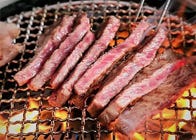
30. Yakisoba (焼きそば): Tasty Fried Noodles
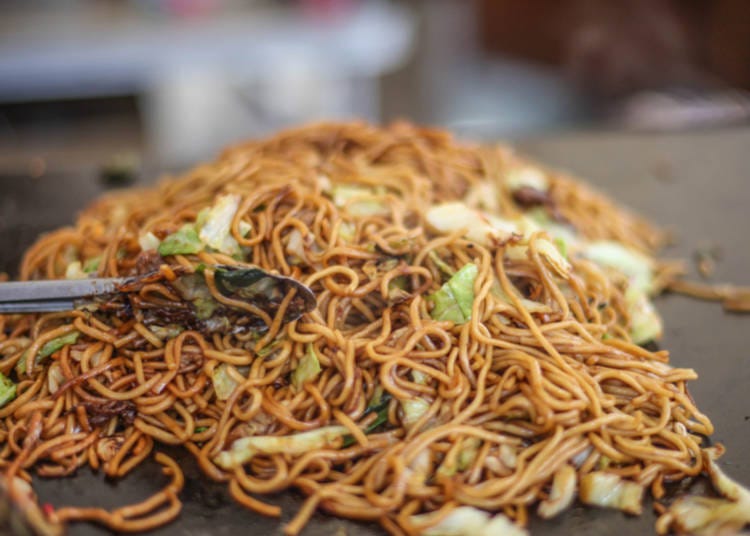
Yakisoba is a Japanese dish that consists of grilled soba noodles and is usually served at festivals. However, you can also make yakisoba by stir-frying the noodles. You can add various ingredients such as pork, fish, or vegetables and enhance the flavor with toppings like seaweed powder, ginger, and fish flakes. Finally, add sauces such as oyster sauce to give it a delicious taste.
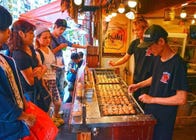
31. Yakitori (焼き鳥): Savory Grilled Skewers
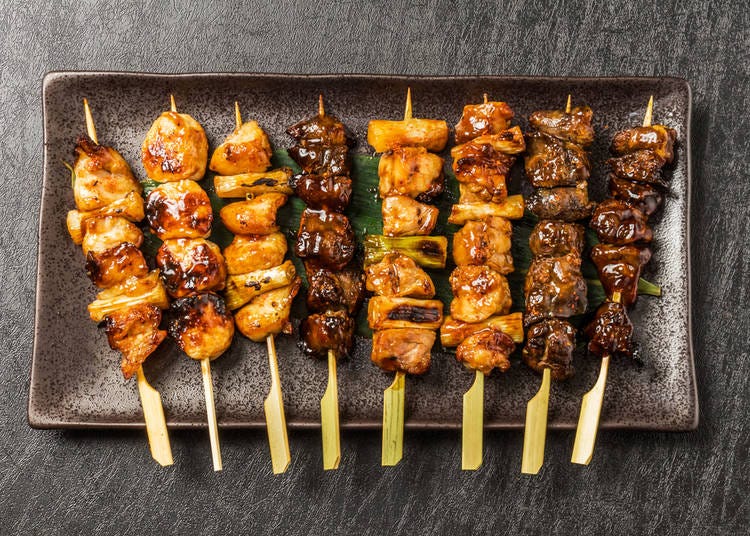
Yakitori , which literally means grilled chicken, actually refers to all kinds of skewered meat (as well as vegetables) cooked on a grill. This dish is simple yet flavorful, and there are countless combinations of ingredients to try. You can find Yakitori in many restaurants and specialty shops. When you visit a good izakaya , it is highly recommended to try this popular Japanese food .
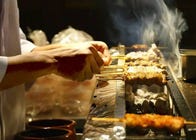
32. Yakizakana (焼き魚): Grilled Fish Delicacies
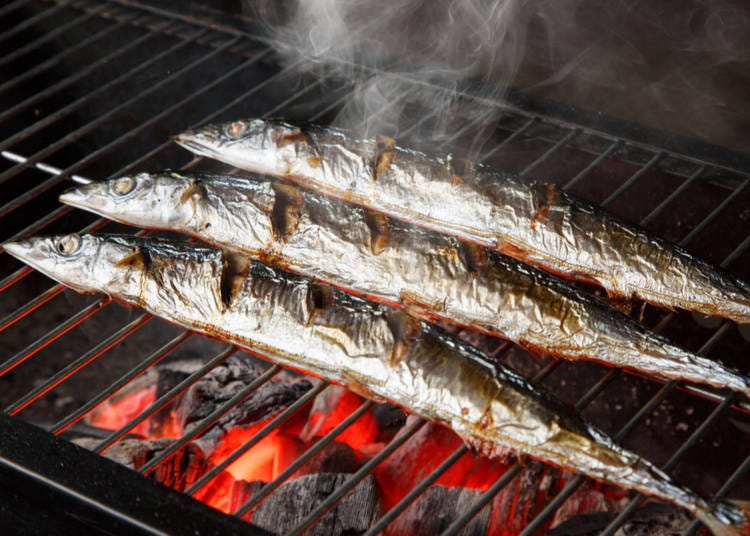
While in Japan, it's essential to try grilled fish, Yakizakana. Although sushi is more famous outside Japan, raw fish is not as common as grilled fish in the country. Typically, a whole fish is grilled and served with side dishes consisting of various vegetables and rice. You can try it at specialized restaurants for an immersive experience or at chain restaurants for a delicious, inexpensive, and quick meal that will keep you energized for several hours of sightseeing ahead.
You’re now on the way to become a true expert on food in Japan! Yet there’s much more to Japanese cuisine that can be discovered! While visiting this amazing country and taking in all the sights, the fun, and the culture, don’t forget to eat!
Written by:

Lucio Maurizi
Lucio Maurizi is an automotive expert specializing in Japan's car scene and auto-tourism. With an MA in East Asian History from La Sapienza Università di Roma, he's a multi-talented contributor to travel platforms like LIVE JAPAN, Japan Travel, and GPlus Media. His Instagram account (50k+ followers) offers insider views on Japan's automotive culture. Lucio also actively collaborates with professional drivers and influencers and organizes can't-miss car events in Tokyo. Instagram: @italian_in_japan Other links: https://linktr.ee/italianinjapan
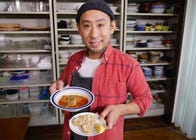
- Category Japanese cuisine
Share this article.
Limited time offer: 10% discount coupons available now!
Recommended places for you.
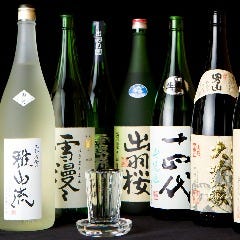
Inokoya yamagatada
Japanese cuisine
Surrounding Areas Of Yamagata
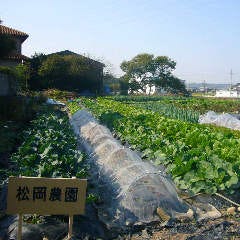
Yamatoan Honten
Nara, Ikoma, Tenri
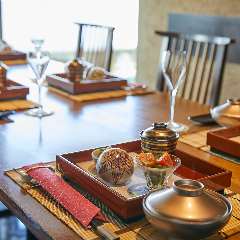
Dynamic Kitchen & Bar Hibiki
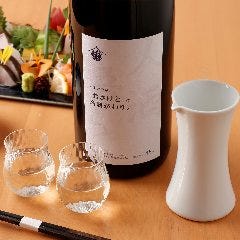
KOSHITSUKAISEKI WASYOKUBIYORIOSAKETOAKASAKA
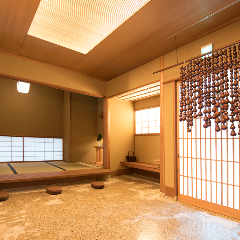
KITCHO Honten
Umeda, Osaka Station, Kitashinchi

Ganso Kamameshi Haru

Step Into the Story: Inside Immersive Fort Tokyo

Everything You Need To Know About the Kyoto-Osaka Sightseeing Pass

Best Things to Do in Tokyo in April 2024: Events, Festivals & More

The CASIO S100: How CASIO's Masterpiece Calculator Redefines Business Elegance With Japan-Made Reliability

A Complete Guide to the JR West Kansai Area Pass

The Complete Guide to the Kintetsu Rail Pass
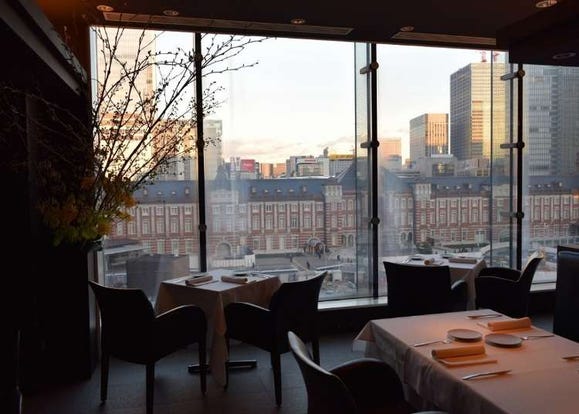
Million Dollar View: Tokyo’s Top 4 Restaurants with the Best View
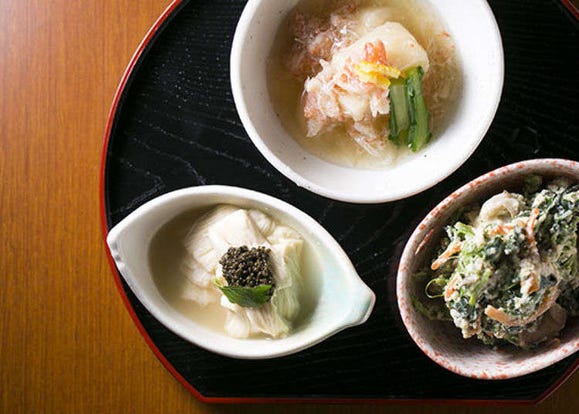
What to Eat in Kyoto: 3 Awesome Obanzai Restaurants Near Kyoto Station!
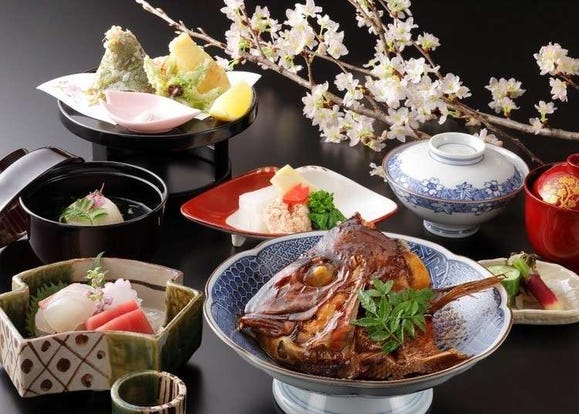
Best Kaiseki in Kyoto: 6 Great Kaiseki Restaurants in Gion at Phenomenal Prices
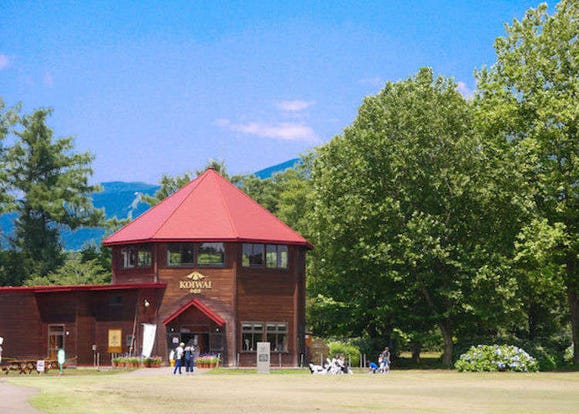
Koiwai Farm Guide: Eat, Learn and Play at Iwate Prefecture's Premier Agritourism Destination!
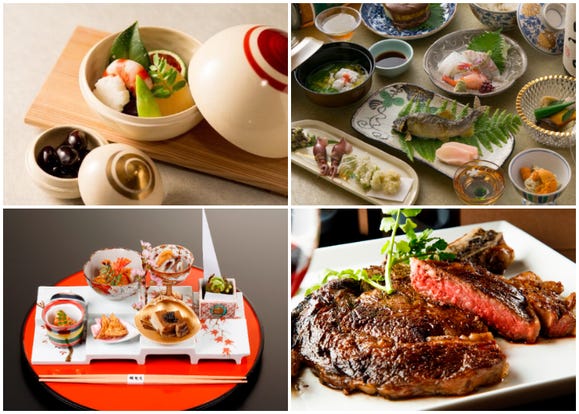
Where to Eat in Kyoto: Best Kyoto Foods to Try & The Tastiest Shops of 2023
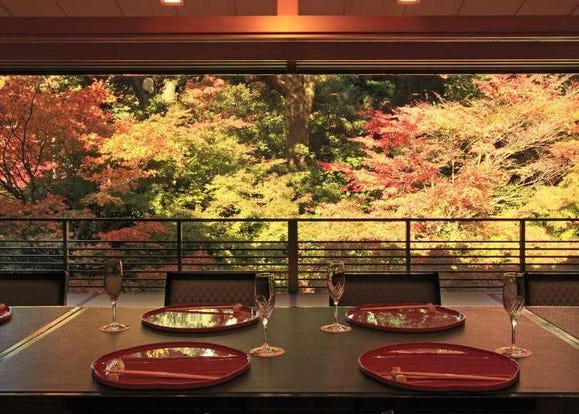
Terrace Dining & More: 3 Restaurants Where You Can See Tokyo's Dazzling Fall Foliage
- #best sushi japan
- #what to do in odaiba
- #what to bring to japan
- #new years in tokyo
- #best ramen japan
- #what to buy in ameyoko
- #japanese nail trends
- #things to do japan
- #onsen tattoo friendly tokyo
- #best coffee japan
- #best japanese soft drinks
- #best yakiniku japan
- #japanese fashion culture
- #japanese convenience store snacks
- Tours & Experiences
- Tailor-made Trips
- Bahasa Indonesia
We are happy to see you again!
Continue with
Or use email.
No Account? Create one
Create account
Already have an account? Sign in
Quickly Sign up with
I agree to Japan Travel's Terms of Service and Privacy Policy . Terms of--> and acknowledge that Japan Travel's Privacy--> applies to me.-->
Email reset password link
Please check your inbox and click the link we will send to you.
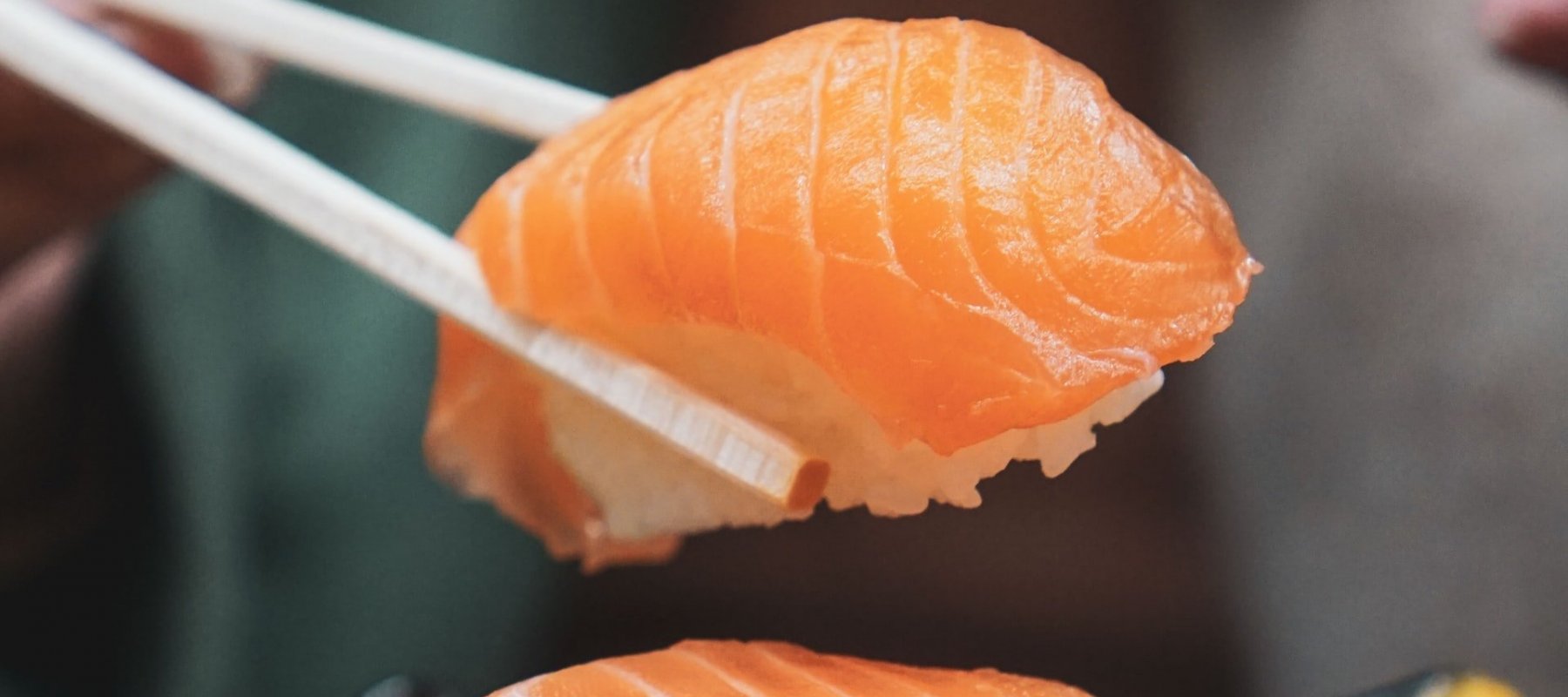
Japanese Food

Kill Bill Inspiration at Gonpachi
Gonpachi, the restaurant made famous by Quentin Tarantino in his 2004 film Kill Bill, serves delicious Japanese food to locals and..

A Guide to Japan's Family Restaurant Chains
Traveling to Japan with your family? You may be wondering about quick and easy places to eat that cater to the entire crew. There..

Gonpachi in Nishi-Azabu
Gonpachi, otherwise known as the 'Kill Bill Restaurant' located in the heart of Roppongi is one of Japan's best tourist..
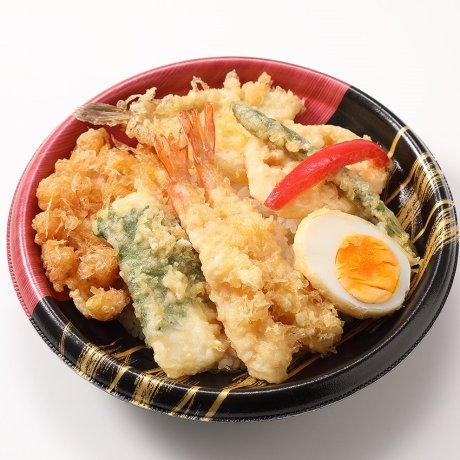
Donburi Grand Prix 2024
The Donburi Grand Prix will offer up a variety rice bowls piled high with toppings for visitors to choose from.

"Yakitori Alley" in Yurakucho
Beer & Yakitori under the train tracks in Yurakucho

What is a Mont Blanc?
So, what is a Mont Blanc? In Japan, the Mont Blanc refers to a dessert and not just any dessert; but an exquisite confection t..

Best Ramen in Shinagawa
With ramen’s diverse range of broth varieties, toppings, noodle types, and regional specialties you will never tire of this na..
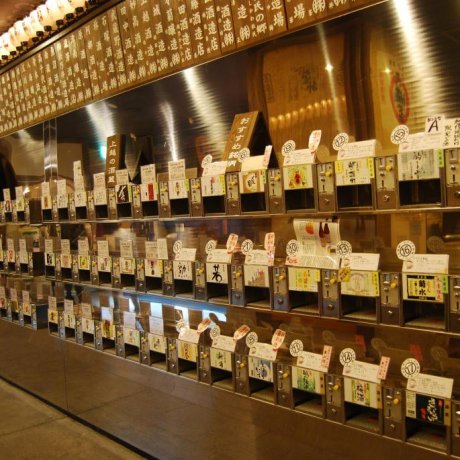
Ponshukan – Sake Heaven
At the Ponshukan in Yuzawa, you can wait for your train while drinking vending-machine sake and bathing in an onsen where the hotspring..
Search filters
Food top 10.
- Recommended

veJin: Vegan Ramen

Tokyo Takes 2nd Place on Top Coffee Cities List

Shu'n Wine and Dine Swissotel Namba

4 Must-Visit Hamburger Eateries in Shinagawa City

Only in Japan: Character Cafes in Tokyo

Four Seasons Steak House

Okinawa Goat Misaki

Hagi City Food Guide: Best Local Eats

Minoya Wagashi

Foodies Guide to Authentic Japanese Cuisine
Let us know how we can help.
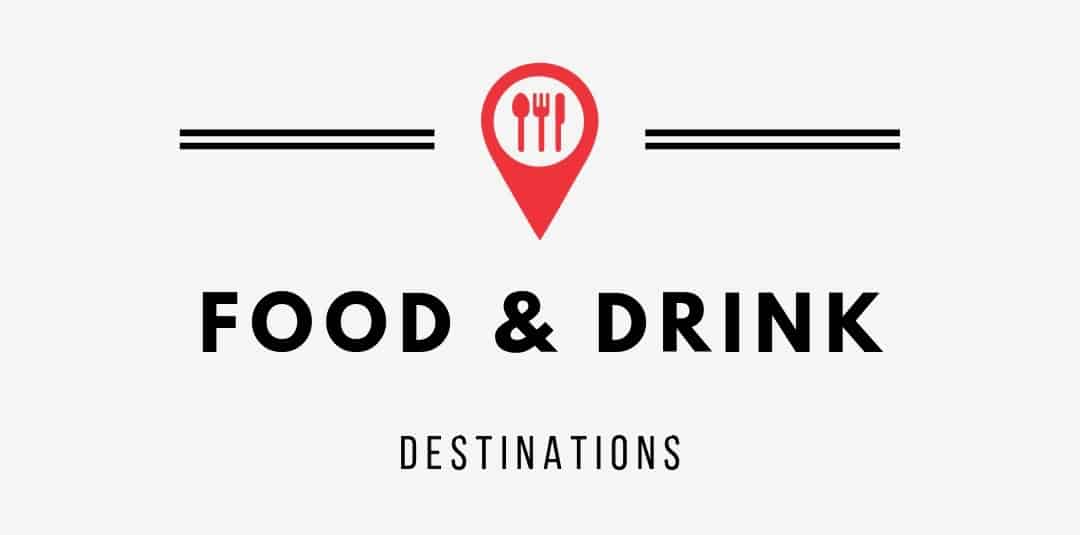
- Destinations
- Travel Guides
- For The Home
- Privacy Policy
Japan , Travel Guides
Food focused two week japan itinerary – 14 days of eating well.
We’ve taken several trips to Japan over the last decade, each time staying a bit longer and exploring a bit more than the last. I know many travelers don’t have the same flexibility in their schedules as we do. If you have the opportunity to spend two weeks in Japan, though, we want to ensure you eat well and drink well. Because Japan is one of the top culinary travel destinations in the world. In this post, I share our tips on how to plan a trip to Japan with a 14 day itinerary.
*This post contains compensated links. Find more info in my DISCLAIMER . As an Amazon Associate, I earn from qualifying purchases.
A 14 Day Trip To Japan For People Who Travel For Food
Most itineraries focus on the top Japan destinations, including Tokyo and Kyoto. There is always a focus on the “top things to see” and always includes plenty of visits to museums and temples. We include some of those activities in this guide.
But our real focus in this Japan travel blog is to focus on unique food experiences, those experiences that make Japan unique. This includes food tours , sake tastings, and plenty of recommendations on where and what to eat in Japan.
Another way this itinerary is different from others is that it goes beyond Tokyo and Kansai, which includes Kyoto and Osaka. Sure we include those cities as well. But our suggestions go a little bit beyond for a more authentic experience in Japan.
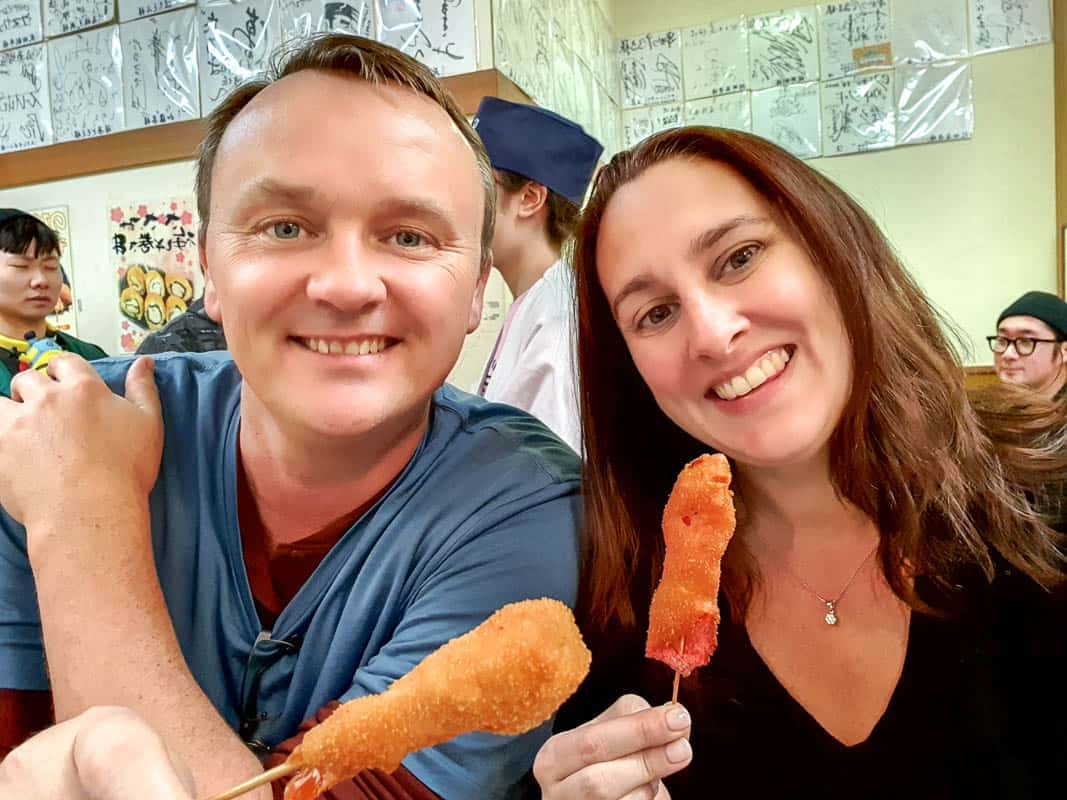
Only Have A Week In Japan? Check Out Our 7 Day Japan Itinerary
Help With Planning Your Japan Two Week Itinerary
Luggage : We used our Eagle Creek Load Warrior luggage for this trip. I always recommend packing light and if using the trains in Japan this is particularly important. Escalators and elevators are not readily available. And, most hotel rooms in Japan are pretty small. It can be hard to find space for large luggage! Even for a 2 week trip in Japan, it is possible to do laundry at least once or twice during your trip so it’s possible to pack light.
Rental cars : If you decide to rent a car in Japan, we recommend RentalCars.com . They compare prices at the top rental car companies to get you the best deal.
Rail Passes : Train travel is really efficient in Japan, particularly between our recommended cities. Check out the 14 Day Japan Rail Pass to help get you around. A rail pass must be purchased ahead of time before your arrival in Japan and is best purchased from Japan Rail Pass.
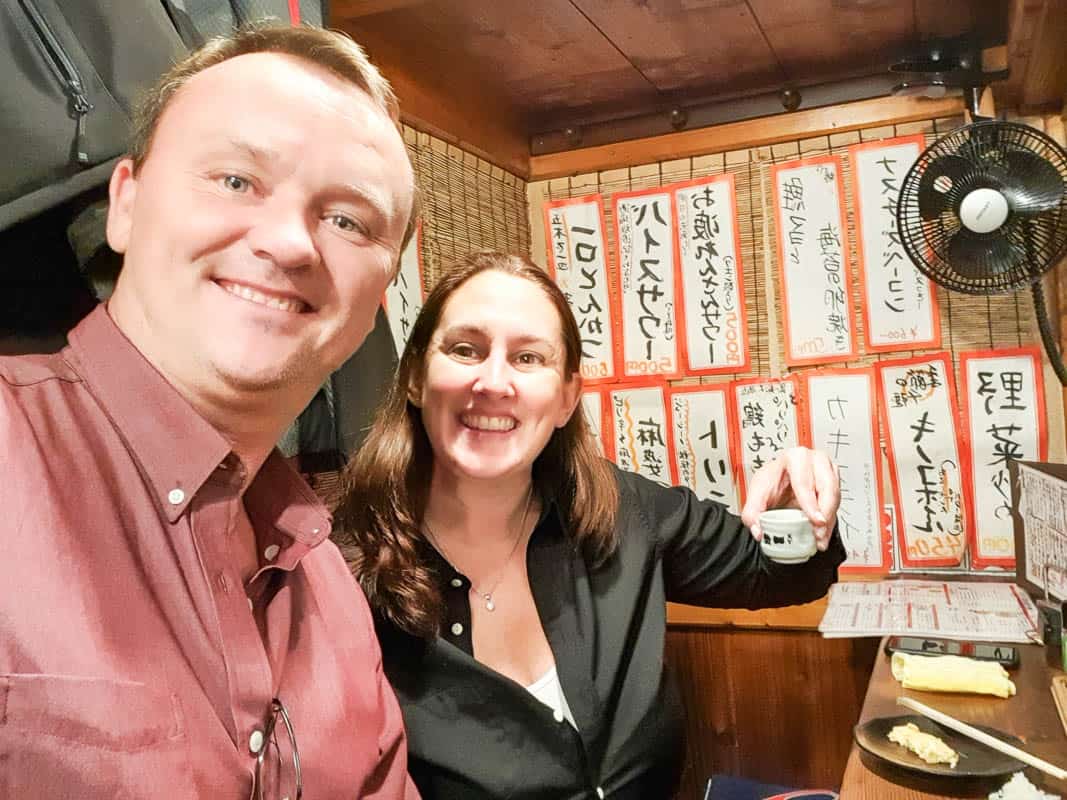
Eating at an izakaya in Kyoto
Best Japan Destinations For Food Travelers
Tokyo – Many travelers arrive or depart from Tokyo so it’s understandably on everyone’s itinerary. It’s a big city, with bright lights, and Japan to the extreme.
Osaka – The destination for food travelers in Japan. Known as Japan’s kitchen, Osaka is known for “kuidaore,” which essentially translates to eat until you drop or eat until you bankrupt yourself. This is why it’s one of our favorite cities.
Kyoto – The city of culture and temples, Kyoto is also one of the top sake producing regions in the country.
Wakayama – Just south of Osaka and Kyoto, Wakayama is often overlooked by travelers. It’s an easy addition to any Japan trip itinerary. It’s a destination with a focus on fresh fish and seafood, ramen, and Buddhist Monastery lodgings.
Kobe – The home of world-famous Kobe beef and easily visited as a day trip from Osaka or Kyoto.
Sapporo – The great white north of Japan and the city that is one of the snowiest in the world. It’s also home to its own unique cuisine unlike elsewhere in Japan.
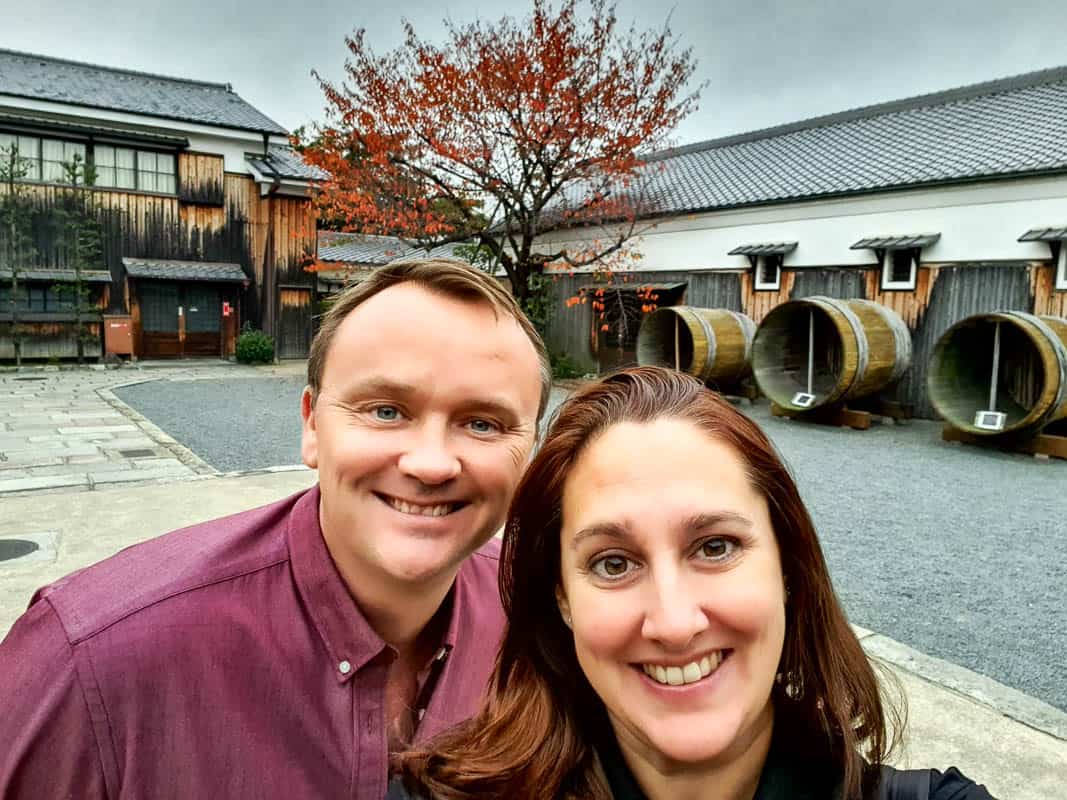
Visiting a sake brewery in Kyoto

Guided Tours Of Japan
We will provide tips on how to plan your own Japan 2 week itinerary, but I understand that Japan can be difficult to manage on your own. We have some recommendations for guided tours that included between 12 and 14 day itineraries.
Intrepid Travel offers a 12 day Real Food Adventure In Japan . It hits some of our favorite food cities in the Kansai region of Japan. That includes Osaka, Kyoto, and Kyosan in Wakayama. Along the way, travelers learn to make sushi , eat street food, and stay the night in a Buddhist monastery. These are all food experiences we’ve had in Japan and would totally recommend. We took an Intrepid Real Food Adventure in Morocco and learned a lot about the food culture. Learn more about Intrepid’s Japan tour .
As an alternative, G Adventures offers a small group tour for 14 days in Japan that departs from and returns to Tokyo. The Discover Japan Tour visits Tokyo, Kyoto, Hiroshima, and other interesting cities. There is more of a focus on culture and history than the Intrepid Tour but includes interesting food experiences. This includes visiting a sake brewery and dining in kaiseki cuisine in Kyoto. Learn more about the G Adventures Discover Japan Tour .

Eating ramen in Sapporo in Winter
Tips For Traveling to Japan For The First Time
Planning a trip to Japan for the first time can be entirely intimidating. That’s why booking a group tour can help. But, there are ways to plan an independent journey as well. We have a few key tips for first-timers to help make things easier.
Picture Menus Are Your Friend
When it comes to selecting restaurants in most touristy cities, we always recommend avoiding places with picture menus. This advice goes out the door in Japan. Many restaurants have picture menus, for both travelers and locals. The picture menus are your friend.
Almost every place we ate in Japan included picture menus with English descriptions. A few did not. Where they didn’t we relied on Google Translate to take pictures of the menu or to do an instant translation. But, this only works when you are online.
Japan Travel Guide Pro Tip
We use KeepGo for international data. It’s an international sim card that works in over 120 countries without setting up service in each country you visit. It doesn’t make a difference what kind of mobile service you have at home. You just register the sim before leaving home. It works on arrival in Japan. We had 4G access in Japan with KeepGo .
Japan Is A Cash-Based Society
Cash is still king in Japan. We were able to charge some meals, but most of the time we paid cash. This is particularly true in smaller places. We used ATMs to withdraw cash as we went. ATMs are not as easily found as in other cities. Look for them in the convenience stores like 7-11, Lawson, or Family Mart.
Don’t Try To Fit Too Much Into Your Itinerary
Imagine someone trying to see all of the US in a two week trip, impossible, right? Japan may be a smaller country, but there is so much to see and do. Even within a single city, there are loads of great activities, neighborhoods to explore, and food to eat. Don’t rush it and don’t try to cram everything into a short amount of time.
Our recommendations in this post make a great first time in Japan itinerary. In two weeks you can experience a lot of Japan, but I wouldn’t recommend visiting more than 4 cities. The movement in between, even with high speed trains, can be exhausting.
Also, consider basing yourself in a city like Osaka and taking day trips to Kyoto, Koyasan, Nara, and Kobe, to see a lot without the constant checking-in and checking-out of hotels and packing and repacking. You can access each of these cities in less than an hour from Osaka.

Visiting Temples In Wakayama
Food And Drink Experiences In Japan
There are loads of interesting and unique things to do in Japan. Some of these experiences relate to food and drink and others focus on culture and history. This is a great place to start your own Japan trip planner for how to spend 2 weeks in Japan.
- Visit a Robot Restaurant in Tokyo for one of the most unique dining experiences in the world
- Exploring traditional local markets including Kuromon in Osaka and Nishiki Market in Kyoto
- Tracking down the top street food in Dotonbori , Osaka’s food street
- Book a food tour in Osaka or a Kyoto cooking class to learn more about Japanese food culture on a half-day or full-day tour
- Eat some of the best Japanese sushi of your life, by visiting a conveyor belt sushi restaurant or a traditional sushi-ya
- Track down the best bowl of ramen in one of the official or unofficial ramen streets.
- Go Japanese craft beer bar hopping and learn about Japanese craft beer trends
- Enjoy a kaiseki meal at a traditional Japanese ryokan
- Spend the night at a Buddhist monastery and learn about shojin ryori, Buddhist vegetarian cuisine
- Eat some of the best beef in the world – Kobe beef
- Tour a Japanese sake brewery and learn how to order sake
- Spend the evening at an izakaya, a Japanese tavern, toasting over local beer and whiskey highballs
- Dine on Japanese giant crab and local seafood in the great white north of Japan
- Tour the famous Sapporo Brewery and dine on Genghis Khan

Eating sushi at a market in Osaka
How To Spend 14 Days In Japan When You Love Food
If planning your own self-guided tour of Japan, here are our recommended destinations. With a full two weeks in Japan, you can see a lot. There are two primary options here. We recommend about a half dozen cities to visit. It’s possible to visit each of them, spending approximately two nights in each.
Or, I would recommend staying in only about three cities and doing day trips. For example, you can stay in Tokyo, Osaka, and Sapporo and manage to have all of the experiences mentioned in this post over two weeks.
For each city, I recommend some of the top attractions or experiences, with a focus on food and drink. I also provide recommendations on what and where to eat and some recommended hotels. There are also links to some of our other posts for more information on some of these activities and travel tips.

Day 1-3 Tokyo
Most people start or end their trip to Japan in Tokyo. We prefer the smaller cities for more unique experiences and recommend spending more time there. At least give yourself enough time in Tokyo to beat the jet lag .
Top Attractions In Tokyo
Definitely check out the Shibuya district, one of the most iconic neighborhoods in Tokyo. If you’ve seen photos of Tokyo with loads of people crossing at a major intersection with neon lights and skyscrapers in the background – that’s Shibuya. It’s supposedly the busiest pedestrian crosswalk in the world. Stop for a katsu curry at Katsuya or hit one of the ramen or soba shops.
At night, head to the Shinjuku district, perhaps for a little karaoke and nightlife. Shinjuku is where the neon lights explode at night. There’s theater, food, bars, and plenty of people watching.
There are also two well-known bar and restaurant alleys in Shinjuku that are must-visits: Golden Gai and Memory Lane. It’s almost like stepping back in time considering much of Tokyo is covered in high-rises. Within this area is also Harajuku. This is where young people like to show off their fashion and old people like me are left to wonder why.
For a bit of culture, visit the Imperia l Palace or at least wander the gardens. Or, check out the art museums and galleries in the Roppongi neighborhood. This is also where the Tokyo Tower can provide you with a birds-eye view of the city.
Tours And Tickets For Tokyo
There are a few tours and attractions that we recommend booking ahead of time. Grab tickets for the Tokyo Robot Restaurant , one of the most popular and unique attractions in Tokyo. To make the most of your time in Tokyo, book a food tour. This Japanese Food And Drink Tour includes a tour of the world-famous Tsukiji Fish Market.
Where To Eat In Tokyo
In Golden Gai and Memory Lane sniff out late-night ramen and plenty of yakitori bars. In addition to Golden Gai and Memory Lane, there are a few other areas where you are guaranteed to eat well in Tokyo. Be sure to add a visit to Ginza for Michelin Star dining, including some of the most famous sushi restaurants in the world. Look for monjayaki in the Tsukishima district for Tokyo’s answer to okonomiyaki.
Where To Stay In Tokyo
We stayed at the Sheraton Miyako during our visit to Tokyo, but there are other options as well depending on your budget.
Park Hyatt Tokyo : One of the most luxurious hotels in the city and known for its role in the movie Lost in Translation. Check for rates here .
Pullman Tokyo Tamachi : A contemporary option in the center of Tokyo with a sun terrace. Check for rates here .
Nine Hours Shinjuku : On more of a budget, or looking for a uniquely Japanese experience, this capsule hotel is the perfect option. It’s also in the nightlife center of the city. Check for rates here .

Day 4-5 Osaka
I’m amazed to see how many sample Japan two week itineraries skip Osaka altogether. Sure, it doesn’t have the same concentration of temples and palaces as Tokyo or Kyoto, but you can only see so many temples on a trip before you get “templed out.”
Osaka is one of the best cities to visit if you love food and drink! From Tokyo, use the JR Rail Pass to hop the Shinkansen high-speed train to Osaka, Japan’s kitchen.
Top Attractions In Osaka
All of the top main attractions in Osaka are located within the city center and are accessible by train. Take a walk through the gardens of Osaka Castle or catch the view from a boat tour of the Dotonbori Canal. Explore Kuromon Market for street eats and hit Dotonbori, Osaka’s famous food street at night. At night, just wander through one of the many shopping and eating districts, including Namba, and Shinsaibashi.
Tours And Tickets For Osaka
If you want to make the most of your time in Osaka and want to experience all the main sights, pick up the Osaka Amazing Pass. It offers free admission to loads of different sites including Osaka Castle, plus offers unlimited train and bus rides as well.
Osaka is also the perfect place to take a food tour or cooking class. See our recommendations for the Best Food Tours In Osaka .
Or book tickets for Gotta. Gotta is pure Japanese-style entertainment. It’s a Japanese musical review show, which tells the story of the Dotonbori area through food and legend. Buy tickets ahead of time here . They offer three shows a day, with the last show being at 3:00 pm. The show is only 40 minutes, so it’s not a big time commitment. It’s just something quirky and unique to do in Dotonbori.
Where And What To Eat In Osaka
Between traditional Japanese dishes and Osakan specialties, there is no shortage of foods to eat in Osaka. From street food to craft beer, the city has it all. One of our favorite things to do in Osaka is to visit Daruma for kushikatsu, which is fried stuff on a stick.
Start any day eating in Dotonbori, near the canal. Then head north down the Shinsaibashi shopping street. At the top, in the Chuo Ward and near the Honmachi subway station, there are loads of great, non-touristy restaurants. On another night, head south from Dotonbori into the Namba area for plenty of standing bars and yakitori spots.
Check out these posts for more details and where and what to eat and drink in Osaka.
Osaka Food Guide – What To Eat In Osaka Japan
Dotonbori Food Guide – 15+ Must-Eat Dishes In Dotonbori Osaka
Osaka Craft Beer Guide – Drinking The Best Craft Beer In Osaka
Where To Stay In Osaka
When we visit Osaka we tend to stay a while and normally rent an Airbnb apartment. We’ve also stayed at the Sheraton Miyako . Here are some other recommended hotels in Osaka. If short on time, we recommend staying near Namba or in an adjacent neighborhood so that you are centrally located to all of the best foods.
Swissotel Nankai Osaka : Luxury, 5-star hotel, with views over the city. It’s located above the Namba station making it super convenient. Check current rates here .
Hotel Nikko Osaka : The Hotel Nikko is located in the Shinsaibashi shopping area and near the pedestrian shopping arcade that leads to Dotonbori. We’ve stayed near this neighborhood before and there are some great bars and restaurants nearby. Check current rates here .
Hotel Ichiei : For a more ryokan style experience, Hotel Ichiei is also near Namba Station and offers tatami style rooms. Check current rates here .
How Many Days In Osaka – Pro Tip
This is a question we often get. For any of our recommended Japan destinations, it’s up to you how much time you spend in each city. People often overlook Osaka, though, in favor of Kyoto. Kyoto is famous for its temples. Osaka is famous for its food and nightlife. We recommend spending more time in Osaka than in Kyoto if you love eating. Or, base yourself in Osaka for five or seven nights and visit Kyoto, Kobe, and even Nara from there. See the sites but enjoy the Osaka nightlife .
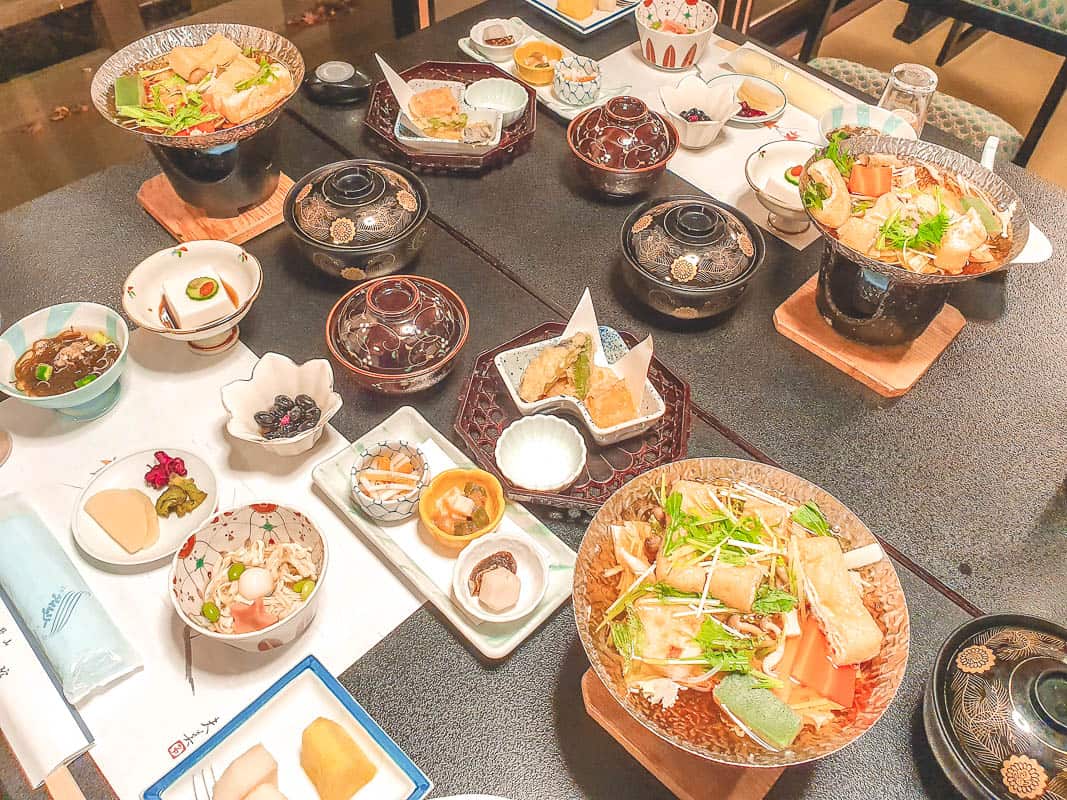
Day 6 Koyasan, Wakayama
If you can fit an overnight into your 14 day itinerary that will offer a totally unique experience, this is it. The Kii Peninsula in Kansai includes Kyoto, Osaka, and Wakayama.
Across the Peninsula are a series of Sacred Sites and Pilgrimage Routes, much like the Camino de Santiago in Spain. UNESCO recognized the region as a World Heritage Site. This makes Wakayama a perfect spot to spend the day hiking or exploring temples.
Wakayama is also a great destination for food travelers too. Koyosan is the center of Buddhism in Japan and is located within Wakayama. There are over 100 temples in Koyasan, about half of which provide temple lodging. One of the most interesting food experiences includes staying at a temple lodge in order to try their famous Buddhist Vegetarian Cuisine, known as Shojin Ryori.
Planning A Trip To Koyasan
You can train from either Osaka or Kyoto to Koyasan using the Japan Rail Pass. Once there, spend the afternoon exploring some of the famous temples. Also, take a walk through Okunoin, a famous Buddhis Cemetery. There are over 200,000 gravestones. It’s a beautiful and peaceful place to explore. (Please don’t take photos within the cemetery). There are a handful of restaurants that are known for vegetarian cuisine, which was even enough to fill Eric’s belly.
Spending The Night In Koyasan
Spending a night in the Mount Koya area is almost like an all-inclusive stay. Book at one of the temple lodgings. These are mostly simple places to stay for the night, normally with tatami-style rooms with futons on the ground. A shojin ryori vegetarian dinner is included. They do serve beer and sake, but we used it as a night to detox.
After dinner, head back to the temples to see them lit up at night. It’s quite peaceful. Then, it is time for bathing. Some of the temple lodges have private, western-style bathrooms. Others offer traditional Japanese bathing, which is sex separated, public, and nude. That alone is an experience.
It’s an early-to-bed experience. There is the option of observing a dawn ritual where the monks offer a service to practicing Buddhists. We stayed in a traditional lodge where we were the only foreigners. The entire proceeding was in a combination of Japanese and Sanskrit. As much as we didn’t understand a word, observing was fascinating.
Where To Stay In Koyasan
We recommend Jokiin , which offers all of the above experiences. They have a traditional Japanese public bath, but also offer some rooms with a private bath. All rooms are tatami-style, with futons on the floor. Book here .

Day 7-8 Kobe
Kobe City is located in the west end of central Japan. It’s a port town and hosts the 6th largest population in Japan. What most people know about Kobe is its namesake beef. It is also one of the top sake producers in the country as well. This makes it an interesting city to add to your two week itinerary.
Top Attractions In Kobe
Did you know that the Nada-Gogo, or the Five Regions of Nada, produces one-quarter of the sake in Japan. The Nada region includes Kobe, which makes Kobe the perfect place to learn about sake. They started producing sake in Nada over seven centuries ago. Try visiting the Kobe Shu-Shin-Kan Brewery, which is on the train line between Osaka and Kobe.
What To Eat In Kobe
Kobe beef is unique to Japan. The beef comes from a particular breed of cattle called Tajima-gyu. The cattle must be born and raised in the Hyogo Prefecture to be considered Kobe beef.
Eating Kobe beef in Japan is a bit of a ritual. Normally you sit at a counter and order the beef by weight and variety. The chef will often show it to you, sort of for approval, but really so that you can look and confirm the quality. The beef is cooked on a flat top grill, to rare or medium rare temperature. Organize your Kobe experience ahead of time, whether you stay in Kobe or visit as a day trip. Learn more here .
Where To Stay In Kobe
Check out the ANA Crown Plaza Kobe , which is part of the IHG hotel group. It’s close to the train station making it easy to explore the city and the surrounding area. Check rates here .

Eating Kitsune Udon In Kyoto
Day 8-10 Kyoto
One of the most popular cities for travelers to Japan, Kyoto is one of the best places to learn about Japanese culture. Kyoto means “capital city” because it once was the capital of Japan before it was moved to Tokyo. We tend to prefer the culinary scene in Osaka more, but there is still loads of good food in Kyoto.
Top Attractions In Kyoto
There are 17 UNESCO World Heritage Sites in Kyoto alone. There are hundreds of Shinto Shrines, loads of Buddhist temples, and Japanese gardens. Check out the Imperial Palace , which is free for travelers to wander through and take in all of the splendor of an ancient way of life in Japan.
Gion is one of the most popular neighborhoods to visit. It’s known for its Geiko, or geisha, culture. It’s one of the most well-preserved parts of the city with ancient houses and adorable alleyways. It is also one of the most touristy parts of the city, so be prepared.
Fushimi Inari-taisha S hrine is another popular destination and is just a short ride from Kyoto Station by train. After visiting the temples continue a little further south to the Fushimi Sake District, the sake producing area of Kyoto. There is a brewery tour and plenty of shops selling sake and offering tastings. It makes a great afternoon out of the center of Kyoto.
Tours And Tickets For Kyoto
Looking for the perfect Japanese Instagrammable moment? Book a Kimono rental for a day and then head to the temples or the narrow alleys of Gion for photos. Book a rental here .
If you love sake and want to learn more about it, check out this Sake Brewery Tour and Tasting .
Or, book an evening Food Tour in Gion and Pontchoco . See all of our recommended Kyoto Food Tours here.
What To Eat And Drink In Kyoto
Kyoto is known for its kaiseki and Buddhist vegetarian cuisine. There is also a great ramen scene. For food travelers, there’s Nishiki Market and the surrounding neighborhoods and alleyways near Shoji Jori, the main shopping street.
At night, head to Pontocho Alley, which runs along the river, west of Gion, for some of the best restaurants in the city. For someone on a budget, check out Kyoto Ramen Alley, which is actually on the 10th floor of the Kyoto train station.
Check out these related posts :
Kyoto Food Guide – What To Eat In Kyoto
How To Find The Best Ramen In Kyoto
Where To Stay In Kyoto
Like Osaka, Kyoto is also pretty easy to travel around. We stayed at the Westin Miyako Kyoto , which is lovely, with views over the mountains and the city. We’ve also stayed at a very simple guest house near the Imperial Palace. Here are some other recommended hotels in Kyoto.
Luxury Hotel Sowaka : Located at the southern edge of Gion, this is the epitome of Japanese luxury, with well-appointed rooms in a ryokan style. Check the best rates here .
Park Hyatt Kyoto : For luxury accommodations of a more western standard, Park Hyatt Kyoto is one of the top hotels in the city. Check the best rates here .
Mimaru Kyoto Horikawarokkaku : A four-star hotel in the center of some of the best eating in Kyoto and close to the Nishiki Market. Check the best rates here .
Help With Transit
If Kyoto is your last destination, then it is possible to fly out of Kansai Airport. Kansai is actually closer to Osaka, but still easy to access by train from Kyoto. Or, you can book a limousine bus from Kyoto here .
Also, consider picking up a transit pass for Kyoto. This pass can be purchased for one or two days and can be used in both Kyoto and Osaka. Learn more here .

Day Trips From Osaka (Or Kyoto)
We are not huge fans of checking in and out of hotels every couple of days. It gets exhausting. It also gets in the way of our eating. One way to be more efficient when planning a Japan travel itinerary for 14 days is to pick either Osaka or Kyoto as a home base and to see several sites and cities.
For food travelers, we definitely recommend Osaka as a home base. You can take a day trip to Kyoto to visit Gion, Fushimi Inari-taisha Shrine, and other spots all in one day. The fast train takes 14 minutes between the cities. The cheaper rapid train takes 24 minutes. Both are included in the Japan Rail Pass.
You can be back to Osaka in order to take advantage of the nightlife there. Accommodations in Osaka also tend to be less expensive.
Other Side Trips
Regardless of which city you base yourself in, you can spend four, five, or even six nights over a two week stay in Japan in either city and see a lot. Here are a few of the cities you can explore as a day trip from Osaka or Kyoto. If you don’t want to spend two nights in Kobe, it is also possible to do as a day trip from either Osaka or Kyoto.
Nara is located just between Osaka and Kyoto. There are a good number of ancient temples, but it is most known for the deer that roam the city. It’s also home to Tōdai-j, a Buddhist temple complex with one of the largest Buddha statues in Japan.
Another side trip is to Himeji Castle and then to Miyajima. Miyajima, or Itsukushima, is a famous temple located on an island in Hiroshima Bay. There is the famous Great Torii Gate, which is an orange gate surrounded by water.

Eating ramen in Sapporo in Hokkaido
Day 11-14 Sapporo
We just made our first trip to Sapporo and it was in the winter. Yes, it snowed. Even though we don’t like the cold, we loved our time in Sapporo and would definitely recommend adding to a 14 day Japan itinerary. Yes, you need to take a domestic flight there, but you can also book international flights from Sapporo to head home.
If heading to Sapporo in winter , be prepared for cold and snow. But that also means fun snow sports and skiing. The summers are warm, but not as hot as down south. The most important thing, the Hokkaido region is entirely unique within Japan and worth a visit.
Top Attractions In Sapporo
Many of the top things to do in Sapporo are located within the city center. This includes all of the best places to eat. It’s possible to walk to many of them. If heading a little further afield, the train is easily accessible. Just at the edge of the city is a town filled with onsen , the traditional Japanese hot springs. Learn more here .
Tours And Tickets For Sapporo
There are a couple of interesting activities for food travelers to Sapporo. First, check out the Sapporo Beer Factory and the Beer Garden. After a tour of the factory, enjoy a meal of the famous Genghis Khan in the garden. Learn more here . If looking to try Hokkaido’s world-famous crab, book a crab eating experience in Sapporo.
What To Eat And Drink In Sapporo
The main reason why we think Sapporo is worth a flight up north is that the food is so different and so great! Hokkaido is known for crab and other seafood. There are also a handful of dishes that are unique to the region. This includes ramen made with corn and butter, Genghis Khan, which is a lamb BBQ, and soup curry. Read more about all the great food in Sapporo here:
Sapporo Food Guide – What To Eat In Sapporo Japan
Finding The Best Ramen In Sapporo – Ramen Yokocho And More
Where To Stay In Sapporo
I recommend staying in the Susukino neighborhood of Sapporo. We stayed at the Mercure Sapporo in Susukino and couldn’t have been happier with our decision. The Mercure Sapporo is a 15-story contemporary high-rise hotel with French influences and is part of the Accor family of hotels.
The Mercure Sapporo is close to all of the best places to eat in Sapporo. It’s right in the heart of Susukino and only a few blocks away from ramen alley and Nijo Market. This was perfect for us, and really anyone who visits Sapporo. You can eat all of the best foods in Sapporo without traveling more than a few blocks from the hotel.

Hokkaido in winter
When Is The Best Time To Visit Japan
Japan is a year-round destination. Being a long country, there are a variety of climates. In the north, in Hokkaido, you have some of the top ski destinations in the winter. In the south, in Okinawa, there is a more tropical climate where it is warm in the winter.
This 14 day Japan itinerary focuses on Tokyo and the Kansai region, in the center of the country. But it also includes Hokkaido in the north. In the center of the country, expect warm summers and cold winters.
Top tourist sites in the summer can be crowded and hotels are more expensive. Winter is relatively mild, even when it snows. Tourist sites are less crowded and hotels are less expensive. The shoulder seasons of spring and fall are probably the best times to visit Japan, with one major exception. Cherry blossom season is in the spring, normally in April, and can be beautiful, but is considered the high season.
Winter In Japan
We’ve been to Japan twice when it was snowing and we don’t like the cold. But, it can be peaceful and beautiful visiting Japan in winter.
They do get some snow in the center of the country, but we’ve visited in Japan in both autumn and winter and found it warmer than expected for several days. The temperatures can change dramatically where it is warm one day and cold the next.
Hokkaido, in the north, has cooler summers but the snowiest winters in the world. If you love the cold and snow, definitely consider Hokkaido. If traveling to Japan in the winter, and you don’t like the snow, perhaps stay longer in the center of the country.
To better understand what it’s like to travel in Japan in the winter, check out these posts:
Top Things To Do In Sapporo In Winter
Getting To Japan
Many airlines fly directly to Japan. There are two airports in Tokyo. Narita is the largest but is farther from the city. Haneda is smaller, and closer to the city, but offers fewer international flights. Kansai Airport serves both Osaka and Kyoto. All of these airports are accessible by bus and train. Sapporo also has an international airport with plenty of flights.
There are two primary Japanese airlines that service these airports: ANA (All Nippon) and Japan Airlines (JAL). We’ve flown them both and they are reputable airlines. Other international airlines also service Japan.
Because train travel is so easy in Japan, it might help and it might save time, to fly into Tokyo and out of Kansai in Osaka or Sapporo in Hokkaido. This will help maximize your time on the ground, particularly if you are only limited to a two week trip.
Choosing An Airport In Japan Pro Tip
Sapporo only has one airport. Tokyo has two airports (NRT and HAN). The area around Osaka and Kyoto is also served by two airports (KIX and ITM). Just be sure to pay attention to which one you are booking. In each case, one is farther out from the city than the other. It’s most important when you are transferring back to the airport so you choose the right one. Trust us. We chose the wrong one in Osaka! Luckily we still made our flight in time.

How to Get Around in Japan
We’ve never rented a car in Japan. We’ve never found a reason to, particularly with this itinerary. There is so much to do, see, and eat within the cities or during day trips from the big cities.
Really, the best way to get around in Japan is by rail. Japan Rail offers a few different rail passes for either 7, 14, or 21 consecutive days. The rail pass is valid on all Japan Rail trains, including the high-speed trains (Shinkansen) between Tokyo, Kyoto, and Osaka.
The most important thing about the Japan Rail Pass is that you much be a resident of a country other than Japan. And you must purchase the rail pass before arriving in the country. They will actually mail you a rail pass so be sure to purchase it early.
If heading to Sapporo, it’s best to fly. Both ANA and JAL fly between Kansai near Osaka and Sapporo. It’s not all that expensive if you book ahead.
Learn more about Japanese food in our post about the Best Japanese Snacks To Try .
FAQs – PLANNING A JAPAN 14 DAY ITINERARY
This is a question we get about almost every destination. If you are American it is hard NOT to tip because it is so customary and even expected at restaurants and bars. Tipping is not customary in Japan. It can even actually be considered inconsiderate to leave a tip. It’s just better not to. In this case, it’s best to abide by the local culture and norms.
This is a hard question to answer because we understand a lot of people, particularly Americans, don’t have a lot of vacation time. Being able to spend a full two weeks in Japan gives you an opportunity to really experience the country. If you only have a week, see this post on how to make the most of your time.
It is no secret that Japan is an expensive country, but there are ways to spend money. It’s certainly possible to find accommodations is most cities for less than $100 a night. Meals can be expensive, but it is also possible to eat many meals for about $10-15 a person, even sushi! It is possible for two people to travel to Japan for between $100-150 a person and travel quite well.
Despite being a relatively small country, Japan is a highly diverse country. This makes it a year-round destination. In Winter, there’s skiing around Sapporo. Okinawa and the southern islands are great for a summer beach getaway. The Spring and Fall offer nature lovers stunning natural beauty.
Amber Hoffman
Amber Hoffman, food and travel writer behind With Husband In Tow, is a recovering attorney and professional eater, with a passion for finding new food and drink destinations. She lives with her husband, Eric, in Girona, Catalonia, Spain. Together over the last 20 years, they have traveled to over 70 countries. Amber is the author of the Food Traveler’s Guide to Emilia Romagna. She regularly lectures on social media marketing to travel professionals throughout Europe.
Leave a Reply Cancel reply
Your email address will not be published. Required fields are marked *
Save my name, email, and website in this browser for the next time I comment.
Kyoto Food Guide
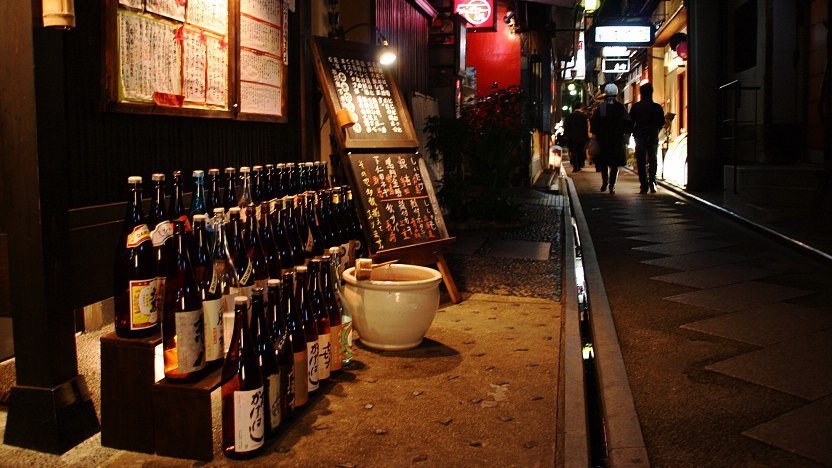
As Japan's former capital and seat of the imperial court for over a millennium, Kyoto offers a rich culinary tradition. The local food culture is diverse and ranges from aristocratic kaiseki course dinners to vegetarian shojin ryori of monks and the simple obanzai home-style cooking.
While some restaurants look to the past for inspiration, others experiment with new flavors. Fusion restaurants, which combine ingredients and techniques of Kyoto cuisine with cooking styles from other parts of the world, can also be found in the city. The Pontocho nightlife district is one of the best places to find good fusion restaurants alongside traditional establishments. Not far away, the Gion district also offers a wide range of interesting dining opportunities, as does the Kyoto Station area.
Regular Japanese food that is not necessarily associated with Kyoto in particular, such as ramen , sushi and udon , is also available across the city. Food fans should not miss a visit to the Nishiki Market in central Kyoto , which has been serving the city for many centuries.
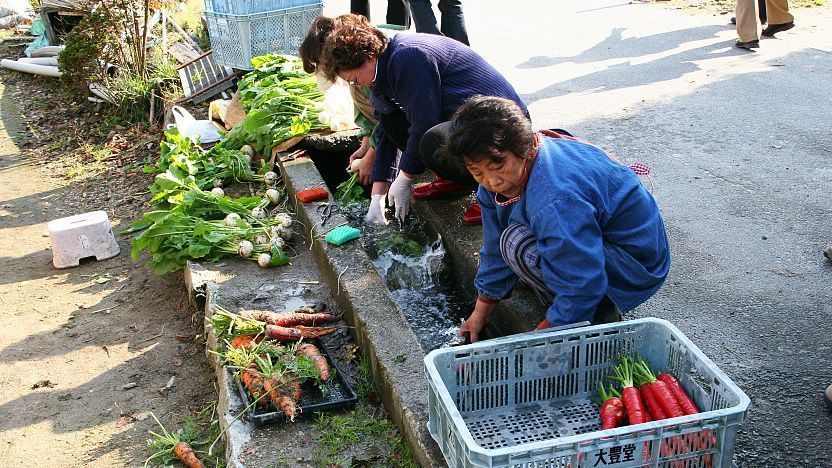
Kaiseki Ryori
Kaiseki ryori has its origin in the tea ceremony , but later evolved into an elaborate dining style popular among aristocratic circles. Kyoto-style kaiseki ryori (kyo kaiseki) is particularly refined, placing an emphasis on subtle flavors and local, seasonal ingredients. A kaiseki meal has a prescribed order of courses which is determined by the cooking method of each dish.
One way for travelers to enjoy kaiseki is staying at a ryokan where a kaiseki dinner is included with the stay. But kaiseki meals can also be enjoyed at restaurants, including high-end ryotei , many of which can be found in the Pontocho and Gion districts. A good kaiseki meal usually costs around 10,000 yen per person, but prices can go as high as 30,000 yen or as low as 6,000 yen. Some restaurants depart from tradition and include elements of foreign cuisines.
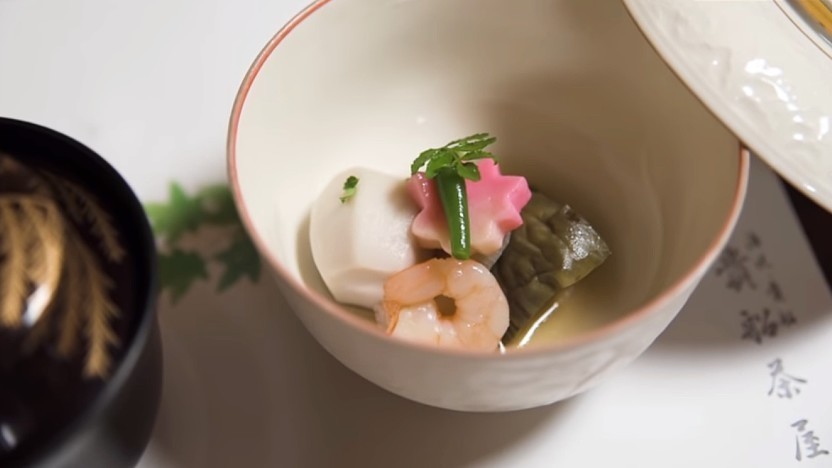
Shojin Ryori
Whereas kaiseki developed out of the affluence of the aristocrats, shojin ryori developed from the austerity of Buddhist monks. Prohibited from taking the life of other living creatures, Buddhist monks had to make do without meat or fish in their diet. Consisting of strictly vegetarian dishes, shojin ryori can nonetheless be savory and filling. Travelers who spend the night at a temple lodging will be able to enjoy a meal as part of the stay.
A common ingredient in shojin ryori is tofu , which is a local specialty of Kyoto. The preparation of tofu is so common that it can also be referred to as Tofu Ryori ("tofu cuisine"). One popular dish that is widely served at tofu restaurants in Kyoto is Yudofu , soft tofu simmered with vegetables in broth. A meal of Yudofu usually costs 1500 to 2000 yen, but the price can be higher or lower depending on the quality of the restaurant. The Nanzenji and Arashiyama districts are particularly famous for tofu cuisine.
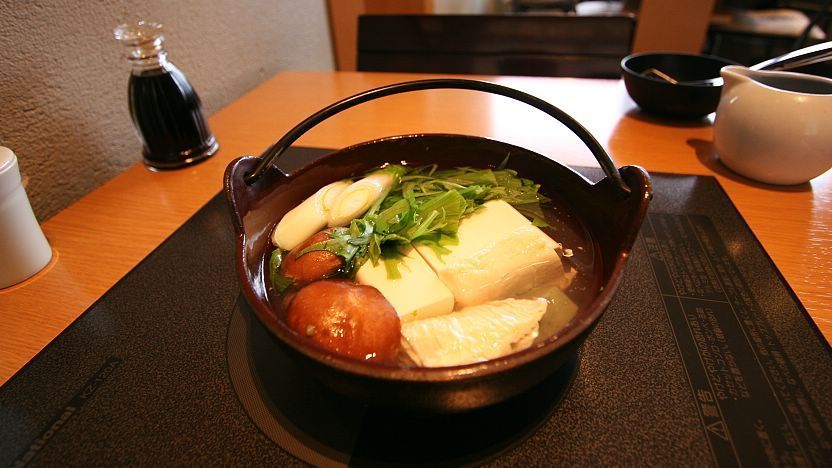
Obanzai Ryori
Obanzai Ryori is the traditional home-style cooking of Kyoto. It is made up of multiple small dishes that are usually quite simple to prepare. Local produce that is in season is best suited for the dishes. Although the cooking methods are usually not complicated, obanzai dishes can be made very rich by chefs skillfully bringing out the natural flavors of the ingredients.
Restaurants that serve obanzai ryori can be found all over Kyoto. Many of them have a relaxed and friendly atmosphere that reflects the home style of cooking. A full meal usually costs 2000 to 3000 yen, but can vary depending on the number and type of dishes ordered.
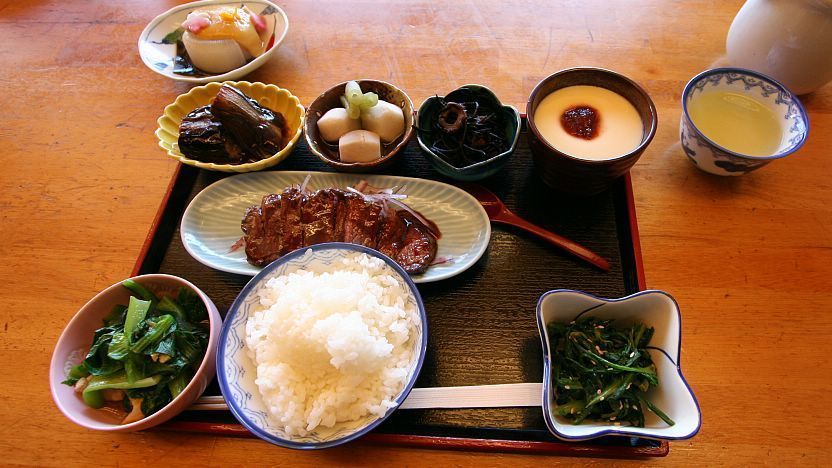
Kawayuka/Kawadoko
Kawayuka, or Kawadoko as it is known outside of central Kyoto, is the summer pasttime of dining outdoors on temporary platforms built over flowing water. Developed as a way to beat the summer heat, kawayuka is a great way to experience Kyoto cuisine while taking in the cooling effects of the flowing water and lively summer atmosphere.
The most famous area to experience kawayuka is along the Kamogawa River in central Kyoto, especially around Pontocho . From May to September, restaurants here construct temporary wooden decks over the canal on the river's west bank. Many places serve kaiseki meals , however other types of cuisine are also available.
Kibune and Takao in the forested mountains north of central Kyoto, are also popular places to try kawayuka, although here it is called kawadoko. In Kibune especially, the platforms are built just centimeters above the river and provide almost complete relief from the summer heat.
Terrace dining is popular, especially along Kamogawa River in the evenings on weekends and during holidays, when advance reservations are a must at most river-facing restaurants along Pontocho (usually in Japanese by phone).
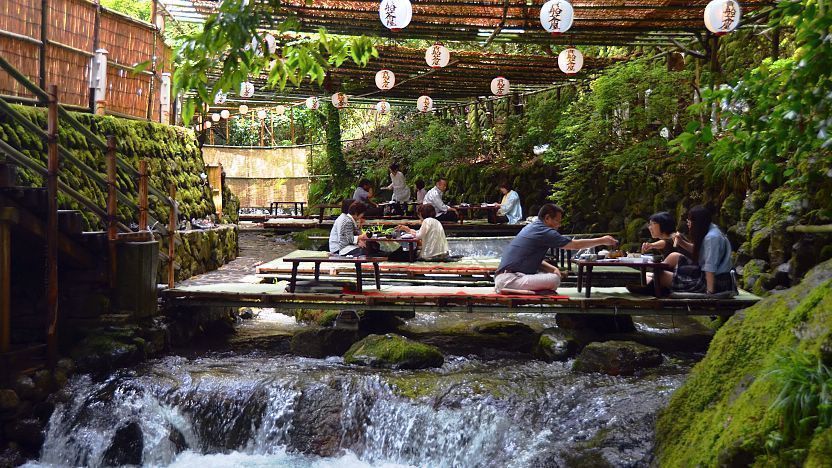
Questions? Ask in our forum .
Hotels around Kyoto
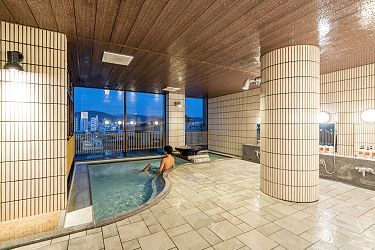
Experiences around Kyoto
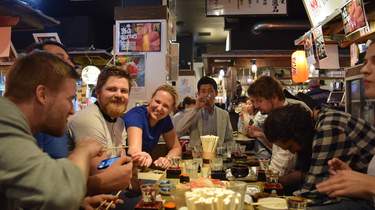
- Czech Republic
- Budapest, Hungary
- Amsterdam, Netherlands
- Switzerland
- Complete Japan Travel Guide
- Kanto Region (Tokyo, Hakone)
- Kansai Region (Osaka, Kyoto)
- Kansai Wide (Wakayama)
- Chugoku Region (Hiroshima)
- Chubu Japan
- Hokkaido Japan
- Kyushu Japan
- Jeju Island, South Korea
- KLOOK Promo Code & Voucher (2024 April)
- Agoda Promo Code
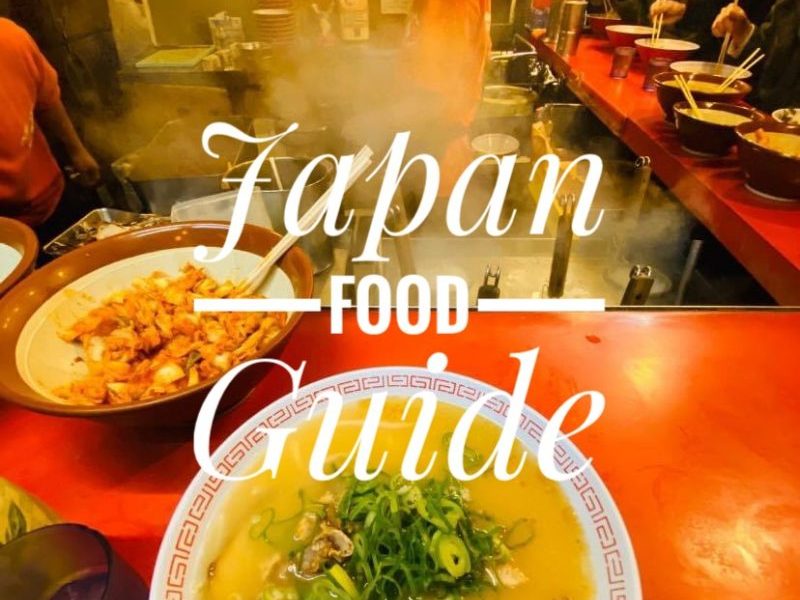
Japan Food Guide: What To Eat in Japan
Last updated on April 21st, 2024
Here is our Japan Food Guide covers everything from the best, traditional, and must-try Japanese dishes to navigating Japan’s best restaurant scene.
Japan is one of the world’s best countries for food that takes great pride in its food culture. A visit to Japan would not be complete without experiencing any of Japan’s unique and diverse cuisine. Although you can easily find many Japanese food and restaurants in your home country, you have to taste the authentic Japanese food in Japan for yourself when you are in Japan!
There’s so much delicious food in this country. So much it makes my head spin! This Japan food guide post isn’t a definitive answer to the question of what to eat in Japan by any means, but I liked the variety of the food we tried whenever visit Japan.
To make it as well-rounded as possible, we will list down all the best food that we tried in Japan. From the popular must-eat food, obscure regional specialties, and local favorite dishes, for sure there is something that meets your food scenes and level of affection for Japanese cuisine.
We hope that we can give you even the tiniest idea of the best food scene in Japan.
What To Eat in Japan: Must-Try Japanese Dishes
But first, this is the long post for the Japan food guide that we tried to categorize and summarised all the best food we ate and restaurants visited. Feel free to click on each section for your best food in Japan.
Japan Food Guide – Must-Try Japanese Dishes in Japan :
- Sushi and Sashimi : Sushi, Conveyor Belt Sushi, Sashimi, Basashi (Horse Meat Sashimi).
- Noodle Dishes : Ramen, Tsukemen, Soba, Udon, Fire Ramen, Flowing Bamboo Noodles.
- Rice Dishes : Kaisendon, Hitsumabushi (Unagi with Rice), Kamameshi, Japanese Curry Rice.
- Mix Ingredient / Other : Tempura, Okonomiyaki.
- Hot Pot Dishes : Hot Pot (Nabe), Motsunabe.
- Meat / Poultry : Yakitori, Yakiniku, Tonkatsu, Jingisukan.
- Popular Japan Seafood (served in sashimi, or together rice) : Fugu, Crabs, Sea Urchin.
- Japanese Snack / Dessert / Drink : Takoyaki, Gyoza, Korokke, and more.
If you’re curious about each best food location in the Japan Food Guide post, read on for more details on what to eat in Japan regional if you want to fly home with a happy tummy!
SUSHI AND SASHIMI
The best Sushi and Sashimi to eat in Japan:
Sushi | 寿司 or 鮨
Conveyor belt sushi | 回転寿司, sashimi | 刺身, basashi (horse meat sashimi) | 馬刺し.
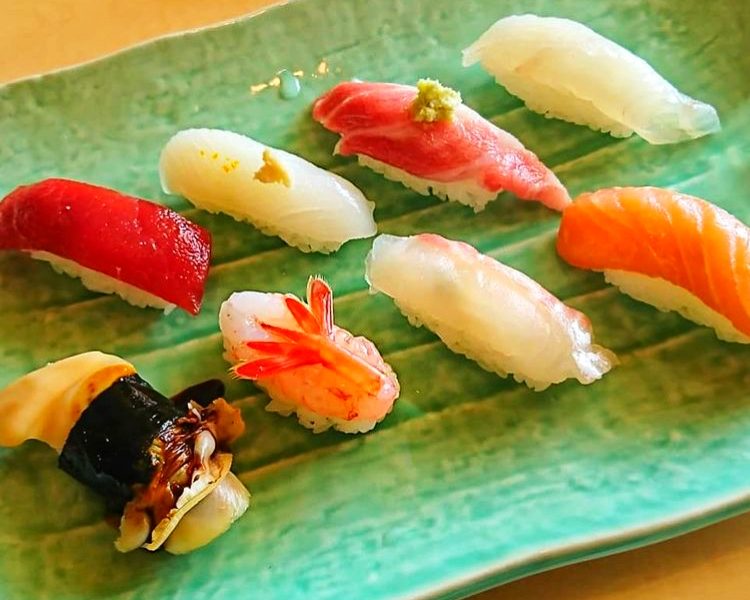
First of all, let’s start with the best food that most of us associate Japan with Sushi. The artfully presented dishes are made with vinegared rice and together with a variety of ingredients, mostly raw fish and other types of seafood. You can just grab a piece of sushi with chopsticks and dipped it into soy sauce or wasabi (a spicy Japanese condiment).
Depending on the shape and ingredients that are used, the family of sushi can be called different names. The common types of sushi are maki sushi, nigiri sushi, inari sushi, gunkan, inari sushi, Oshizushi, Temaki sushi, etc.
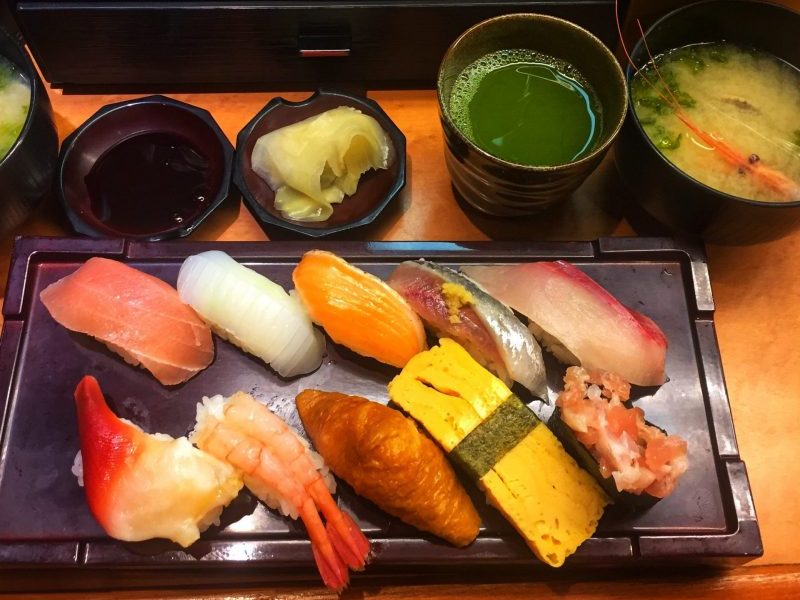
Nigiri sushi is a bite-sized mound of sushi rice topped with slices of raw fish. Maki sushi is commonly referred to as a “sushi roll” where fresh fish and/or other ingredients are wrapped with Japanese rice and a dried seaweed sheet (nori).
It is a big part of Japanese cuisine and you can easily find a variety of sushi restaurants in Japan.
Japan Food Guide Tips : There are a lot of things to know when it comes to Japanese food culture. Do you know that there is a correct way of eating sushi?
- You can eat sushi with either chopstick or by using your hands.
- Don’t mix wasabi in your soy sauce.
- Add soy sauce only to the fish topping instead of the rice so the sushi does not fall apart.
- Do not cut a piece of sushi in half with your chopsticks.
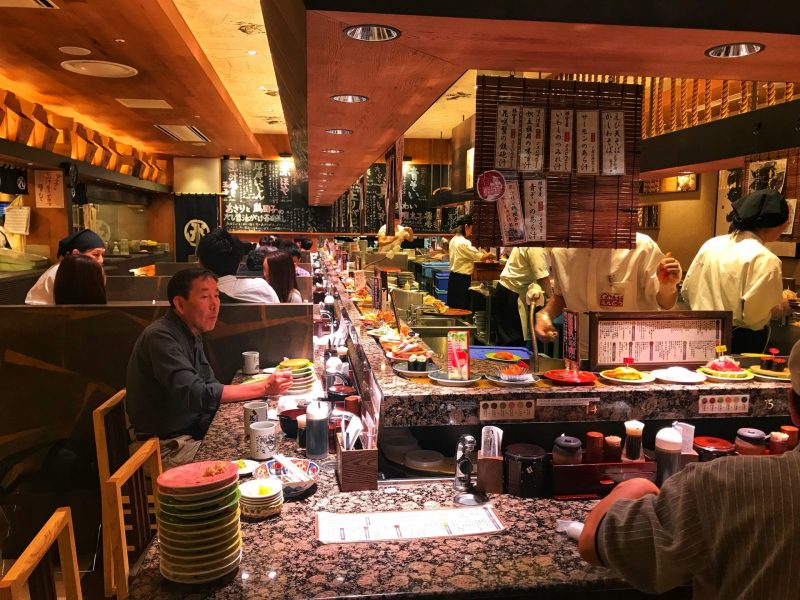
A fun way to sample a variety of sushi is by visiting a conveyor belt sushi restaurant. The “kaitenzushi” (回転寿司) is very popular among locals and travelers. A conveyor belt transports small plates of various sushi around the restaurant, with different color plates, and passes around the tables or booths. You can take any sushi that you want and the prices of each plate of sushi are different depending on the color of the plates.
Be sure to pick up the entire plate instead of picking single pieces of sushi off the plates.
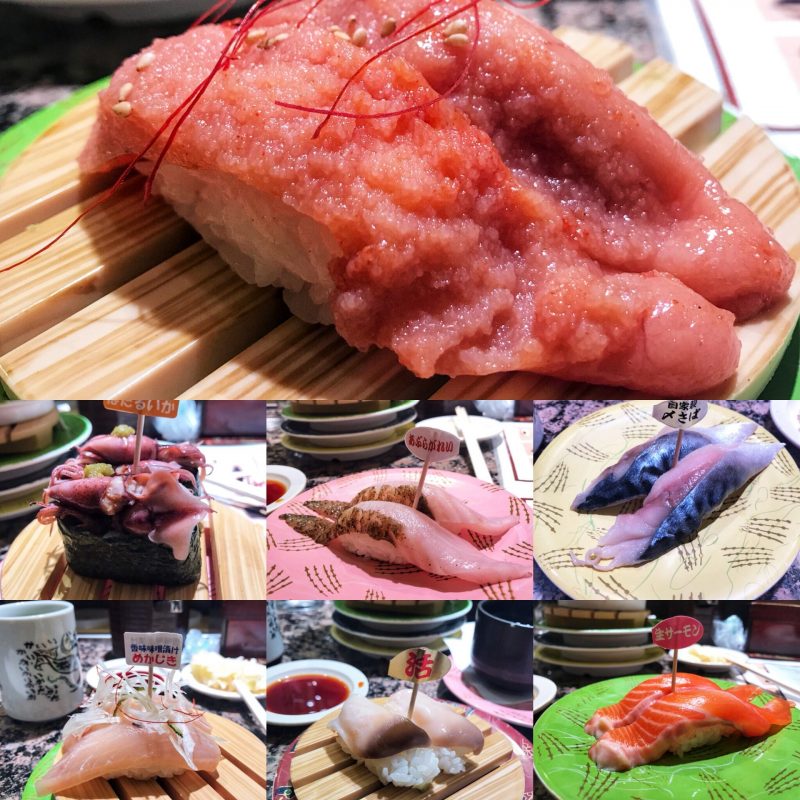
There is a wide availability of conveyor belt sushi restaurants in Japan. The Kura Sushi and Sushiro are Japan’s popular chain conveyor belt sushi restaurant that offers Japan’s longtime affordable sushi at a budget price yet freshness guarantee.
Nemuro Hanamaru is the Hokkaido’s Quality Conveyor Belt Sushi for its finest quality sushi that won’t break the bank. You can find exquisite sushi at great prices including that seasonal seafood here. Always busy and attracting a lot of people including locals and tourists.
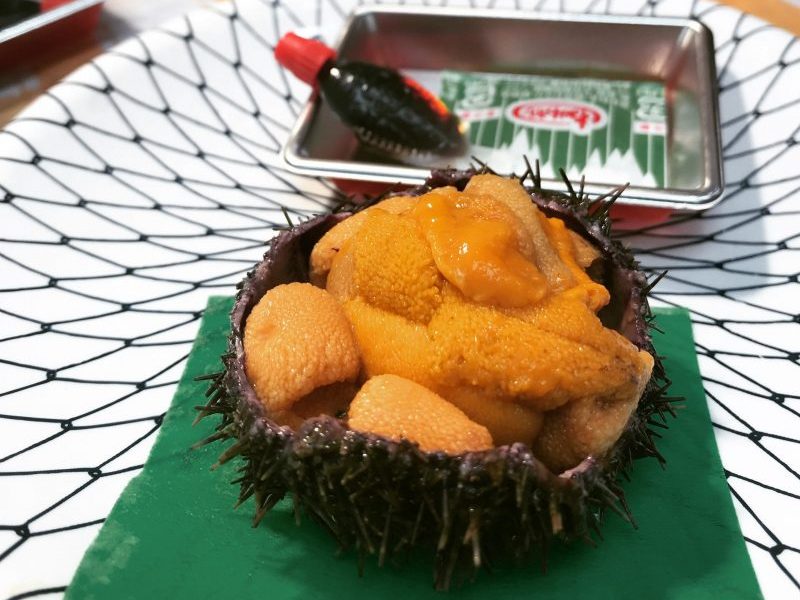
Sashimi is sushi minus the vinegared rice. This Japanese delicacy is one of the most famous dishes in Japanese cuisine. The raw fish or meat is thinly sliced into pieces and often eaten with wasabi and soy sauce.
The common types of sashimi that travelers are likely to eat in Japan:
- Maguro (Tuna) – The best and must-eat sashimi in Japan! You won’t believe how rich and buttery flavor of eating Japan’s tuna, either sashimi or sushi. My favorite part of tuna is the toro. Truly heaven!
- Sake (Salmon) – The bright orange tender salmon is one of my favorite sashimi in Japanese cuisine.
- Saba (Mackerel) – Though more popularly served grilled, saba is also enjoyed as sashimi when in season.
- Amaebi (White Shrimp) – The sweet and subtle flavors are usually presented with the shell removed.
- Hotate (Scallop) – The best Hotate has a firm texture and a sweet, almost creamy taste.
- Hokkigai (Surf Clam) – The best Hokkigai that I tasted is in Hokkaido, with firm meat and sweet flavor.
- Ikura (Salmon Roe) – Translucent and bright orange fish eggs.
- Uni (Sea Urchin) – Particularly the expensive delicacy in Japan. Flavorful and rich in taste with and buttery texture.
Chicken Sashimi
While seafood is most commonly eaten as sushi and sashimi, other types of meats (such as chicken, beef, or even horse) can also be served. Due to health concerns, raw meat needs to be super fresh to be safely eaten. So normally, a special license is required to serve raw meat in Japan.
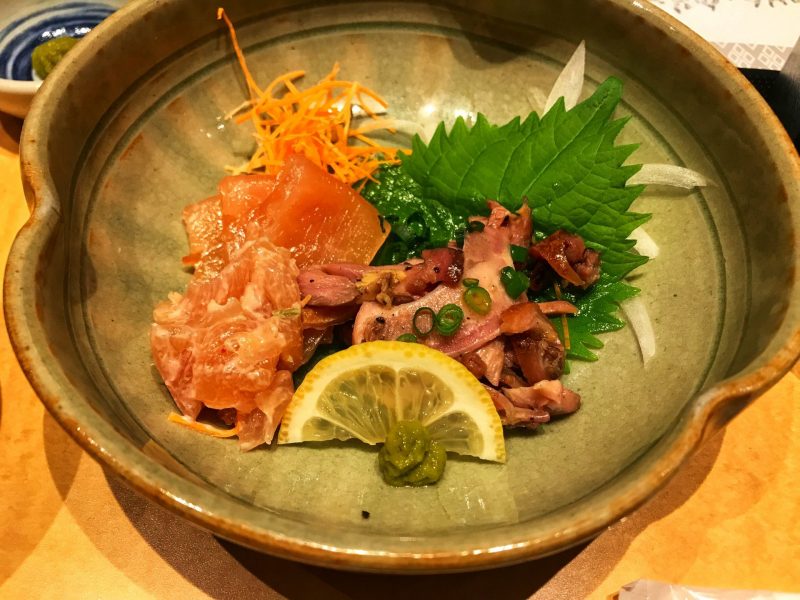
Beef Sashimi
We did try the beef sushi in Takayama. Not as premium as Wagyu, Miyazaki, and Kobe beef, the Hida beef is a famous beef from the Gifu area in Central Japan and classified as high glass beef in Japan. It is so delicious and melted once put inside the mouth. The taste was similar to flavorful toro sushi. But you will never realize that it was beef sushi. Amazingly delicious!
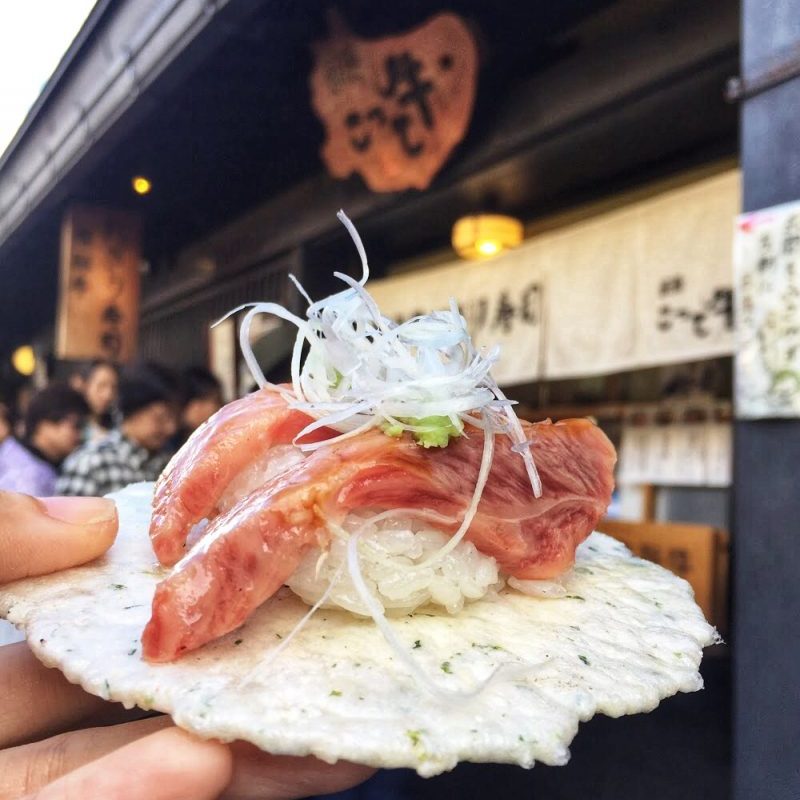
The basashi (馬刺し) is the horse meat sashimi, another type of meat sashimi served in Japan. Because of its pinkish color, horse meat (sakuraniku) is also meaning “cherry blossom meat”.
This local dish is hard to find in most other prefectures, and Kumamoto is the best place to taste the basashi in Japan. We get the chance to try this unique cuisine in Suganoya (菅乃屋), Kumamoto. The basashi is delicious and one of the most surprising Japanese dishes we’ve had so far.
Plus, chicken sashimi is particularly popular in Miyazaki and Kyushu regions.
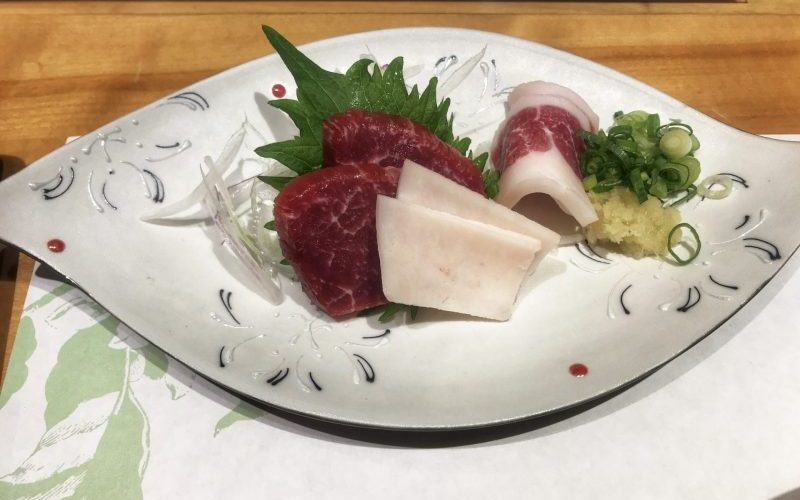
NOODLES DISHES
The Best Noodle Dishes in Japan :
Ramen | ラーメン
Tsukemen | つけ麺, flowing bamboo noodles | そめん流し.
Another popular food option when looking for something to eat in Japan. Ramen is inexpensive and widely available in Japan, making it the best food for budget travelers. You can find countless regional variations of ramen in every corner of Japan. Ramen alone can be written for the separate best ramen in Japan Food Guide.
There is always one of the best ways of enjoying your ramen, slurp up the noodles! A slurping sound is not an impolite eating behavior in Japan, In fact, it helps to enhance the flavors and cool down the piping hot noodles when eating. You don’t need to finish the entire bowl of broth, but it is a compliment for a ramen chef with an empty bowl of ramen.
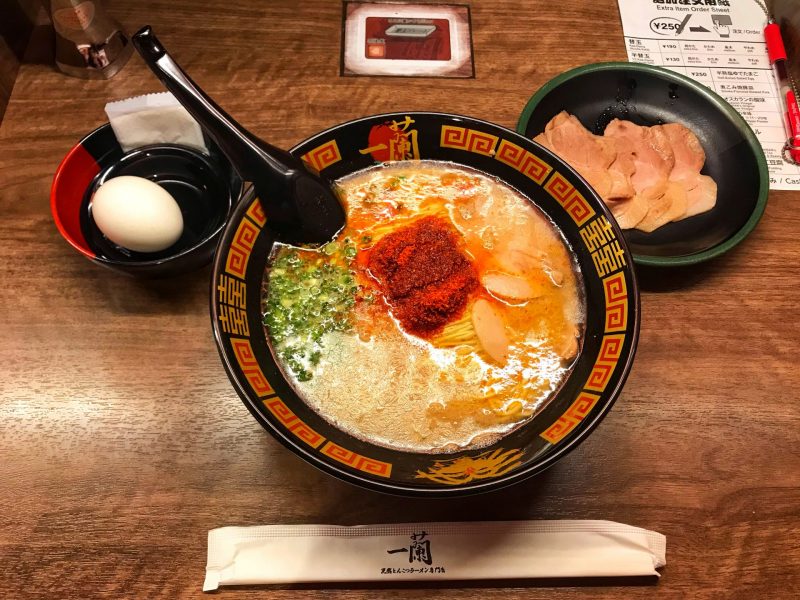
A bowl of tasty ramen normally consists of four basic components; broth, wheat noodles, tare (seasoning), and toppings. In most ramen restaurants, you can usually ask how done you’d like the noodles – thin, soft, firm, or extra firm. While the noodles and toppings enhance the food experience. but in our opinion, the broth is the star and the most important part to determine the taste of the best ramen.
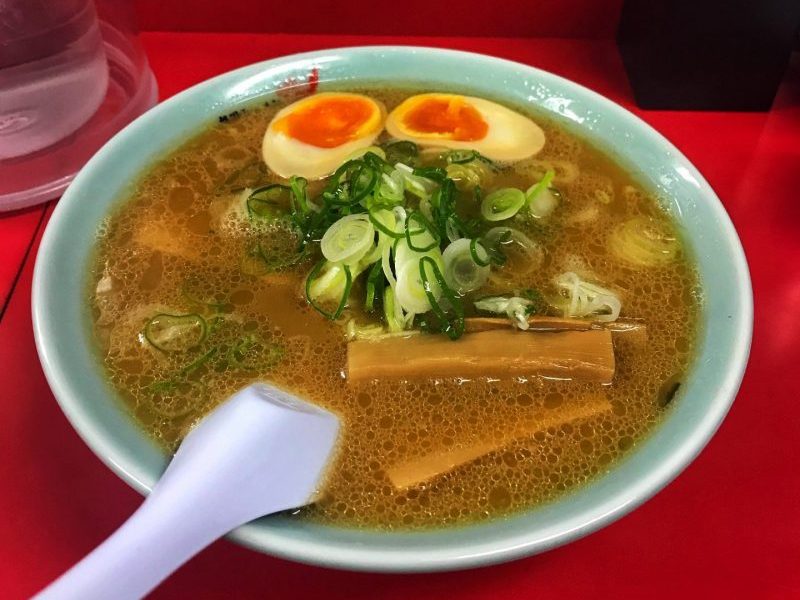
Ramen: Shoyu, Miso, Shio, and Tonkotsu
Ramen is typically categorized into four main types – Shoyu (Soy Sauce), Miso (Soybean Paste), Shio (Salt), and Tonkotsu (Pork Bone) . It is available in many different regional varieties, and some have become extremely popular that can be found in entire Japan. The heavy and hearty taste immediate can warm your body when you slurp up the noodles.
Miso Ramen is among the most popular regional ramen varieties and has become a mainstay at ramen valley all over the country. Sapporo served the best miso ramen in Japan, featured with fat, robust noodles and often topped with filling Hokkaido specialties, such as creamy butter and sweet corn.
Tonkatsu Ramen
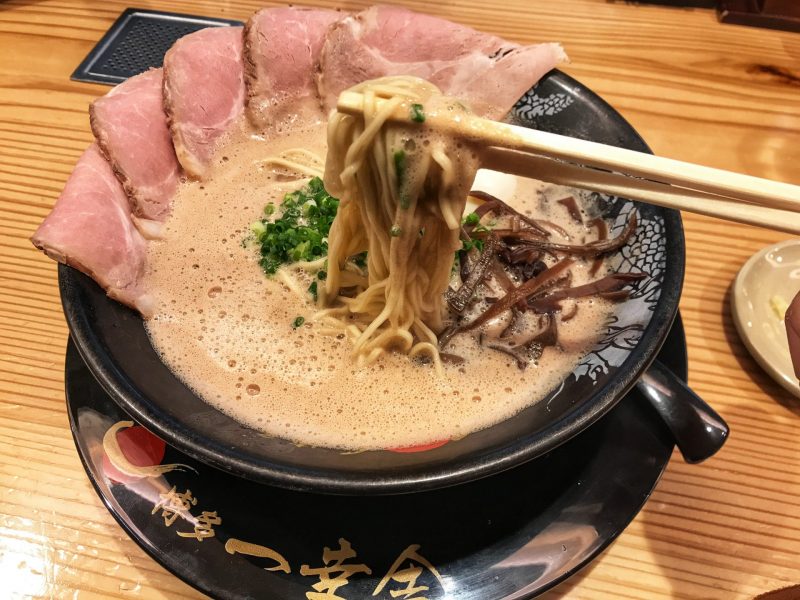
Personally, my favorite type of ramen is Hakata’s tonkatsu ramen on the northern shore of Kyushu in Fukuoka, the birthplace of pork bone broth ramen.
The taste of tonkatsu ramen is popular not only within Kyushu but also across Japan. Pork bones, fatback, and a whole host of other ingredients are simmered for long hours until they break down into an ultra-rich, porky soup with fat globules floating on top. Tonkatsu ramen has the tastiest flavor I have ever tried and can range from soft to strong depending on where you order it.
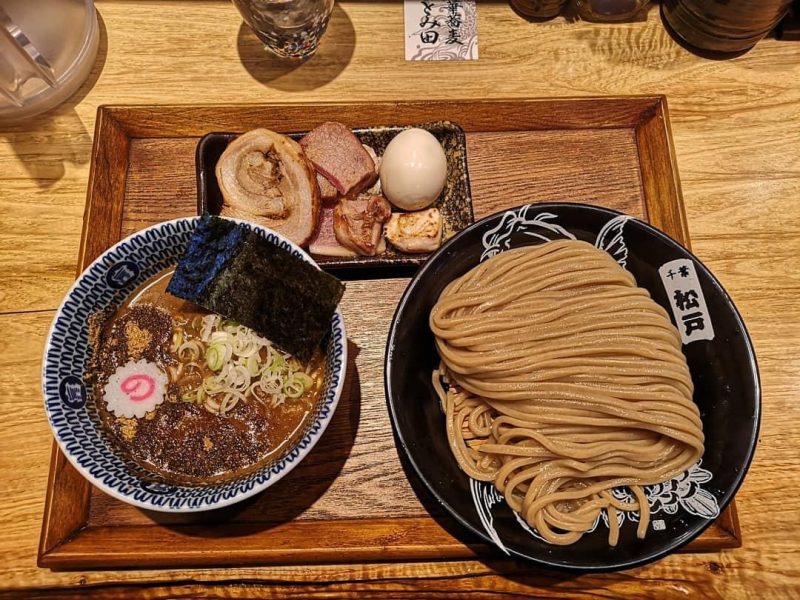
You probably are already familiar with ramen. But there is another special ramen that you can try is the Tsukemen or dipping ramen noodles. a style of ramen where the broth and noodles are served separately. It helps to ensure that the noodles stay firm throughout your meal.
Tsukemen noodles are thicker than ramen noodles and have a firm chewy texture. While the broth is more intensely flavored than usual ramen broth to make sure the noodles are well-coated with flavor. Just dip the noodles into the broth aside and enjoy it.
The best tsukemen that i had in Japan from Chuka Soba Tomita (中華蕎麦 とみ田) . It is unanimously considered the No#1 best ramen in Tokyo, or even Japan. Chuka Soba Tomita has won the grand prize in TRY (Tokyo Ramen of the Year) for 4 consecutive years and in many Ramen tournaments. Due to the popularity, and the extremely long waiting time to taste this best tsukemen. It is suitable for those travelers who love to hunt for the best food in Japan with extra time spare. The tsukemen is rich but refined flavor, and ultimately divine!
Read on my food experience in Chuka Soba Tomita .
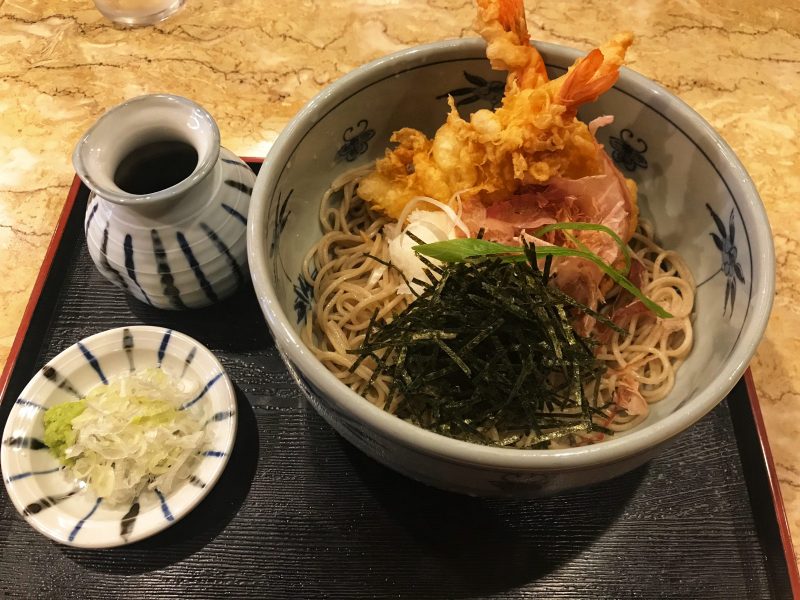
Soba is the Japanese name for thin noodles made from buckwheat flour, or a combination of buckwheat and wheat flour, roughly as thick as spaghetti. Similar to udon and ramen, soba noodles are often found in savory soup broth and they can be served either hot or cold. The cold-served soba comes with a dipping sauce called tsuyu, while the hot soba is served in a bowl of hot, clear broth.
Soba is cheap and popular, and widely available throughout Japan. Simple soba noodle dishes typically cost between ¥500 yen and ¥1,000, and special soba meal sets, accompanied by a variety of side dishes, like sushi, sashimi, tempura, chawanmushi, are usually priced at ¥1,500.
This simple noodles dish is widely consumed in the whole of Japan and can be easily found at specialized soba restaurants, family restaurants, izakaya, or even standing counters at busy train stations.
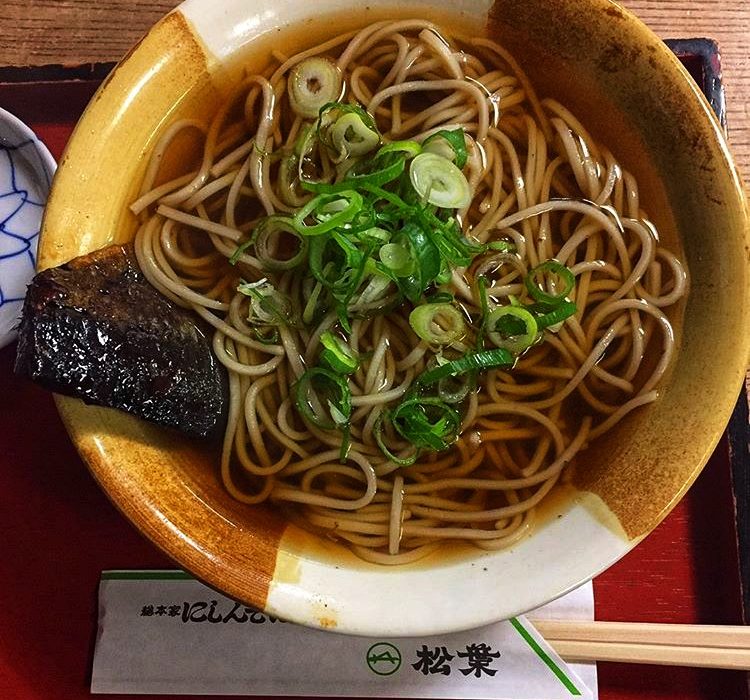
If you visit Kyoto, then you may be interested in trying Nishin soba, one of Kyoto’s specialty cuisine. The local herring fish is perfectly smoked with sweetness and salty tastes served together with the soba noodles and flavored soy sauce broth. A unique Kyoto-style soba noodles!
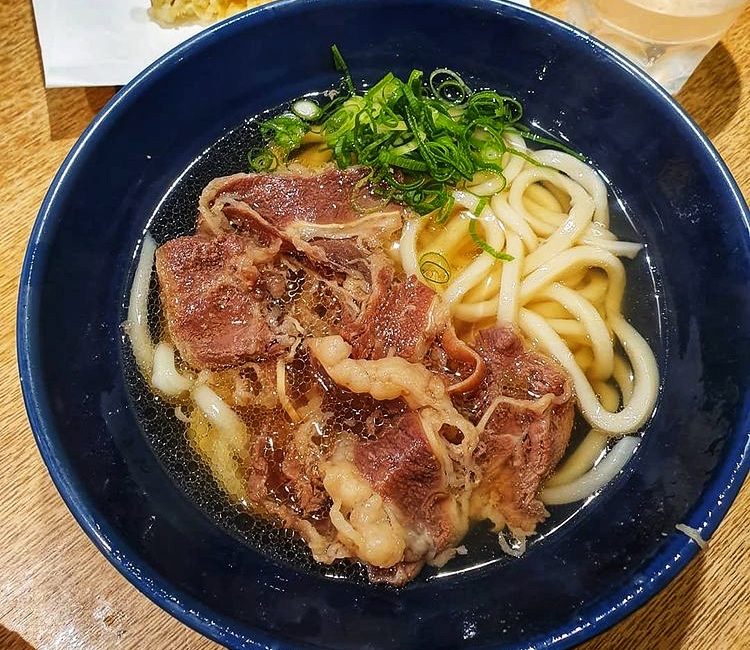
Similar to soba, Udon (うどん) is another popular Japanese dish that is an easy introduction to Japanese food. Also made from wheat flour, Udon is thicker than soba noodles and chewier. Udon noodles are served with a variety of ingredients in different styles, including in hot broth, cold, stir-fry, with curry, and even dry with a dipping sauce.
The most traditional version of Udon is served in hot broth. The flavourful savory bowls are loaded with soft thick noodles, sliced chicken or beef, fresh vegetables, and a variety of garnishes like green onion, sesame seeds, roasted seaweed slices, nora, and dried garlic.
Some people will prefer the simplicity of udon noodle soup. To me, as opposed to ramen, udon is often a bit plainer in flavor (the broth or sauce is typically not as heavy or salty as ramen) beyond the thickness difference.
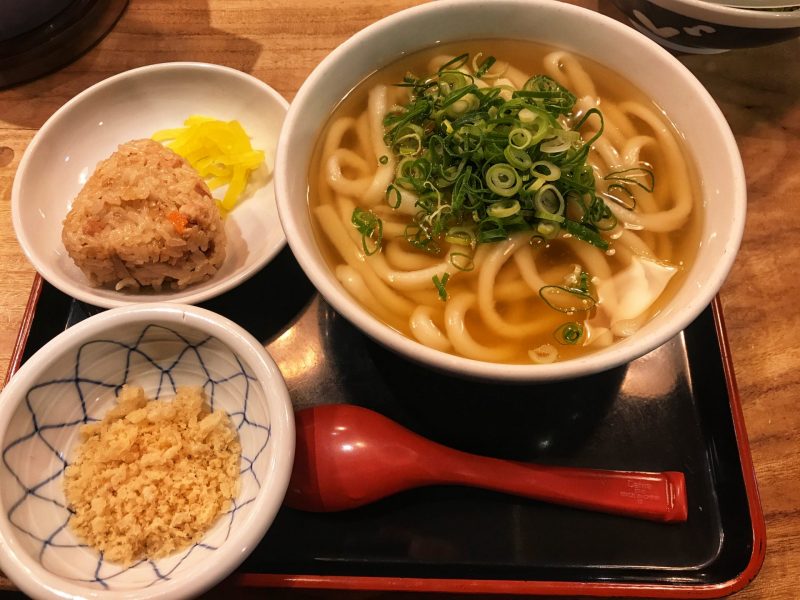
Similar to soba and ramen, udon is widely available at restaurants across Japan, especially at busy train stations. I particularly love to enjoy a bowl of hot served udon noodles for breakfast before departing for a day trip in Japan.
The simple breakfast Udon set is served in a hot broth with green onion, tempura bits, and the add-on side, normally costs you between ¥500 and ¥1,000.
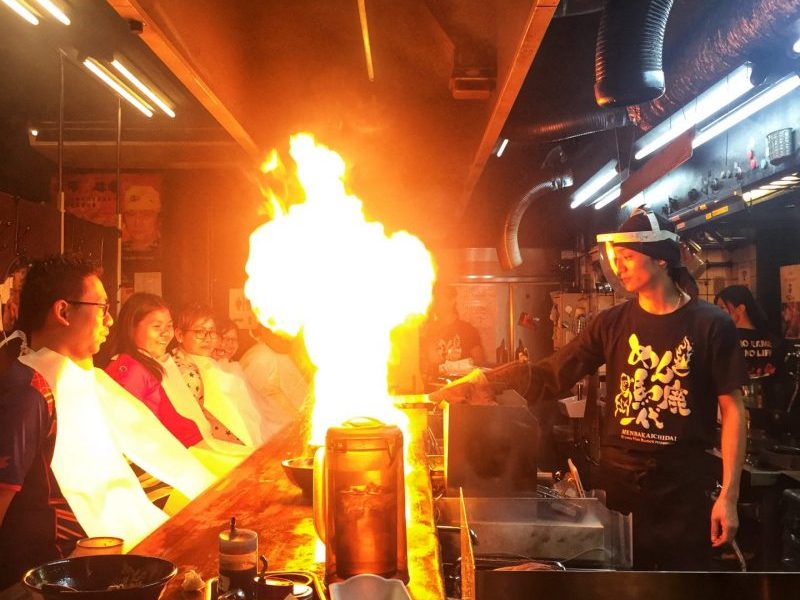
If you’re visiting Kyoto, make sure to find time for an extraordinary culinary experience in Japan. The fire ramen does not mean spicy, it means your ramen is on fire, seriously flaming fire. A bowl of ramen will be lit on fire in front of you which gives your ramen the most incredible smokey flavor and makes for such a fun environment to eat
There are strict safety rules in multiple languages and many checks to ensure you understand the rules, to eliminate the risk of injury. What you need to do is, put on the plastic apron, seat back and watch your ramen be lit on fire!
The ramen itself is good and oily compared with the normal ramen. But it’s all about the fire and experience. For those who love traditional Japanese broth ramen, Fire Ramen is not your food choice.
Kyoto Fire Ramen Menbakaichidai
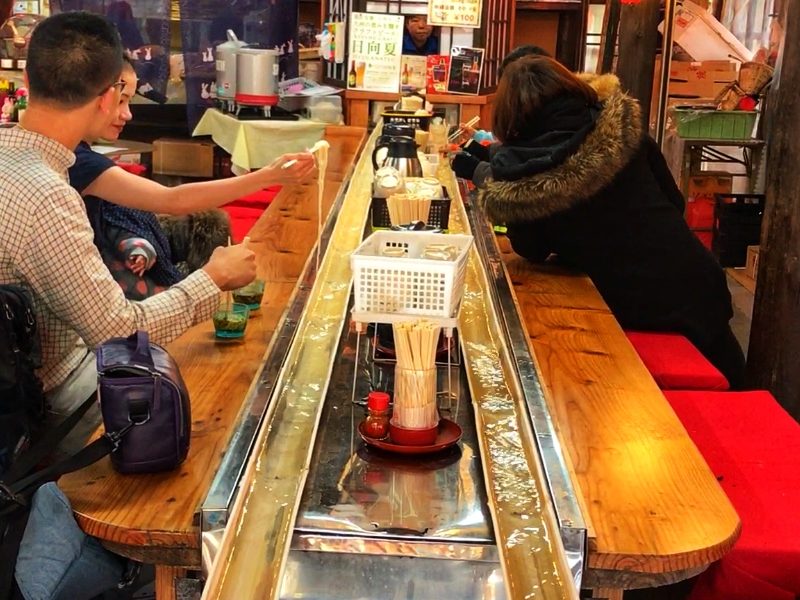
Next is chilled noodles via flowing cold water after we have the fire ramen in Japan food guide. The Nagashi Somen (そめん流し), also called flowing bamboo noodles, is a thin white noodle flowing down from a sliced bamboo pipe filled with cold water. You have to catch the flowing somen when it is released if you want to eat it. After you successfully catch the somen, dip it in a special dipping sauce, called Tsuyu, and slurp the delicious noodles!
You can have Nagashi Somen in Tokyo and Kyoto, normally served in the summer. While we ate this special Japanese food in Takachiho Gorge, Miyazaki. Chiho no Ie Teahouse (千穂の家) served this signature local specialties all year round since the 1950s.
RICE DISHES
The Best Rice Dishes in Japan :
Kaisendon | 海鮮丼
Unagi | うなぎ, kamameshi | 釜飯.
Kaisendon is a combination of the words ‘seafood’ (kaisen 海鮮)and ‘rice bowl’ (donburi 丼). It is a type of seafood rice bowl that consists of white rice and raw sashimi, such as prawns, octopus, squid, salmon, white fish, crab meat, egg, and sea urchin roes.
Often served with a traditional set menu with miso soup, pickled vegetables, chawanmushi (steamed egg custard with vegetables/seafood/meat), and some side dishes. It is very similar to sushi, but instead, served in a bowl of normal rice with marvelous seafood on top.
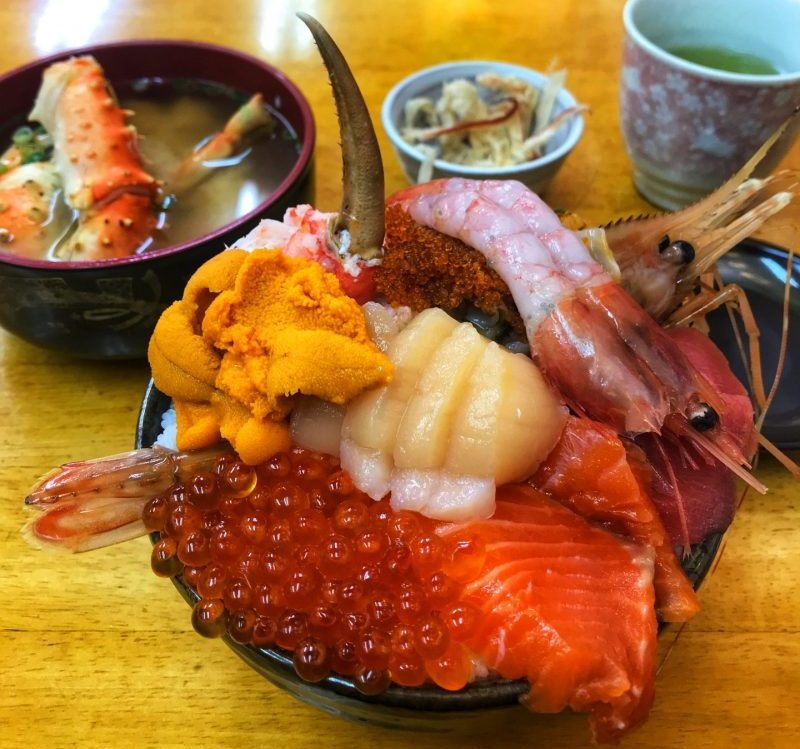
The most important factor to get the best kaisendon in Japan is the freshness of seafood on top of the rice. Kaisendon can be easily found in restaurants or best at a food market that offers fresh seafood directly from the port.
Hokkaido is the best place for kaisendon with a freshness guarantee. We had an amazing seafood food trip in Hokkaido and had the overflowing bowl of kaisendon at Otaru, Hokkaido. For the seafood lover, you should make your trip to Hokkaido!
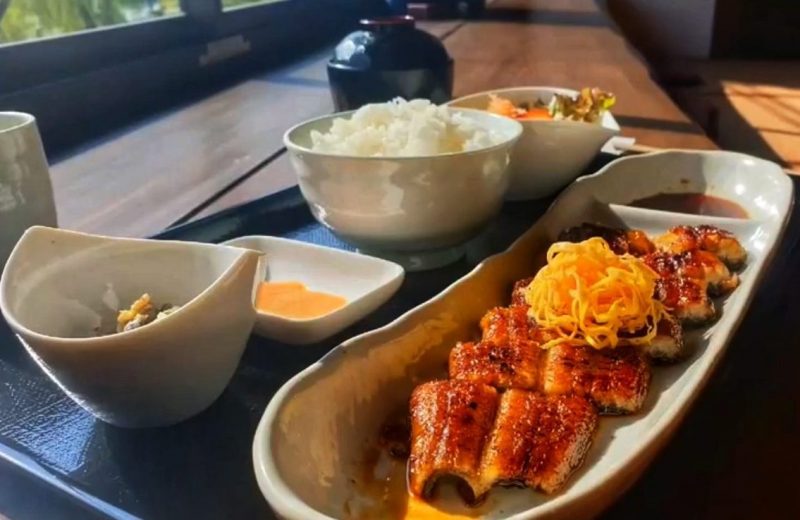
Not to be confused with anago (saltwater eel), Japan’s unagi (うなぎ) is a freshwater eel with a rich, fatty flavor that lends itself well to grilling.
Unagi can be prepared in a variety of ways, and the most common is in kabayaki style. To prepare for this, the eel is cut open with its head and bone is removed. Next, the fillets are skewered and slowly grilled over the charcoal with kabayaki sauce (savory-sweet sauce). The smokey and savory-sweet unagi is something you need to have when you visit Japan.
The flavorful unagi is widely used in sushi dishes, especially nigiri sushi, where a thin piece of grilled eel is served on top of sushi rice. You can also see the unagi served in Unaju (grilled eel fillets served with cooked rice in a rectangular, lacquered box), Unadon (grilled eel fillets served in a bowl of rice), or as a main dish in a rice set. Not to mention the Hitsumabushi that I am going to introduce in this Japan Food Guide.
Hitsumabushi
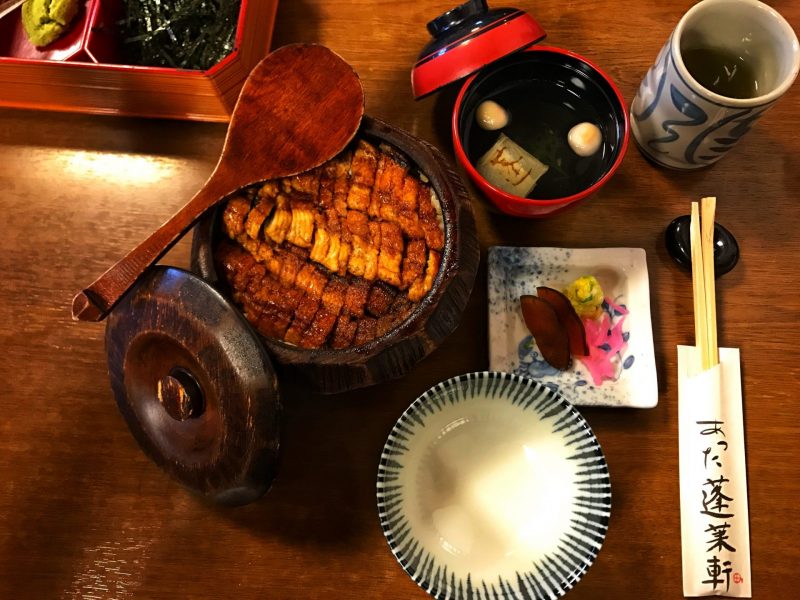
One of the best ways to enjoy unagi is Hitsumabushi (ひつまぶし) . It is a Nagoya specialty where grilled unagi are served over rice that is eaten in four steps.
Unagi is served in an individual bowl with wooden tubs over rice, together with dashi and yakumi (condiments) such as spring onion, wasabi, and seaweed. Firstly, divided the Hitsumabushi into four portions and then eaten in four different ways. The first portion is eaten straight with rice, the second with rice and condiments, and the third with broth, tea, or dashi to make chazuke. While the last portion is based on your liking from the above three ways. It is fun to enjoy the unagi in various ways while each style gives you a different impression of this Japanese popular dish.
We visited Atsuta Houraiken for its superb and succulent Hitsumabushi in Nagoya. Read my food review here: Hitsumabushi Atsuta Houraiken – Nagoya Must Eat Food . Don’t forget to mark this Japan wonderful dish in your version of the Japan Food Guide.
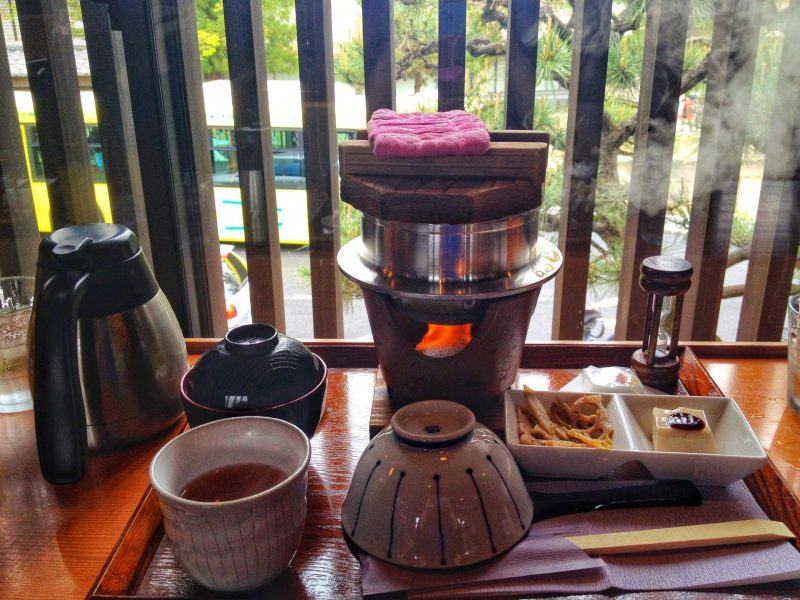
Kamameshi (釜飯), literally translates to “kettle rice”, is a traditional Japanese rice dish made with seasonal fresh ingredients, such as chicken, seafood, and vegetables with rice, boiled in an iron pot called a kama. All the ingredients will be simmered and cooked together under pressure.
As the rice stream in the kama, allowing the fragrance of the added ingredients to infuse with the rice. The rice will soak up the great flavors and was subtle yet delicious.
Apparently, Nara is one of the popular places to try the Kamameshi in Japan. Many restaurants in Nara will be serving these popular dishes and Shizuka (志津香) is specialized in Kamameshi for more than 50 years.
Japanese Curry Rice
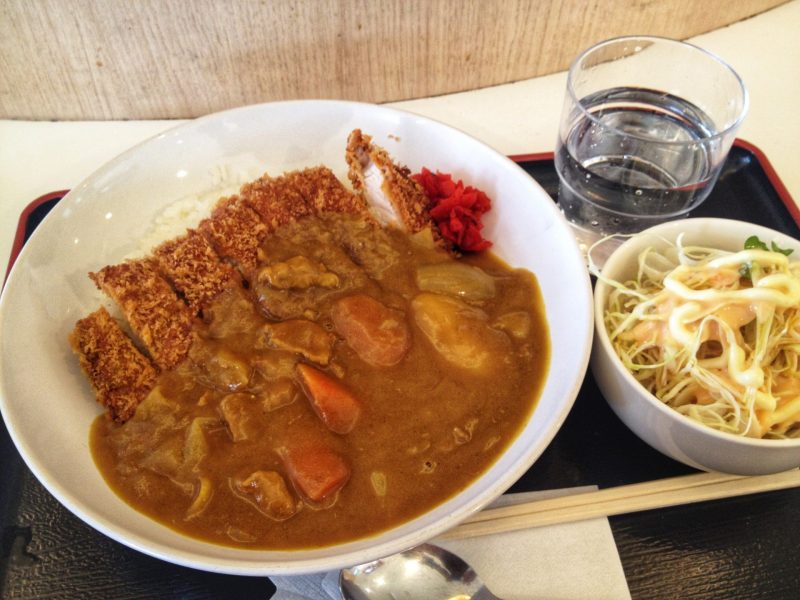
Japanese curry rice is an inexpensive Japanese dish that can easily be found throughout Japan and is widely available at supermarkets and restaurants. Unlike the curry you taste in India or Southeast Asia, Japanese curry is usually sweet, in a thick, sumptuous, and umami brown sauce without fiery burst. Even children can enjoy it thoroughly!
The ingredients for Japanese curry are a variety of meats (chicken, pork, or beef), vegetables (onions, carrots, and sweet potatoes), and mild spices. The katsu curry (deep-fried breaded cutlet with curry) rice as per the picture above is also very popular in Japan.
MIX INGREDIENT/OTHER
Thes best Mix Ingredient / Other dishes in Japan :
Tempura | 天ぷら
Okonomiyaki | お好み焼き.
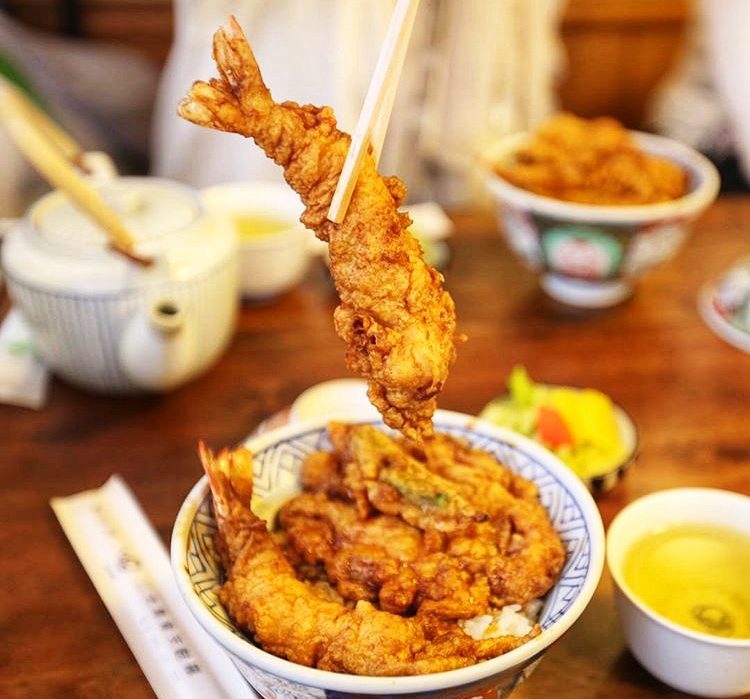
Next on the Japan Food Guide is tempura (天ぷら), one of the most popular Japanese dishes in Japan. It’s a simple dish that consists of battered and deep-fried seafood and vegetables, served with a special dipping sauce called Tentsuyu. The batter is lightly mixed and lighter than the common batter used for fried fish and chicken.
Different types of seafood and vegetables are used in tempura though Ebi (shrimp) is the most popular variety of tempura pieces. It can be served as an appetizer, side dish, or as a topping for Tendon rice bowls, soba, and udon noodles.
The picture above is one of the tendons (tempura rice bowl) that we ate during our visit to Asakusa, Tokyo. The Daikokuya Asakusa served tendon at the beginning of the Meiji period and is still open today. It is famous for its soft and soggy tempura dipped in its secret black sweet sauce. We love the crispy, fried pieces of tempura but the soft tempura tastes slightly different yet still delicious.
Okonomiyaki is a Japanese savory pancake made with a batter of flour, eggs, and cabbage, and mixed with a variety of ingredients ordered. The common ingredients are meat (thinly cut pork belly or bacon), octopus, squid, shrimp, vegetables, green onion, or cheese. The batter is then pan-fried on a hot griddle at the restaurant, sometimes on a hot griddle right before you, topped with sweet and savory okonomiyaki sauce, Japanese mayo, dried seaweed, and bonito flakes before served.
Okonomiyaki is available all over Japan, most closely associated with Osaka and Hiroshima. The Kansai-stye (also called Osaka-style) Okonomiyaki is prepared with fillings mixed into the batter before being cooked on the grill. While the Hiroshima style is cooked layer-by-layer, rather than mixed.
Osaka-Style Okonomiyaki
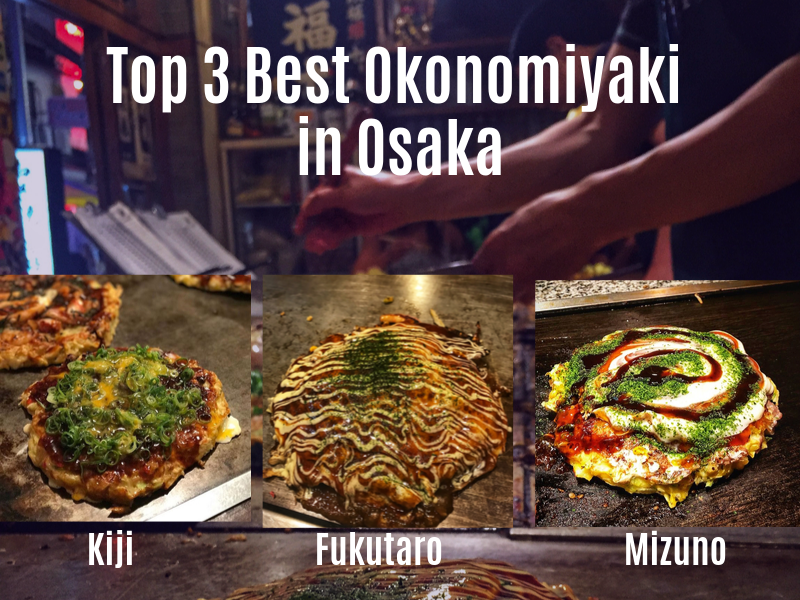
Similar to takoyaki, okonomiyaki is another Osaka’s must-eat food. I am a big fan of okonomiyaki and tried a number of different okonomiyaki in Osaka, Japan. My personal favorite was Kiji (きじ 本店) , but the waiting time was extremely long for this Japan’s best food. Overall, a very good okonomiyaki restaurant in Japan with delicious food.
Read on our food blog on the top 3 best okonomiyaki in Osaka . We have listed our dining experiences at Kiji, Fukutaro, and Mizuno. The best and quick way if you are looking for where to eat okonomiyaki in Osaka.
HOT POT DISHES
The Best Hot Pot Dishes in Japan:
Hot Pot (Nabe) | 鍋
Motsunabe | もつ鍋.
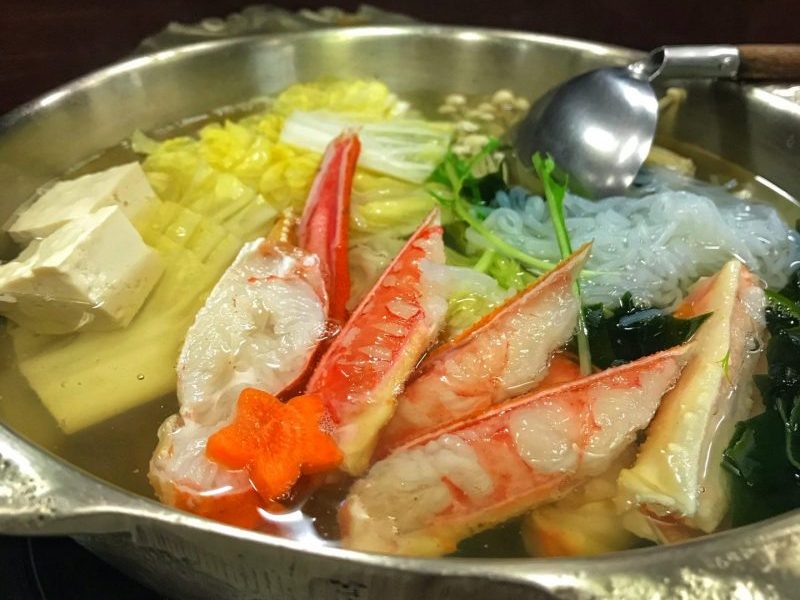
Nabe (鍋) is a term for Japanese hot pot dishes and is widely consumed across Japan. Basically, you cook your food at the table in a large heated pot with boiling water or soup base. Common ingredients found in nabe include vegetables, tofu, mushrooms, meat, and seafood. While the soup base is either flavorful broth or a simple and light broth to cook for the ingredients.
It is popularly eaten at home and served in Japanese restaurants or as part of a ryokan dinner. Wintertime is the best time to eat the piping hot pot dishes in Japan.
Popular types of nabe dishes:
- Yose-nabe – Most common and most basic type of hot pot dishes where vegetables, mushrooms, meat, and seafood are cooked in a pot of flavorful broth.
- Sukiyaki – Hot pot dish featuring thinly sliced beef or pork with vegetables in a mix of soy sauce, mirin, sugar, and water.
- Shabu-Shabu – Hot pot dish that features thin slices of meat that are swished in the hot pot to cook just before eating. Gentle take piece by piece of sliced meat and dipped it around in the broth until the perfect time to eat it. The broth is often very lightly flavored.
- Motsu-nabe – Hot pot dish containing pork or beef offal, vegetables, and chili peppers in a broth (soy sauce or miso).
The nabe dishes can be found all across Japan, and each region has its own local specialties.
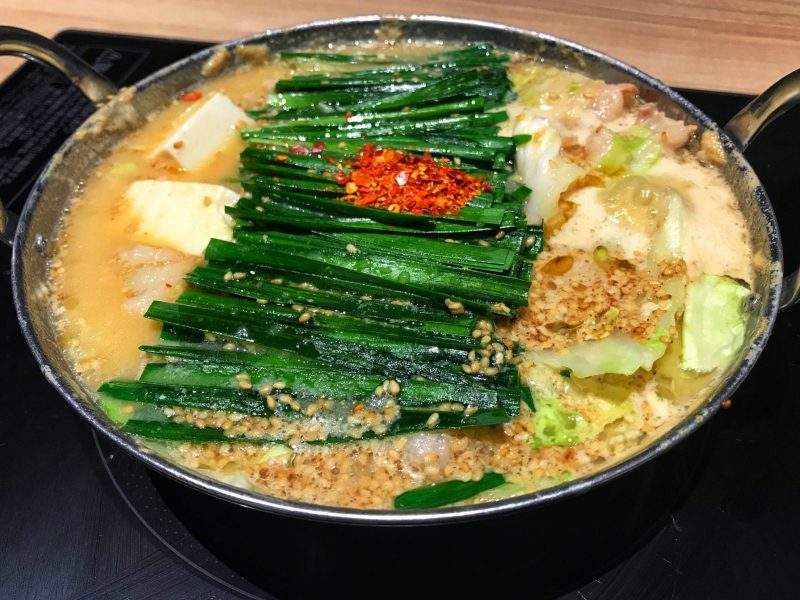
If you do not mind innards, then you’re going to love this hot pot dish. The flavorful motsunabe (もつ鍋) is a hot pot dish typically made up of beef or pork tripe, cabbage, garlic, chives, and togarashi peppers in a salt, soy sauce, or miso-based soup. It is the Fukuoka specialty and has become one of the must-eat food when visiting there.
The flavorful stew is slowly simmered with the ingredients such as leek, chives, cabbage and beautifully seasoned with garlic and chili pepper at the table on portable burners in front of you. Paired with rice or champion noodles with leftovers as a perfect ending. One of the best food in Fukuoka, Japan.
I am falling in love with motsunabe since my first try in Fukuoka. I’ve tried the motsunabe from Hakata Motsunabe Ooyama and went for another round at Hakata Showraku . Truly addictive to this Japan’s hot pot dish.
MEAT / POULTRY
The Best Meat / Poultry Dishes in Japan :
Yakitori | 焼き鳥
Yakiniku | 焼肉, tonkatsu | とんかつ, jingisukan | ジンギスカン.
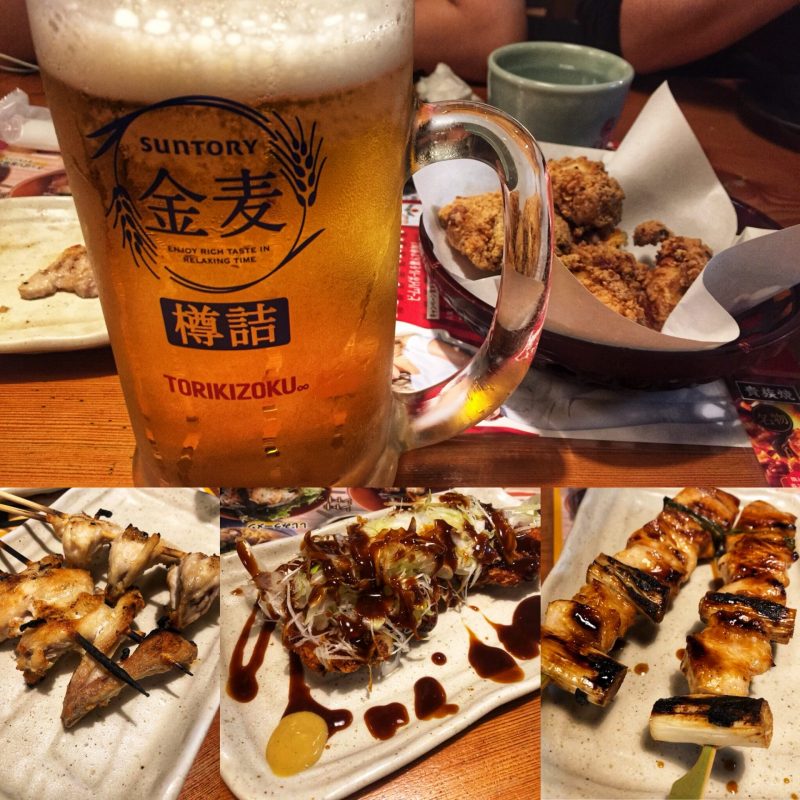
Yakitori (焼き鳥) is the Japanese version of chicken skewers. The bite-sized pieces of meat from all different parts of the chicken, such as the breasts, thighs, skin, liver, and other innards, are skewed and grilled over charcoal. The yakitori was just for chicken, but nowadays it can also see skewers made using pork, beef, and seafood.
Yakitori is popular Japanese street food and is widely served across Japan, commonly found at Yakitori-ya (shops that specialize in yakitori), izakaya (Japanese pub), festival food stands, and alleyways adjacent to large stations near business districts.
The inexpensive dishes are always best with a glass of beer and cheer with friends.
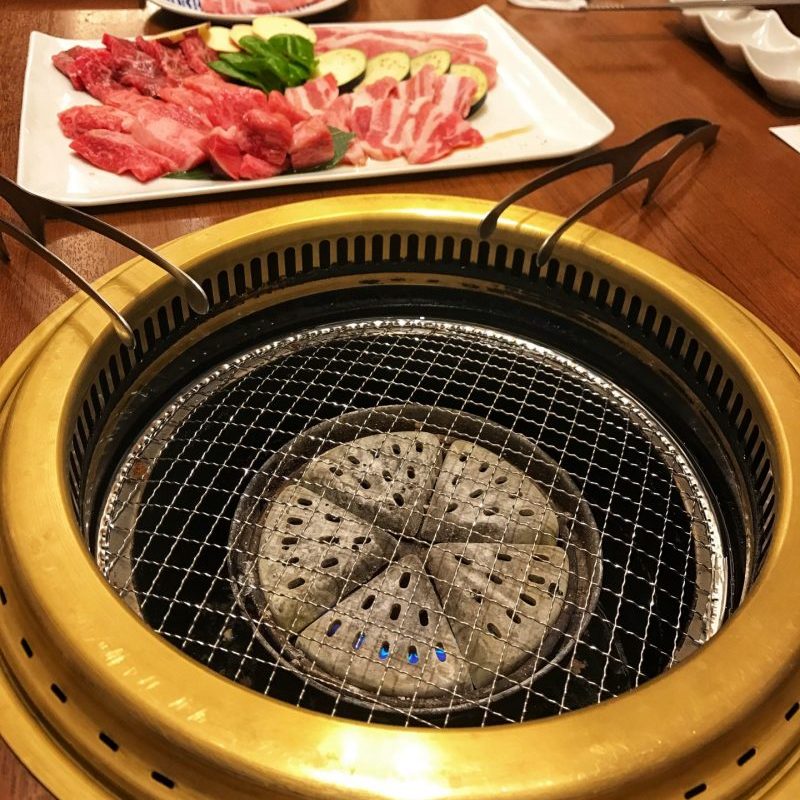
Literally, Yakiniku (焼肉) means “grilled meat”. Technically, yakiniku isn’t a dish but a Japanese style of barbecue since ingredients are commonly cooked over an open flame at your table. T he meat, normally beef, chicken, and, pork, are sliced into bite-sized pieces, grilled over charcoal, and often served with just a few light seasonings like high-quality salt, sesame oil, or shoyu.
In Yakiniku restaurants, servants will bring raw meats and vegetables to your table so you can cook them yourself on tabletop grills. For a more expensive and premium option, you can visit a restaurant that offers prime beef cuts such as Kobe beef.
We enjoyed our yakiniku dinner at in Ajikura Tengoku (味蔵天国) in Takayama. This restaurant is specialized and served Hida beef in Yakiniku style. The meat is so flavorful and juicy, without adding any seasoning. It’s another fun Japanese dining experience that you should try on your Japan trip.
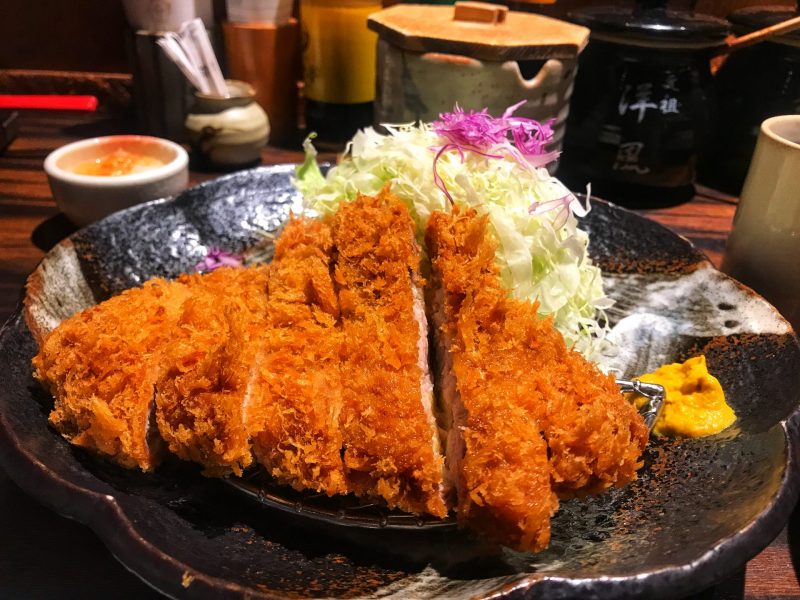
Not to be confused with tonkotsu (pork broth ramen), tonkatsu is a breaded, deep-fried pork cutlet dish. The 2-3 cm slice of pork loin or tenderloin coated with panko bread crumbs and deep-fried in oil. It is traditionally served with shredded cabbage, rice, miso soup, and pickles.
Tonkatsu is one of the most popular katsu dishes, and you may also see other variations made of chicken (chikinkatsu), beef (gyukatsu), and ground meat (menchikatsu). Besides, you will find variations of tonkatsu throughout Japan, including in convenient stores. Enjoy the tonkatsu pieces in Katsudon (katsu ricebowl), Katsu Kare (katsu curry), or Katsu Sando (katsu sandwich).
In short, tonkatsu is always one of the best food for the family with kids listed in the Japan Food Guide!
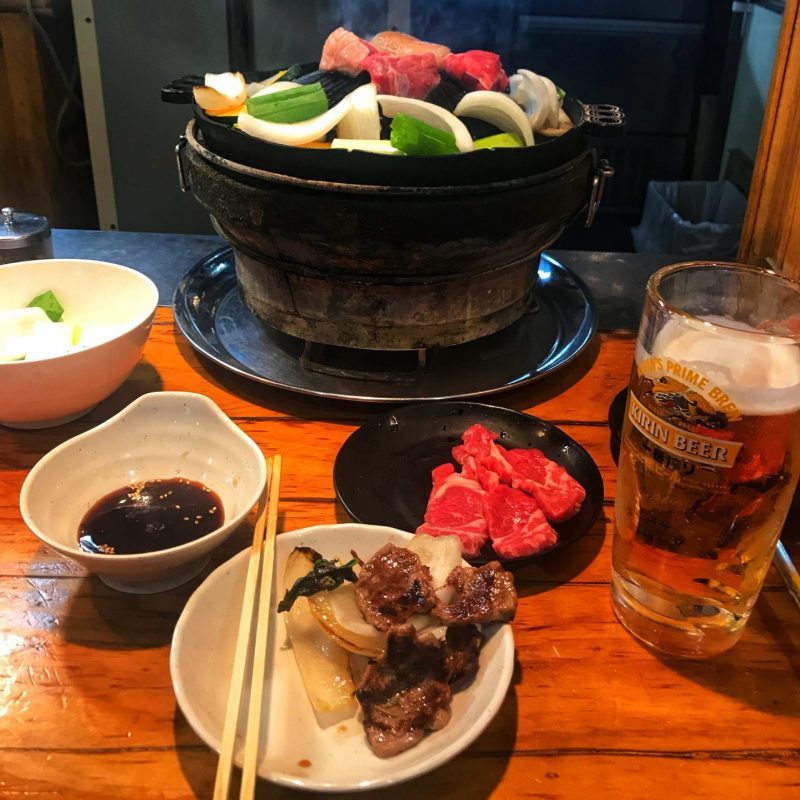
If you’ve been to Hokkaido, then you may recognize Jingisukan. This regional dish is very popular in Hokkaido, with mutton or lamb and vegetables sizzled to perfection on a Hokkaido’s style of yakiniku. Rather than being grilled on an open flame, like yakiniku, this Japanese barbecue grill is on a uniquely shaped hot iron plate.
The name Jingisukan comes from the famous Mongolian warrior name, “Genghis Khan” and the unique convex-shaped grill is evokes the image of a warrior’s helmet. Although I am not a fan of lamb dishes, we really love the Gingisukan. The lamb was so juicy and we even went back for the second time for it.
POPULAR JAPAN SEAFOOD
Popular Japan Seafood (served in sashimi, or together with rice) :
Sea Urchin | Uni
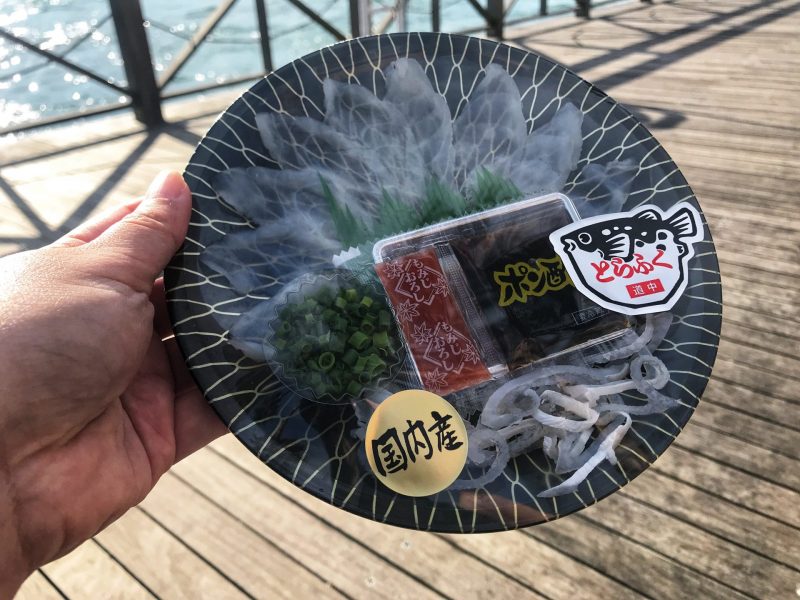
You’ve probably heard about the fearsome reputation of this Japanese delicacy, fugu, or pufferfish. It is considered to be one of the world’s most dangerous foods and highly toxic by containing a powerful neurotoxin about 1,200 times stronger than cyanide. But don’t worry too much about trying the fugu in Japan. Only licensed chefs with a minimum of ten years of apprenticeship can legally prepare this dish.
Fugu can be prepared in many ways, most commonly sliced paper-thinly in intricate patterns to resemble chrysanthemum blossoms and eaten raw as sashimi or eaten in the hot pot dish known as fugu chirinabe. Every year, thousands of tons of fugu are eaten.
It is an expensive dish to be eaten on special occasions and you can try it in fugu specialty restaurants. But for the best fugu in Japan, consider eating it when you are visiting Kyushu and Yamaguchi. The Shimonoseki in Yamaguchi is the largest harvester of pufferfish. We tried the fugu sashimi and fugu soup in Karato Market when making a food trip there.
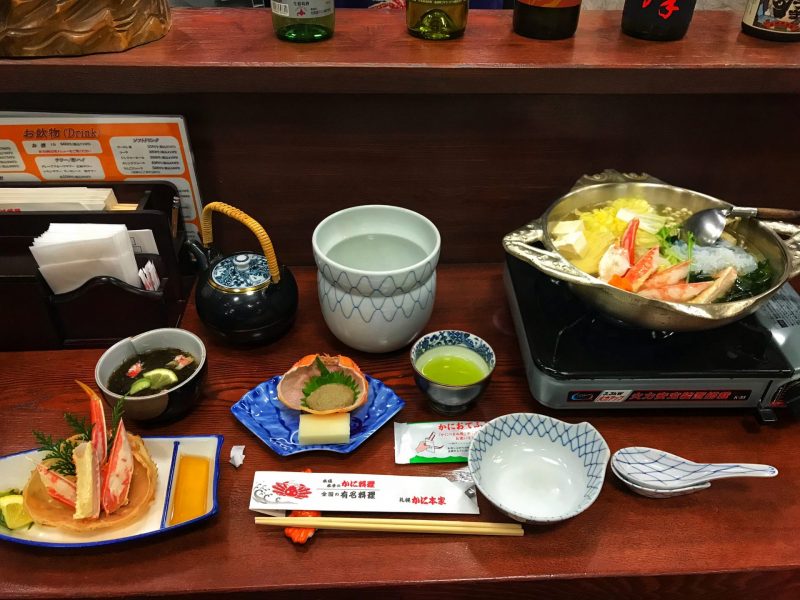
Japan is a paradise for crab lovers and its consumption ranks among the highest in the world. Different types of crab have their delicious flavor, with plenty of ways to serve them. From simply boiled, grilled, rice bowl, or well prepared into a crab course meal. It is one of the most popular seasonal winter foods and you can find crab throughout the country.
The northern regions such as Hokkaido is the best place for crab, where the waters are cooler and perfect to capture it. You can enjoy some delicious Hokkaido Crabs such as snow crab, king crab, and hairy crab when visiting there. We visited Hokkaido and particularly drowned in these amazing dishes. We ate the tasty Hokkaido crab in sashimi, simply boiled, grilled, Teppo-jiru or Kani-jiru (Crab Leg Miso Soup), seafood kaisendon, and even pay for an expensive kaiseiki crab meal. When you travel to Hokkaido make sure you treat yourself to some delicious crab.
Even if you’re not making a trip to Hokkaido, you can also taste the Hokkaido crab in crab specialties restaurants in Japan. The Sapporo Kanihonke is a famous traditional crab-specialized restaurant founded in 1971 in Sapporo and widely spread around the country.
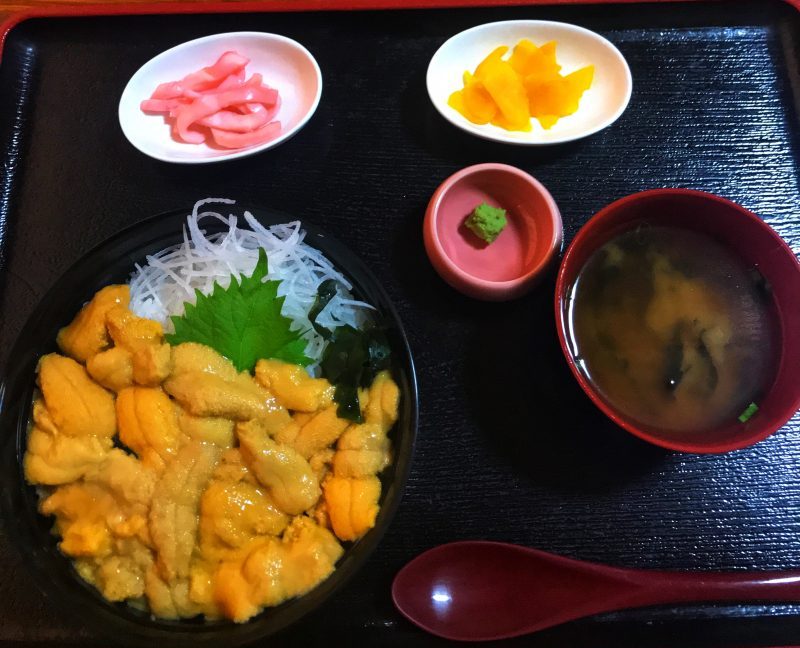
Sea urchins or Uni is a Japanese delicacy that is really gaining popularity in Japan. It is nutritious, sweet and they melt in your mouth the moment you bite into them. The sea taste and the creamy texture of uni are quite similar to that of salmon roe but uni has more unmistakable deep savory umami.
Sea urchin is served as sashimi, topping for nigiri sushi, type of seafood in kaisendon, or stand alone as sea urchin rice bowl (Murasaki uni). It is not cheap and the price can be very expensive depending on the quality grade. Food markets such as the famous Tsukiji Fish Market of Tokyo, Kanazawa Omicho Market, Osaka Kuromon market, and seafood restaurants can find fresh sea urchins.
Pictured above is the freshness and generous amount of sea urchins on Murasaki uni at the Naramuraya in Shakotan, Hokkaido. Besides, we always love to sample the sea urchins whenever in Japan’s food market. If you like fish roe, you will likely like uni! You should definitely try it if you have the chance.
JAPANESE SNACK / DESSERT / DRINK
The Best Japanese Snack / Dessert / Drink in Japan :
Takoyaki | たこ焼き
Korokke | コロッケ.
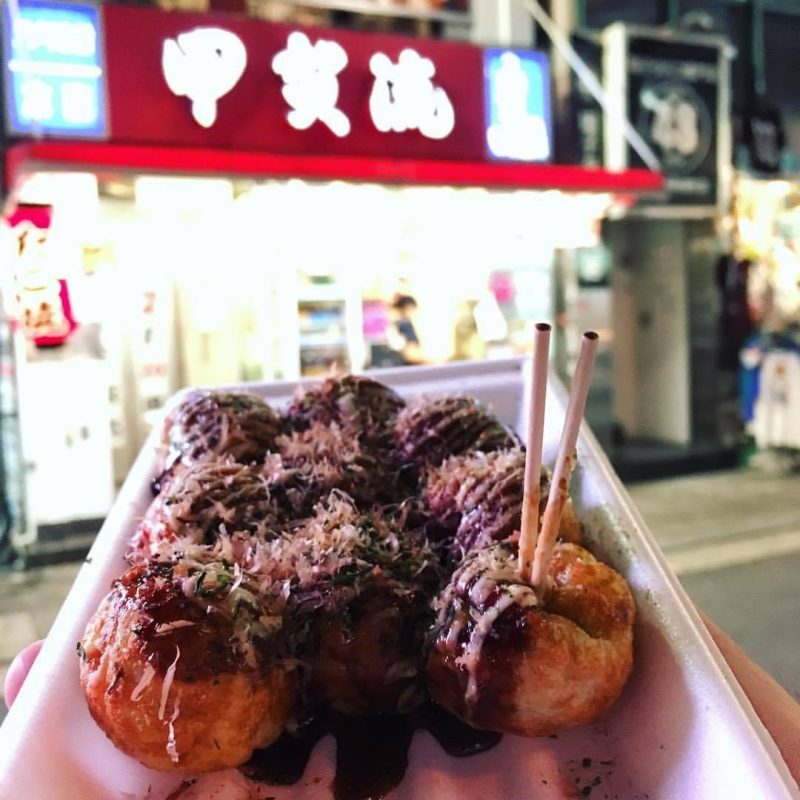
Another must-eat food in Japan Food Guide. Almost a synonym of Osaka, Takoyaki (literally translates to grilled octopus) is refer to a ball-shaped wheat flour-based snack filled with octopus chunks, tempura scraps, pickled ginger, and green onion. It’s usually topped with a sweet and savory takoyaki sauce, Japanese mayo, and bonito flakes. Be careful not to eat them right away as it extremely HOT!
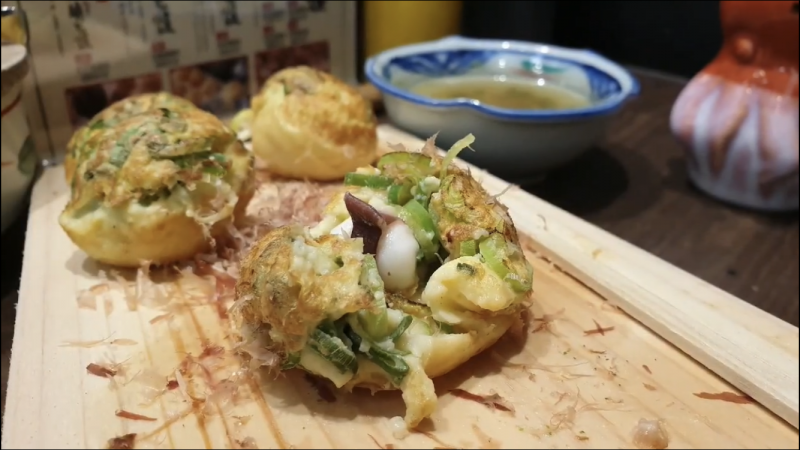
The nice golden brown takoyaki is commonly eaten as a snack and is typically sold at specialized stands or small restaurants. The best takoyaki in Japan you can have, of course, is in Osaka.
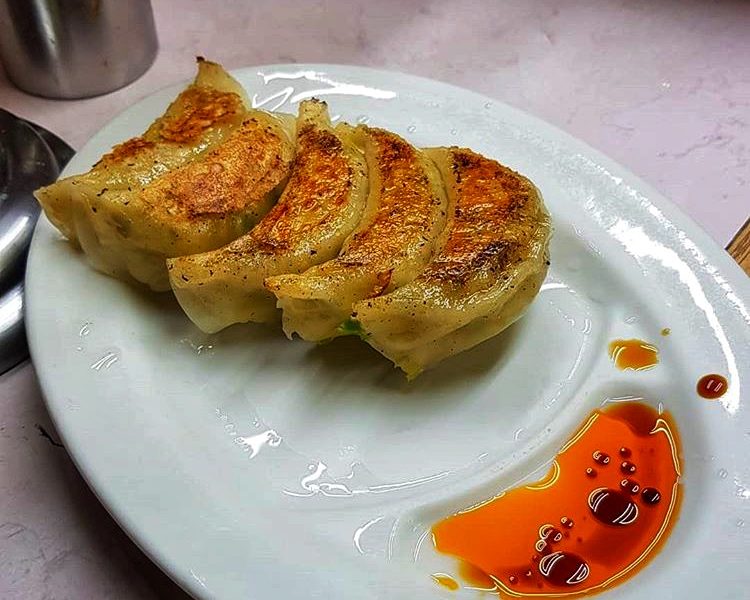
Next on Japan Food Guide is Gyoza (餃子), Japan’s version of the dumpling. Origin from China, Gyoza has become one of the popular dishes in Japan. The Japanese dumplings are filled with ground meat and vegetables and wrapped in a thin dough. Fillings usually include chives, thin slices of cabbage, mushrooms, and finely minced pork or chicken.
Gyoza may come in three different types: Yaki gyoza (fried), Sui gyoza (boiled), and Age gyoza (deep-fried). The Yaki gyoza is by far the most common type of gyoza. Usually eaten with a dipping sauce made of soy sauce and vinegar, with a bit of chili oil (rayu) added.
You can enjoy the gyoza on their own or as a side to more substantial dishes like ramen.
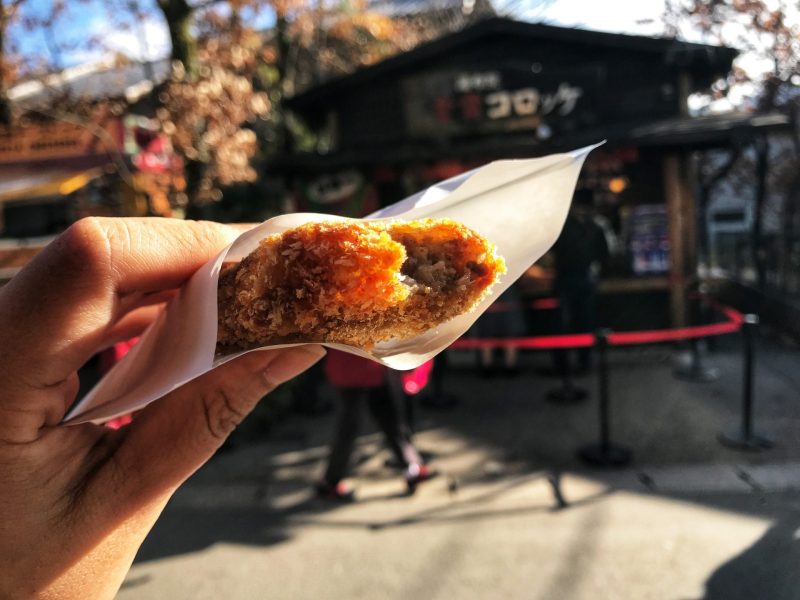
Korokke is the Japanese version of croquette, consisting of breaded, deep-fried ground meat, seafood, or vegetable patties mixed with mashed potato or white sauce. It is available at some restaurants as part of a set meal or as a side dish. Besides, korokke can also be bought at supermarkets, or wrapped in paper at convenience stores, or street vendors.
We always love to have these delicious hot and crispy korokke croquettes for a snack when strolling along with the food market.
End of My Japan Food Guide?
Definitely not! We have been to Japan many times but there is still various Japanese food that we haven’t tasted. Besides, I am still a long way from updating my complete Japan travel guide as it only partly covers all the delicious food that we tried during our trip to Japan. While I am only a traveler who loves to explore Japanese dishes whenever we went to Japan. Let me know if any information is incorrect or if any best food is recommended.
Lastly, we hope you enjoyed this tasty Japan Food Guide post gives you some great ideas about all the delicious food available, and the best restaurants to try in Japan. Enjoy your food trip to Japan!
Regional Japan Food Guide
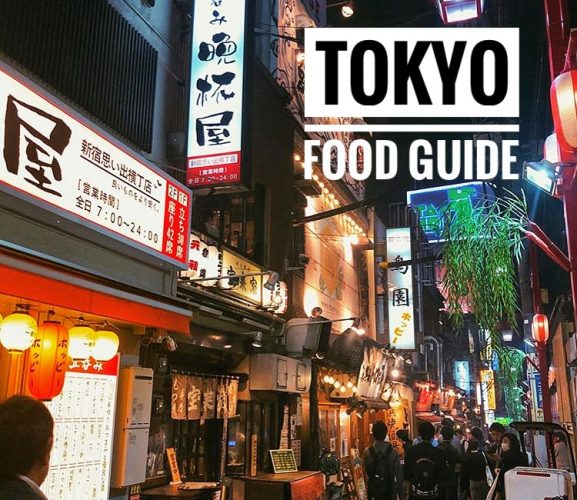
Kanto Region Food Guide :
Tokyo Food Blog : Tokyo Food Guide: What and Where to Eat in Tokyo
- Mutekiya Ramen Ikebukuro: Must Eat Tokyo Best Ramen
- Ichiran Ramen Ueno: Best Ramen Shop in Ueno Tokyo
- Daikokuya Tempura: Asakusa Must Eat Food
- Chuka Soba Tomita Ramen: Tokyo Best Tsukemen
- Ichifuku Shibuya: A Taste of Tokyo Michelin Miso Ramen
- Udon Shin Tokyo: Delicious Freshly Handmade Udon
Kansai Region Food Guide :
Kyoto Food Blog : Top 7 Must Eat Food in Kyoto
- Menbakaichidai Kyoto Fire Ramen
- AWOMB Kyoto: An Unique Teori Sushi Dining Experience
Osaka food blog : Top 8 Unique Food To Eat in Osaka
- Top three best okonomiyaki in Osaka
- Fukutaro: The Taste of Best Okonomiyaki in Osaka
- What to eat in Kuromon Ichiba Market
- PABLO Dotonbori Osaka: The Best Cheesecake Dessert
Chube Region Food Guide :
Takayama Food Blog : Takayama Food Guide: 10 Must-Try Food in Takayama
- Ajikura Tengoku Food Review: Best Hida Beef in Takayama
- Heianraku Takayama: Fabulous Home Dining Experience
- Takayama Kottegyu Hida Beef Sushi: Melt in Your Mouth
Nagoya Food Blog : Nagoya Food Guide: What To Eat in Nagoya
- Hitsumabushi Atsuta Houraiken: Nagoya Must Eat Food
- Sekai no Yamachan: Nagoya Famous Tebasaki
Other Chubu Region Food Blog :
- Toyama Food Guide: What To Eat in Toyama
- Kanazawa Omicho Market: What To Eat When Visit
- Menya Taiga: Kanazawa Best Miso Ramen
Hokkaido Region Food Blog : Top 10 Must Eat Food in Hokkaido
- Sapporo Food Guide: Where and what to eat in Sapporo
- [Sapporo] Nemuro Hanamaru: Best Kaiten Belt Sushi Restaurant
- [Sapporo] Gotsubo Oyster Bar: Best Cheap Eat in Sapporo
- [Sapporo] Kani Honke Sapporo: Hokkaido Must Eat Crab Restaurant
- [Sapporo] The Best Soup Curry Garaku Food Review
- [Asahikawa] Hokkaido Best Genghis Khan At Jingisukan Daikokuya
- [Asahikawa] The Best Asahikawa Ramen in Baikohken Honten
- [Otaru] Seafood Donburi at Sankaku Market
- [Shakotan] Hokkaido Must Eat: Freshness Sea Urchin From Shakotan
Kyushu Region Food Blog : Kyushu food guide: What To Eat in Kyushu
- Fukuoka Food Guide: Best Must Eat Food in Fukuoka
- Oita Food Guide: What To Eat in Oita, Beppu and Yufuin
- Miyazaki Food Guide: What To Eat in Miyazaki
- Kumamoto Food Guide: What To Eat in Kumamoto
- And more Kyushu region food blog check here.
You Might Interested:
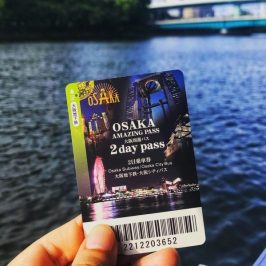
Osaka Amazing Pass Itinerary: A Travel Guide Blog
The best way to visit Osaka with Osaka Amazing Pass! My 2-Days Osaka itinerary include...
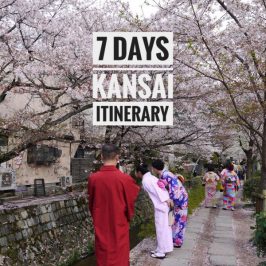
7 Days Kansai Itinerary: A Complete Travel Guide Blog
Last updated on April 21st, 2024 Planning on 7 days Kansai itinerary to Kyoto, Osaka,...
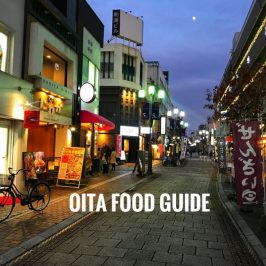
Oita Food Guide: What To Eat in Beppu, Oita
In this Oita food guide, we will introduce the best food to eat in Yufuin,...
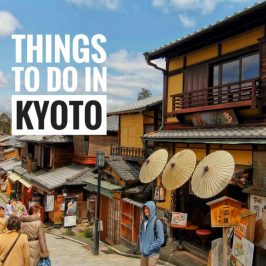
Kyoto Itinerary: A Travel Guide Blog For First-Timers
Looking for things to do in Kyoto for 1 day, 2 days or 3 days?...
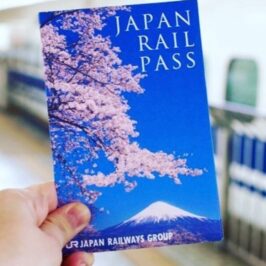
A Guide for Japan Rail JR Pass: Budget + Tips
Here sharing my budget tips using Japan Rail Pass from my previous experience in Japan....
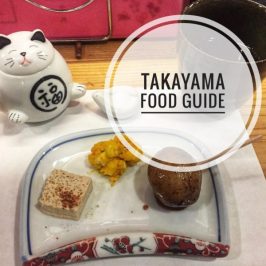
Takayama Food Guide: 10 Must-Try Foods in Takayama
Wondering where to eat in Takayama? We included the top 10 must eat food in...
- Media & Industry
- Meetings & Events
- Select Language 简体中文 繁體中文(香港) 繁體中文(臺灣) India (English) Bahasa Indonesia 한국어 ภาษาไทย Tiếng Việt Singapore (English) Philippines (English) Malaysia (English) Australia/New Zealand (English) Français Deutsch Italiano Español United Kingdom (English) Nordic countries(English) Canada (English) Canada (Français) United States (English) Mexico (español) Português العربية Japan(日本語) Global (English)
- India (English)
- Bahasa Indonesia
- Singapore (English)
- Philippines (English)
- Malaysia (English)
- Australia/New Zealand (English)
- United Kingdom (English)
- Nordic countries(English)
- Canada (English)
- Canada (Français)
- United States (English)
- Mexico (español)
- Global (English)
- Fujiyoshida
- Shimonoseki
- Ishigaki Island
- Miyako Island
- Kerama Island
- Tokyo Island
- Koka & Shigaraki
- Hida Takayama
- Ginza, Nihonbashi
- Beppu & Yufuin (Onsen)
- Ginzan Onsen
- Nagasaki Islands

- Kumano Kodo
- Shikoku Karst
- Amami Oshima
- Hachimantai
- Omihachiman
- Aizuwakamatsu

- Diving in Japan
- Skiing in Japan
- Seasonal Flowers in Japan
- Sustainable Outdoors
- Off the Beaten Track in Japan
- Scenic Spots
- World Heritage
- Home Stays & Farm Stays

- Japanese Gardens
- Japanese Crafts
- Temple Stays
- Heritage Stays
- Festivals and Events
- Theater in Japan
- Japanese Tea Ceremony
- Cultural Experiences in Japan
- Culture in Japan

- Local Cuisine Eastern Japan
- Local Cuisine Western Japan
- Local Street Food
- Japan's Local Ekiben
- Japanese Whisky
- Vegetarian and Vegan Guide
- Sushi in Japan Guide
- Japanese Sake Breweries

- Art Museums
- Architecture
- Performing Arts
- Art Festivals
- Japanese Anime and Comics
- Japanese Ceramics
- Local Crafts

- Scenic Night Views
- Natural Wonders
- Theme Parks
- Samurai & Ninja
- Iconic Architecture

- Wellness Travel in Japan
- Japanese Ryokan Guide
- A Guide to Stargazing in Japan
- Relaxation in Japan
- Forest Bathing (Shinrin-yoku)

Experiences in Japan
- Enjoy my Japan
- National Parks
Japan's Local Treasures
- Japan Heritage
- Snow Like No Other
- Wonder Around Japan

Visa Information
- Getting to Japan
Airport Access
- COVID-19: Practical Information for Traveling to Japan
- Anime Tourism
- Countryside Stays
- Accessible Tourism
- Hokkaido Great Outdoors
- Scenic World Heritage in Tohoku
- Shikoku’s Nature and Traditions
- Southern Kyushu by Rail

- Traveling by Rail
- How to Travel by Train and Bus
- JR Rail Passes
- Scenic Railways
- Renting a Car
- Sustainable Travel in Japan
- Travel Brochures
- Useful Apps
- Online Reservation Sites
- Eco-friendly Accommodation
- Luxury Accommodations
- Traveling With a Disability
- Hands-free Travel
- How to Book a Certified Tour Guide
- Volunteer Guides
- Tourist Information Center

- Japanese Manners
- Spring in Japan
- Summer in Japan
- Autumn in Japan
- Winter in Japan
- Cherry Blossom Forecast
- Autumn Leaves Forecast

- Japan Visitor Hotline
- Travel Insurance in Japan
- Japan Safe Travel Information
- Accessibility in Japan
- Vegetarian Guide
- Muslim Travelers
- Safety Tips

- JAPAN Monthly Web Magazine
- Arts & Cultures
- Nature & Outdoor
- Festivals & Events
- Insider Blog
- Things to do
- Local Guides
- Food & drink
- Traditional
- Hokuriku Shinetsu

My Favorites
${v.desc | trunc(25)}
Planning a Trip to Japan?
Share your travel photos with us by hashtagging your images with #visitjapanjp
Travel Japan - The Official Japan Guide
Spring in Japan: Cherry Blossom Forecast 2024
Where & when to enjoy sakura in Japan
Go Beyond Japan’s Major Cities: Hokuriku Shinkansen Extension in 2024
Sakura and Beyond: Famous Japanese Flowers to Check Out in 2024
Explore Royal Artwork at The Museum of the Imperial Collections, Sannomaru Shozokan
Guiding your trip to new adventures in Japan
WONDER AROUND JAPAN
Photo Credit : Guided Cycling Tour Biei
Live to Travel, Travel to Live
Discover how all of Japan is getting behind Expo 2025, coming to Osaka in Japan’s Kansai region
An epic eating adventure.
Memories in the Making
Welcome to the official tourism website of Japan
Unforgettable experiences and breathtaking moments, finding the hidden gems.
Stories & Guides
Explore Japan's vast cultural, eating, drinking, and shopping scenes
Things to Feel
Discover the full range of amazing things to feel across Japan
Tohoku Colors
Experience the seasonal and cultural beauty of northeastern Japan
Top recommendations.
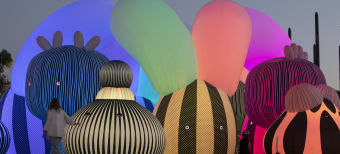
All Eyes On
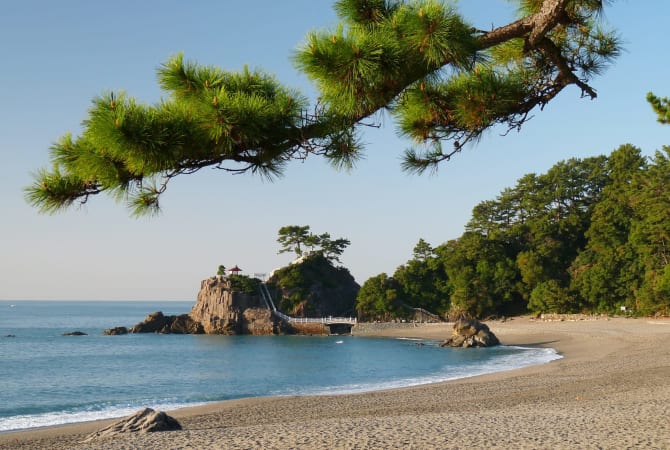
Travel Highlights
Popular places.
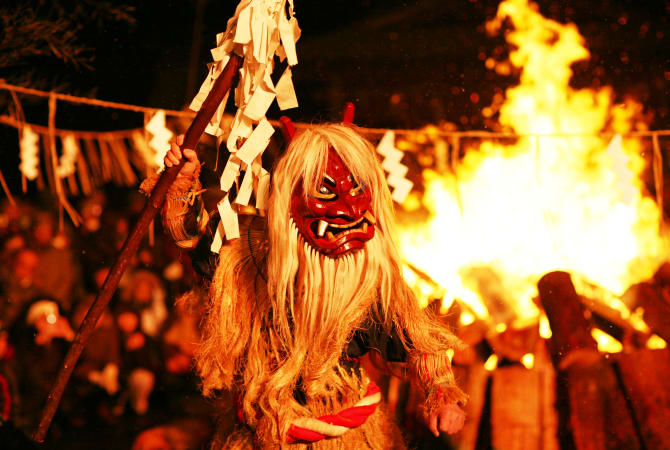
Explore by Interest
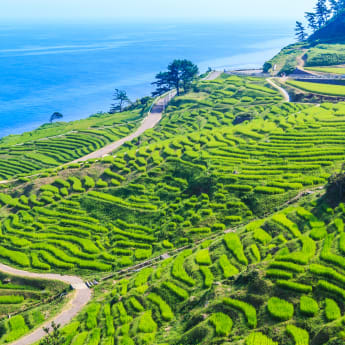
Important Notice

News from JNTO & Our Partners

Inspiring Articles
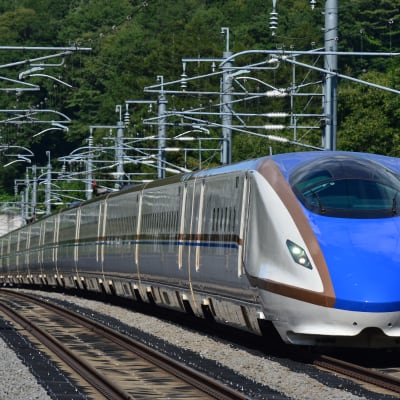
Food features
For First-Time Visitors
- Wi-Fi & Connectivity
- Weather & Geography
- IC Travel Cards
Where to Stay
- Luxury Stay
- Haneda Airport
- Narita Airport
- Osaka (KIX)
- Fukuoka Airport
Getting Around
- Shinkansen (Bullet Train)
- Luggage & Storage
Suggested Walks & Tours
- Tokyo 48 Hours
- Golden Route
- 2 Weeks in Japan
- Tour & Activities
Brochure Download
- Tours and Activities
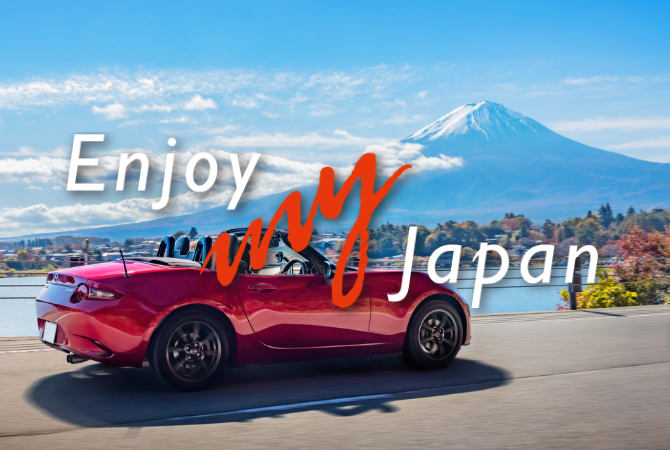
Japanese Government Information
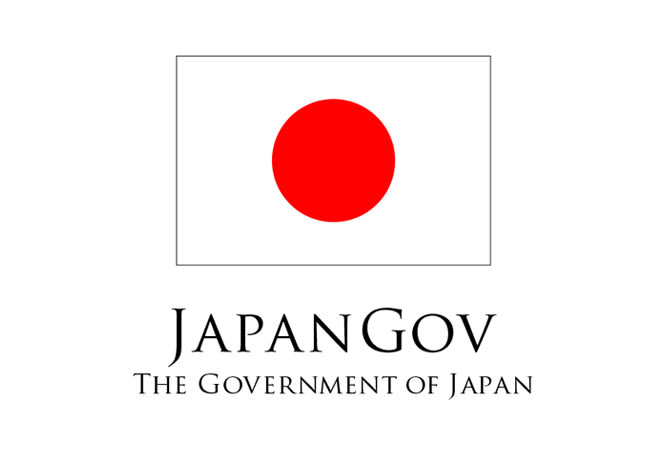
Please Choose Your Language
Browse the JNTO site in one of multiple languages

About Japanese Food Guide
Hi and welcome to Japanese Food Guide, a Japan-focused travel publication with an all-female team dedicated to providing a new kind of content on a much-loved destination. We stand for:
- Improving the standing of women in the travel sector by only hiring female-identifying writers, photographers and niche experts.
- Giving a platform for women in Japan whose educated voices are grossly lacking in high-ranking English-language Japan-focused content.
- Stemming misinformation by only hiring informed contributors with extensive lived experience in-country.
- Changing the blanket “weird and wacky Japan” rhetoric that often accompanies Japan travel content by providing insightful information in the fields of culture, history, linguistics and science.
- Supporting women’s professional and personal endeavors by always being paid for work and on time, receiving due credit for contributions via a clear byline and attribution of work, and providing opportunities for mentorship, skill development and their work to be discovered.

Table of Contents
Who are the contributors to Japanese Food Guide?
Japanese Food Guide was founded by travel content creator and Japan expert Jessica Korteman in June 2021 to make positive change in the areas of gender parity and Japan-focused English-language content. Jessica only hires women contributors, a deliberate move by Jessica to change the face of an industry that often undervalues and underpays the contributions of women, and in the short time that the publication has been live has expanded to a team of fifteen.
“The team is made up of a group of incredibly talented women writers who have extensive lived experience in Japan. They have the language and cultural skills, and access to information, that allows us to produce content that you won’t find anywhere else. That’s where the website’s tagline – ‘The Informed Guide to Japanese Food & Drink’ – comes from,” says Jessica.
“After living and working in Japan for a decade, and returning to Melbourne in 2019, I knew there was so much more that wasn’t being told about Japan’s history and culture around food, particularly in English publications, and that I was in a unique position to curate that content.
“I also knew from my own first-hand experiences that so many women with extensive experience in-country were being sidelined or not even considered at all in favor of bringing in bloggers and writers from abroad and getting them to feature destinations after a whirlwind tour that often only lasted days, or a week or two.
“There is certainly value in all kinds of content, including those that document arriving in a country for the first time and the myriad of things that surprise, delight and confuse. But when these experiences are misunderstood, which is common in Japan due to its unique language and culture, and then presented as fact in “Ultimate Guides” on large sites, we start to see the same misinformation appearing all over the place.
“This is not to mention the huge amount of women’s expertise that is being missed by only hiring professional writers. I’m deliberately building a team of women who are in-the-know, regardless of their experience in content creation. These are women who have incredible insight into some of the most unique aspects of Japan’s culinary culture, but who may not have ever considered themselves writers, photographers or content creators.
“A big part of my vision for Japanese Food Guide is to give a platform to those who might not usually have one and help build confidence by providing support and professional development opportunities in areas new to them.”
What kind of content is covered on Japanese Food Guide?
In terms of the content covered on the site, Jessica says, “Mainstream Japan content can often focus a lot on the “weird and wacky” as it’s usually a slam dunk for views, particularly from an international audience. There’s an emphasis on entertainment value and “shock” factor, I find.
“I wanted to do something different; a publication that covered a wide range of topics for beginners through to advanced, that didn’t shy away from diving into very specific cultural topics. The types of topics you’d never see discussed on a standard press trip, the kind that you can’t find much information about (if anything) online, and certainly not in English.
“This is the information that comes from years of cultural immersion – of living and breathing Japan on a daily basis, in the accumulation of conversations that happen in both the most usual and unexpected of places, and through a wealth of experience. One of our writers even went all the way to JAXA, Japan’s equivalent of NASA, to piece together the science behind why miso soup moves around the bowl the way it does!
“I want the world to know that there is a different kind of shock value in this type of content, with incredible aha moments in the discovery of new information that will not only inform your travels but develop cultural curiosity and the kind of newfound knowledge that lingers long after.”
Why is a women-led publication so important in Japan and within Japan-focused content?
Japan is a destination that is consistently placed in the top choices for women travelers in consumer surveys, especially those traveling solo, mostly due to perceived safety, but is one of the poorest performing nations on earth in terms of gender equality. Japan ranked 120th among 156 countries in the gender gap rankings in 2021 , the worst of the G-7 countries and remaining in last place among major advanced economies.
The tourism sector is no different. The Second Edition of the Global Report on Women in Tourism (pp 100-101) by the United Nations World Tourism Organization (UNWTO) cites a general apathy in Japan towards making improvements on gender parity, and that while women make up the majority of the tourism workforce, women’s representation in leadership positions is grossly lacking, ranging from 37.4% in chief/leadership positions, 25.4% in managerial positions, and a mere 4.4% at director level or higher (according to 2016 statistics).
Jessica sees putting women’s voices front and center in travel publications like her own an important step in normalizing women’s voices in public spaces in Japan and within Japan-focused content.
Why focus on women in travel and start a publication where all contributors identify as women?
Fifty-four percent of the world travel industry is made up of women, but women earn 14.7% less than their male counterparts. ( Source: UN Women ) They are often in service positions that are plagued by informality, high turnover, seasonal fluctuation and long working hours. In family-run businesses, women perform the largest amount of unpaid work.
Women also make up the majority share of the tourism industry as consumers. Women make close to 85% of all travel decisions. Two out of every three travelers are women. There are four women solo travelers for every solo male traveler. Women are the major drivers of travel spending and are basing more of their decisions than ever on content and businesses that reflect them and the inclusive and socially-responsible world they wish to see.
Yet despite being the backbone of the tourism industry, women are still underrepresented at the highest echelons of the business and in places where their voices and expertise can be heard.
How much do women spend on travel?
Prior to the pandemic, women were already spending big on travel. According to some estimates, the expected spend on travel for women in 2020 was US$125 billion. Women have a staggering US $31.8 trillion in worldwide spending power and now that we are moving into a new stage of the pandemic, current trends indicate that a large amount of it will be spent on travel-related activities over the coming year.
According to a November joint report by the World Travel & Tourism Council and travel website Trip.com (pg 22), some 70% of leisure travellers in major countries — such as the U.S., the U.K., Canada, Japan and Spain — planned to spend more on travel in 2022 than they have in the past five years.
What’s influencing women’s spending on travel?
According to AFAR Magazine in a piece entitled ‘The Power of Women in Travel’ , “Today, 79 percent of consumer purchase preference is based on social responsibility, inclusivity, and environmental impact.” This means that travelers look at social, responsible and inclusive travel practices not only as important but fundamental in their travel decisions.
It is women who have been leading the charge, trying to fill gaps in messaging and offerings by creating their own communities, starting their own businesses and providing platforms for women to tell their stories and demonstrate their expertise.
To reference AFAR again, “Individually and in sum, they are stepping in where mainstream media has fallen short and telling the stories women travelers really want. The message: Get better or get left behind.”
Perhaps this message is nowhere more apparent than in the huge uptick of women-focused tour companies. In the past seven years, there has been a 230 percent increase in travel companies dedicated to women-only clientele, with many also focusing on supporting women-owned businesses and suppliers in-destination and through their supply chains.
One thing is extremely clear, women like being in the company of other women, they like supporting women-led businesses in the places they travel, and they want to learn from women in the travel content they read.
How does Japanese Food Guide support women contributors from an operational level?
Jessica says that she created the publication that she always wanted to work with. “This means that you always get paid for your work, always. I wouldn’t work for free, so I don’t expect my contributors to either. It says, ‘I value you and what you bring to the table.’”
Jessica also makes a point of paying on time. “Oftentimes trying to get paid for your work in this industry becomes a job in and of itself. No one should have to chase invoices or be denied what they are duly owed. When the work is completed, you get paid in the next monthly pay cycle. Period.”
Furthermore the writer is always given attribution for their work. “One sneaky thing that happens all too often in the creative world is the removal of bylines months or sometimes years after publishing, probably when publications think the original author won’t notice. This is unacceptable practice and I make sure all of my contributors know that they will always be given credit for their work, no matter how much time passes.”
Contributors are also given an ‘Author box’ that is displayed at the end of each article, which includes a short bio. “The amount of sites that don’t allow this or publish under their own account and don’t give proper introduction or credit to the author is mind-boggling. Unless there is a ghost writer agreement, who wrote the piece should always be made clear to the reader.”
Jessica also allows links to the author’s website and any social profiles they’d like to promote, and gives them an ‘Author page’ that can be used as part of their writing portfolio. “This is a way that I can help support women in both their professional and personal endeavors.
“For me, to be serious about women’s empowerment, is to relish in the success of other women. This means giving due credit through both pay and exposure. Exposure is something that should be given in addition to the paid work, and given freely.
“Contributors gaining new followers, clients or opportunities is a sure sign that I’m doing something right – readers are engaging with the content as well as the team I’ve created. This is a win for all of us.”
Too often Jessica says she sees publications and content creators trying their very hardest not to have readers leave their site for any reason – so they limit opportunities for their contributors to have their work seen. “I think it’s counterintuitive because if your site has value, readers will gravitate towards you and continue reading. They will remember it as a place that is invested in its content and contributors, and where they can access interesting insights from a range of different talented and insightful people.
“Highlighting the expertise of the person who wrote it also builds so much more trust than hiding it. That’s why I’m always happy for contributors to use first person pronouns and to share personal recommendations and stories in addition to the wealth of other factual information provided. It demonstrates their lived experience of the subject matter, which is at the core of the publication.”
What has been the reaction to an all-women’s travel publication?
The reaction to travel content put together by an entirely female team has been overwhelmingly positive, says Jessica, particularly from women readers.
“It’s worth noting that women are seeing themselves represented in food-oriented content that isn’t dedicated to traditional women’s domains of cooking or recipes. They are seeing other women showcasing vast knowledge in areas of history, travel, culture and language.
“There’s so much power that comes from showcasing our expertise in this way, and being completely unapologetic about it. And does women hearing from other women about a destination and why it’s worth experiencing influence travel decision-making? Absolutely.”
Can anyone read and follow Japanese Food Guide?
Yes, without a doubt. We welcome anyone regardless of gender identity to enjoy reading and discovering more about Japan, as well as planning their Japan travels through our content. This extends to comments, social channels and our newsletter.
Thank you for supporting change in travel content creation and a new direction of Japan-focused content through your readership.
How can I get in contact with Japanese Food Guide?
Comments and questions related to content can be posted in the comments section under the relevant article, or be made via our social channels ( Twitter , Facebook , Instagram ).
For other inquiries, please contact Jessica directly via email on [email protected]
Nomadic Matt's Travel Site
Travel Better, Cheaper, Longer
The Perfect 7-Day Japan Itinerary for First-Time Visitors

Japan captured my heart from the moment I firs visited. The delicious food, the rich culture, breathtaking landscapes, vibrant history, and the very friendly and polite people – it all blew my mind.
But Japan often feels impenetrable, especially to first-time visitors. While I think Japan deserves a minimum of 10 days, I get that some people might only have a week, so I wanted to write this, my ideal seven-day itinerary for Japan for a first-time visitor.
With only a week, there’s not much you can see unless you really rush it. And I don’t think you should do that.
So this itinerary only focuses on Tokyo and Kyoto (the most popular destinations) as well as some day trips from each. If you wanted to rush things a little, you could add in Osaka (more on that at the end).
(Note: If you purchased a Japan Rail Pass , activate it on arrival. That way, you can take advantage of the free JR trains throughout the city.)
Table of Contents
Japan Itinerary Day 1: Tokyo
Japan itinerary day 2: tokyo, japan itinerary day 3: tokyo, japan itinerary day 4: kyoto, japan itinerary day 5: kyoto, japan itinerary day 6: nara, japan itinerary day 7: tokyo, an alternative itinerary.

Tsukiji and Toyosu Fish Markets Cure your jet lag with some food! In 2018, Tokyo’s main fish market moved to Toyosu. It is now twice the size of Tsukiji (the old one), making it the largest such market in the world. Here you can eat fresh sushi for breakfast, just a few feet from where it was hauled in from the sea, while marveling at the chaotic atmosphere.
You can still head to the old market in Tsukiji to eat, shop, and wander as well. I like it a lot, because there are more food options! Food and drink tours of the Tsukiji Outer Market are available for around 15,000 JPY.
Toyosu Fish Market is open Monday-Saturday 5am-5pm, though most shops don’t open until 7am. Admission is free, but you have to pick up a visitor’s pass when you enter. Tsukiji Fish Market’s hours vary by shop (usually 5am-2pm). Admission is free.
teamLab Planets This digital art installation is a multi-sensory and immersive experience in which you become part of the artwork, walking barefoot through the four exhibition spaces and gardens as you interact with the installations’ elements in unique ways. It’s really fun! TeamLab is generally sells out in advance, so I recommend getting your tickets online ahead of time .
Take a walking tour Walking tours are a great way to get the lay of the land while connecting with a local guide. I always go on one or two when I arrive somewhere. Tokyo Localized offers many free tours, including a classic overview and ones of both the famed Harajuku and Shinjuku neighborhoods. Its Imperial Palace tour would be the most convenient one after teamLab.
The Imperial Palace Formerly Edo Castle, the Imperial Palace was built in the 15th century, and some of the walls and moats from that time are still in use to this day. When the emperor moved from Kyoto to Tokyo in 1869, he took Edo for his new palace and renamed it. While you can’t go inside, it is surrounded by beautiful grounds, a moat, and a park worth wandering through. You can also see the changing-of-the-guard ceremony (though it’s relatively low-key and unassuming). Admission to the grounds is free.
Shinjuku Gyoen National Garden This park is over 144 acres and home to some 20,000 trees. Most of the original park was destroyed in World War II but was rebuilt and reopened in 1949. During spring, it is one of the best places to see cherry blossoms. My favorite area is the landscape garden, which has several ponds with bridges and islands. It’s a peaceful oasis away from the urban hustle and bustle.
Depending on how you feel relative to your jetlag, you could fit a few more activities before you end your day. Check out this post for suggestions .

- Senso-ji – This is Tokyo’s most popular and famous temple. Beautifully painted, it sits in a scenic spot near a pagoda and the lovely Kaminari Gate. There’s a huge statue of Kannon, the goddess of mercy, inside the main hall. It’s very busy during the day, so maybe check out the grounds in the evening.
- Asakusa Shrine – This nearby Shinto shrine is much more peaceful, with fewer visitors, but with people praying, meditating, or performing traditional rituals. It was built during the Edo period (1603–1868) and survived the air raids of World War II.
Afterward, head to Ueno Park . Spanning over 133 acres, Ueno Park was established in 1873 on land formerly owned by a 17th-century Buddhist temple. It gets super busy in cherry blossom season, as there are over a thousand trees here. Throughout, you’ll find various stalls and vendors selling snacks, drinks, and souvenirs. On weekends, there are usually cultural events or festivals showcasing traditional arts, music, and dance. Four of Tokyo’s main museums are here:
- Tokyo National Museum – Established in 1872 on the north end, this massive building is the oldest and largest art museum in Japan. It houses one of the world’s largest collections of art and artifacts from Asia, particularly Japan.
- Tokyo Metropolitan Art Museum – This museum showcases rotating exhibitions of contemporary and traditional Japanese art.
- National Museum of Nature and Science – This museum features a wide range of permanent and temporary exhibitions covering natural science and history.
- Tosho-gu Shrine – This beautiful 17th-century Shinto shrine has carved gold doors and other ornate carvings. It’s worth seeing up close!
Afterward, walk down to Akihabara to explore the video game parlors, arcades, and anime shops. This very buzzy area is ground zero for all things electronic, and it’s fun to play many of the games. This is where you’ll find the famous maid cafés, where servers dress up as maids and serve you food and drinks. These range from big touristy ones to holes-in-the-wall (the girls on the street are promoting the latter, which are a lot more culturally fun). They aren’t cheap, though, as you have to buy drink packages and pay a fee, but they’re kitschy and fun.
In the evening, visit Shinjuku and then drink in Golden Gai . In Shinjuku, you’ll find a plethora of cool bars, bright lights, and tiny hole-in-the-wall eateries. Be sure to wander down Memory Lane (aka Piss Alley) for tiny izakaya joints and bars. Afterward, head over to Golden Gai, a warren of narrow alleyways with a bit of a red-light-district feel, flanked by diminutive backstreet bars. It’s quite touristy but also a lot of fun. I’ve had some wild nights here!
With Arigato Tours , you’ll learn about the neighborhood while stopping to sample Japanese classics like sushi, yakitori, and ramen. The 23,900 JPY cost includes a drink and dishes at four stops.

Kamakura Here you can see a 13-meter (43-foot) bronze statue of Buddha that was built in 1252. It was initially constructed within Kotoku-in Temple, but that has since been washed away by several storms, so it now sits in the open air. Admission to enter the temple grounds is 300 JPY, while it’s 20 JPY to go inside the statue. The journey there — around an hour — is free with a Japan Rail Pass .
Tokyo Disneyland I’m a sucker for Disney. You’ll find many of the same classic rides from Disney World here, like Splash Mountain, Big Thunder Mountain, The Haunted Mansion, and everyone’s favorite teacup ride, The Mad Tea Party. But there are several unique attractions as well, like Pooh’s Hunny Hunt and Journey to the Center of the Earth.
Ticket prices vary depending on the day and time, but full-day admission begins at 7,900 JPY for adults and 4,400-6,200 JPY for children. It’s best to book in advance .
Mount Fuji Mount Fuji is located an hour outside of Tokyo. An active stratovolcano (which last erupted in 1708) and covered in snow for almost half of the year, it stands an impressive 3,776 meters (12,389 feet) and provides one of the most iconic views in the country. One of the Three Holy Mountains of Japan, Mount Fuji is both a Special Place of Scenic Beauty and a UNESCO Cultural Site. In the summer, the mountain is open to hikers, who take 5-12 hours to reach the summit (traditionally, they depart at night to arrive at the top for the sunrise).
If you don’t want to hike, you can simply visit on a day trip. There are buses that can take you partway up, where you’ll be offered sweeping vistas of the surrounding area. Guided day tours from the city cost around 12,000 JPY.

Wander the Bamboo Forest For a relaxing break, head to Arashiyama and let the dense and towering stands of bamboo envelop you. Located near the famous Tenryu-ji temple, it’s one of the most beautiful places in the entire country. It’s not that big, but there are some hidden areas to explore. Just make sure to arrive early if you want to enjoy it without the crowds (it fills up fast after sunrise).
While there, I would also recommend visiting the Okochi Sanso Garden, which (along with the home) belonged to the famous Japanese actor Denjir? ?k?chi (1898–1962). It’s not free (it’s 1,000 JPY), but it’s really nice and has some wonderful views.
Visit the Golden Pavilion Originally built in the late 14th century as a retirement villa for the shogun (military governor), this iconic structure was later converted into a Zen Buddhist temple. The present-day edifice dates only to the 1950s, however, when a monk attempting to kill himself burned the historic original to the ground. The rebuilt temple is covered in brilliant gold leaf, symbolizing purity and enlightenment. Each of the three stories exhibits a different architectural style. Completing the scene are the serene reflecting pool and traditional Japanese gardens that contain lush foliage, manicured trees, and scenic walking paths.
1 Kinkakuji-cho, Kita-ku, Kyoto-shi, Kyoto, +81 075-461-0013, shokoku-ji.jp. Open daily 9am-5pm. Admission is 500 JPY.
Admire Ryoan-ji Temple This is my favorite temple in Kyoto. Originally established in 1450 as a residence for a high-ranking samurai, it was soon converted into a Zen temple and is now a UNESCO World Heritage Site, with a mausoleum that houses the remains of seven emperors. Its traditional rock and sand garden is considered one of the best in the country. There’s also a teahouse where you can experience the traditional Japanese tea ceremony ( chanoyu ) as you overlook the Kyoyochi reflecting pool.
There are other temples in the area to check out as well:
- Daitoku-ji Temple – This massive complex dating back to 1315 covers almost 60 acres. It contains several dozen temples and is a good place to see a variety of Zen gardens and architectural styles. It’s also deeply linked to the Japanese tea ceremony, as several of the country’s most noteworthy masters studied here.
- Toji Temple – This is home to Japan’s tallest pagoda (five stories high). Founded in 796, just after Kyoto became the capital, it was one of only three Buddhist temples allowed in the city.
Go on a sake brewery tour Kyoto has a sake (rice wine) brewing tradition going back 400 years and is known for some of the best in the world, due to using the area’s pure natural spring water in the brewing process. Arigato Tours offers an excellent three-hour tour of Fushimi (the brewing district) for 23,320 JPY, including stops at several breweries, a guided tour of the Gekkeikan Okura Sake Museum, and tastings.

See the Fushimi Inari Shrine This mountainside Shinto shrine, dating back to 711, is dedicated to Inari, the god of rice and prosperity. It’s known for its thousands of vibrant orange torii gates that form a network of trails leading up Mount Inari. You can hike the trails on your own while enjoying panoramic views of Kyoto below or join a guided hiking tour , on which you’ll get off the paved paths and into hidden bamboo groves. Get here as early as possible to avoid the crowds.
68 Fukakusa Yabunouchicho, +81756417331, inari.jp. Open 24/7. Admission is free.
Walk around Higashiyama Spend an afternoon walking along the narrow streets of one of the oldest and best preserved districts on your own or on a walking tour . The traditional machiya buildings (traditional wooden townhouses) are filled with small shops selling local specialties and handicrafts, as well as restaurants and teahouses. It’s a popular area in which to participate in a tea ceremony . Another nice place to stroll in this neighborhood is the Philosopher’s Path, which follows a cherry-tree-lined canal that’s beautiful and meditative even when the blossoms aren’t in season.
Visit Kiyomizu-dera One of a number of UNESCO sites in ancient Kyoto, Kiyomizu-dera (meaning “pure water temple”) is located in the foothills of Mount Otowa in the eastern part of the city. It’s one of the most famous temples in all of Japan. It was established in 778, but most of the existing buildings date to the 17th century. There’s not a single nail used in the construction, which becomes all the more impressive once you see how large the temple is, which is best known for its wooden terrace that juts out over the hillside. The temple’s name comes from the nearby waterfall whose waters (from which you can still drink today) are said to have wish-granting and healing powers.
1 Chome-294 Kiyomizu, +81 75-551-1234, kiyomizudera.or.jp. Open daily 6am-6pm. Admission is 400 JPY.
Explore Shorin-ji Temple This small temple dates back to the 16th century. What makes it worth visiting is its meditation classes. You’ll get to tour the temple and then be instructed in zazen , the Japanese style of meditation. It’s a very unique experience and something that I think will add a lot of depth and nuance to your visit (especially if you’ve seen a lot of temples). Just make sure to dress comfortably.
15 Chome-795 Honmachi, +81 75-561-4311, shourin-ji.org. Open daily 10am-4pm. Admission is 800 JPY.
Wander the Nishiki Market Nishiki Ichiba is now one of the biggest indoor markets in town. Known as “Kyoto’s Kitchen” and spanning over five blocks, it is full of vendors selling traditional dishes from the region, classic Kyoto souvenirs, and really just about anything else. There are over a hundred stalls here, many of which have been in the same family for generations. Opening hours depend on the shop but are typically from 9am to 6pm.
To dive deeper into Japanese food culture, you can take a food tour of the market . It’s the best way to learn about all the food you’ll see, as well as the market’s history.
Explore Gion Gion, the historic geisha district, is renowned as being one of the most iconic and atmospheric areas of town. It’s known for its traditional wooden machiya houses, narrow alleyways, cobblestone streets, and preservation of geisha (known locally as geiko) culture. Lining the main street are ochayas (teahouses where geishas entertain), small shops, and many restaurants, ranging from upscale kaiseki restaurants serving traditional Kyoto cuisine to casual eateries.
To really learn more about this amazing party of town and its past, take a walking tour of Gion . You’ll learn a ton and get a lot of context. They cost around 1,800 JPY.
At night, go to the Pontocho Row , a narrow street lined with restaurants, hole-in-the-wall bars, and jazz clubs. It’s one of the more lively areas in Kyoto.

Nara was the capital of Japan in the eighth century, so there are lots of buildings and temples here that are upwards of a thousand years old (which is rare in Japan, due to the prevalence of fires and earthquakes, as well as World War II). Some things to do:
- Frolic with deer – The real draw in Nara are the deer. Since the 17th century, those in and around the city have been considered sacred. You can buy crackers to feed them or just watch them stroll around carefree.
- See the Buddha – Don’t miss a visit to Todai-ji, the world’s largest wooden building, home to a 16-meter (52-foot) Buddha statue. It was built in 738 and is now a UNESCO World Heritage Site.
- Take a walking tour – This guided half-day walking tour for 11,500 JPY includes all of Nara’s highlights as well as a traditional lunch.

Ryogoku Kokugikan, Japan’s most famous sumo wrestling arena, hosts tournaments three times each year, in January, May, and September. Tickets sell out quickly, so book online in advance. Prices vary but start around 3,200 JPY for arena seats. You can book a ticket online here (you’ll be accompanied by a guide too, so you can learn more about the tradition as it unfolds before your eyes).
To learn more about the sport in in the off-season, book a tour of a sumo stable .

So, if you want to add another city to this itinerary you can follow this breakdown:
- Days 1 & 2: Tokyo
- Days 3 & 4: Kyoto
- Day 5: Nara
- Days 6 & 7: Osaka
Tokyo, Kyoto, and Nara are all covered above. As for Osaka, some of my favorite things to see and do:
Take a food tour Known as “the Kitchen of Japan,” Osaka boasts a diverse culinary scene. Mouthwatering sushi and sashimi, Kobe beef and Japanese BBQ, and flavorful ramen can all be found here in abundance. Plus, there are local specialties like okonomiyaki (a savory pancake with egg and vegetables) and kushikatsu (kebab skewers). You can take a food tour for around 13,000 JPY, a ramen and gyoza cooking class for 9,500 JPY, or just wander and eat.
Osaka Castle One of the most famous landmarks in the country, the castle was originally built in the late 16th century by Toyotomi Hideyoshi and played a pivotal role in the unification of Japan during the Sengoku period (1467-1615). Over the centuries, it has been destroyed and rebuilt multiple times due to wars, fires, and natural disasters. The current version dates to 1931. The castle is situated amid sprawling grounds and surrounded by a moat. It’s also home to a small but insightful museum and an observation deck that offers some picturesque urban views.
Dotonbori This is arguably Osaka’s most iconic district, known for its vibrant nightlife (bars, clubs, theaters, and music venues), colorful signage, and delicious food. It’s best seen at night due to the plethora of huge neon lights and signs lining both the canal and streets, which have become symbols of Osaka’s nightlife. A guided walking tour that includes Dotonbori as well adjacent neighborhoods is 6,500 JPY.
Shitennoji Temple This temple is one of the oldest Buddhist temples in Japan, founded in 593. The architecture is a blend of traditional Japanese and East Asian styles, featuring impressive pagodas, gates, and shrines set amid serene gardens. Stroll through the tranquil grounds, admire the beautiful architecture, and learn about the temple’s historical and cultural significance at the museum. The temple is 300 JPY to enter, the garden is 300 JPY, and the museum is 500 JPY.
Japan is one of my favorite countries. While it’s relatively small, it offers an amazing array of things to see and do (as well as some of the best food in the world). With seven days, you can easily see a good number of the main highlights and get a taste for the incredible history and culture. It will be a busy week, but this itinerary ensures you’ll still have some time to slow down, relax, and take in the local pace of life.
Just make sure you get a Japan Rail Pass before you go. While it’s not as cheap as it used to be, it will likely save you time and money!
Book Your Trip to Japan: Logistical Tips and Tricks
Book Your Flight Find a cheap flight by using Skyscanner . They are my two favorite search engines, because they search websites and airlines around the globe, so you always know no stone is being left unturned!
Book Your Accommodation You can book your hostel with Hostelworld as they have the most comprehensive inventory so they are best for booking a hostel. If you want to stay in a hotel or guesthouse in Japan, use Booking.com as it consistently returns the cheapest rates for guesthouses and hotels.
Don’t Forget Travel Insurance Travel insurance will protect you against illness, injury, theft, and cancelations. It’s comprehensive protection in case anything goes wrong. I never go on a trip without it, as I’ve had to use it many times in the past. My favorite companies that offer the best service and value are:
- Safety Wing (best for everyone)
- Insure My Trip (for those over 70)
- Medjet (for additional evacuation coverage)
Looking for the Best Companies to Save Money With? Check out my resource page for the best companies to use when you travel! I list all the ones I use to save money when I travel — and I think they will help you too!
Be sure to check out the Japan Rail Pass if you’ll be traveling around the country. It comes in 7-, 14-, and 21-day passes and can save you a ton of money!
Looking for More Travel Tips for Japan? Check out my in-depth Japan travel guide for more ways to save money, information on costs, tips on what to see and do, suggested itineraries and reading and packing lists, and much, much more!
Got a comment on this article? Join the conversation on Facebook , Instagram , or Twitter and share your thoughts!
Disclosure: Please note that some of the links above may be affiliate links, and at no additional cost to you, I earn a commission if you make a purchase. I recommend only products and companies I use and the income goes to keeping the site community supported and ad free.
Related Posts

Get my best stuff sent straight to you!
Pin it on pinterest.

A Foodie’s Guide to Kyoto, Japan
I f you’re a true food-lover, you likely have Japan pinned to the top of your travel wish list. Foodies flock to Japan, known as one of the top culinary destinations in the world, to taste the freshest and highest-quality ingredients, sushi and diverse regional cuisines. And while the first Japanese city that usually comes to mind is Tokyo, there’s another spot that’s just a quick bullet train ride away that shouldn’t be missed: Kyoto.
What makes it so enticing? Kyoto’s food scene places a huge emphasis on seasonality, unique regional specialties, rich culinary traditions and even the opportunity to experience traditional Japanese dining called kaiseki, which consists of multiple courses of precise dishes. Better yet, the city doesn’t just consist of eating: there are temples, lantern-lit alleys, markets, bamboo forests and monkeys to add to your itinerary, too.
Whether you’re interested in upscale Michelin-starred dining or exploring Kyoto’s street food and local delicacies, this city is guaranteed to take your taste buds on a trip. Keep reading for the ultimate guide on where to eat, drink, sleep and explore while in Kyoto.
How to Get There
To get to Kyoto from the United States, you’ll need to fly into one of Japan’s major international airports, such as Narita International Airport (NRT) or Haneda Airport (HND). Several U.S. airports — like Newark (EWR), Los Angeles International Airport (LAX) and Dallas/Fort Worth International Airport (DFW) — fly directly into Tokyo. From there, you can either travel to Kyoto by domestic flight or train. From Tokyo Station, you can transfer to a shinkansen (bullet train) bound for Kyoto. The entire journey takes approximately three hours.
Pro tip: for the true foodie experience, fly with United and upgrade to Polaris Business Class for in-flight sundae carts and free-flowing Champagne. Being that the flight is around 14 hours nonstop, sitting in Polaris is a game-changer, allowing you to rest peacefully and be ready to explore as soon as you hop off the plane.
Where to Eat and Drink
Local Delicacies: Nishiki Market
No trip to Kyoto is complete without wandering through the bustling Nishiki Market . The open-air market opened 400 years ago, but today it continues to thrive for locals and visitors seeking a taste of the community’s authentic food culture. Being that there are hundreds of stalls and shops, I spent hours at this market, trying everything from Japanese sweets, to Kobe beef skewers, to noodles. Some of the best foods to try at Nishiki Market include tako tamago (small baby octopus), mochi, goma dango (sesame dumplings), satsuma age (fish cakes), senbei (seasoned rice crackers) and tamagoyaki (Japanese omelette).
Omakase : Sushi Gion Matsudaya
My favorite dining experience during my entire trip to Japan was at Sushi Gion Matsudaya , a six-seat, reservation-only sushi restaurant tucked in a quiet alley in Gion. While it’s on the expensive side (around $200 per person), it’s a Michelin-star establishment where Chef Matsudaya personally handpicks fresh and seasonal ingredients to create that day’s menu. The intimate and exclusive atmosphere, mixed with melt-in-your-mouth sushi and sake pairings, is well worth the splurge.
Tempura: Komefuku Shijo Karasuma
Fresh tempura in Japan is an absolute must. For the best in town, grab a seat at Komefuku Shijo Karasuma (walk-ins or reservations welcome) where you can feast on tempura and seafood dishes in a cozy, wood-lined izakaya with both counter and table seating. Once you’ve sipped on some sake, order the assortment of tempura, which includes shrimp, crab, sweet potato and more. Make sure to order a few pieces of the sushi, too.
Ramen: Kyo Tsukemen Tsurukame
Right around the corner from the Nishiki Market, we stumbled upon Kyo Tsuke-men Tsurukame , a tiny hole-in-the-wall ramen shop with only eight seats and happy customers walking out, so naturally we waited in line. I ordered the tanten miso and chili oil ramen dish and it was, for lack of a less dramatic term, life-changing. The flavors were rich and the broth was thick. The chef adds ingredients and toppings you won’t find in typical noodle dishes, making it a unique ramen experience. It’s a hidden gem that will leave you full and wanting more.
Gyoza: MOTOÏ
Every culture has their own version of a dumpling, and in Japan it’s the gyoza. If you’re craving them, MOTOÏ is a restaurant that should be on your list. Run by a French-trained chef, MOTOÏ infuses French and Kyoto cuisine in a trendy setting. We walked in without a reservation and sat right at the bar. The restaurant is known for its signature papa gyoza, made with shrimp, ginger and coriander.
Wagyu Sandwich: Hafuu
You’ll be eating a lot of seafood and sushi while in Kyoto, so a much-needed break for meat may be desired. Gyukatsusando is a Wagyu katsu sandwich that’s popular in the region, and the best place to get it with the highest-quality meat is Hafuu . Hafuu has plenty of ways to indulge in their infamous beef, but the most popular is the sandwiches, which come with a special sauce and cabbage. Visitors can even take them to-go and eat outside overlooking the Imperial Palace. For more affordable options, enjoy Hafuu lunch time.
Okonomiyaki: Yasubei
In Pontocho district, you’ll find Yasubei , a family-run restaurant serving okonomiyaki, a traditional teppanyaki dish; it’s essentially a savory pancake cooked on a teppan grill in front of you. We were able to add ingredients like cabbage, meat or seafood, and garnishes like okonomiyaki sauce, aonori seaweed flakes, katsuobushi bonito flakes, Japanese-style mayonnaise and pickled ginger. You’ll likely have to wait in line, so prepare for that.
Why the Japanese Robata Crushes the Stuffy Hotel Steakhouse
Plus, where to go.
Soba Noodles: Arashiyama Yoshimura
For stunning riverside views combined with fresh noodle dishes, Arashiyama Yoshimura is a must-try traditional soba house. I was fortunate enough to score a seat directly next to the window, so I slurped down noodles while overlooking the river and mountains. The restaurant serves fresh hand-made buckwheat soba noodles (both hot and cold) and seasonal dishes with simple and quick service. Be ready to wait outside, as they do not take reservations.
Fluffy Souffle Pancakes: A Happy Pancake
Stop by A Happy Pancake for an over-the-top brunch filled with the fluffiest pancakes you’ll ever eat. The menu is filled with both sweet and savory pancake options, including strawberry shortcake, matcha, tea milk and hojicha tiramisu. They taste like light clouds and were the perfect start to the day.
Pro tip: The earlier you get there (like before they open), the less likely you’ll have to wait in like.
Drinks: Bees Knees
Consistently named as one of Asia’s 50 Best Bars, Bee’s Knees in the Kiyamachi district gives prohibition-era speakeasy vibes. It’s hard to spot, as you have to find the yellow door with a sign for “The Book Store.” But as soon as you step inside, ‘90s hip-hop music is bumping and the drinks are flowing. There’s a solid list of cocktails to choose from, including Negronis with hoji tea and coffee bitters, and the Ninja Smashes with yuzu, passion fruit, lemon, shiso leaf and sparkling sake.
Where to Stay
For Authentic Japanese Hospitality: HOSHINOYA Kyoto
Located in Arashiyama, HOSHINOYA Kyoto is a remote, modern, ryokan-style retreat along the Katsura River that delivers pure serenity. The luxury five-star property is completely secluded from the hustle and bustle of the city, so much so that you take a boat to get there. Traditional rooms are designed with tatami floors, futons and chabudai dining tables, some with lounges and balconies. The best part? It’s perfect for foodies because of the chef’s high-end cuisine and unique floating tea room. The highlights of my stay at HOSHINOYA Kyoto were the romantic Hisui boat ride where we drank tea while taking in the mesmerizing views, and waking up to a hearty hot-pot in-room breakfast with fresh, seasonal vegetables cooked in hot broth.
For Wellness-Focused Luxury: Garrya Nijo Castle Kyoto
Garrya Nijo Castle Kyoto embodies a fresh approach to wellbeing through simplistic design and amenities that recharge. The 25-room boutique hotel opened in June 2022 and is located right in front of Nijo Castle, a UNESCO World Heritage site first built in 1603 during the Tokugawa Shogunate. The hotel’s restaurant, Singular, blends an innovative approach with gastronomy inspired by classic French techniques. The chef personally sources ingredients directly from producers in Kyoto and all over Japan. The hotel offers personalized experiences like Ayurvedic menus, forest meditation, in-room sound baths, self-training fitness and yoga programs through in-room digital tablets, and a unique pillow menu with health benefits.
All of that eating must be balanced out with experiencing the city’s best sites and neighborhoods. Visiting Kyoto’s Arashiyama Bamboo Forest is an otherworldly experience, where you can immerse yourself in the beauty of towering bamboo groves. A few steps away from the forest, visitors love the Monkey Park Iwatayama where you can interact, feed and observe monkeys in their natural habitat.
You can’t miss the temples scattered around the entire city, but especially the five-story Yasaka Pagoda, Hokan-Ji , Adashino Nenbutsuji and Kiyomizu-dera . Spend a few hours walking through the Fushimi Inari Shrine , which is a popular photo op with thousands of vermilion torii gates. After walking through the entire trail, you will find yourself in the forest of the sacred Mount Inari.
Lastly, two districts you’ll want to visit are the Pontocho Alley at night, filled with restaurants in the lantern-lit Gion alleys (you may even pass a Geisha) and the Gion Higashiyama ward during the day, home to two of Kyoto’s most attractive streets. Sannen-zaka and Ninen-zaka are a pair of gently sloping lanes with classic architecture, shops and temples.
More Like This
The definitive guide to melbourne’s buzzy food scene, live out your dairy dreams at the house cheddar built, the 25 best food markets in the world, outside of the united states, the clase azul tasting room is a candy store for tequila lovers.
This article was featured in the InsideHook newsletter. Sign up now .
The post A Foodie’s Guide to Kyoto, Japan appeared first on InsideHook .
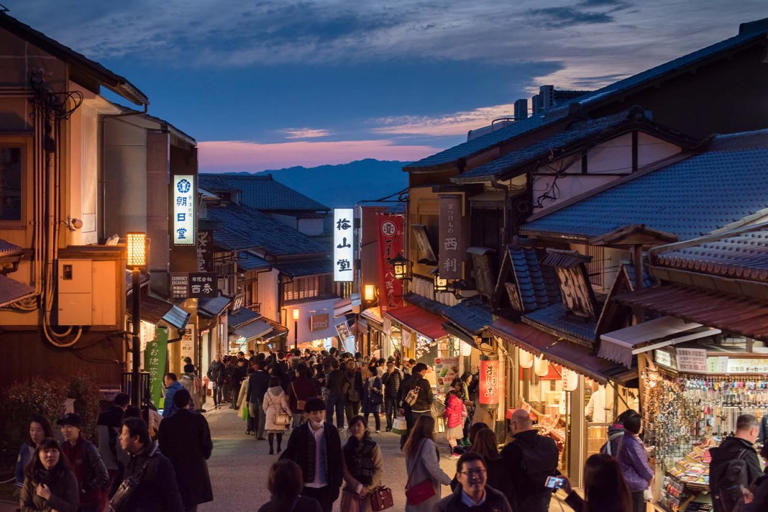

IMAGES
VIDEO
COMMENTS
Information about the Japanese cuisine. Japanese cuisine (和食, washoku) offers an abundance of gastronomical delights with a boundless variety of regional and seasonal dishes.Restaurants in Japan range from mobile food stands to centuries old ryotei, atmospheric drinking places, seasonally erected terraces over rivers, cheap chain shops and unique theme restaurants about ninja and robots.
4. Udon. Udon is a popular Japanese dish that's an easy introduction to Japanese food for tourists. It can be served a number of different ways, with a variety of ingredients, but it is most commonly served in noodle soups. Pictured above is a delicious beef udon noodle soup that we enjoyed in Kyoto, Japan.
Explore the best of Japan's food - from its popular classics like sushi, ramen, Wagyu, tonkatsu, teppanyaki and soba, through to its regional favourites like Kobe beef, Hiroshima okonomiyaki and Okinawan soul food. ... Hagi City Food Guide: Best Local Eats Yamaguchi. 3. Tokyo Takes 2nd Place on Top Coffee Cities List ... Japan Travel is the ...
3. Ramen. Like sushi, ramen is a Japanese food favorite and one of the best dishes you can eat in Japan. It refers to a noodle soup made with four basic components - the broth, tare (seasoning), wheat noodles, and toppings. Tare (or kaeshi) is the salty concentrated essence placed at the bottom of every ramen bowl.
7. Kokera-Zushi from Kochi. Kokera-Zushi (Photo: Tosa Traditional Food Study Group - Ministry of Agriculture, Forestry and Fisheries website) Kokera-Zushi is a type of sushi in which vinegared rice and ingredients such as eggs, carrots, shiitake, fish are meticulously layered within a square wooden frame like a cake.
Each room has air conditioning and a safety deposit box. A shared kitchen comes with a refrigerator, stovetop, microwave, toaster and electric kettle. Bathrooms are shared and include free toiletries, towels, hairdryer, mouthwash and toothpaste. You will find a washing machine, tumble dryer and electrical adapter.
To assist you in making a decision, we have assembled a list of 32 delectable Japanese dishes that everyone should experience. 1. Buta-No-Shogayaki (豚の生姜焼き): The 'B-Grade Gourmet' Ginger Pork Classic. Buta-No-Shogayaki: A sizzling ginger-infused pork dish that's a household favorite.
Ramen is a big bowl of noodle soup full of tender, wheat-based noodles, a unique-flavored savory broth, and varied toppings (mushrooms, bean sprouts, seaweed, bok choy, egg, to name a few classic ones). Each region in Japan offers its unique twist. Japanese ramen is not instant noodles, unless you're shopping in the US.
Explore the best of Japan's food - from its popular classics like sushi, ramen, Wagyu, tonkatsu, teppanyaki and soba, through to its regional favourites like Kobe beef, Hiroshima okonomiyaki and Okinawan soul food. ... Iwate: Food Guide Japan Travel. Iwate is renowned for its top quality dairy products, beef, seafood, and noodle dishes. Iwate ...
Explore the best of Japan's food - from its popular classics like sushi, ramen, Wagyu, tonkatsu, teppanyaki and soba, through to its regional favourites like Kobe beef, Hiroshima okonomiyaki and Okinawan soul food. ... Hagi City Food Guide: Best Local Eats Yamaguchi. 9. 4 Must-Visit Hamburger Eateries in Shinagawa City ... Japan Travel is the ...
Sit at a sushi counter, dine at a traditional ryotei, eat vegetarian shojin ryori in a monastery or enjoy casual food at an izakaya or yatai food stall. Complement traditional and modern takes on Japanese cuisine with sake from a local brewery in Niigata, sip on sweet potato shochu in Kagoshima , or try one of Japan's highly-acclaimed whiskies ...
Brought to Japan in the late 1800 by the British, Japanese curry (カレー) is considered one of the nation's most popular convenience and comfort foods. Unlike Thai or Indian-style curries, the Japanese version has a more stew-like texture and is generally sweeter and milder in heat. They make a perfect introduction to people trying curry for the first time.
Beautiful, refined and reverent best describe Japan's approach to food Washoku, traditional Japanese cuisine, was added to the UNESCO Intangible Cultural Heritage List in December 2013. This well-deserved recognition honors the respect and appreciation of the season, and the beauty of the ingredients, with which Japanese dishes are prepared.
The Informed Guide to Japanese Food & Drink. Welcome to Japanese Food Guide, a Japan-focused travel publication with an all-female team dedicated to providing a new kind of content on a much-loved destination. We'll explain Japanese food culture in a way only insider voices can - from dining etiquette, to what to eat and where to eat it ...
The ultramodern district of Shibuya recent added a new attraction to its long list. A wonderful indoor food alley that allows you.. ... Explore the best of Tokyo's food - from popular classics like sushi, ramen, Wagyu, tonkatsu, teppanyaki and soba, through to its regional favourites like Kobe beef, Hiroshima okonomiyaki and Okinawan soul food.
Explore the best of Japan's food - from its popular classics like sushi, ramen, Wagyu, tonkatsu, teppanyaki and soba, through to its regional favourites like Kobe beef, Hiroshima okonomiyaki and Okinawan soul food.
🤫 OUR ULTIMATE JAPANESE FOOD GUIDE: https://chadandclaire.com/shop/p/japan-food-guide 🤭 OUR ULTIMATE JAPAN TRAVEL GUIDE: https://chadandclaire.com/sh...
Guided Tours Of Japan. We will provide tips on how to plan your own Japan 2 week itinerary, but I understand that Japan can be difficult to manage on your own. We have some recommendations for guided tours that included between 12 and 14 day itineraries. Intrepid Travel offers a 12 day Real Food Adventure In Japan.
Kyoto Food Guide. As Japan's former capital and seat of the imperial court for over a millennium, Kyoto offers a rich culinary tradition. The local food culture is diverse and ranges from aristocratic kaiseki course dinners to vegetarian shojin ryori of monks and the simple obanzai home-style cooking. While some restaurants look to the past for ...
Hotate (Scallop) - The best Hotate has a firm texture and a sweet, almost creamy taste. Hokkigai (Surf Clam) - The best Hokkigai that I tasted is in Hokkaido, with firm meat and sweet flavor. Ikura (Salmon Roe) - Translucent and bright orange fish eggs. Uni (Sea Urchin) - Particularly the expensive delicacy in Japan.
Local Street Food; Japan's Local Ekiben; Yakitori; Japanese Whisky; Vegetarian and Vegan Guide; Sushi in Japan Guide; Japanese Sake Breweries; Sake 101; Experiences in Japan. ... Travel Japan - The Official Japan Guide. None U.S.-JAPAN TOURISM YEAR 2024. None Go Beyond Japan's Major Cities: Hokuriku Shinkansen Extension in 2024.
The official site of Japan National Tourism Organization is your ultimate Japan guide with tourist information for Tokyo, Kyoto, Osaka, Hiroshima, Hokkaido and other top Japan holiday destinations. We offer travel information to make your Japan travel more comfortable and enjoyable.
Japanese Food Guide was founded by travel content creator and Japan expert Jessica Korteman in June 2021 to make positive change in the areas of gender parity and Japan-focused English-language content. Jessica only hires women contributors, a deliberate move by Jessica to change the face of an industry that often undervalues and underpays the ...
Take a food tour Known as "the Kitchen of Japan," Osaka boasts a diverse culinary scene. Mouthwatering sushi and sashimi, Kobe beef and Japanese BBQ, and flavorful ramen can all be found here in abundance. ... Check out my in-depth Japan travel guide for more ways to save money, information on costs, tips on what to see and do, suggested ...
Foodies flock to Japan, known as one of the top culinary destinations in the world, to taste the freshest and highest-quality ingredients, sushi and diverse regional cuisines. And while the first ...